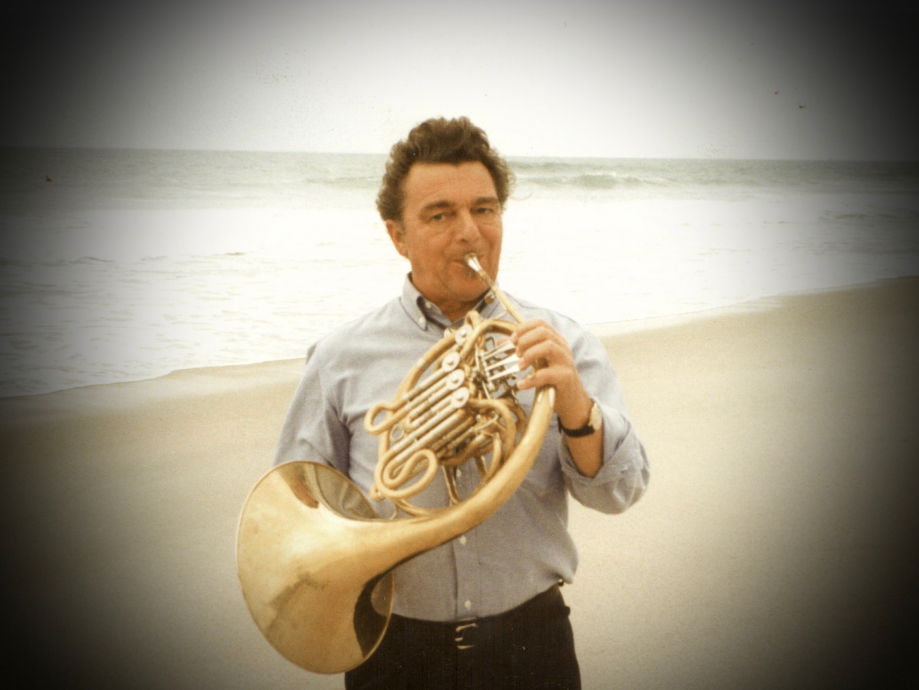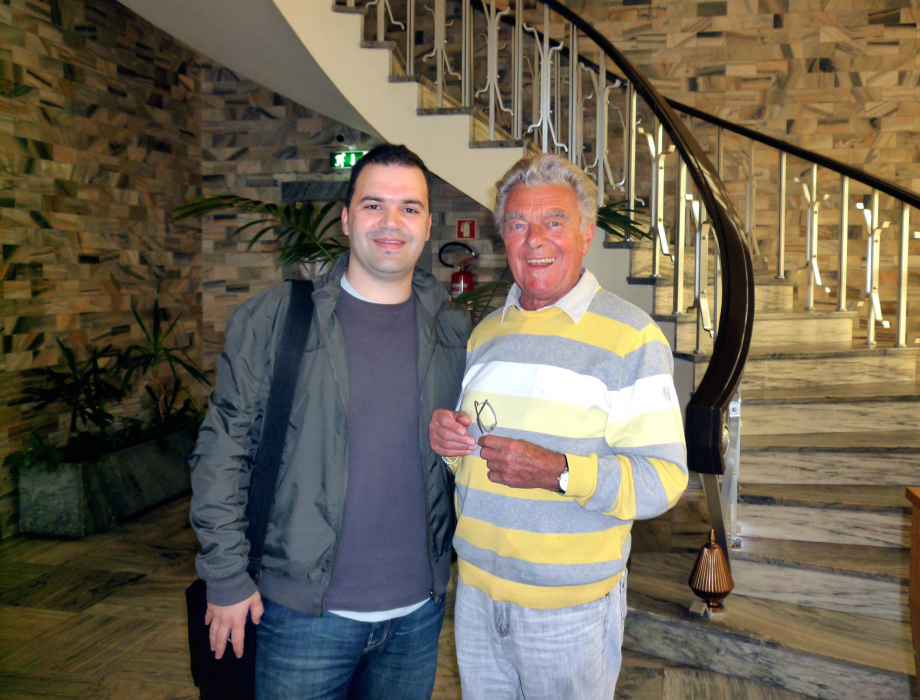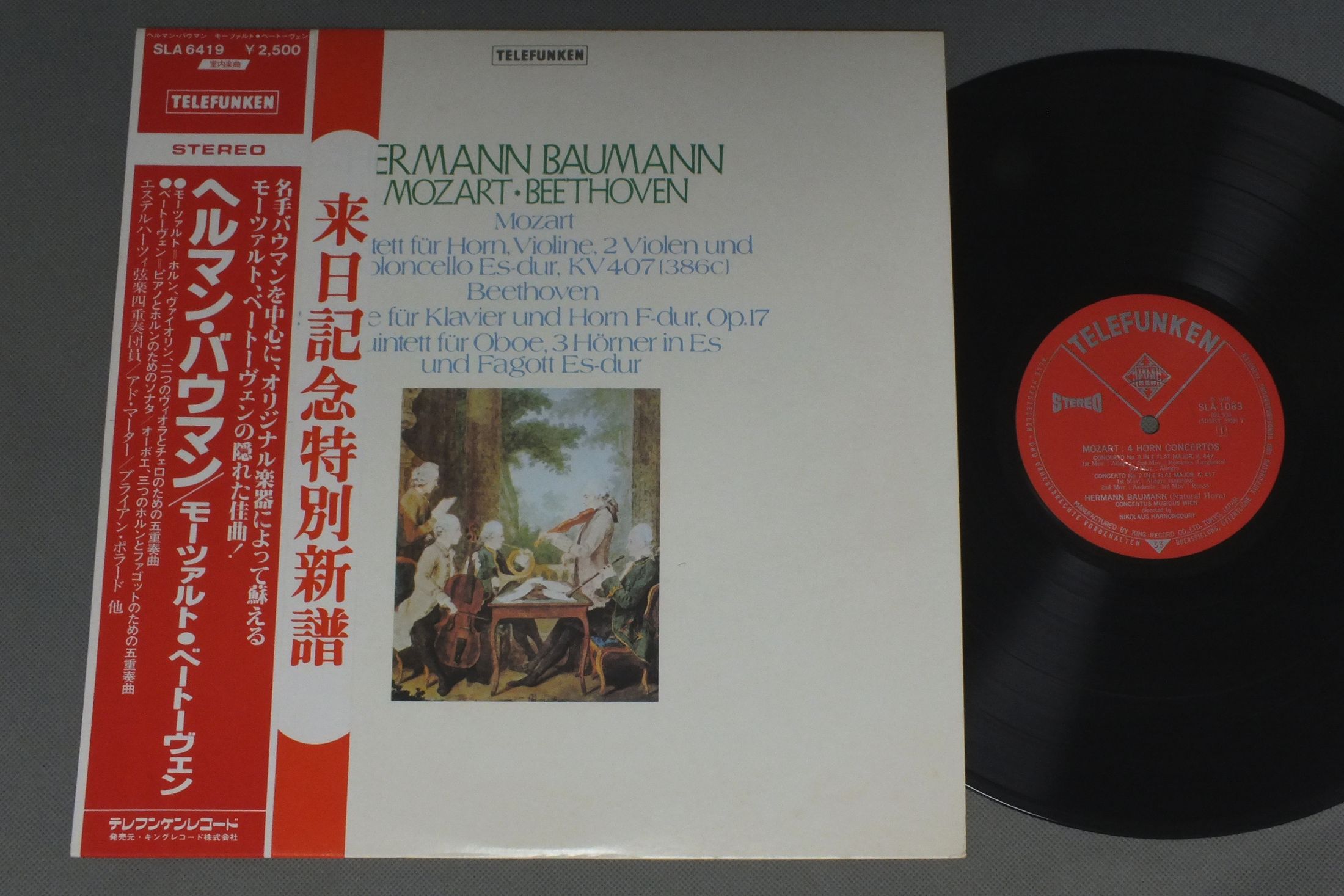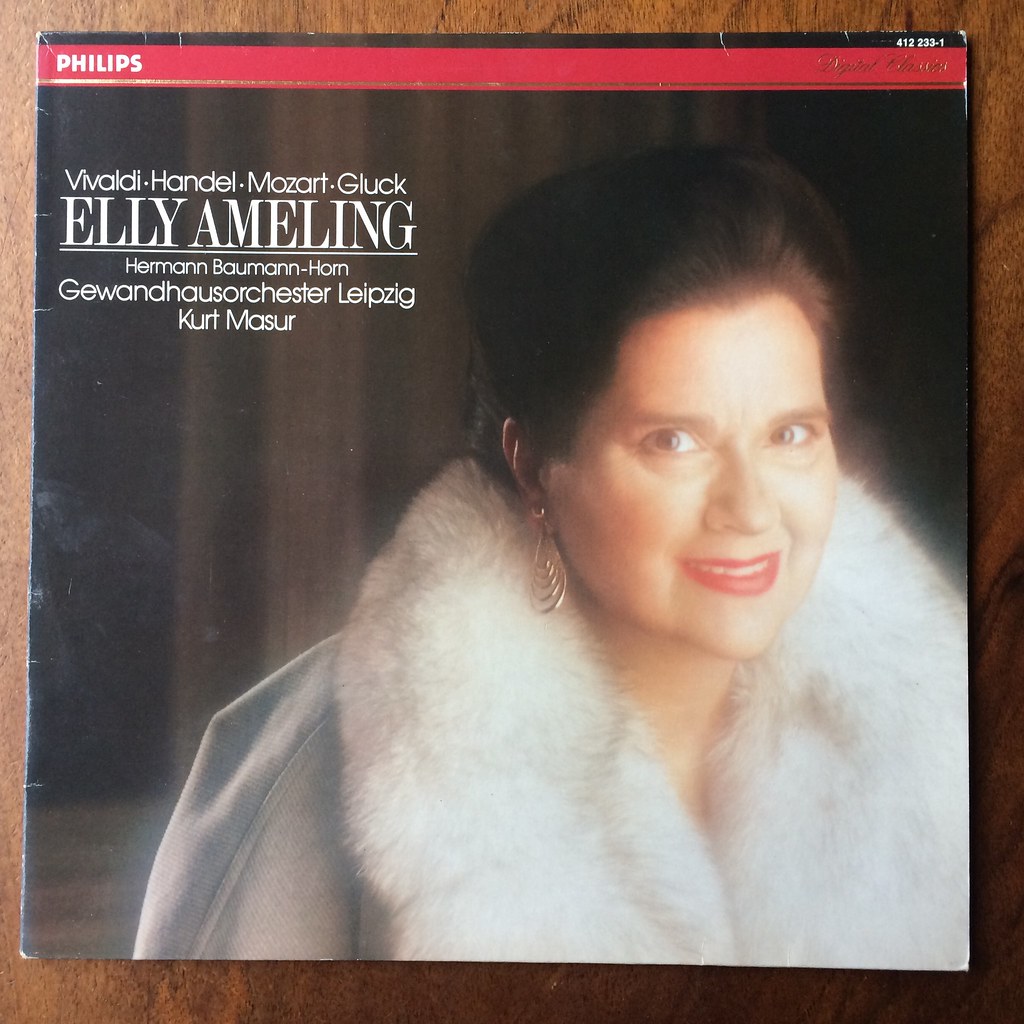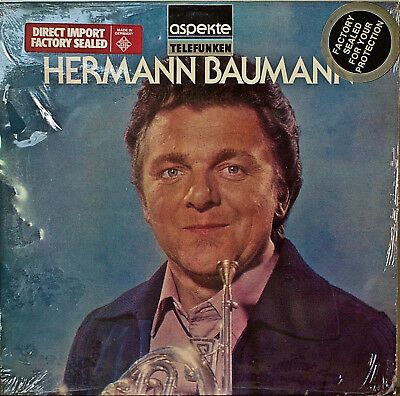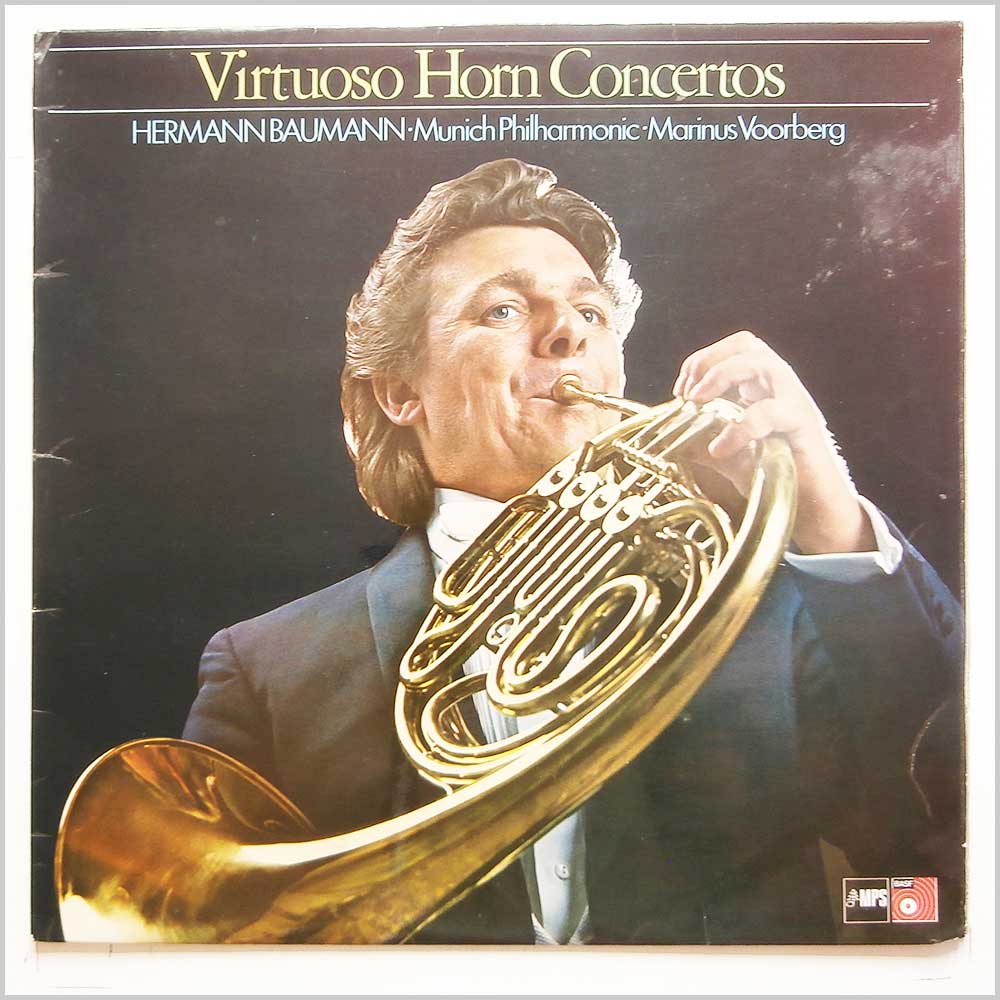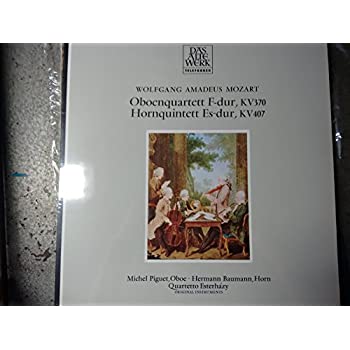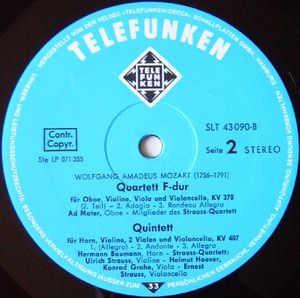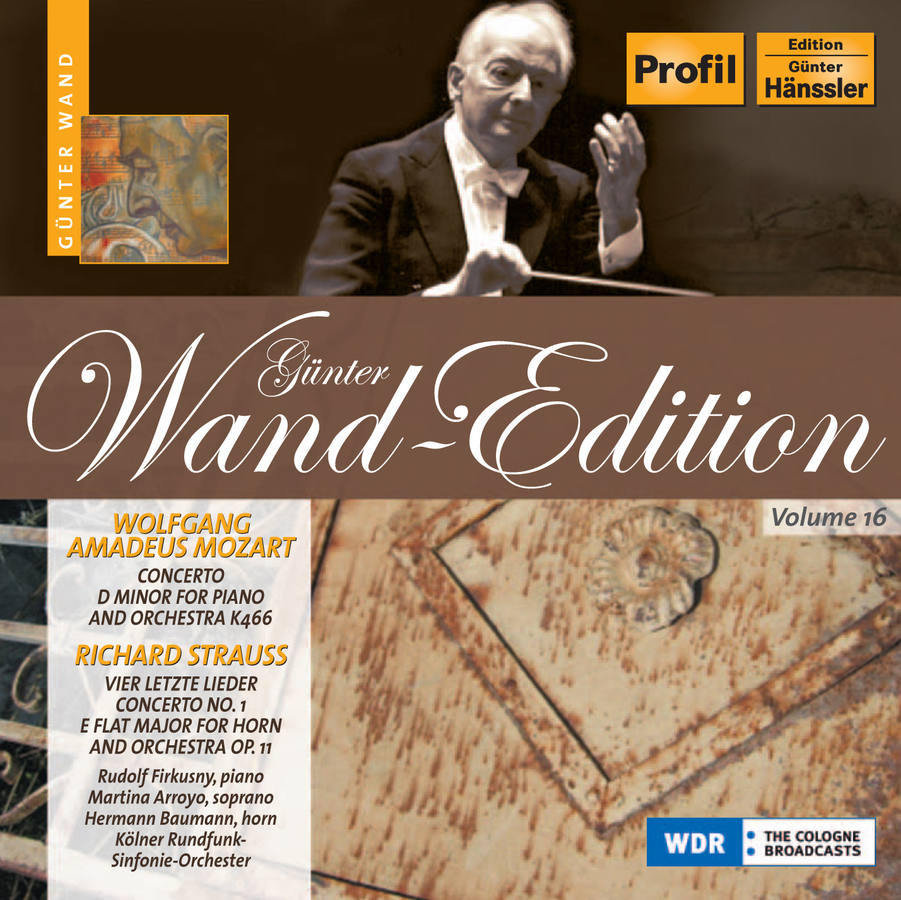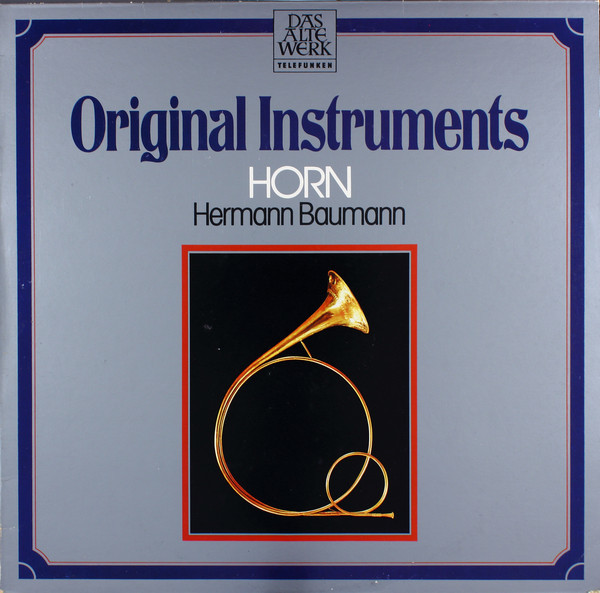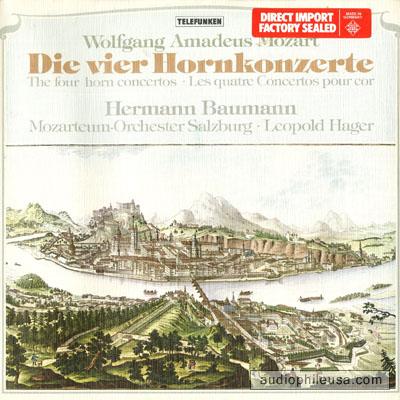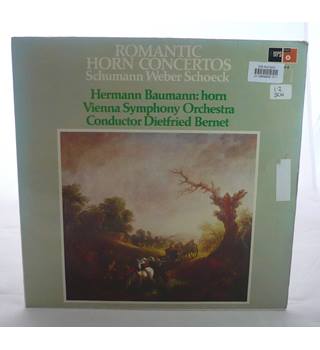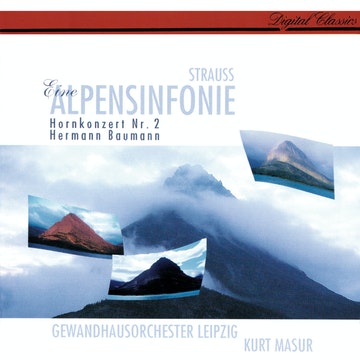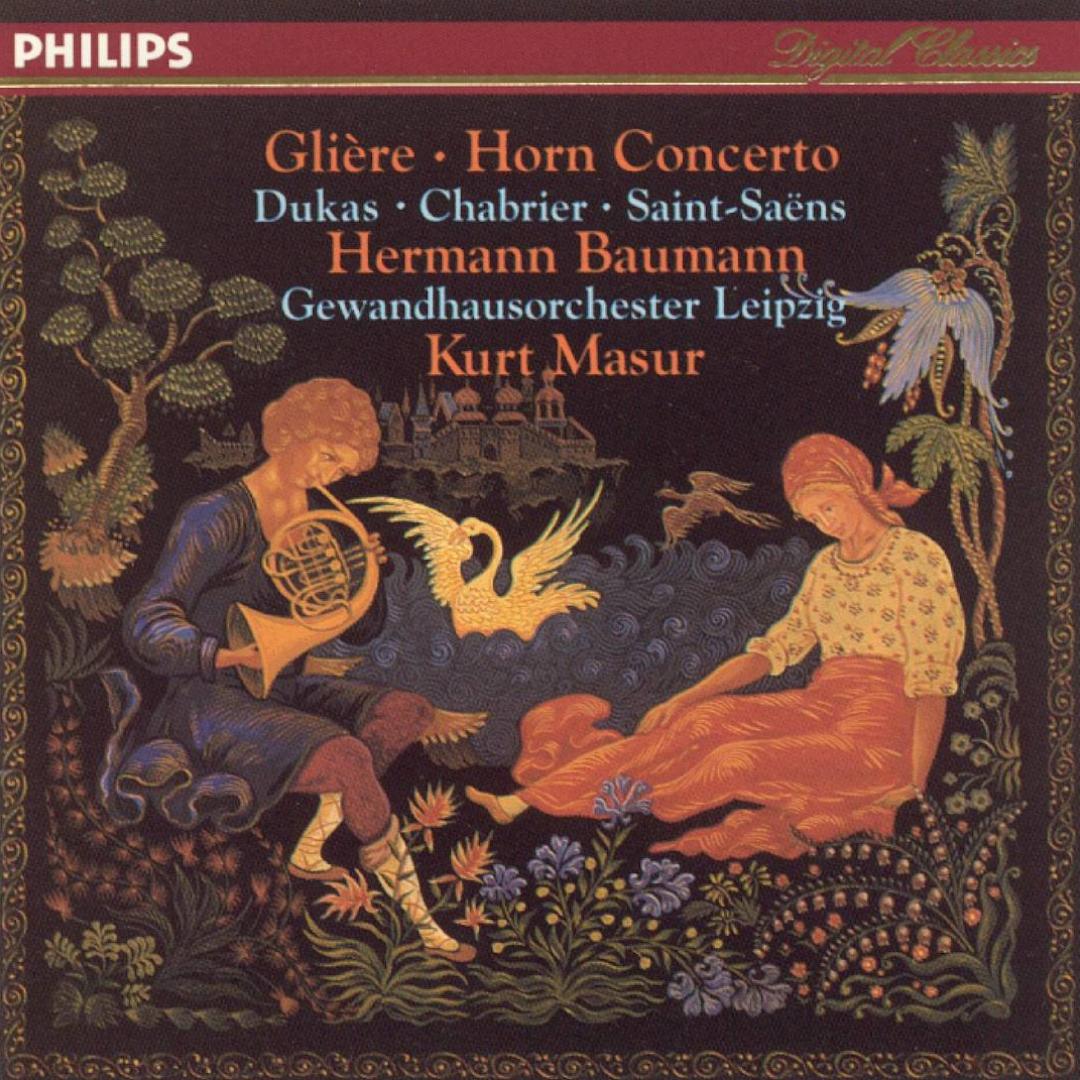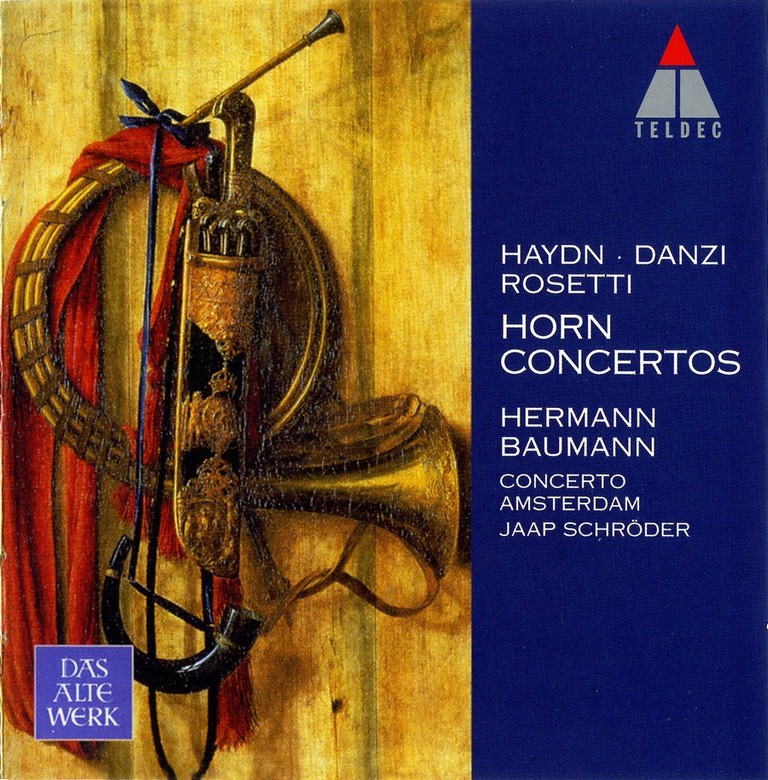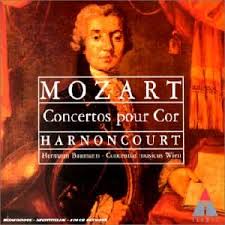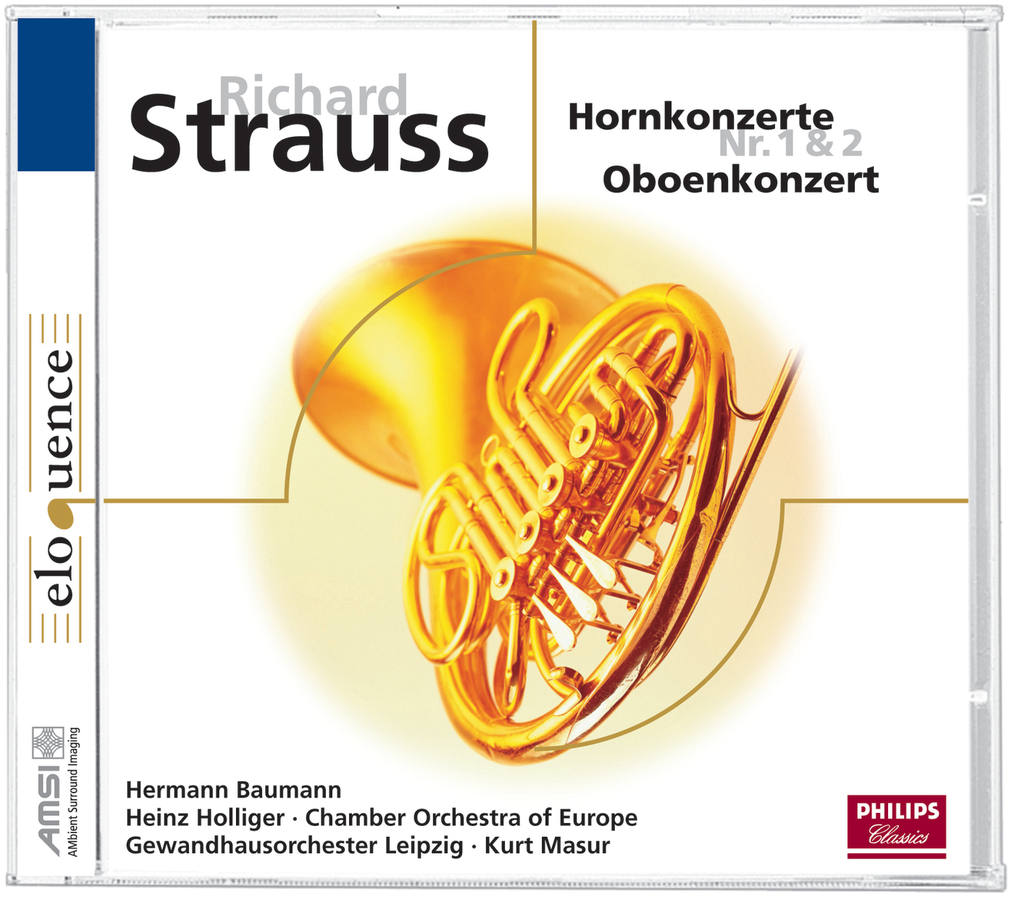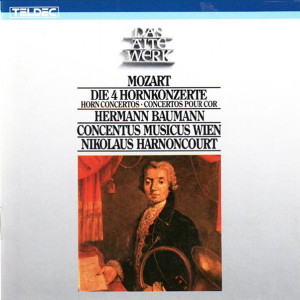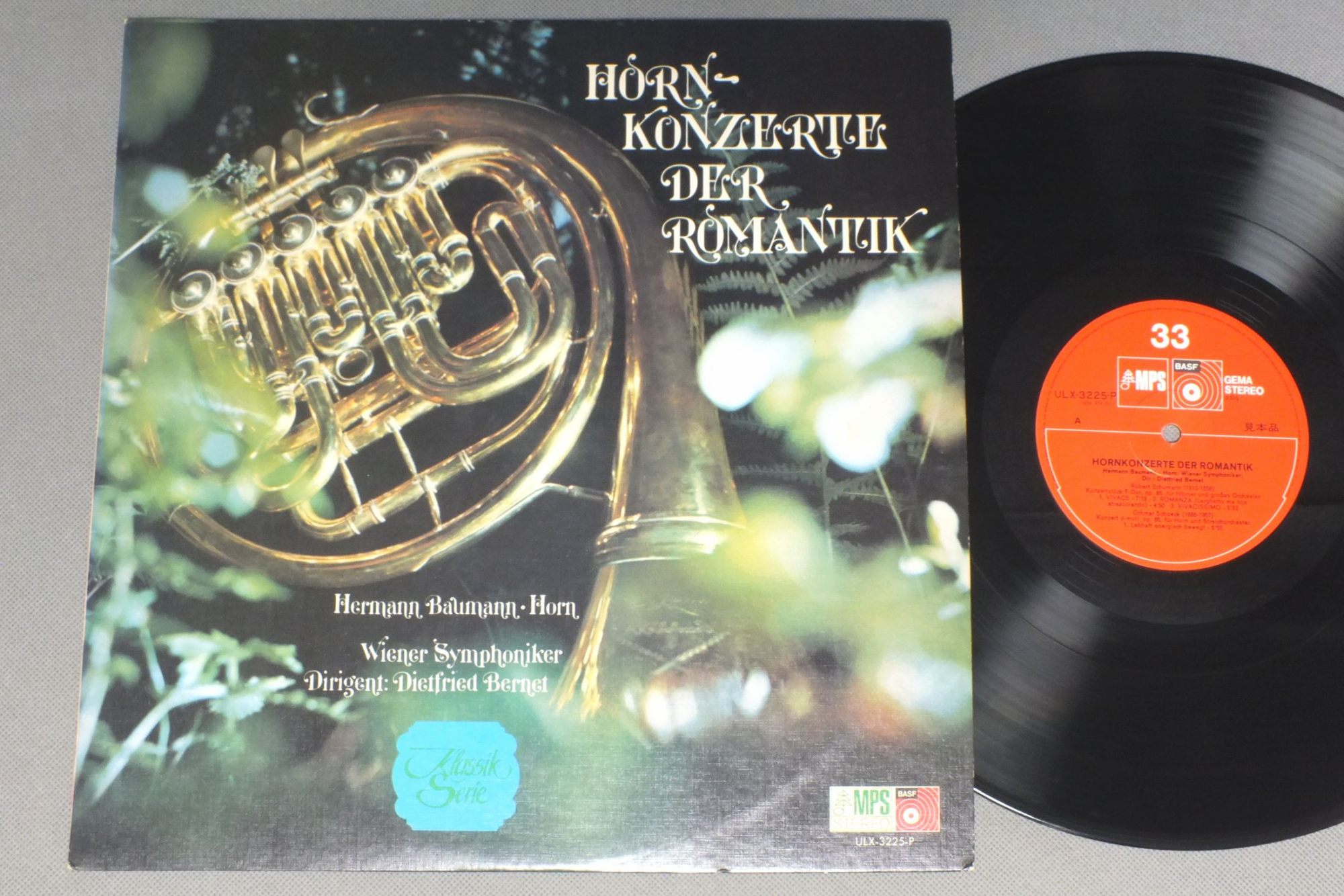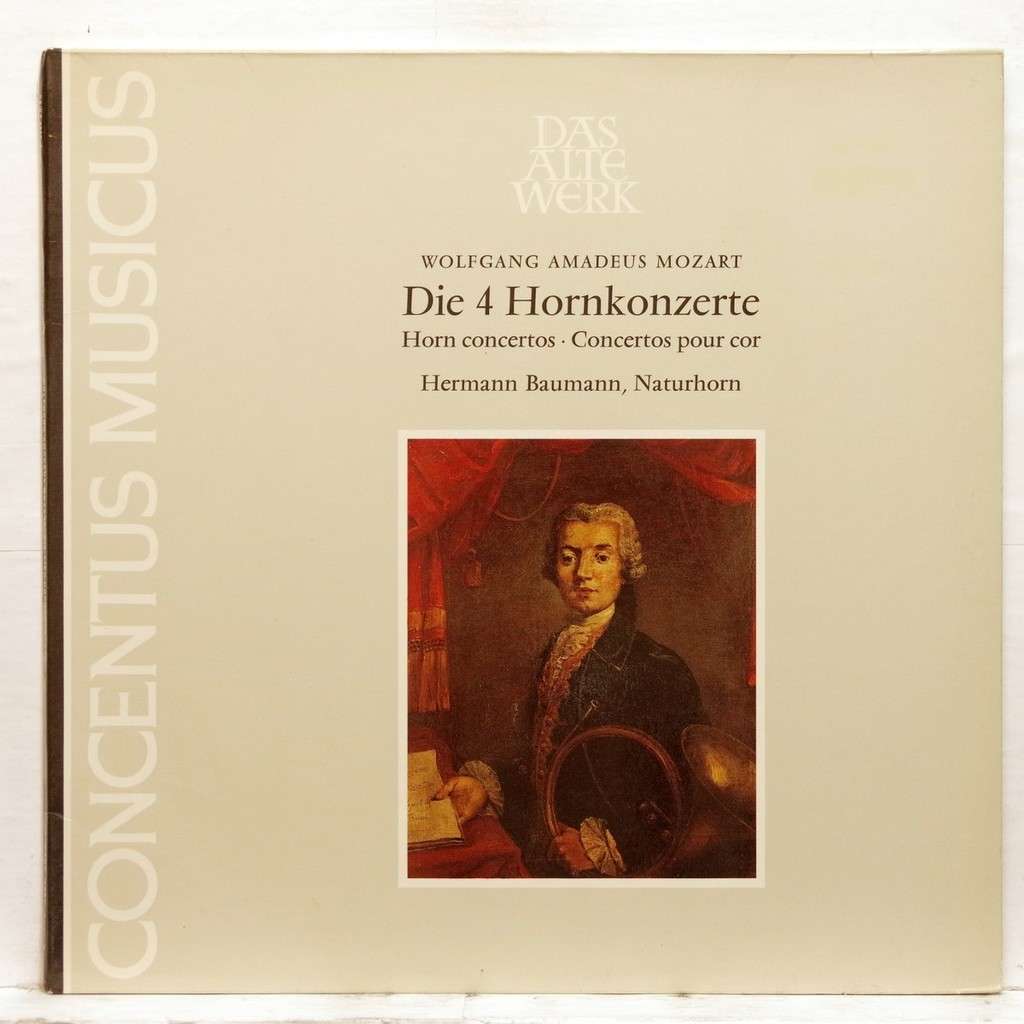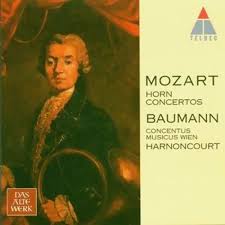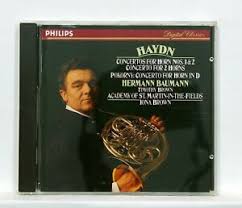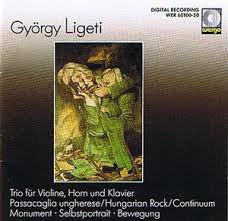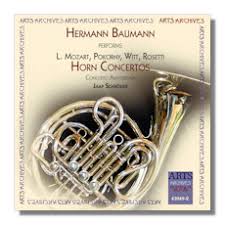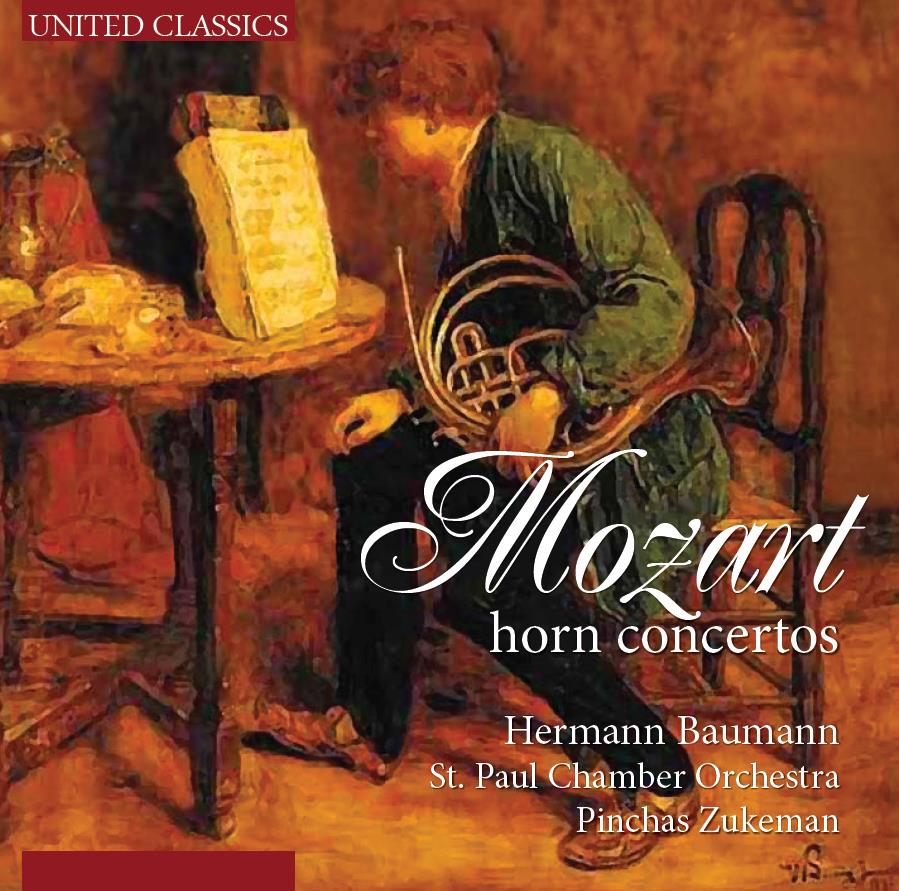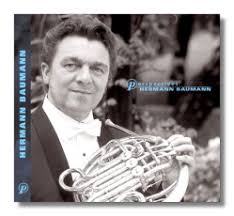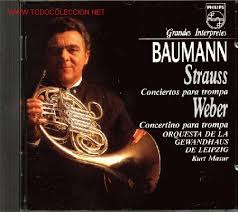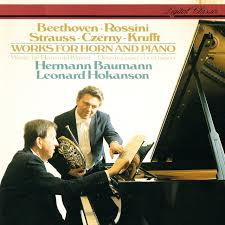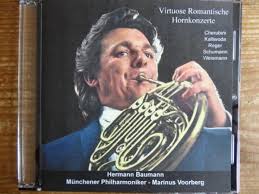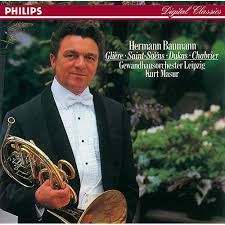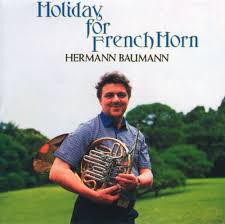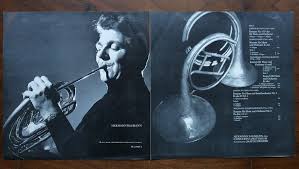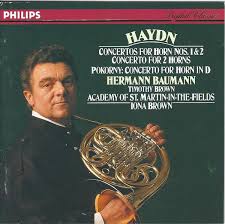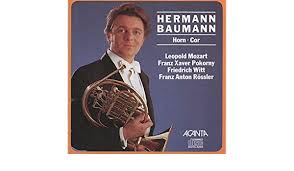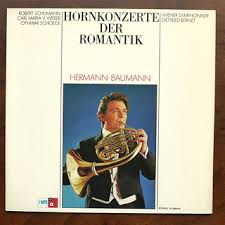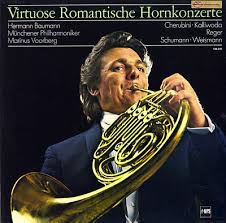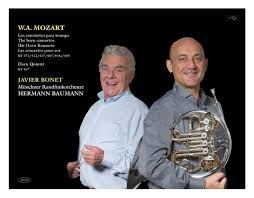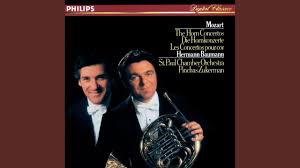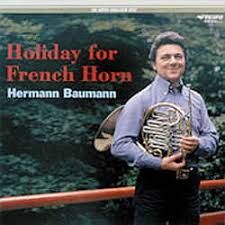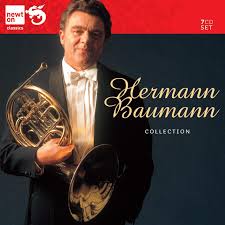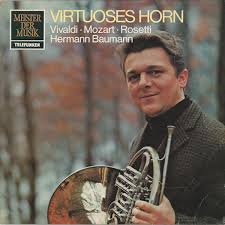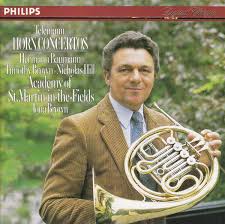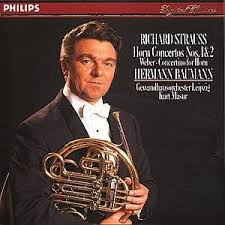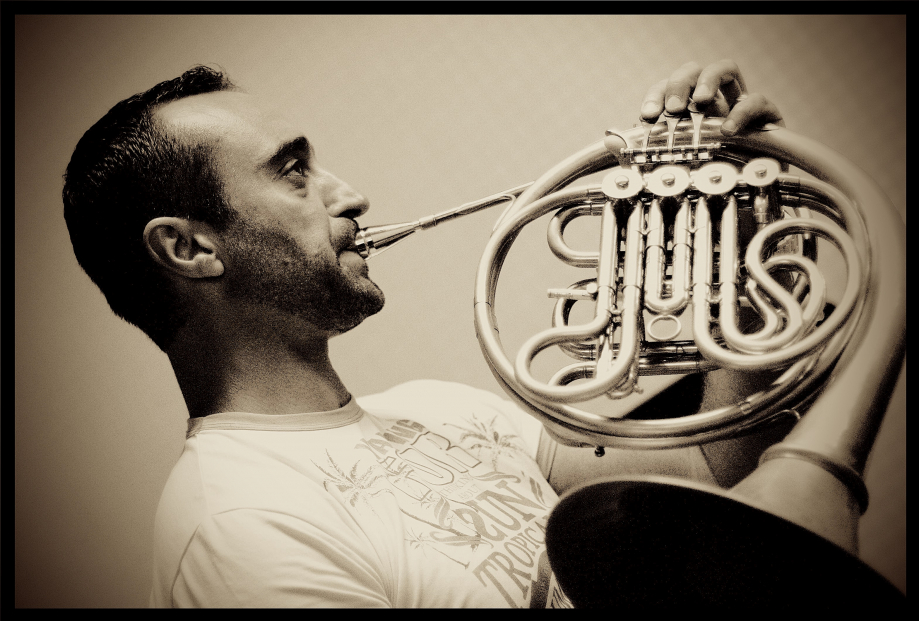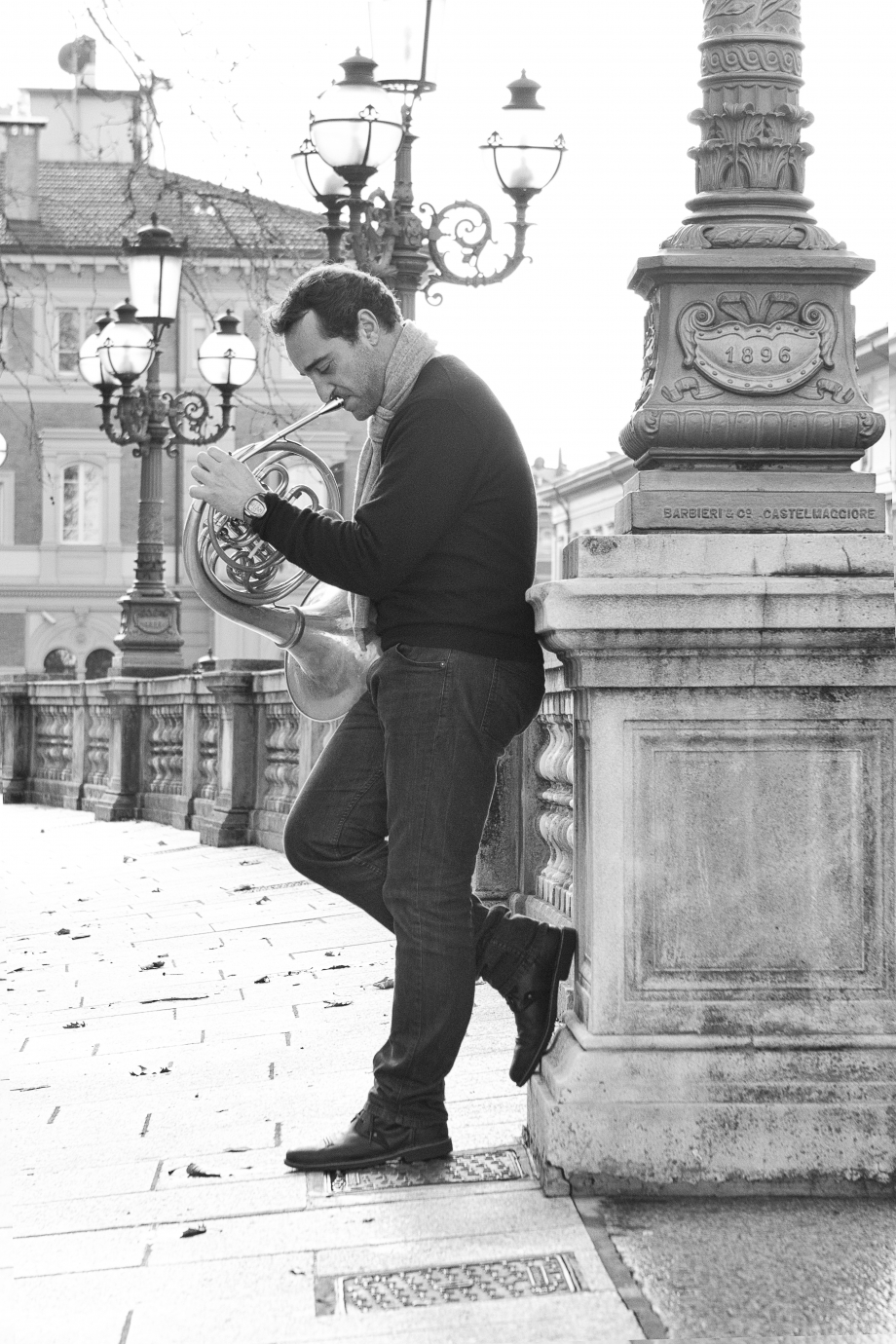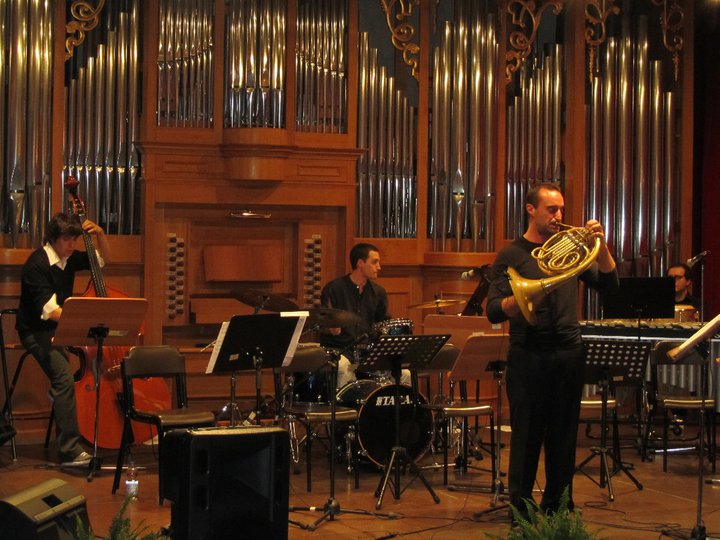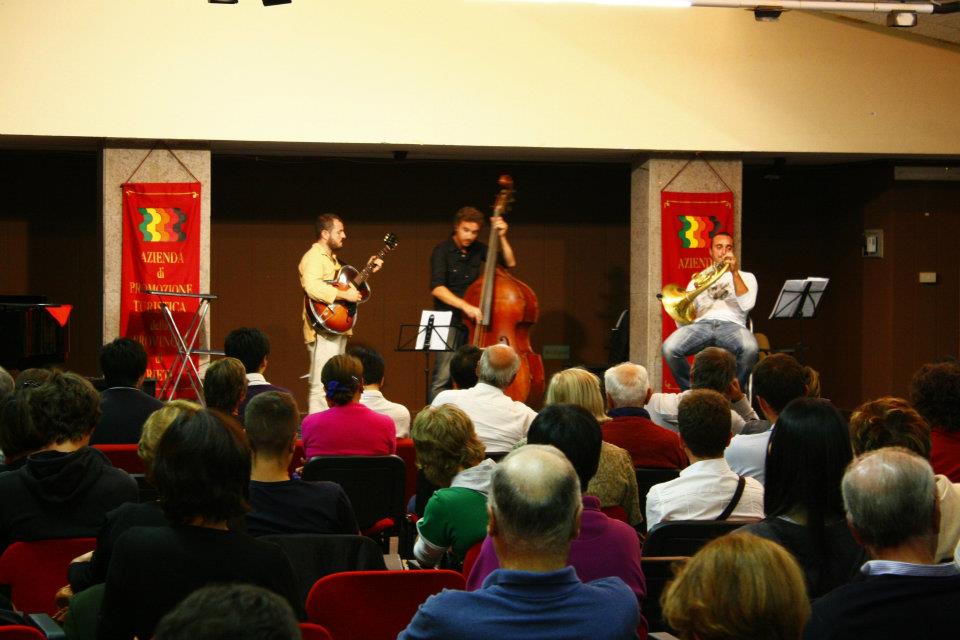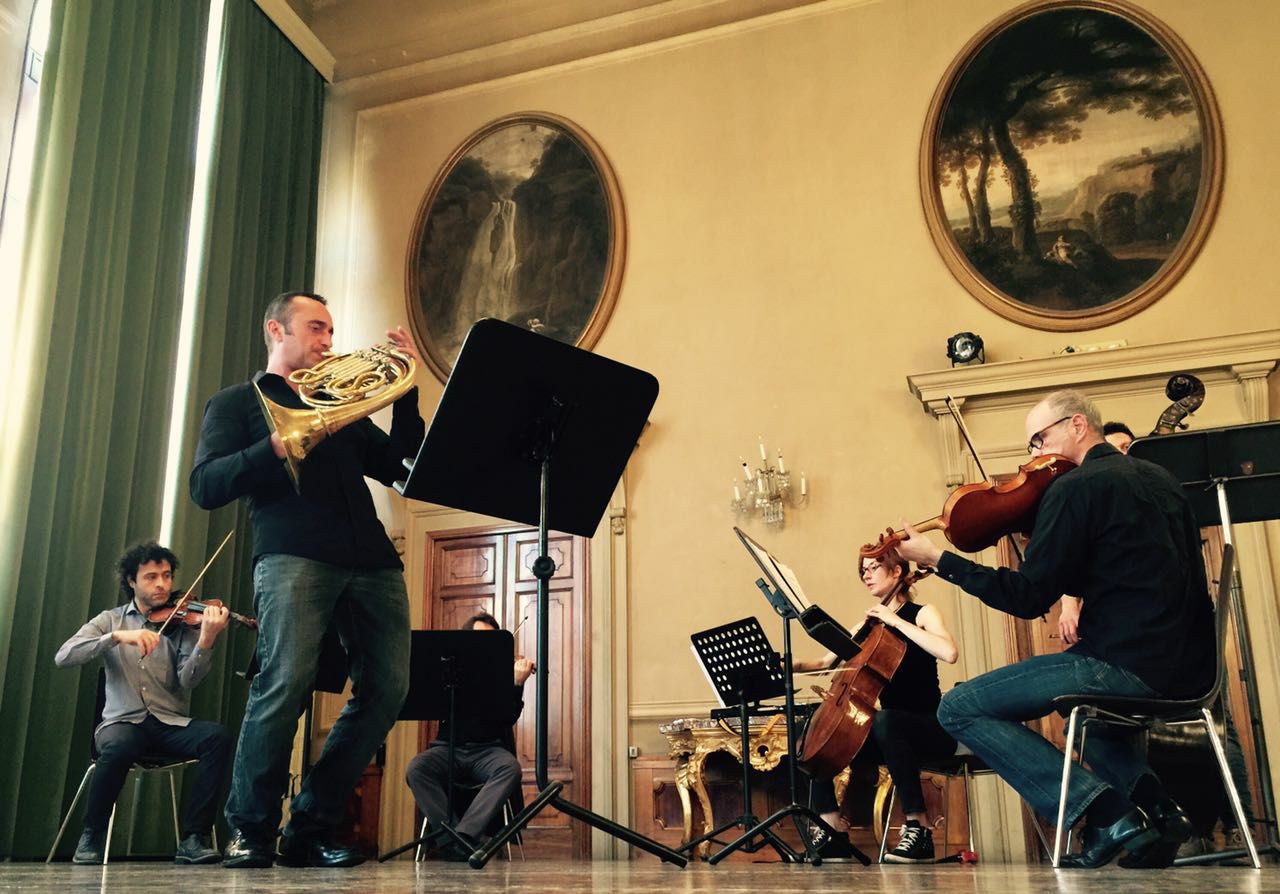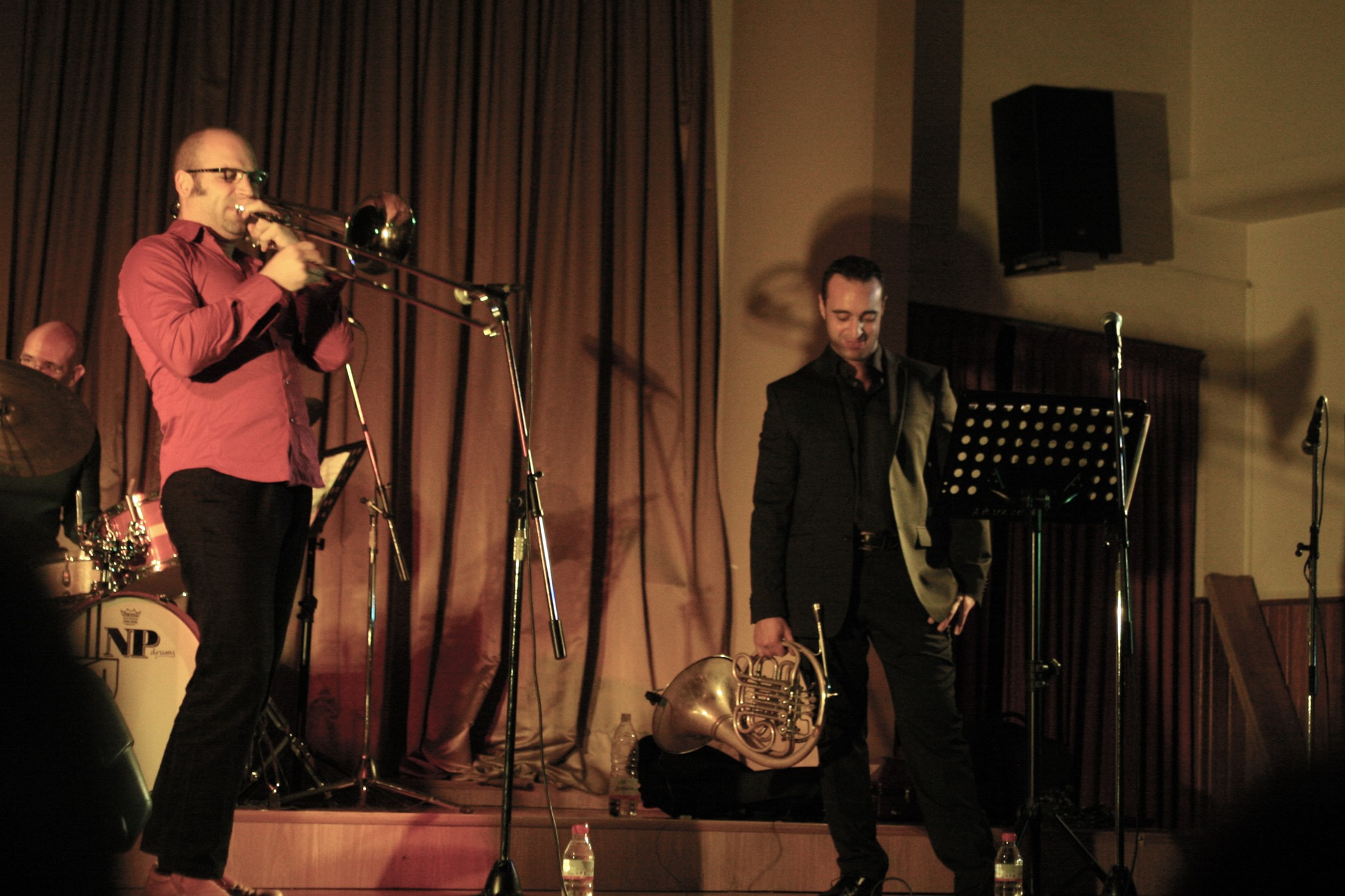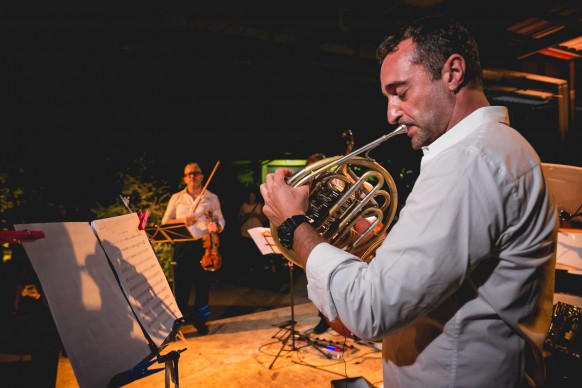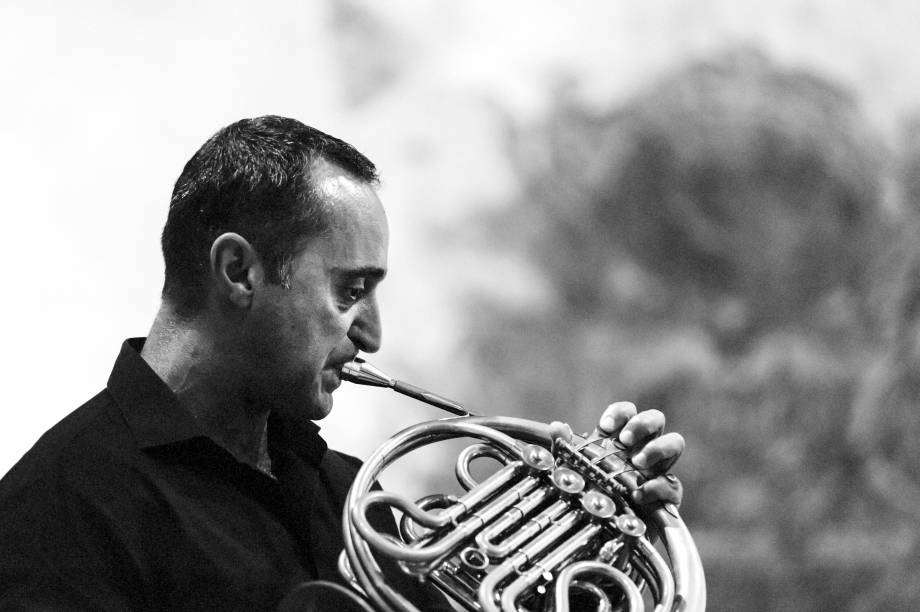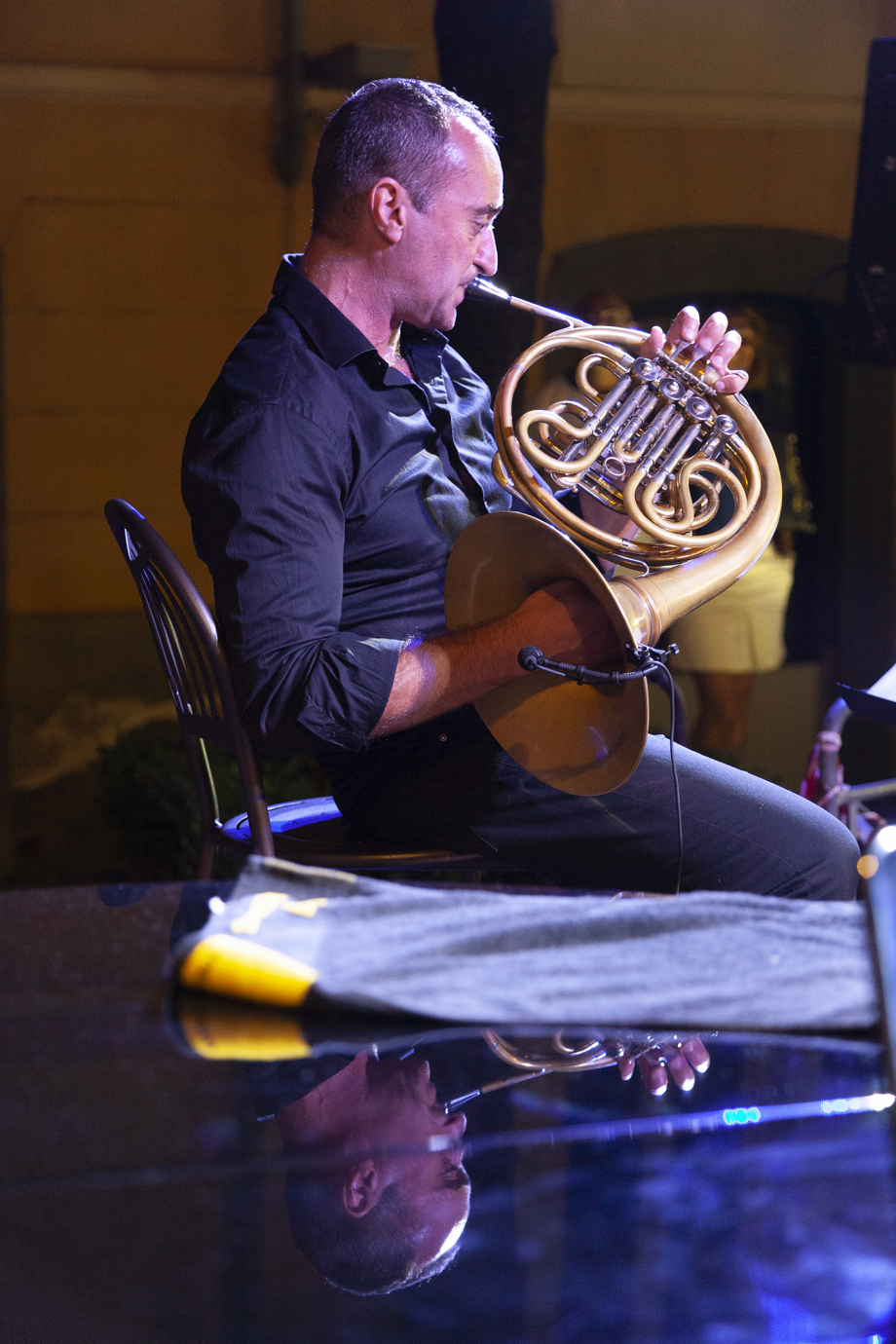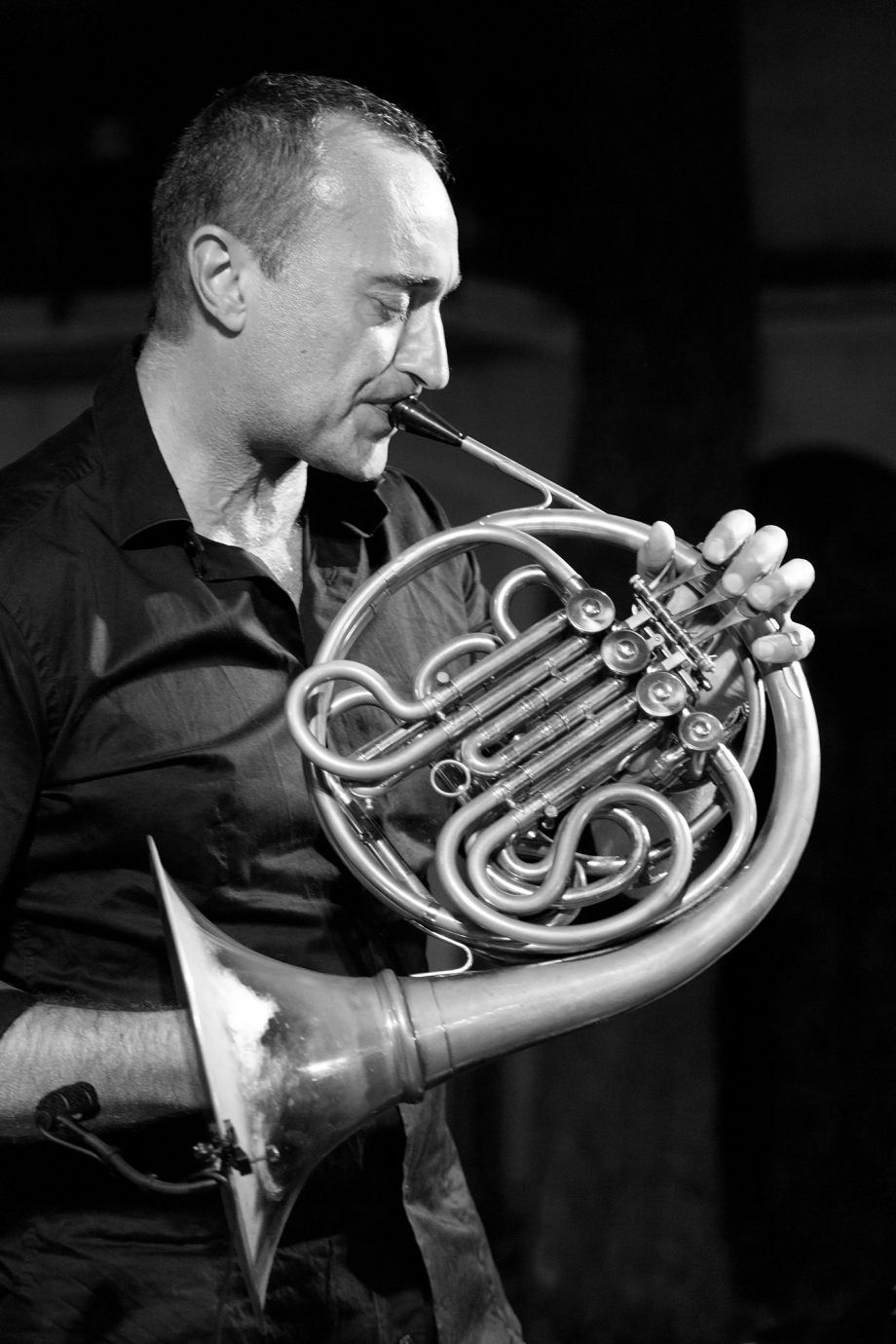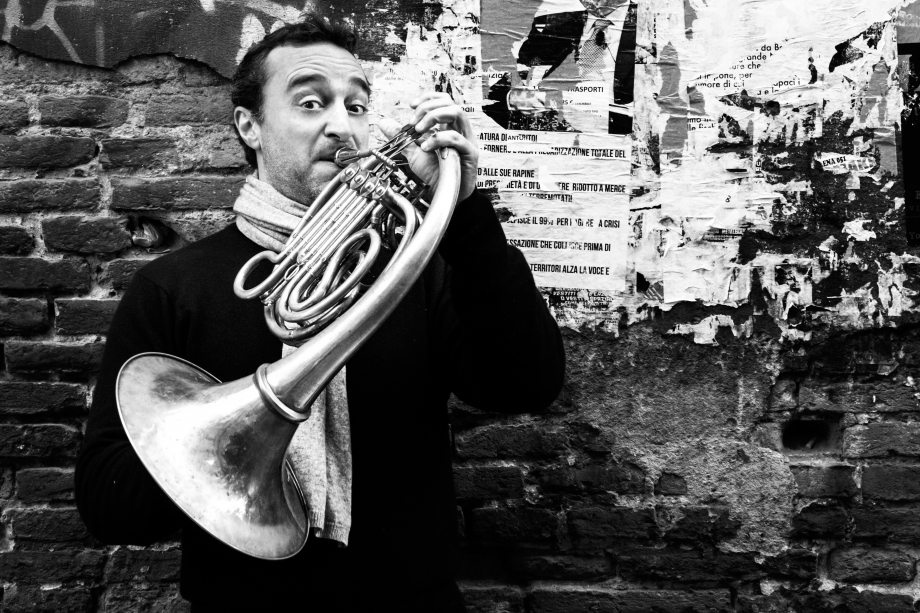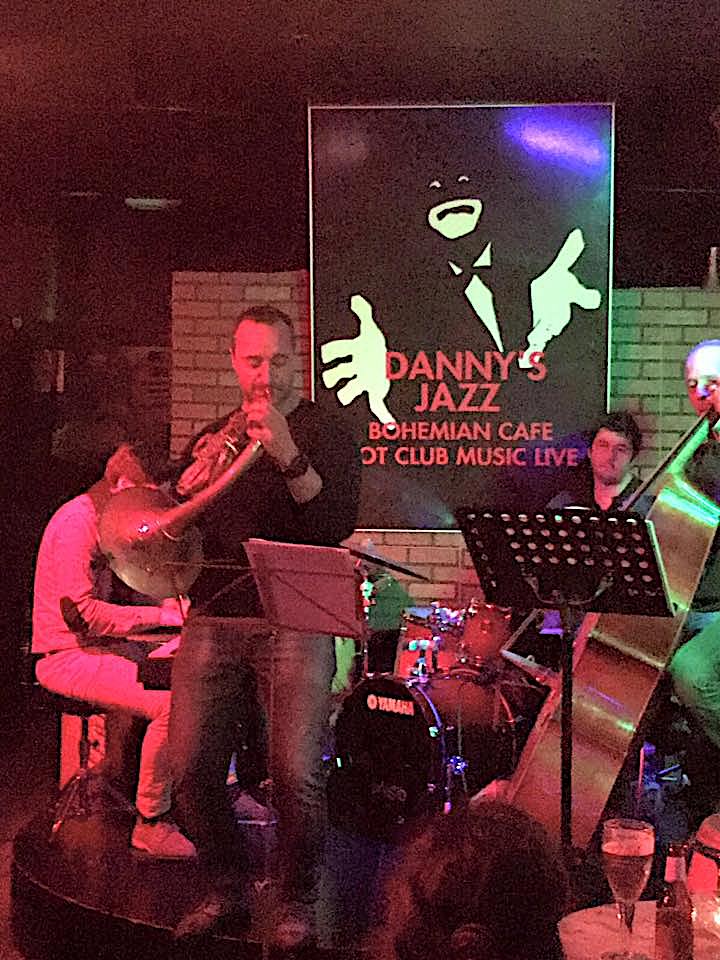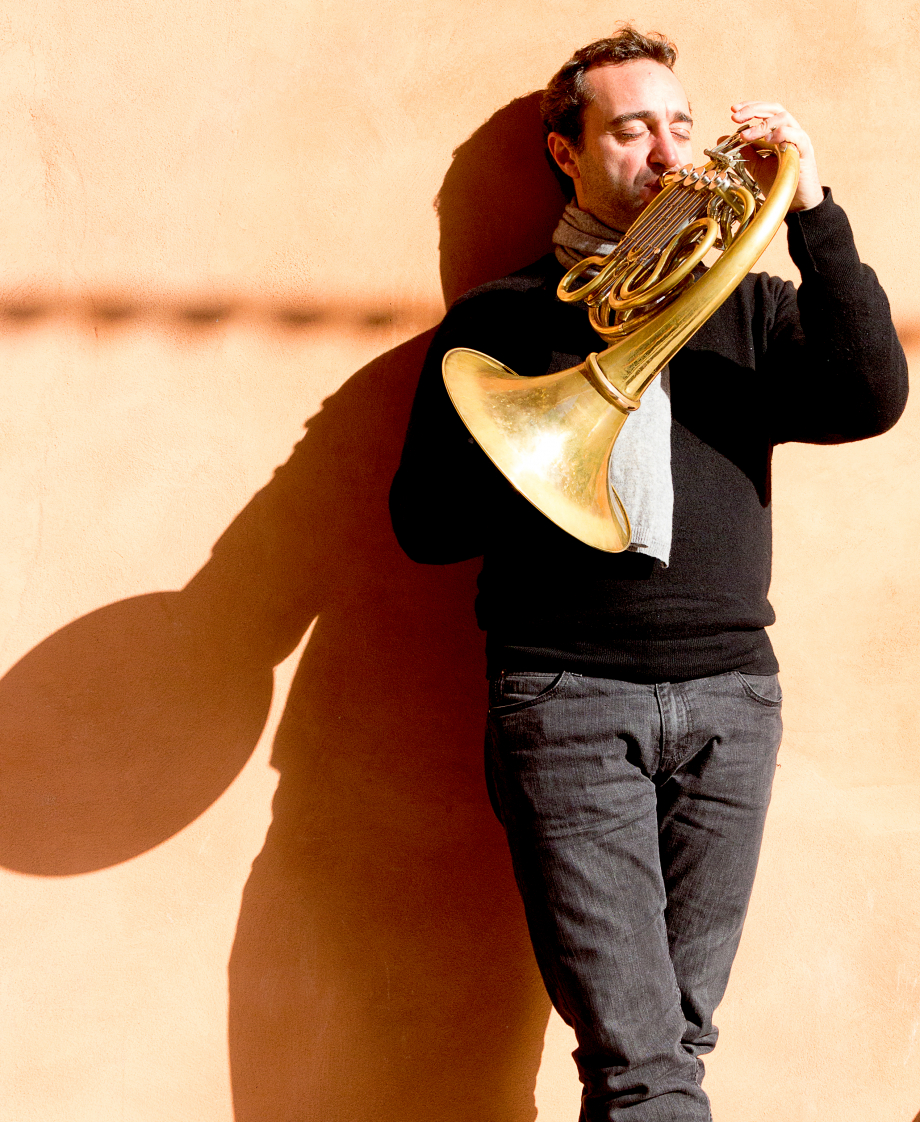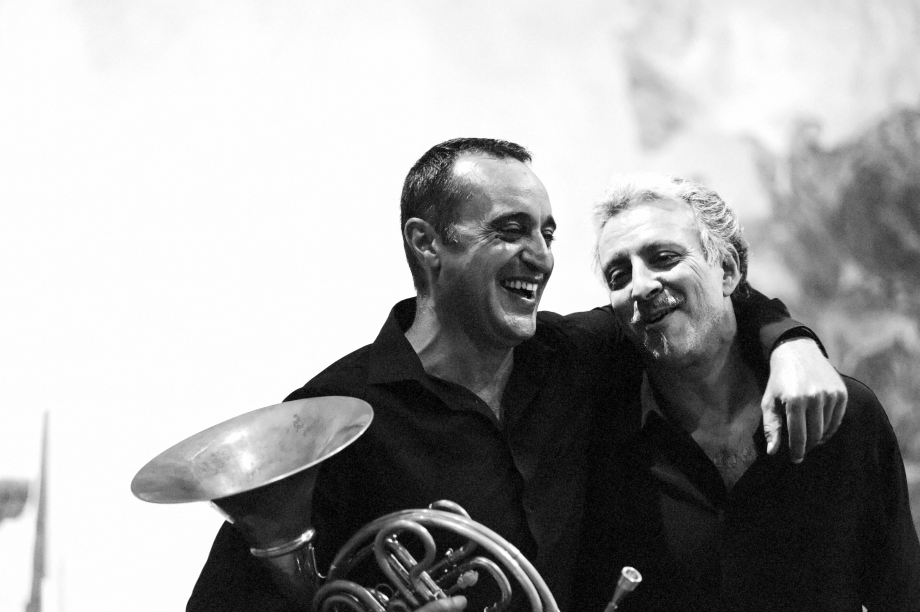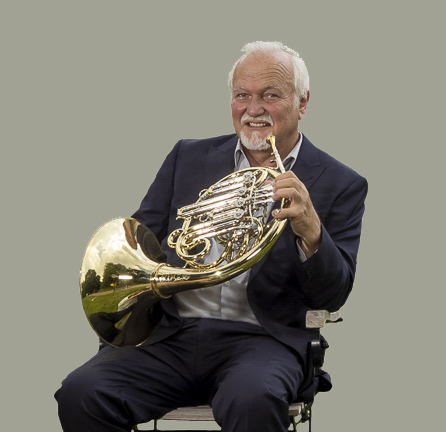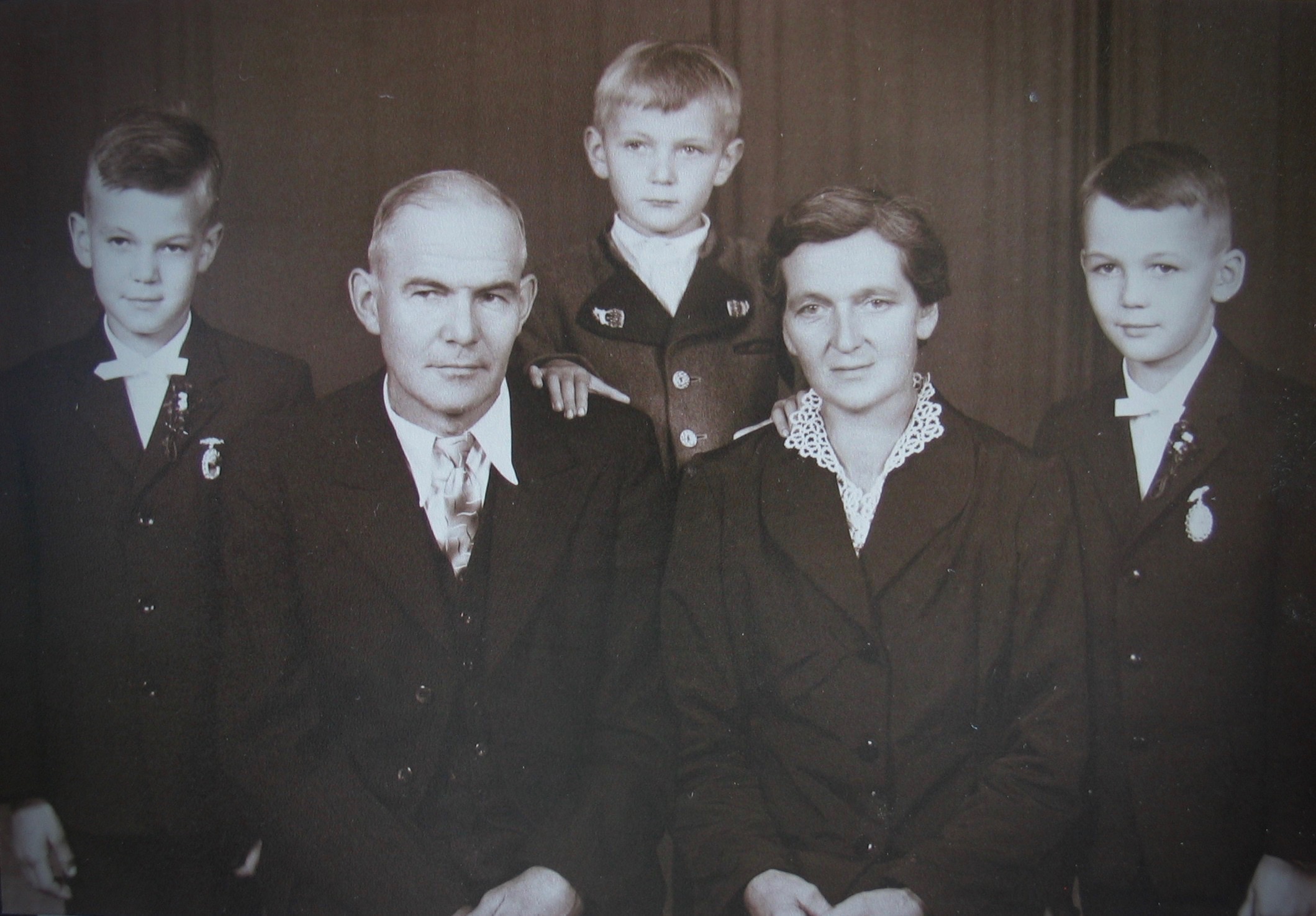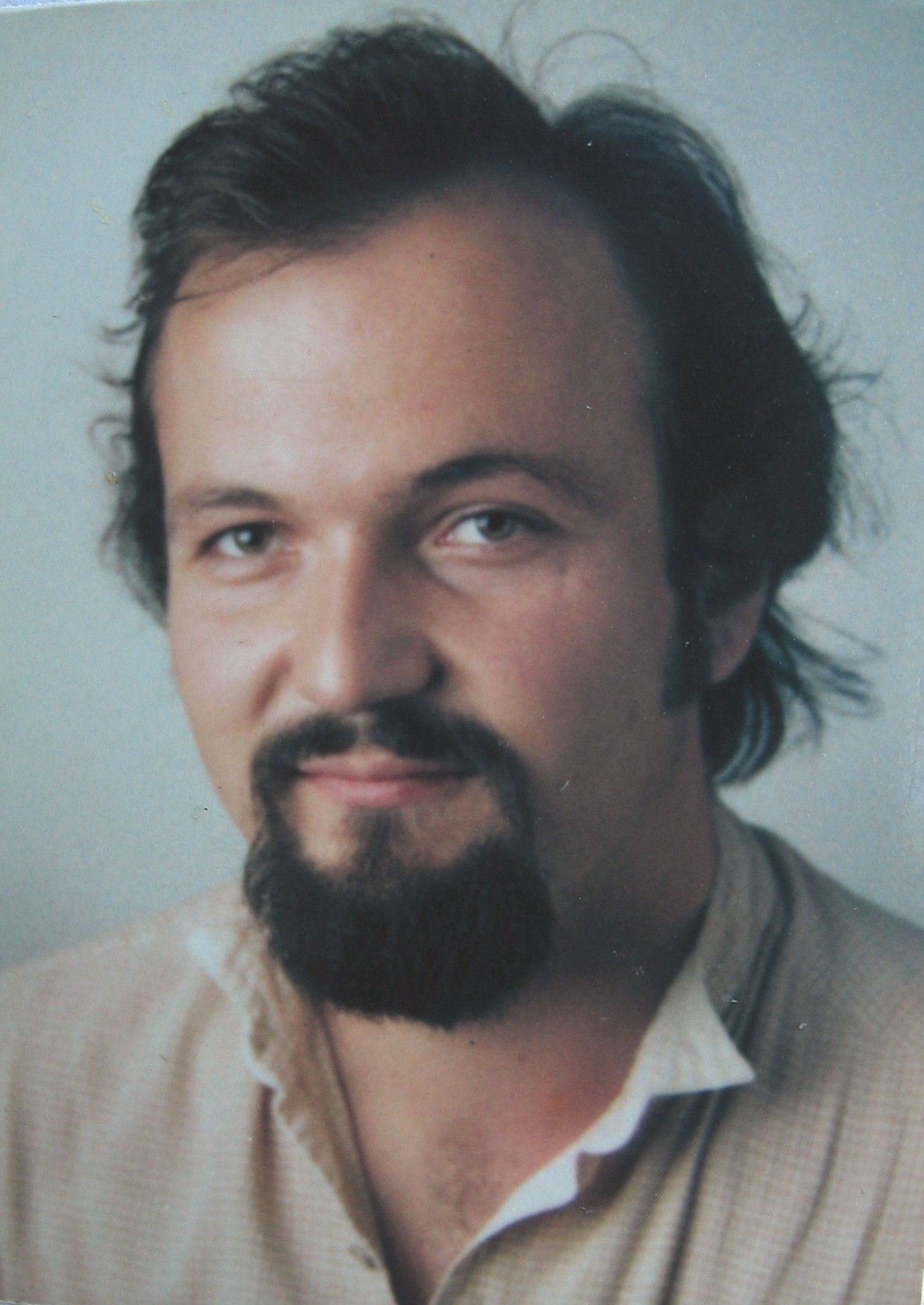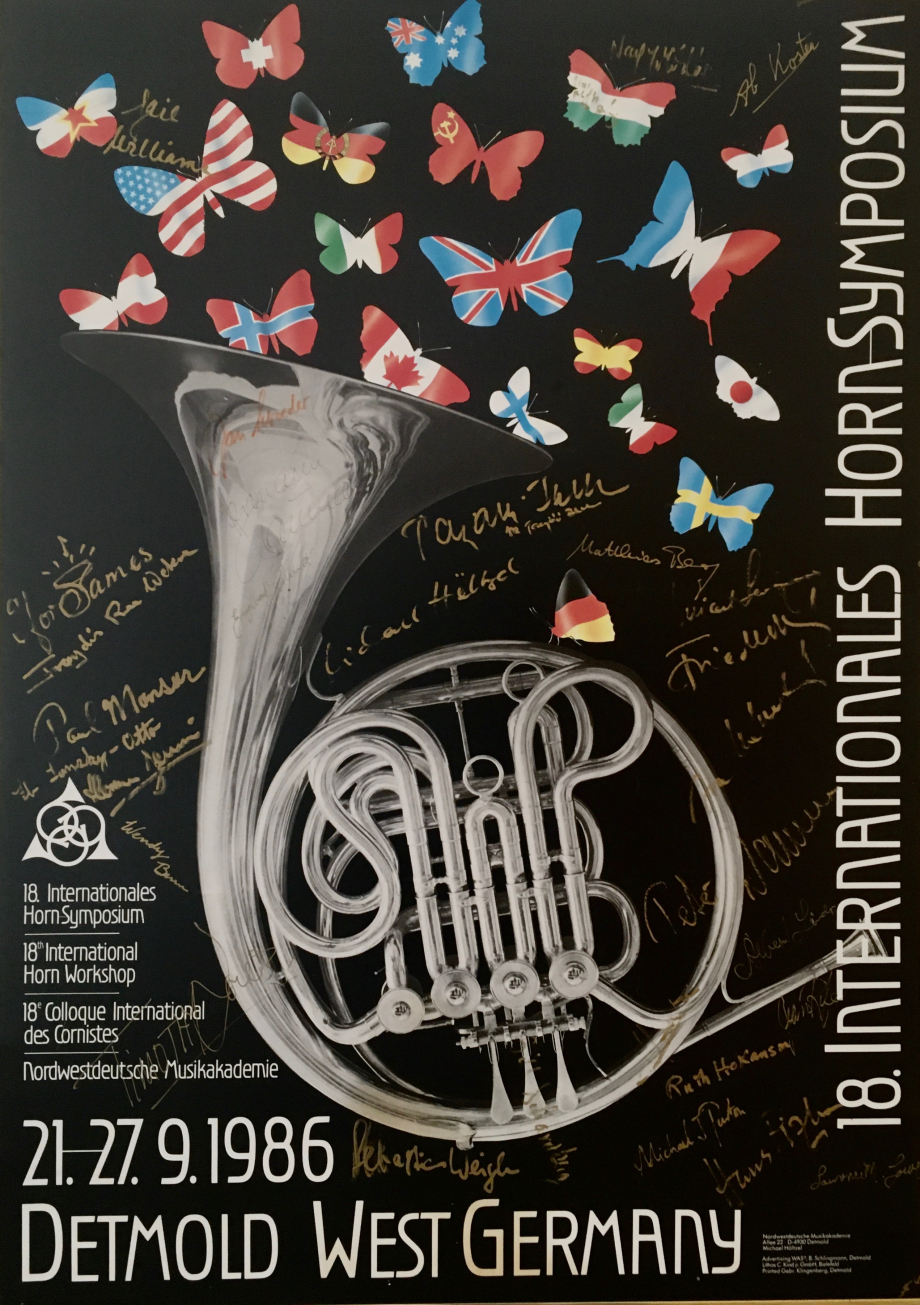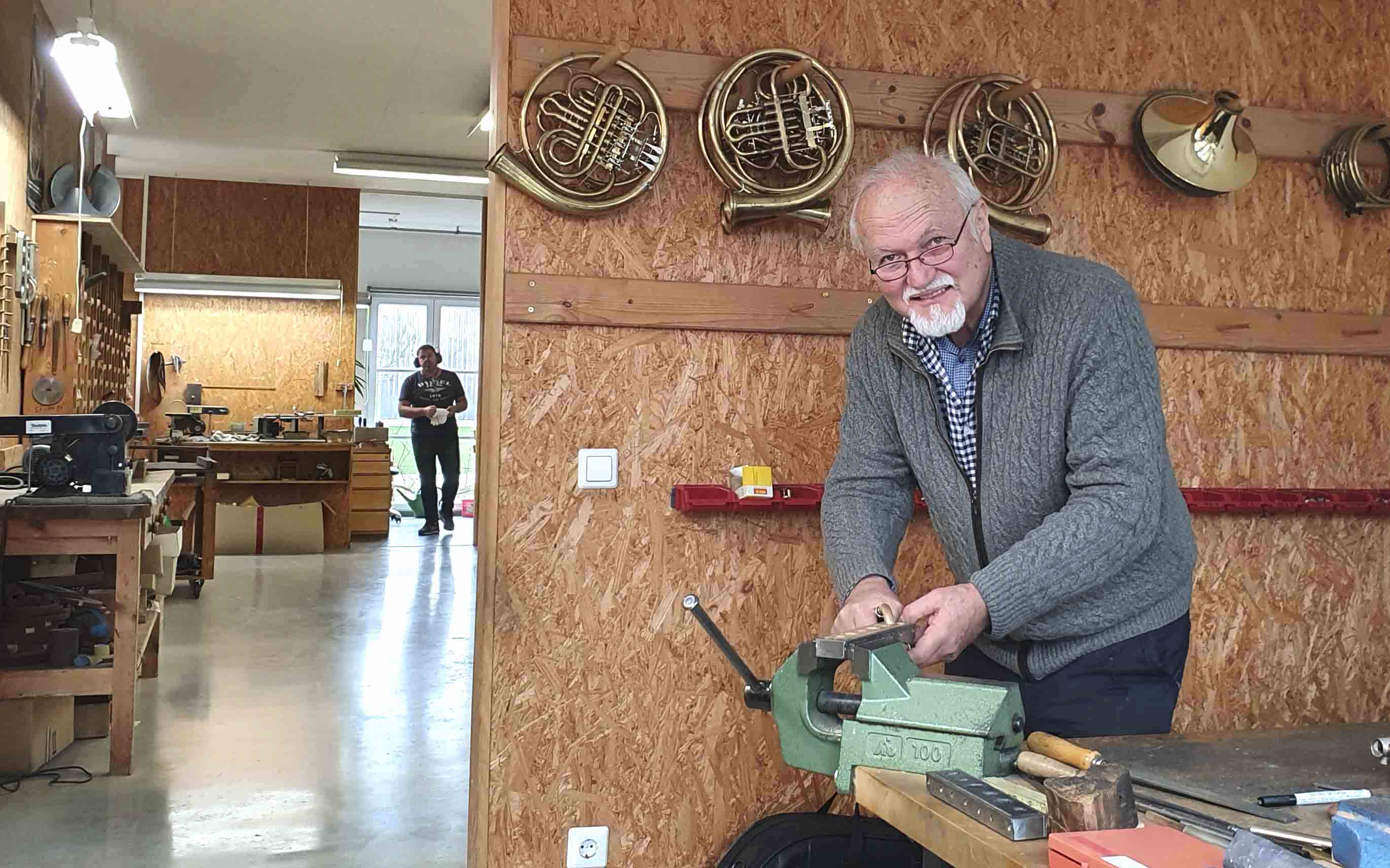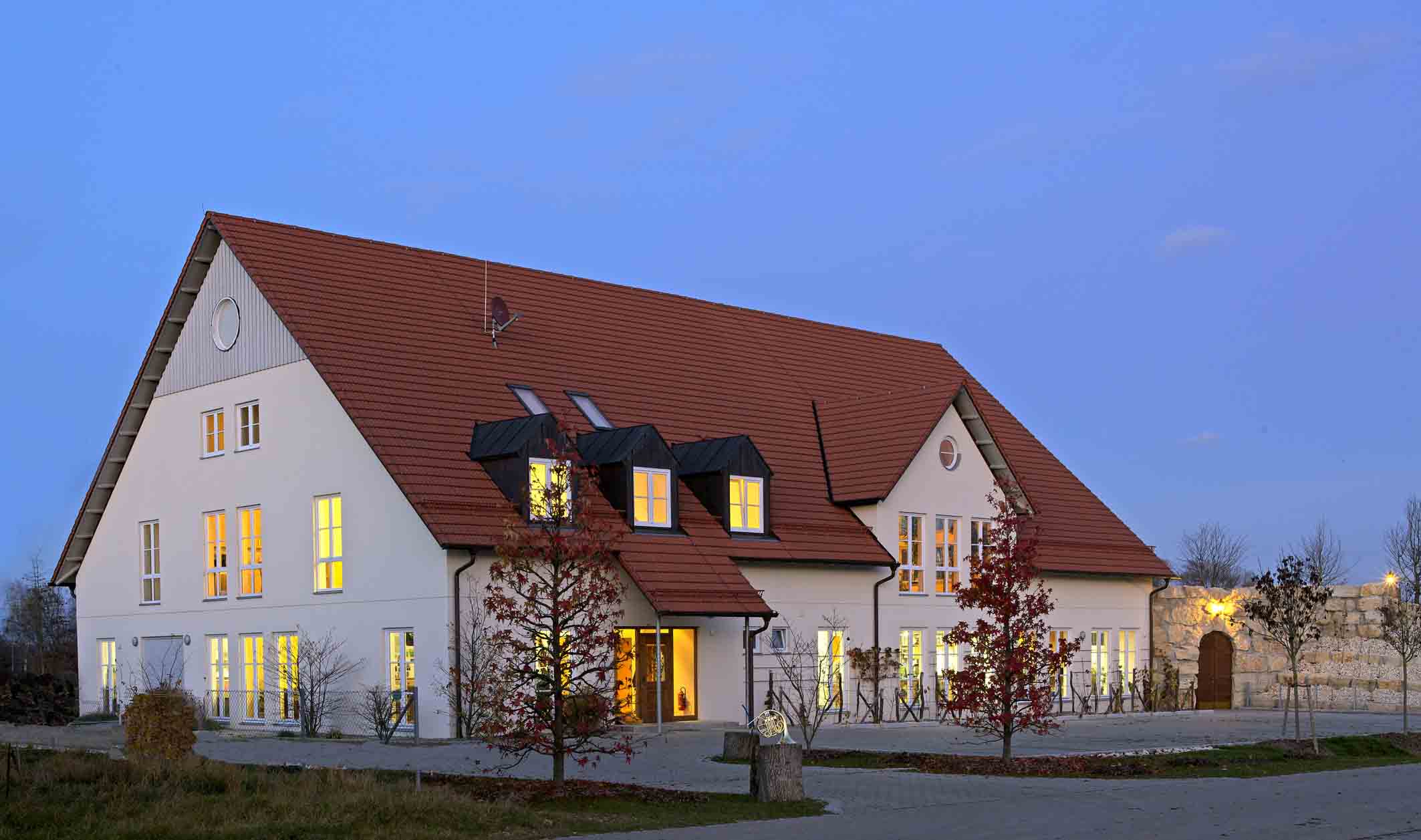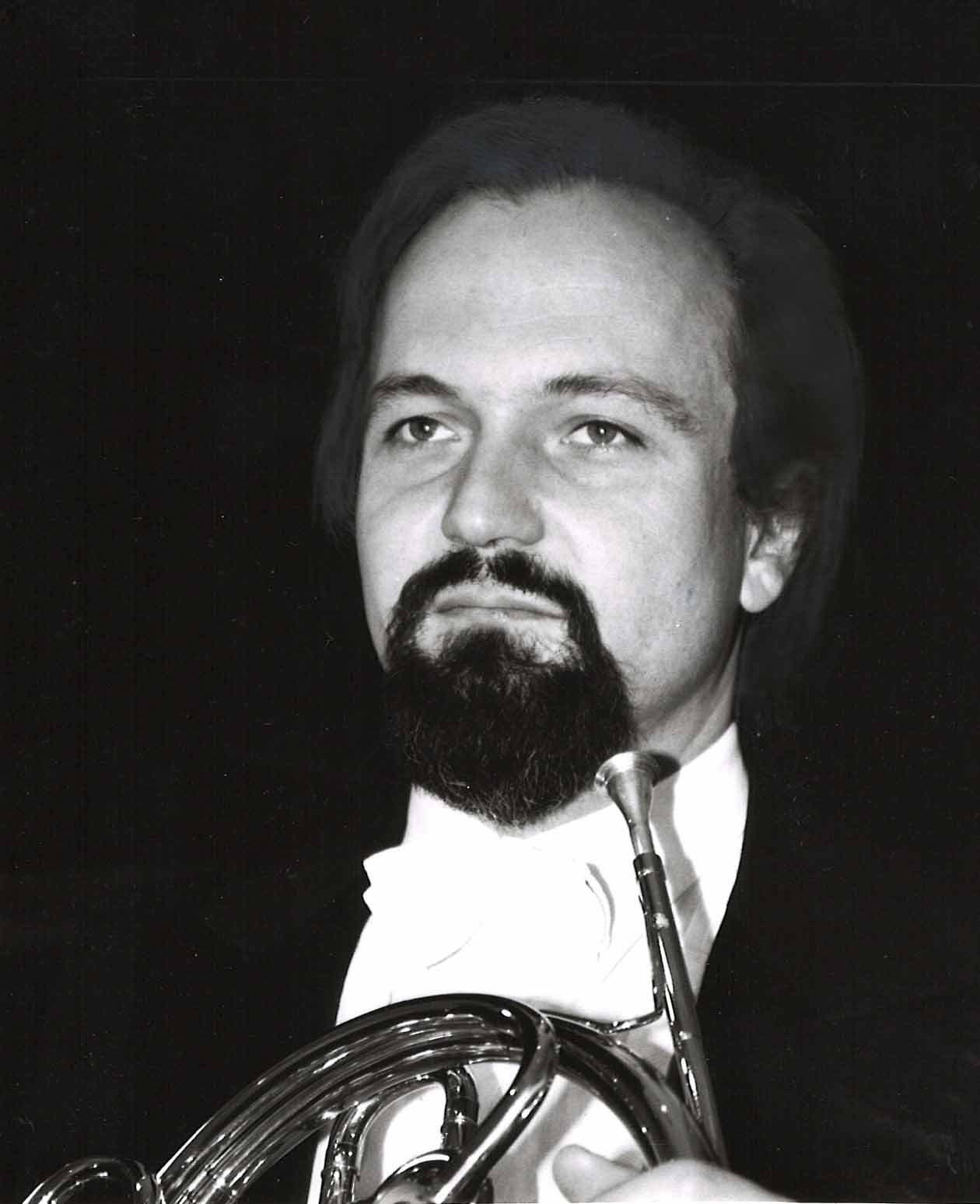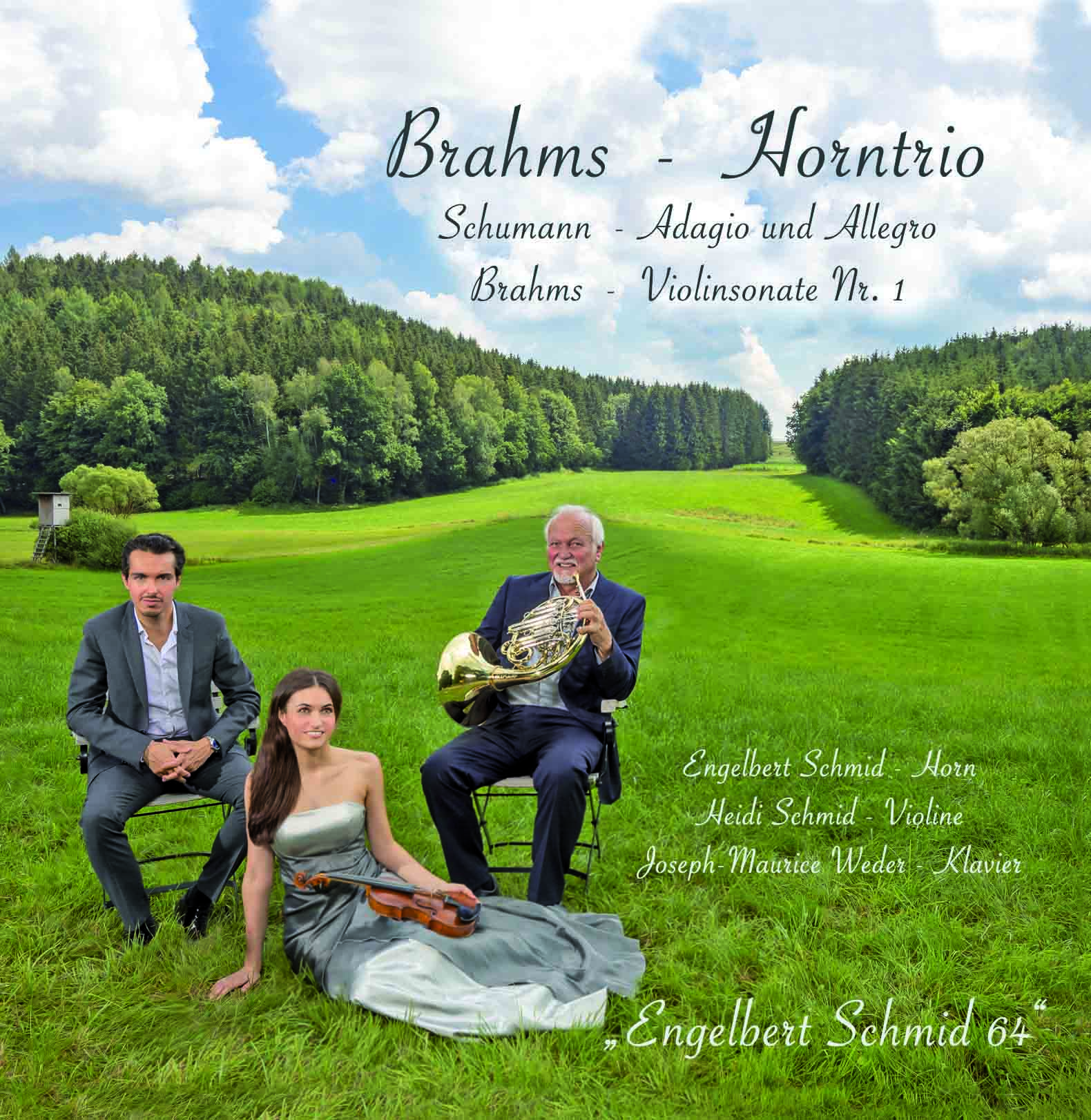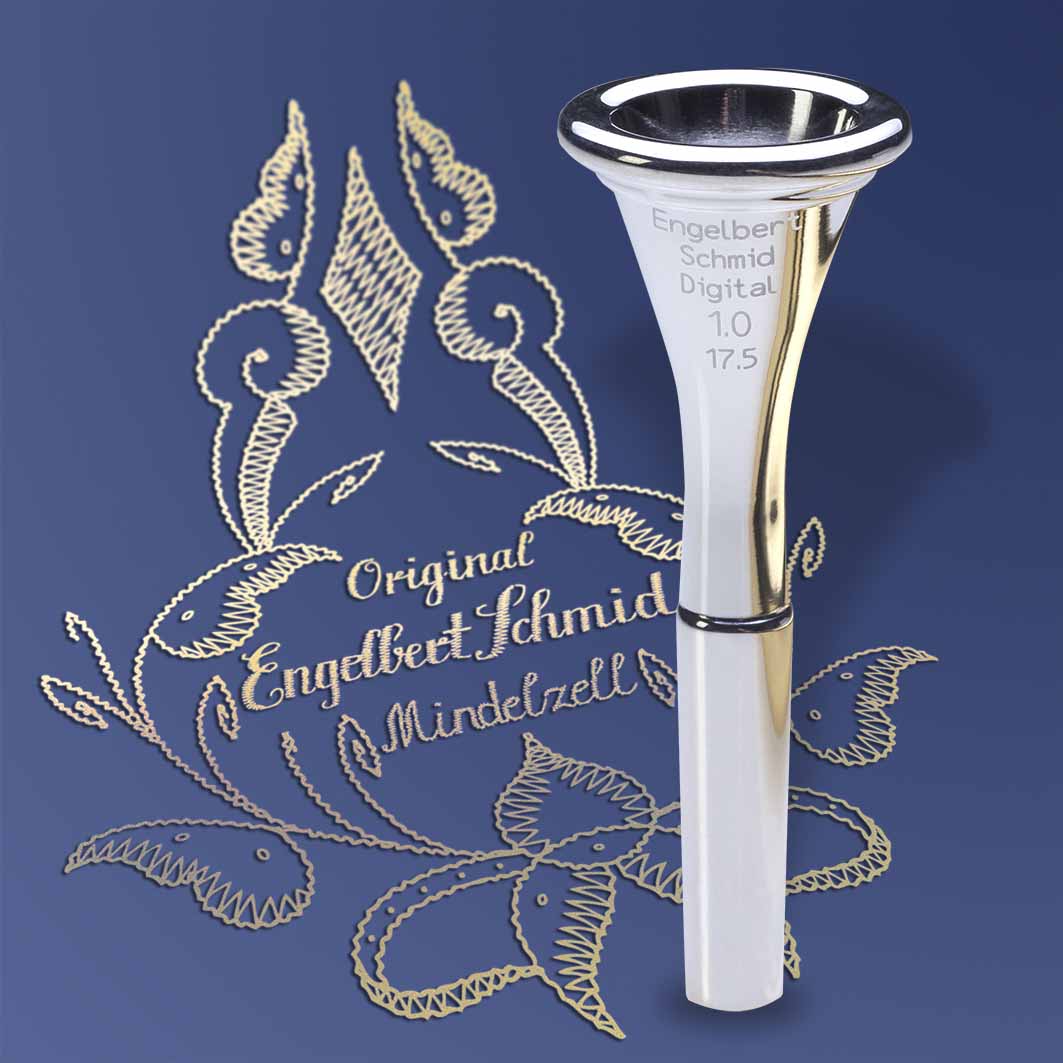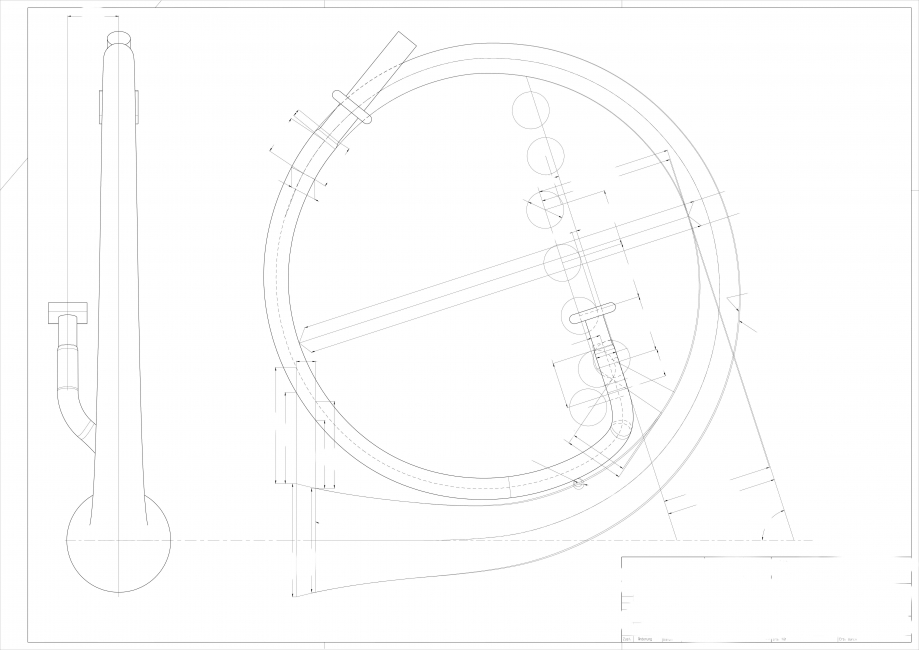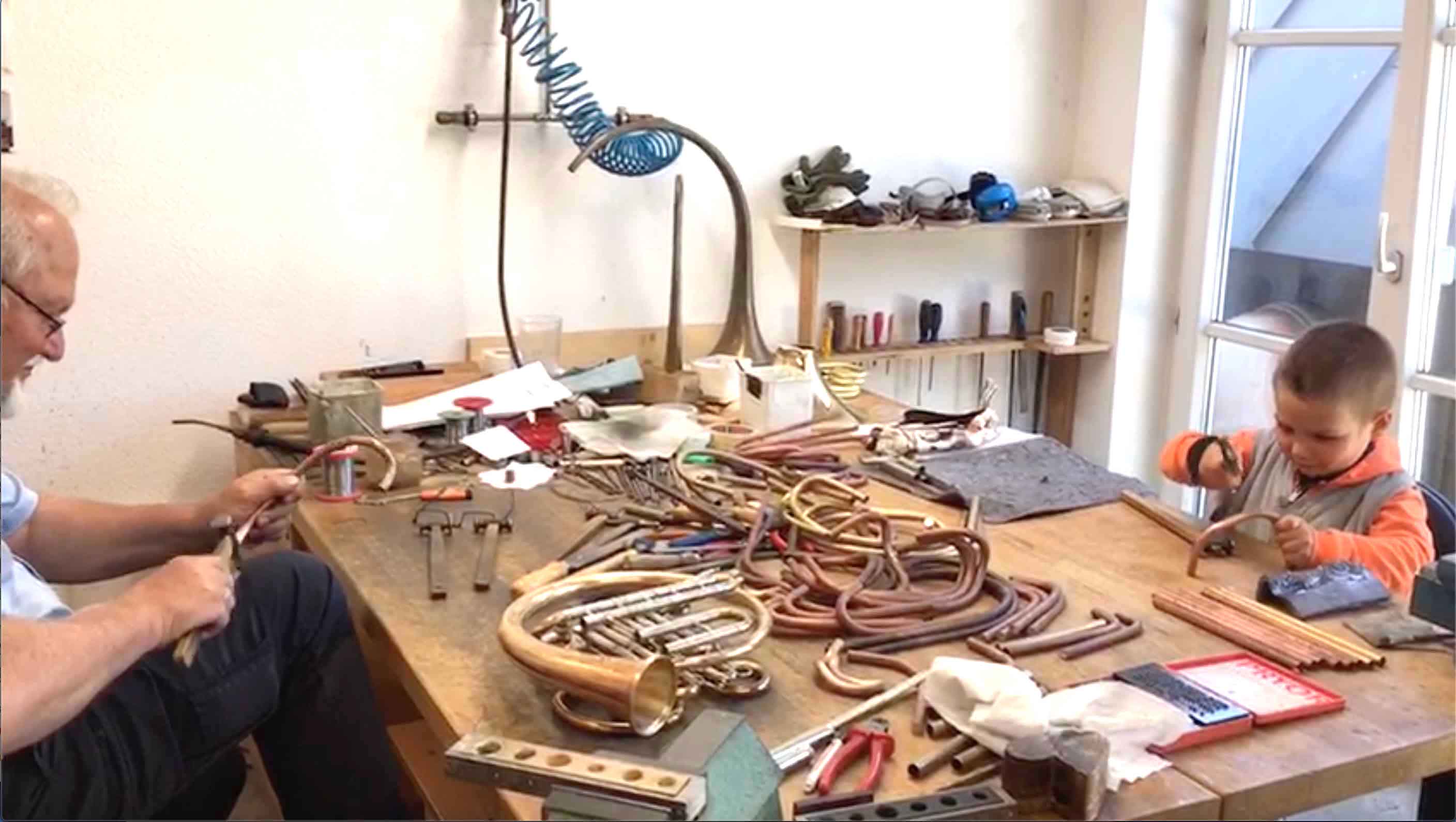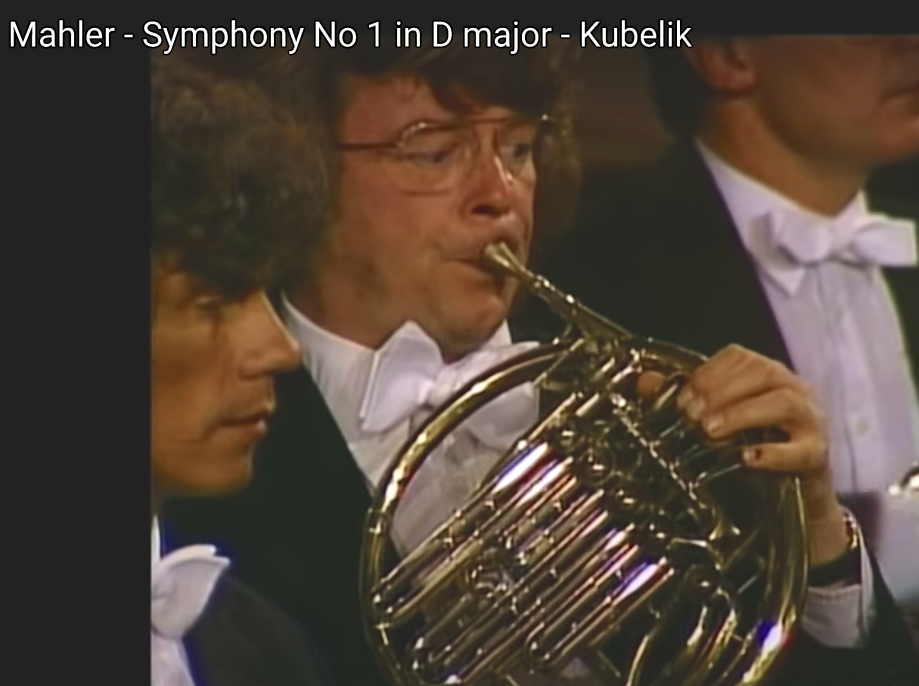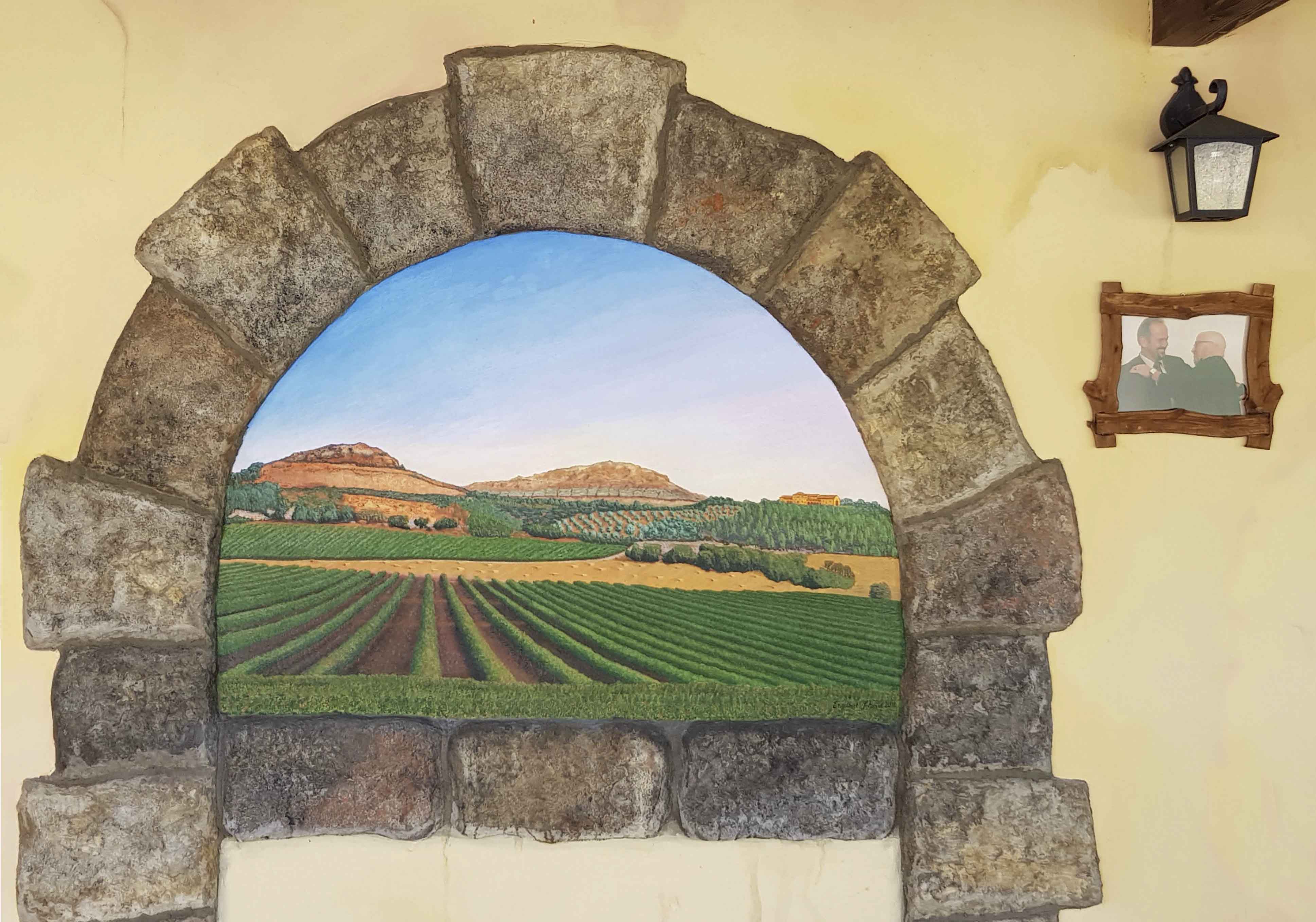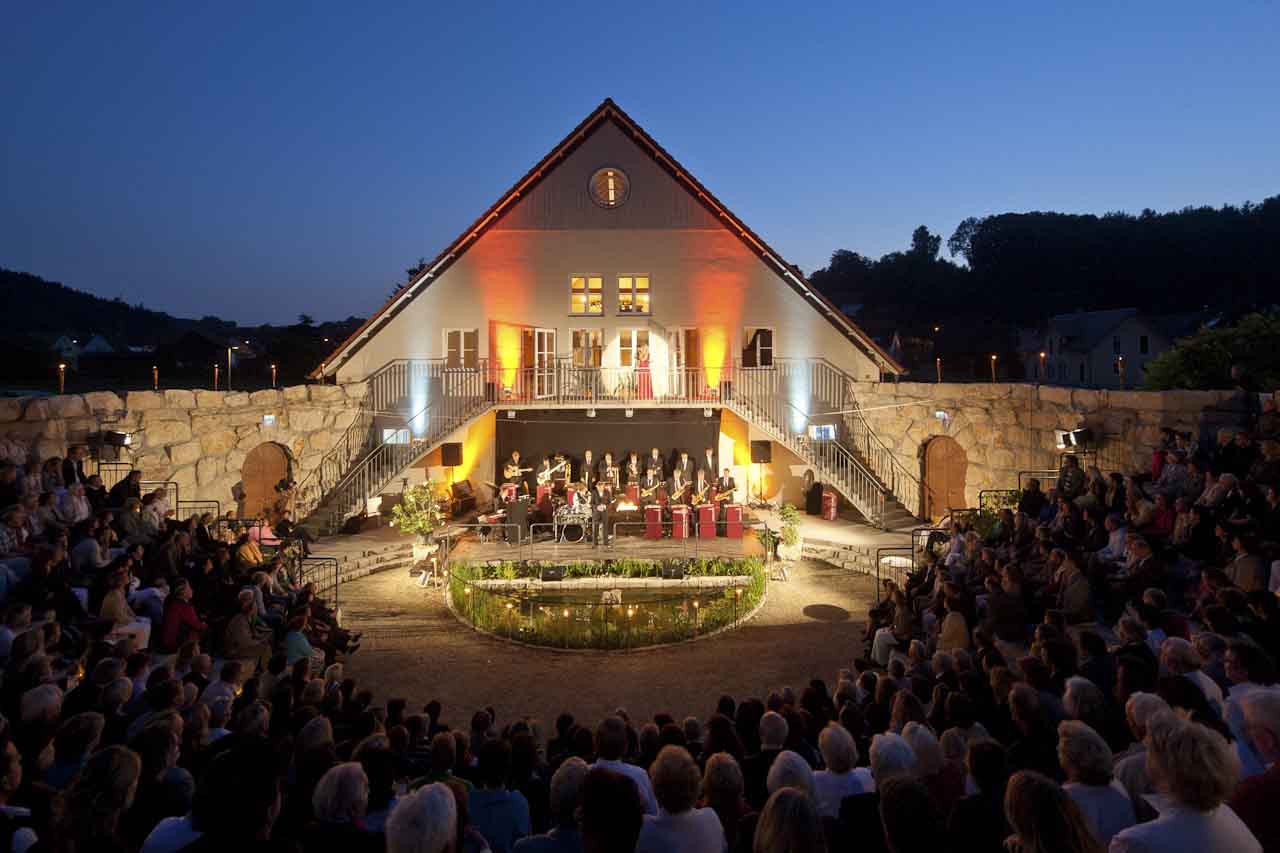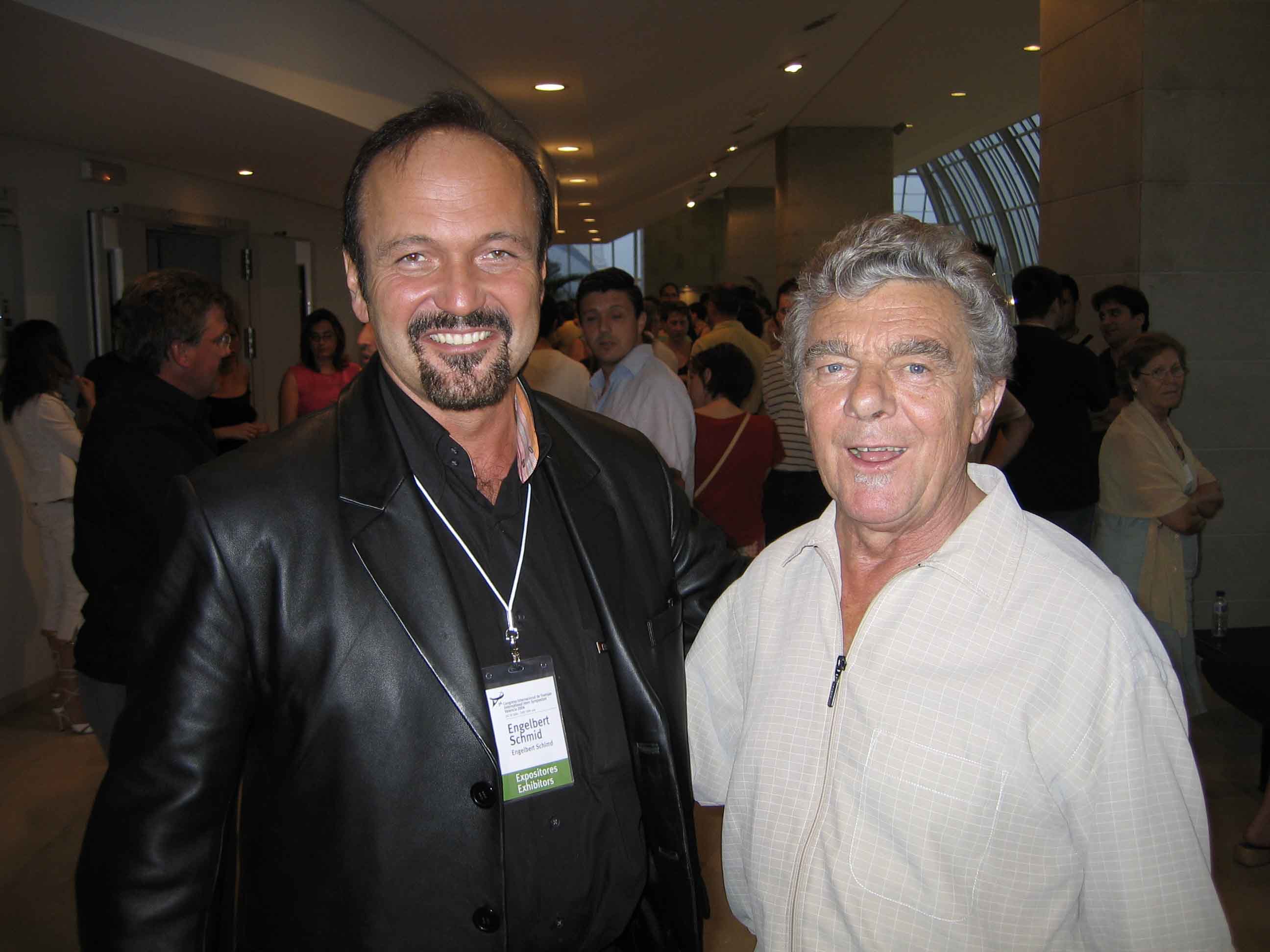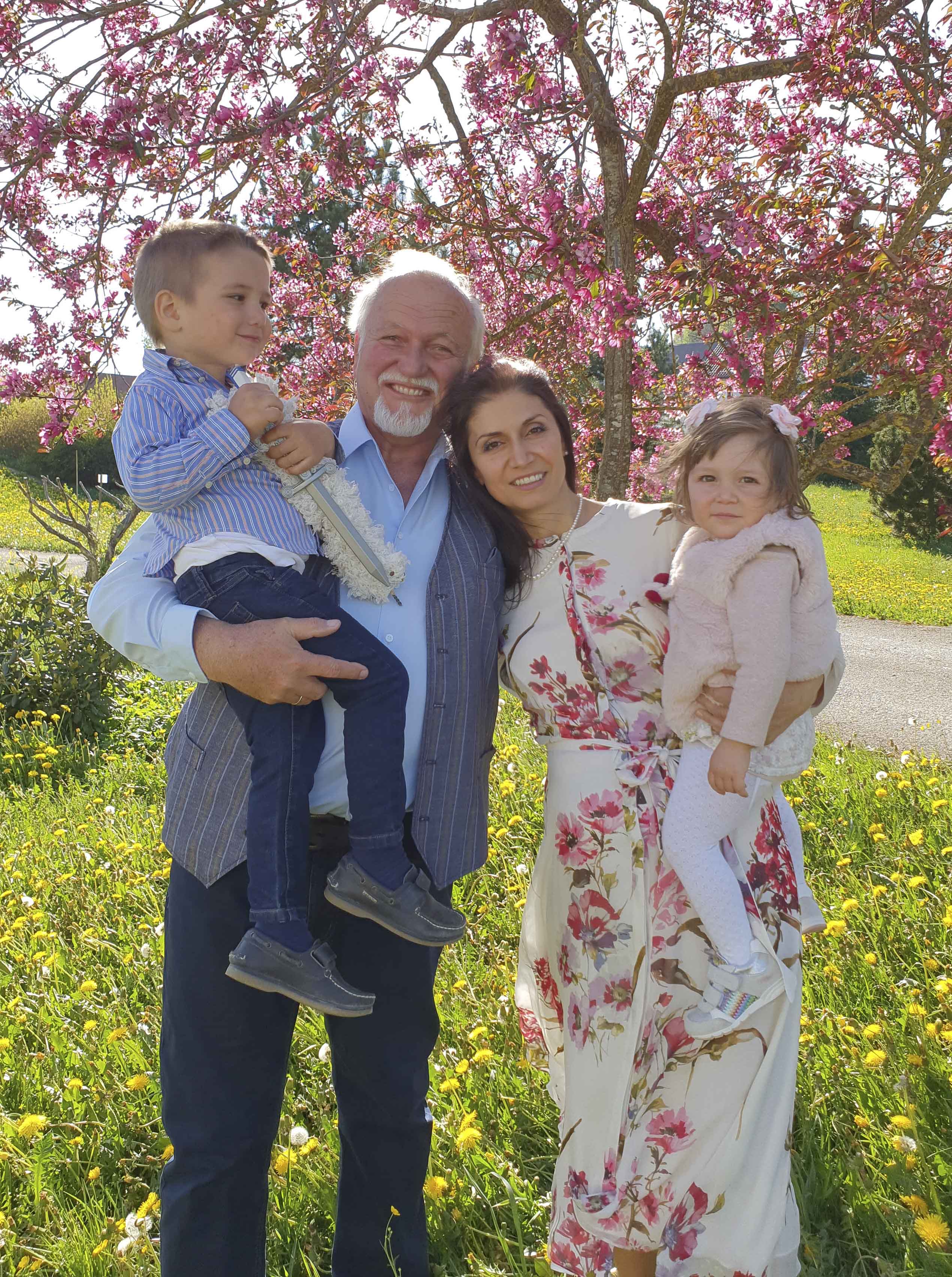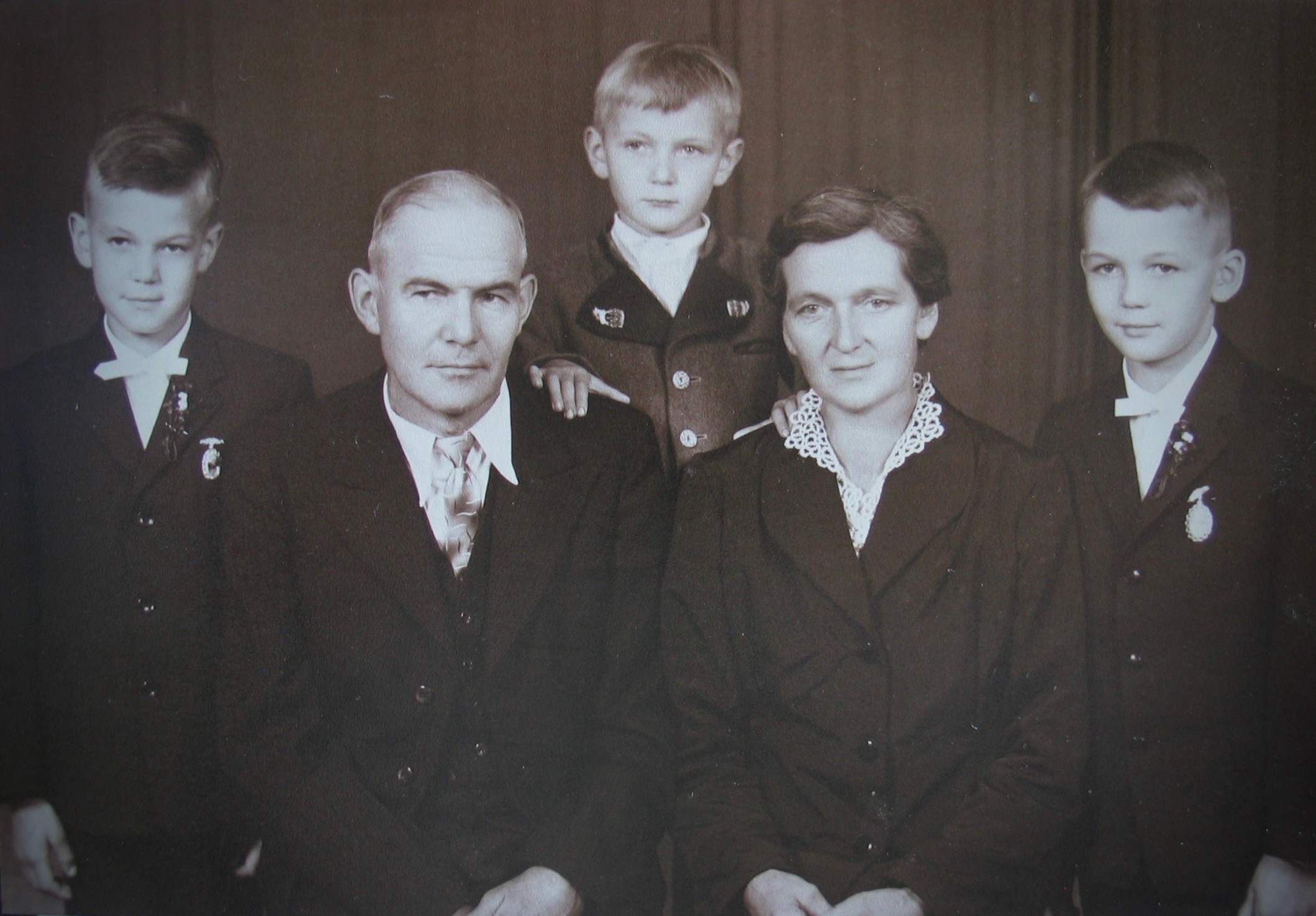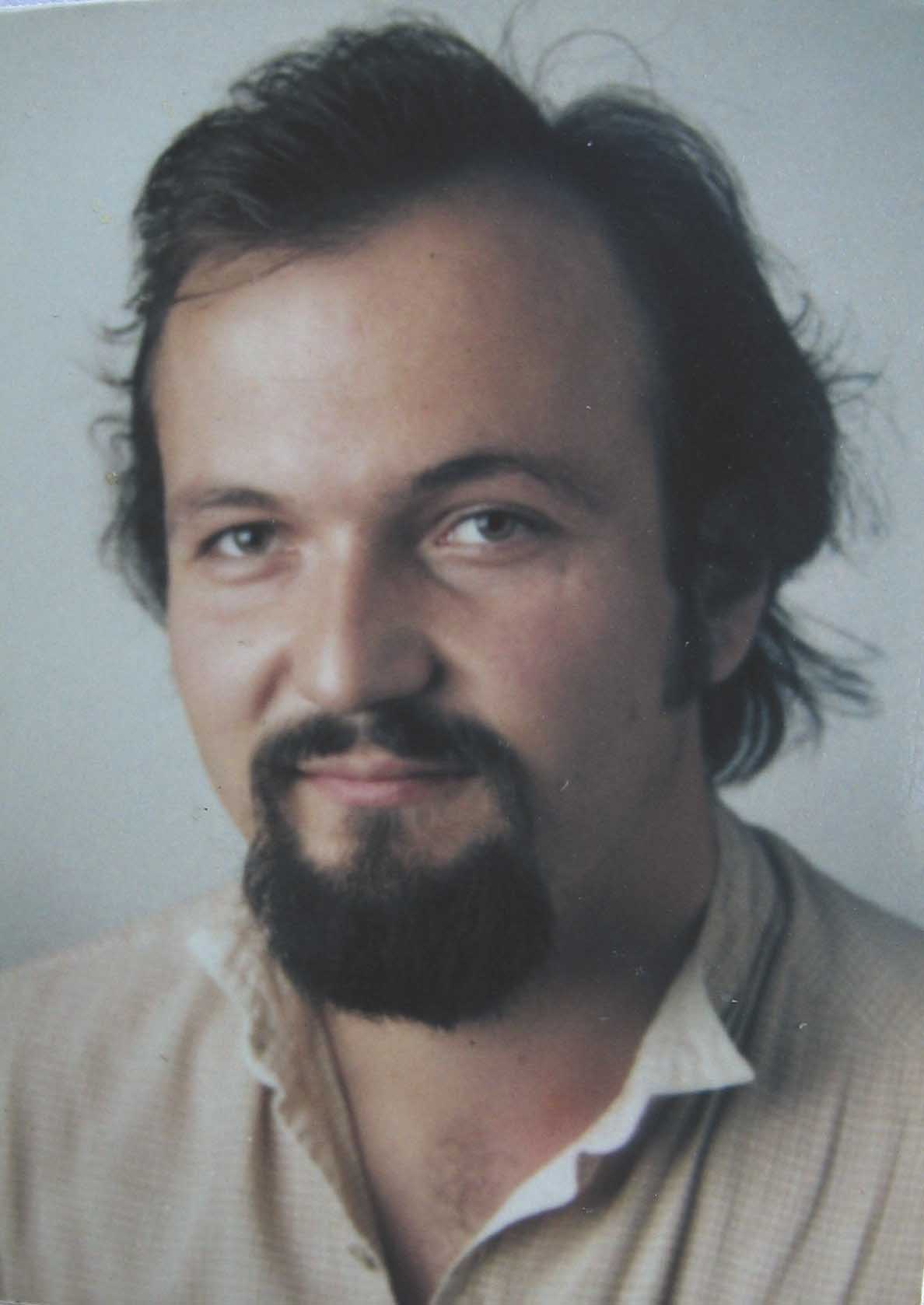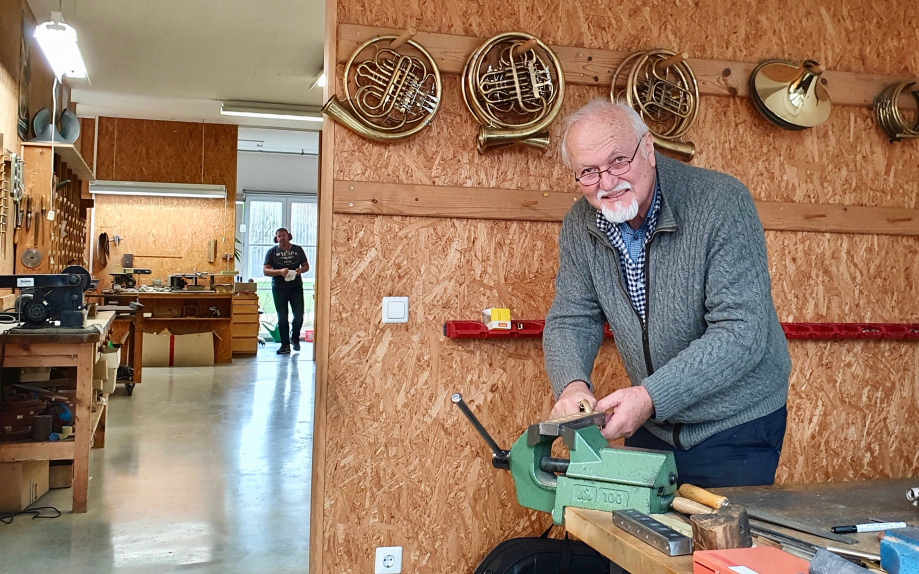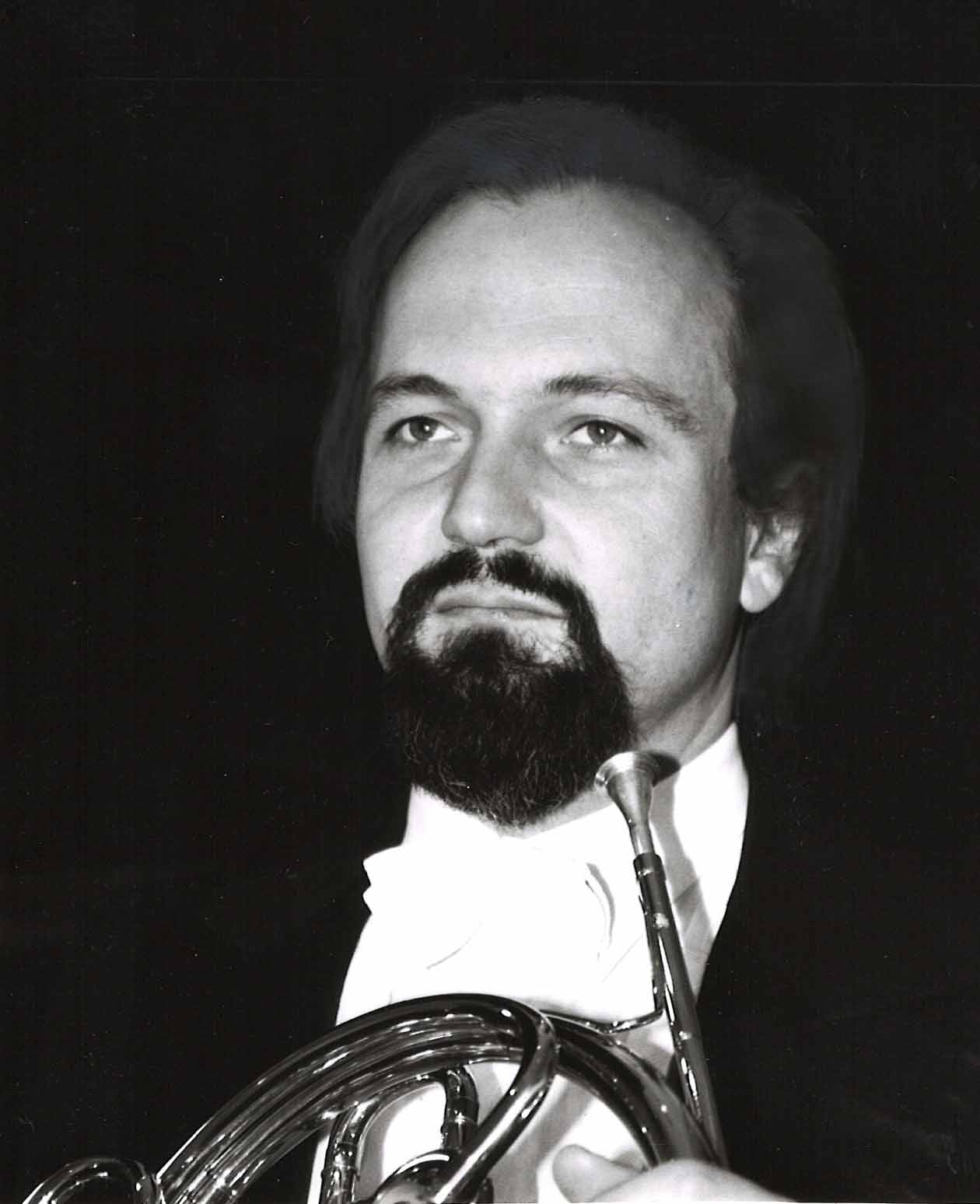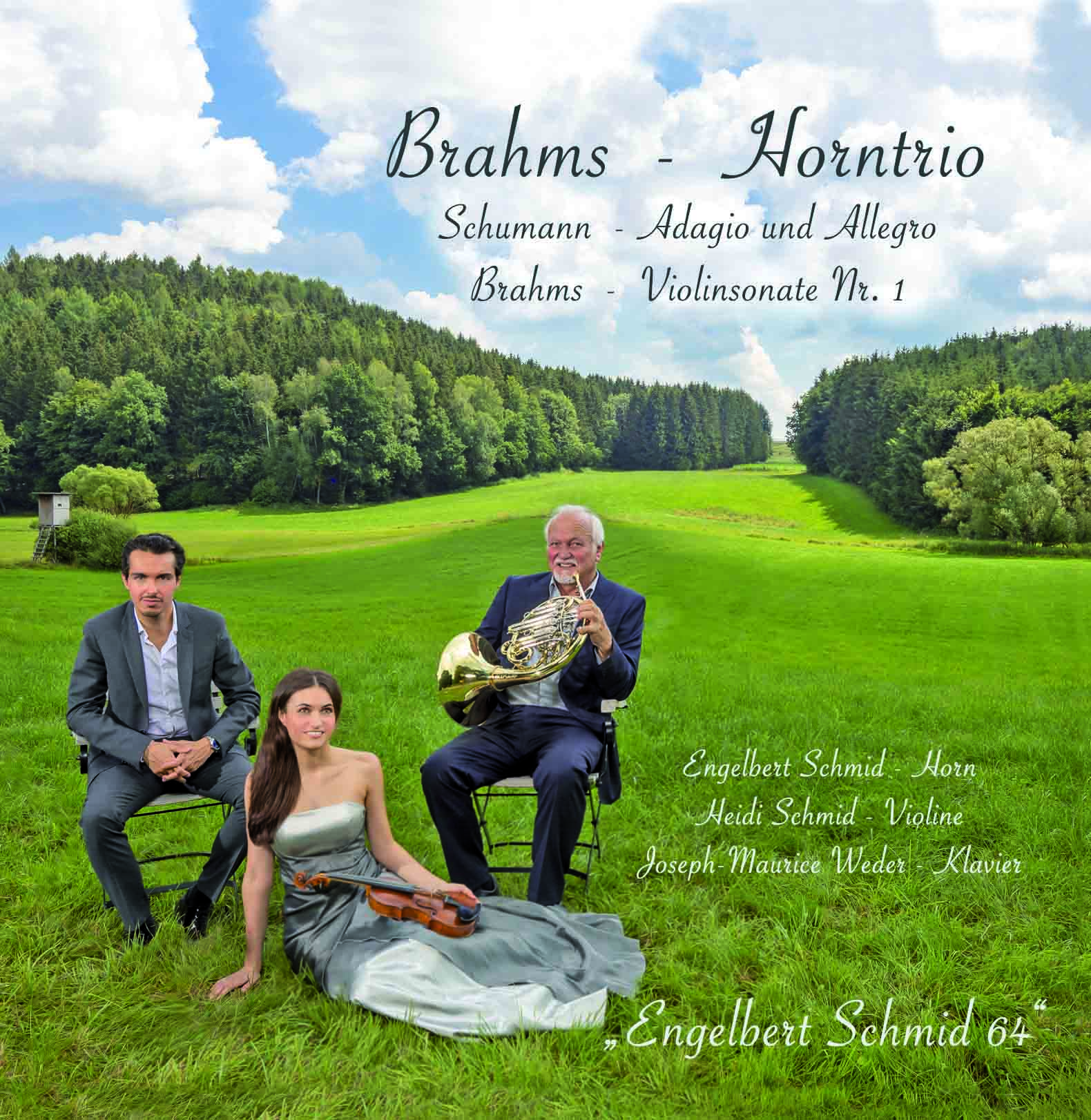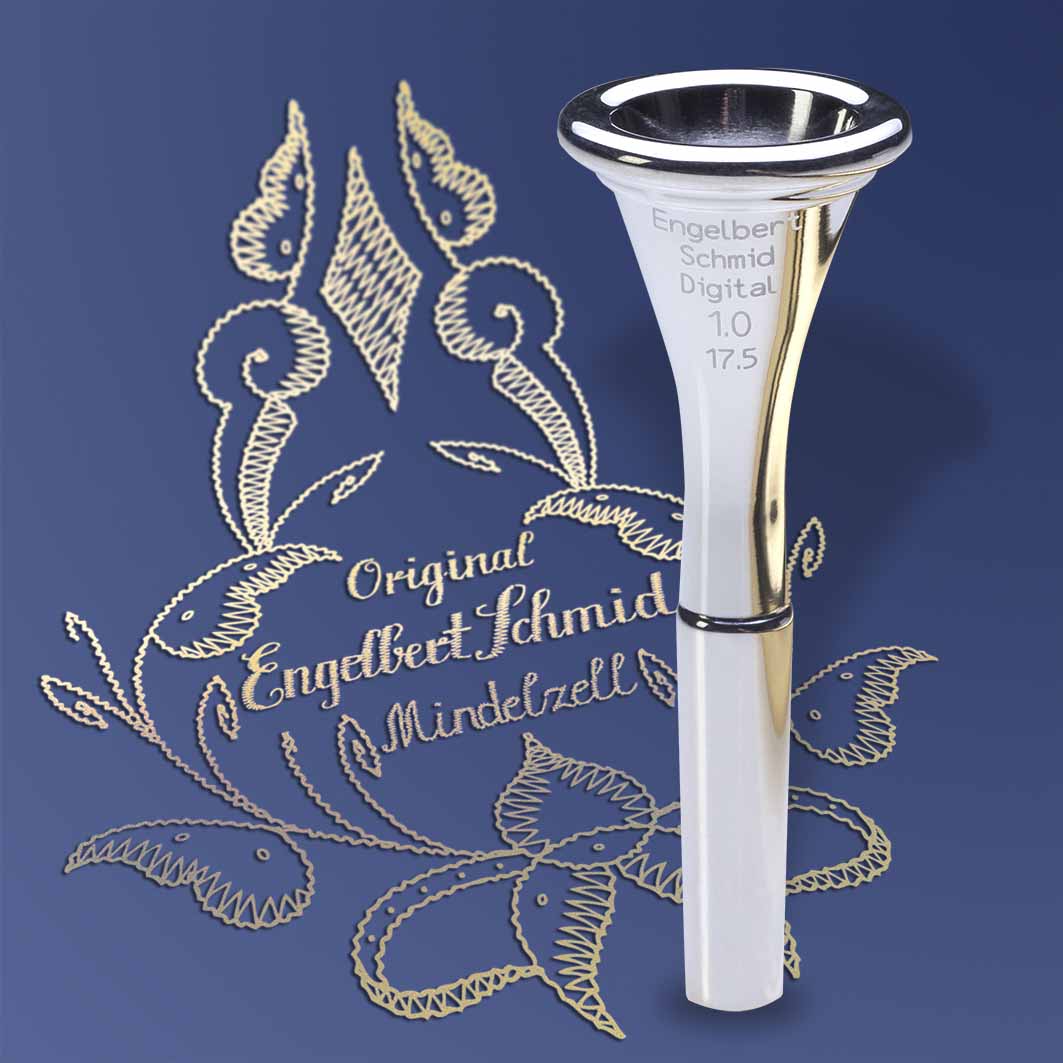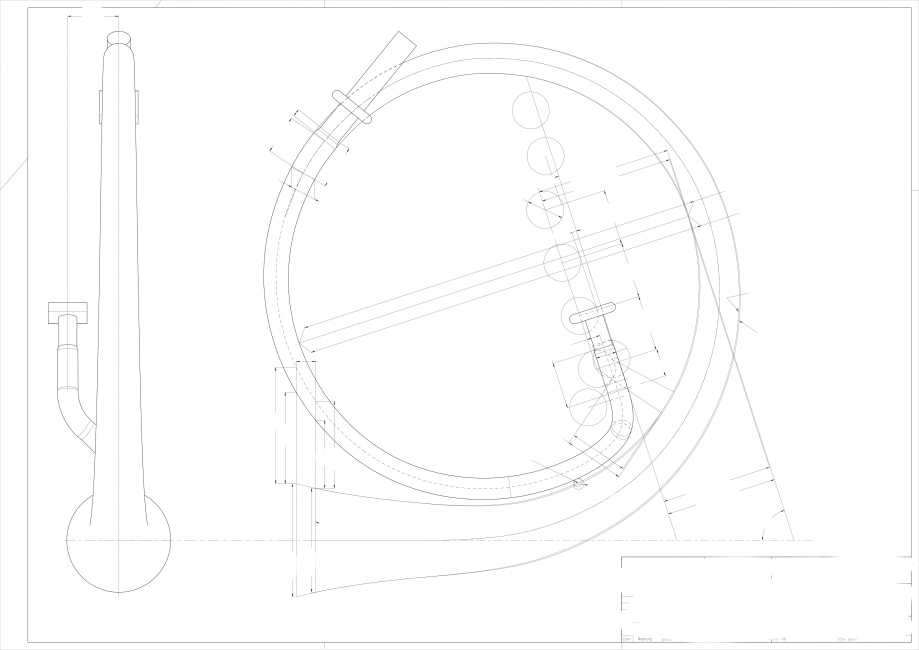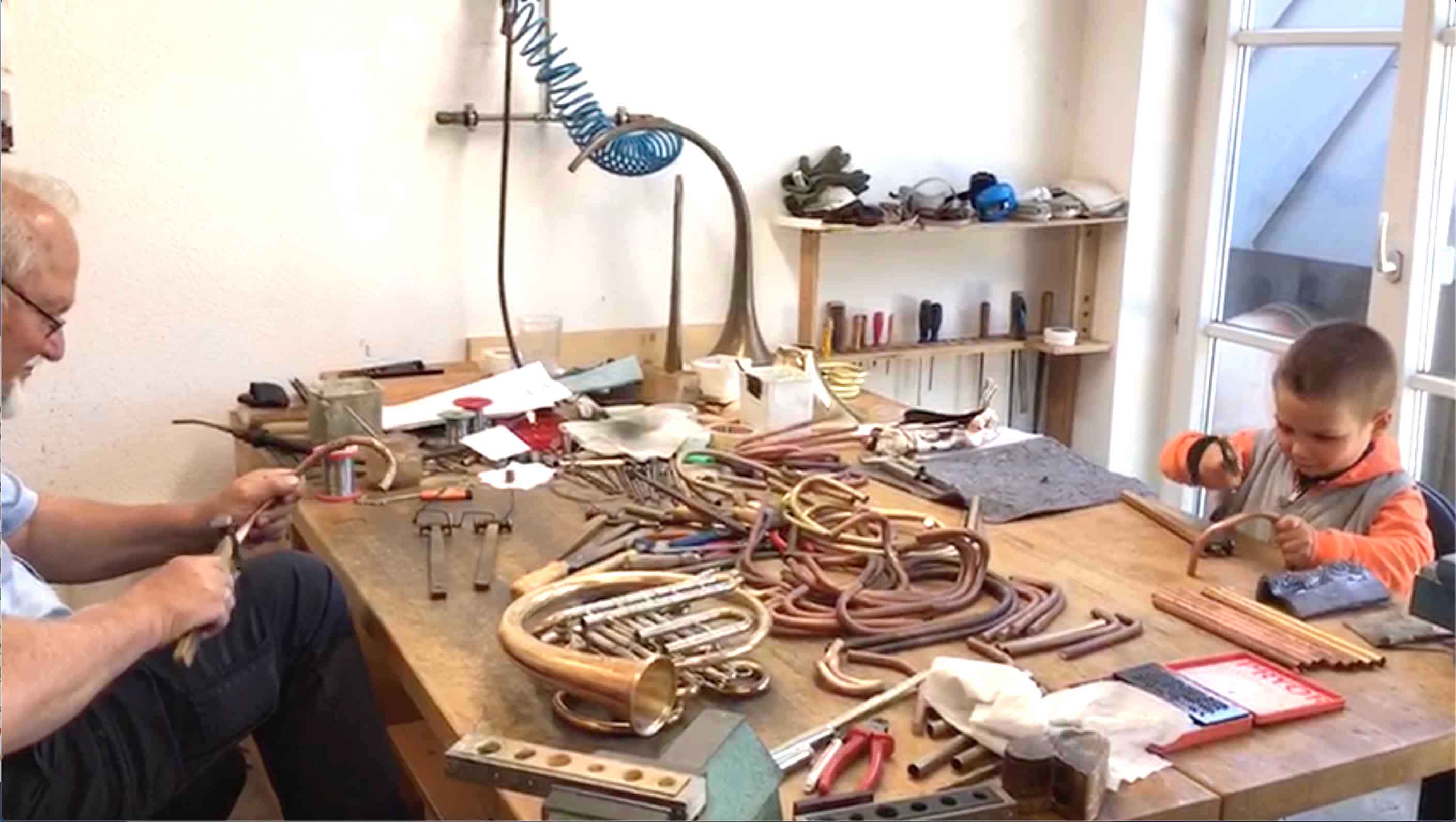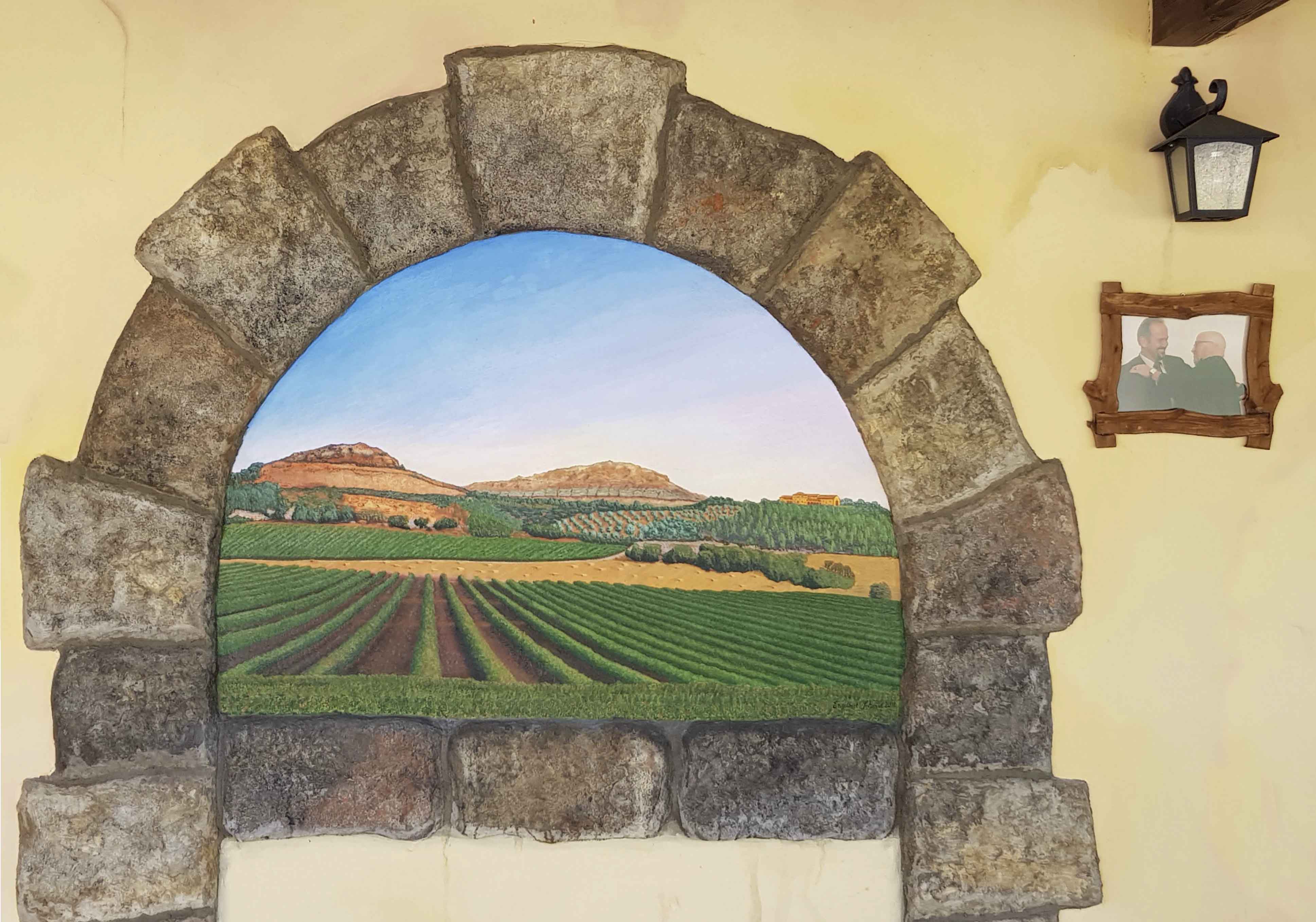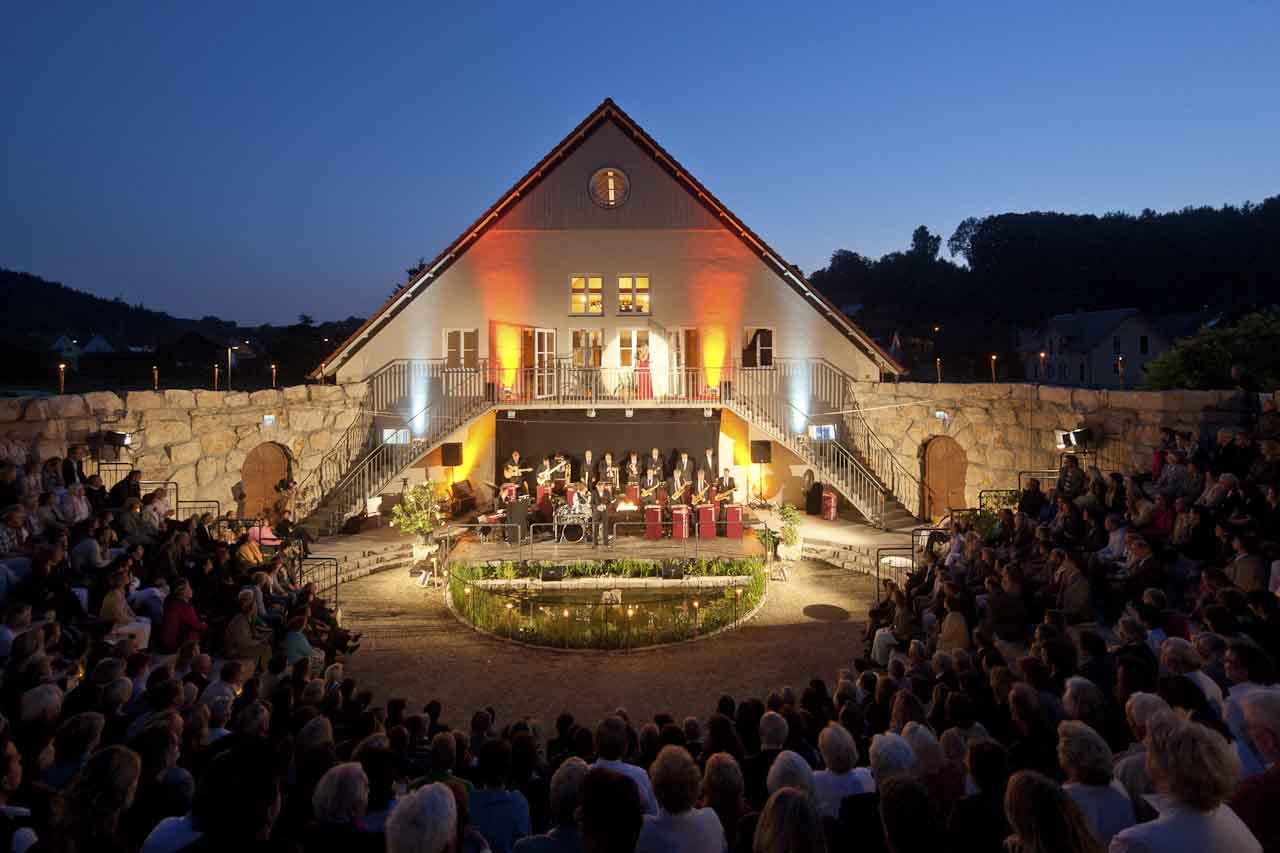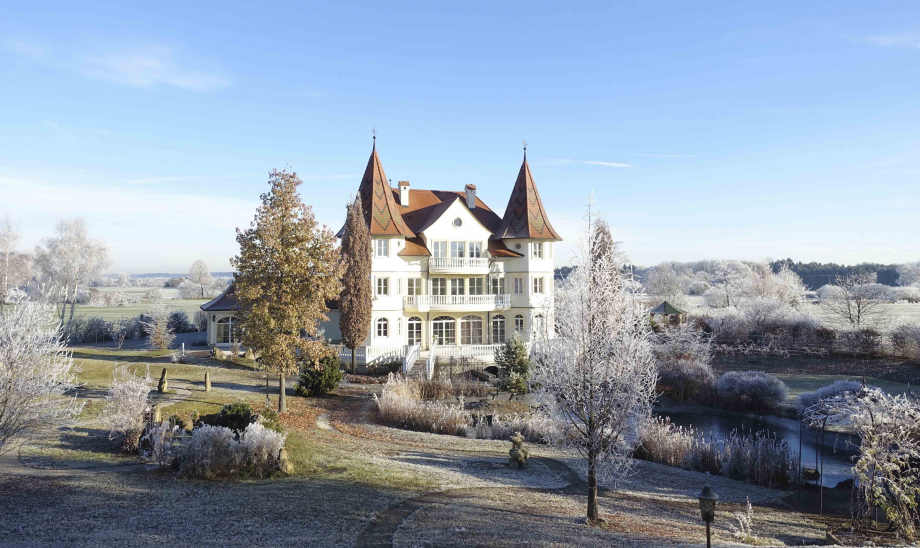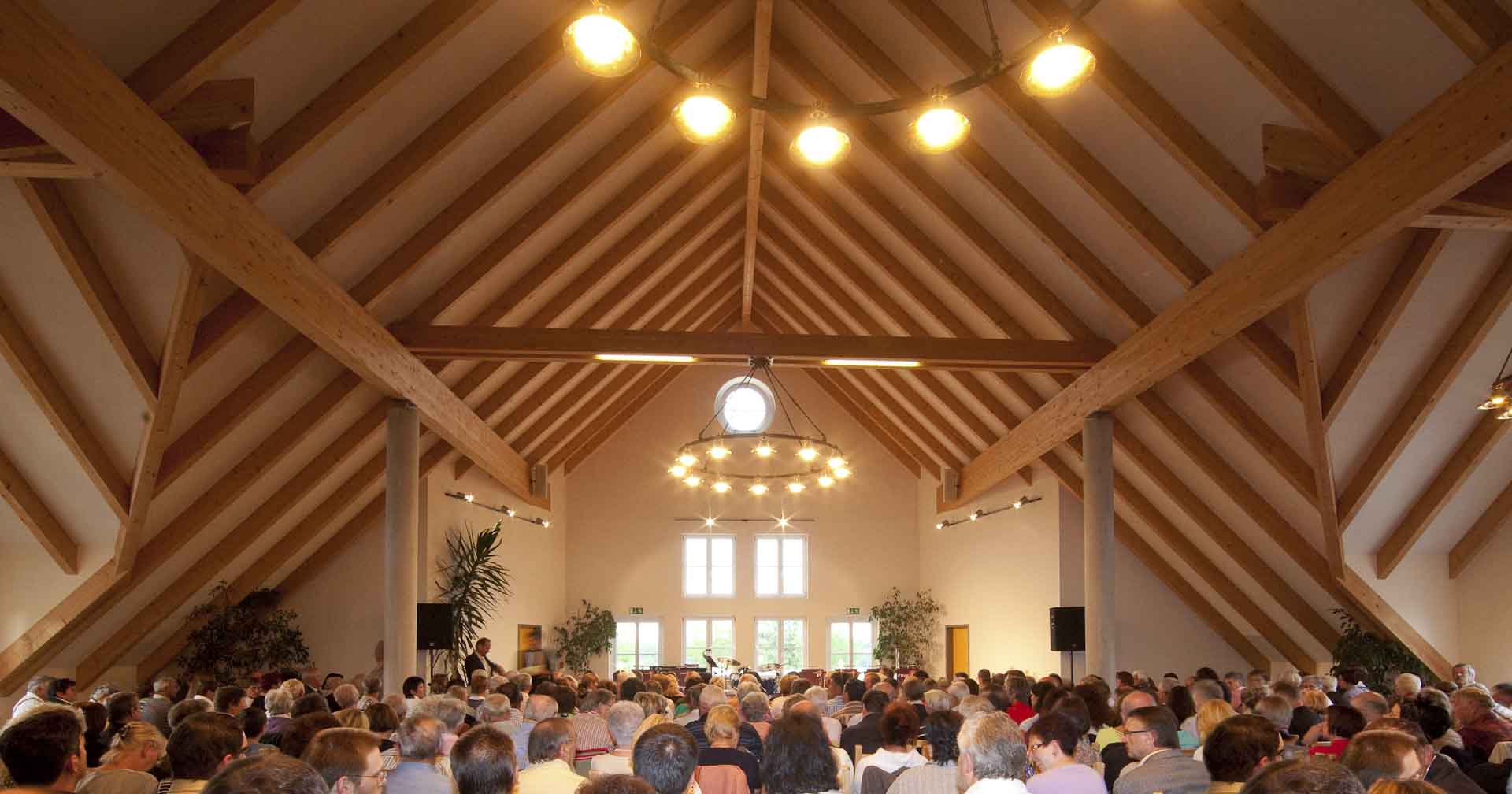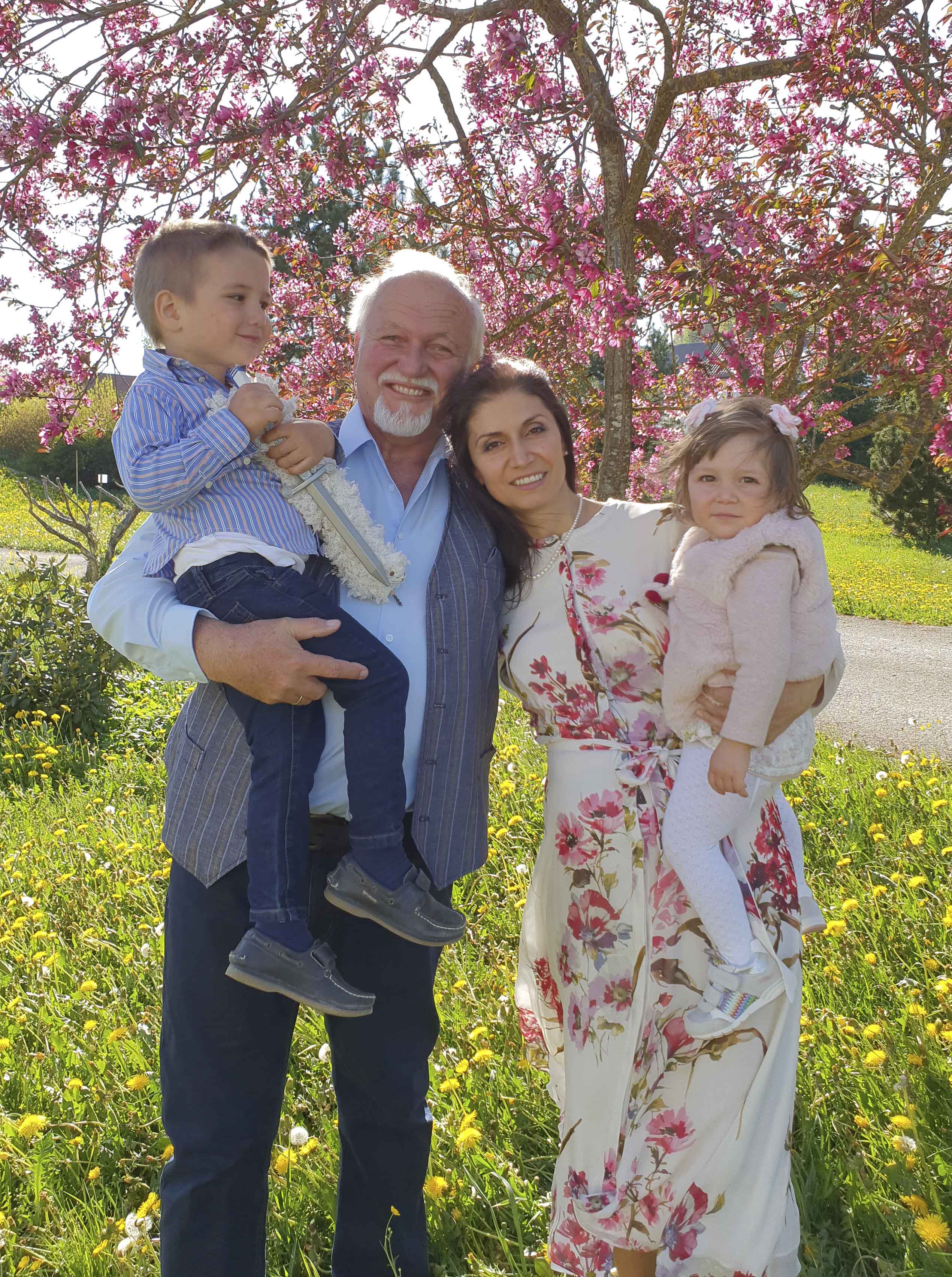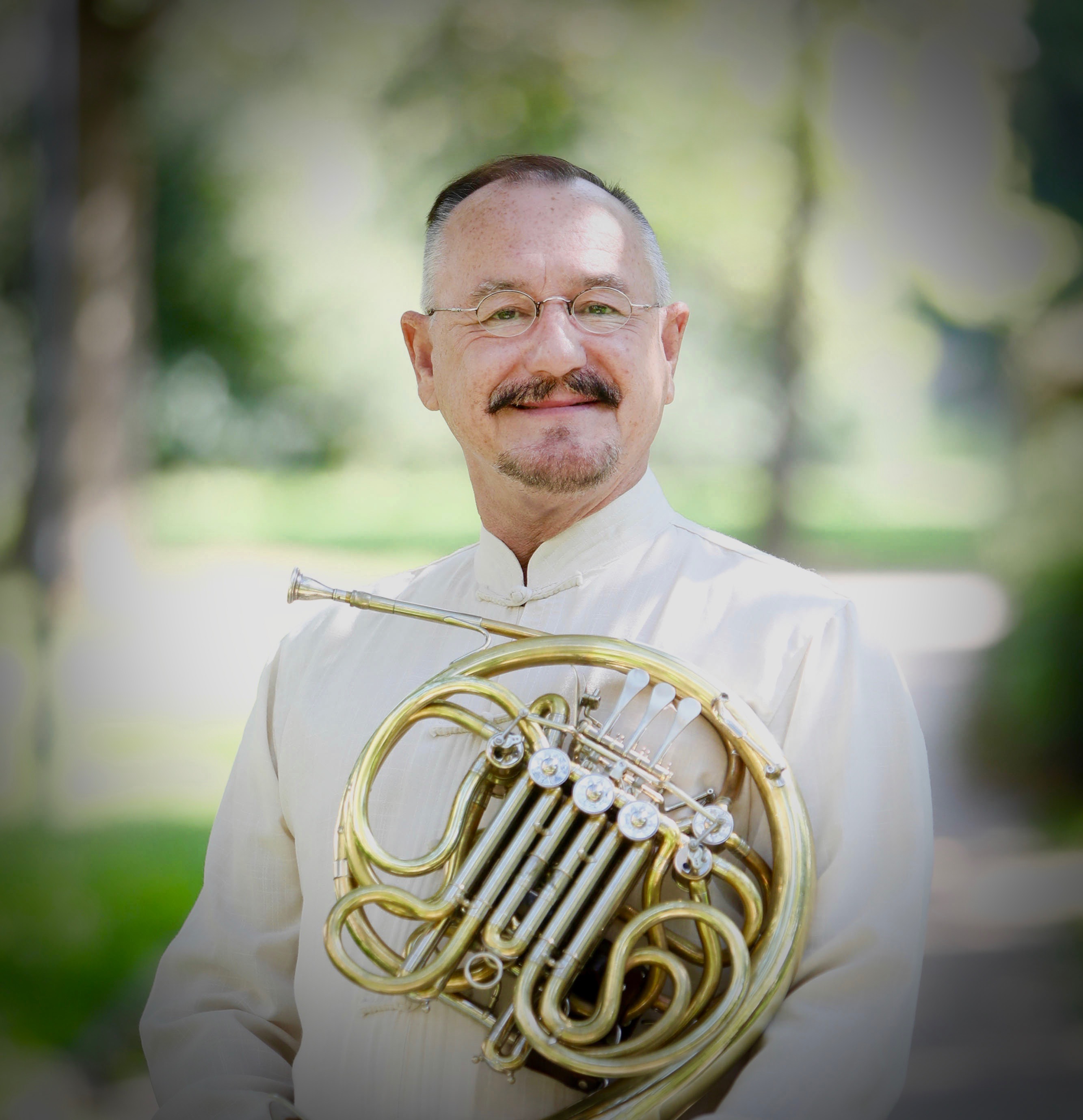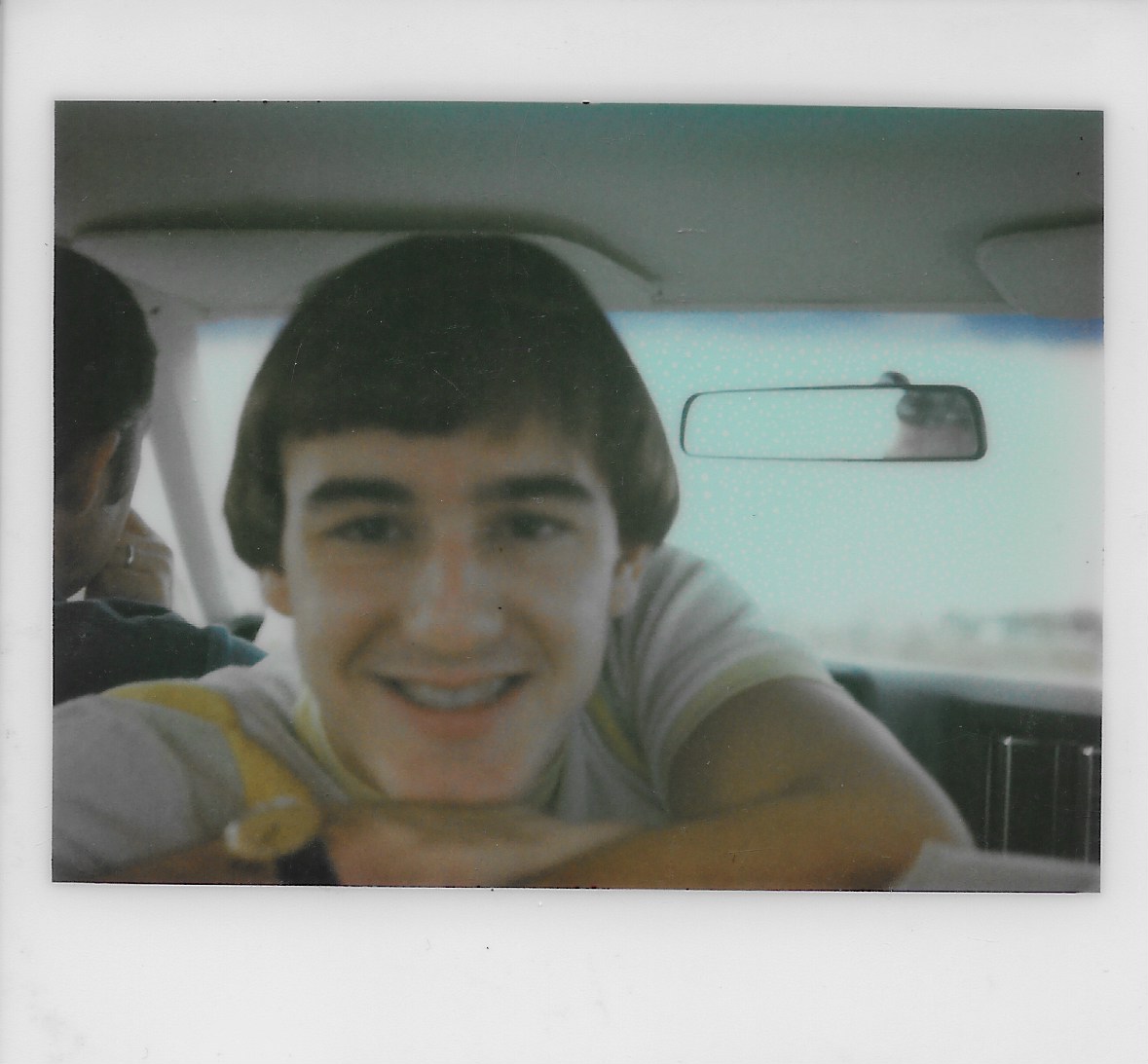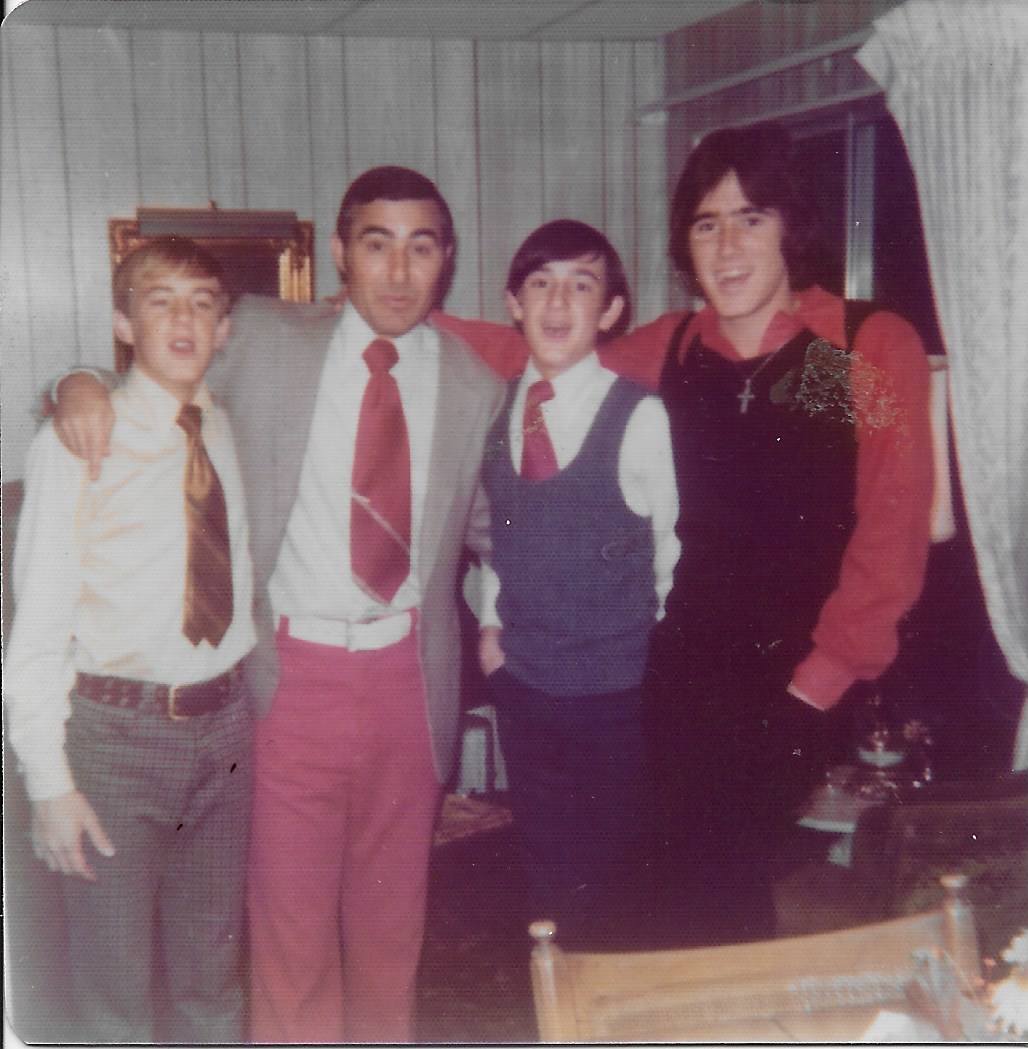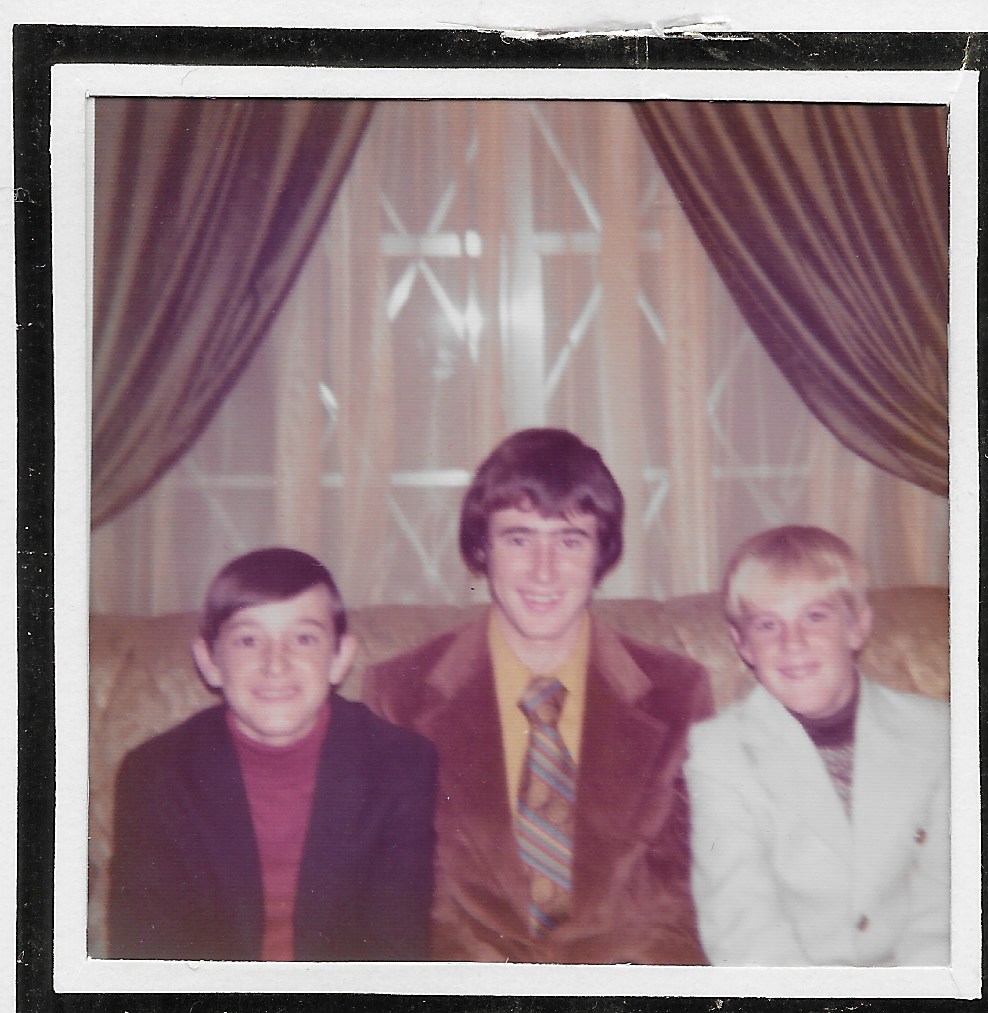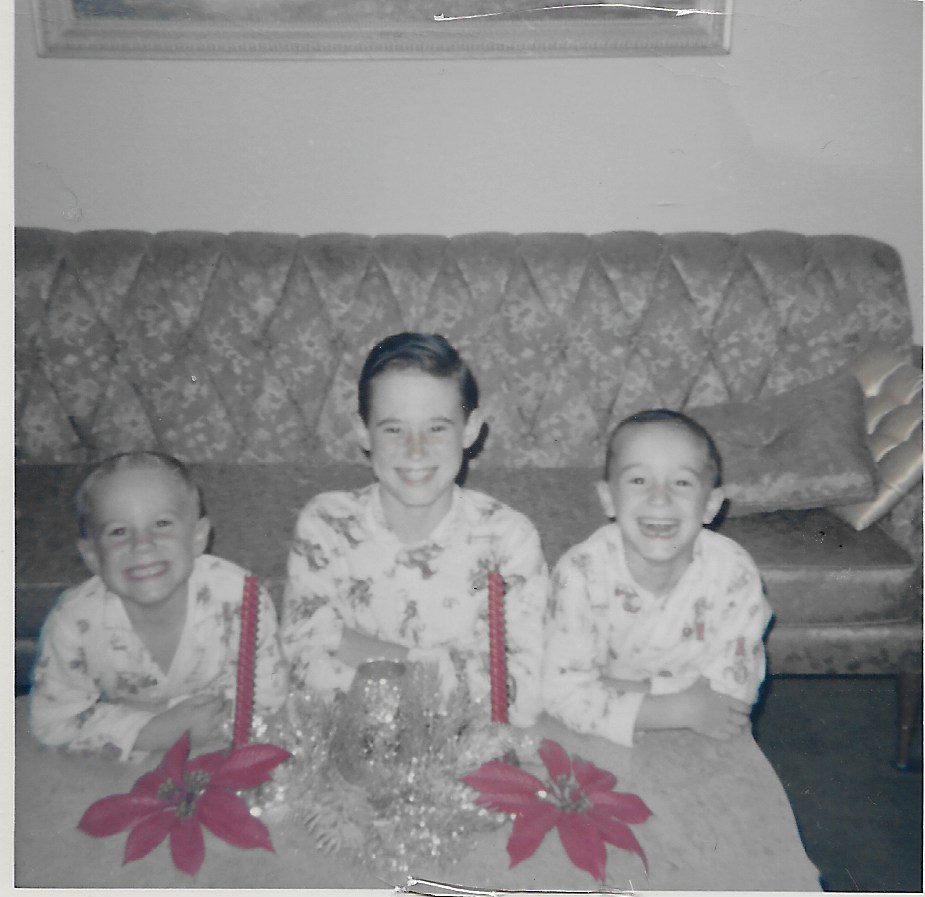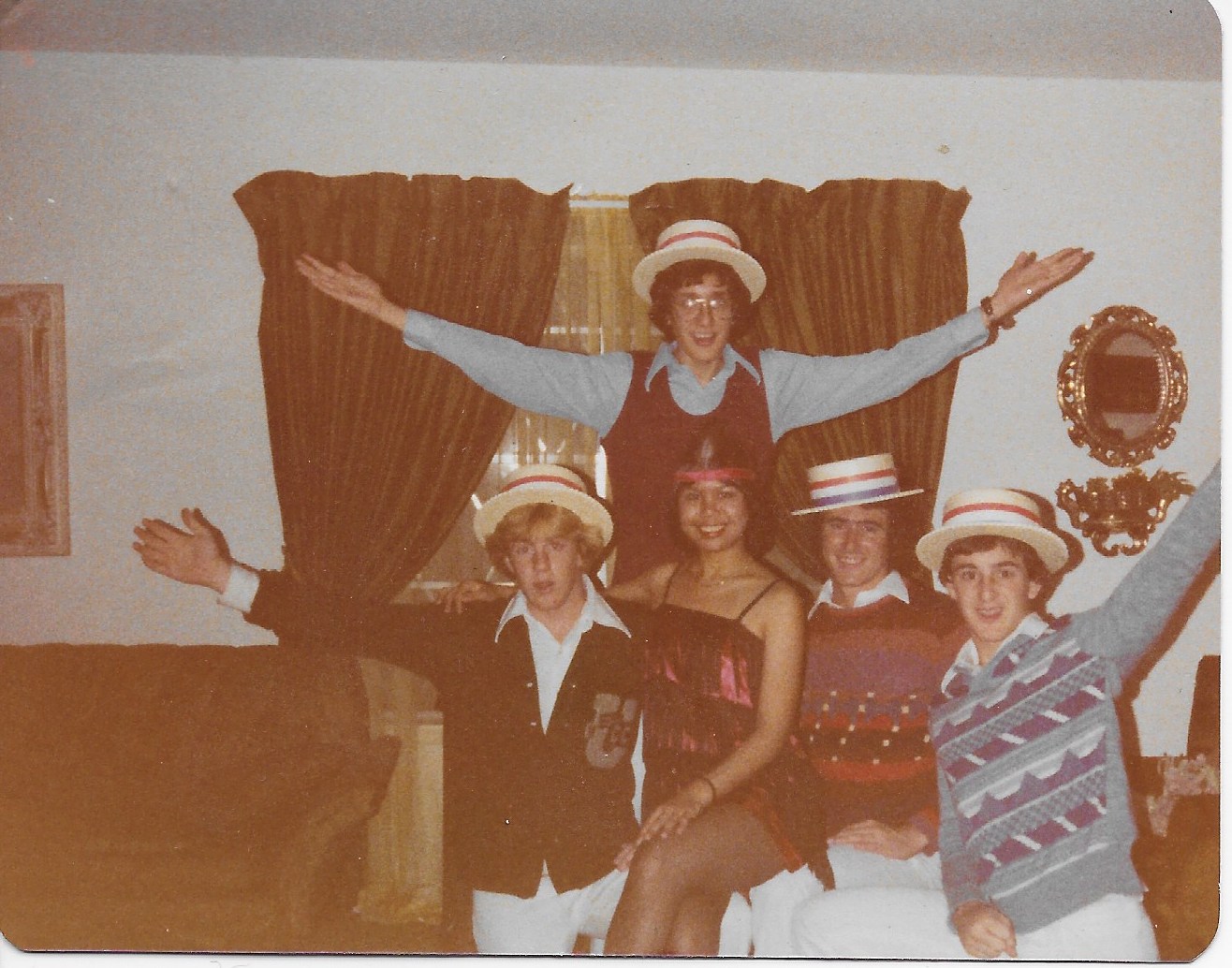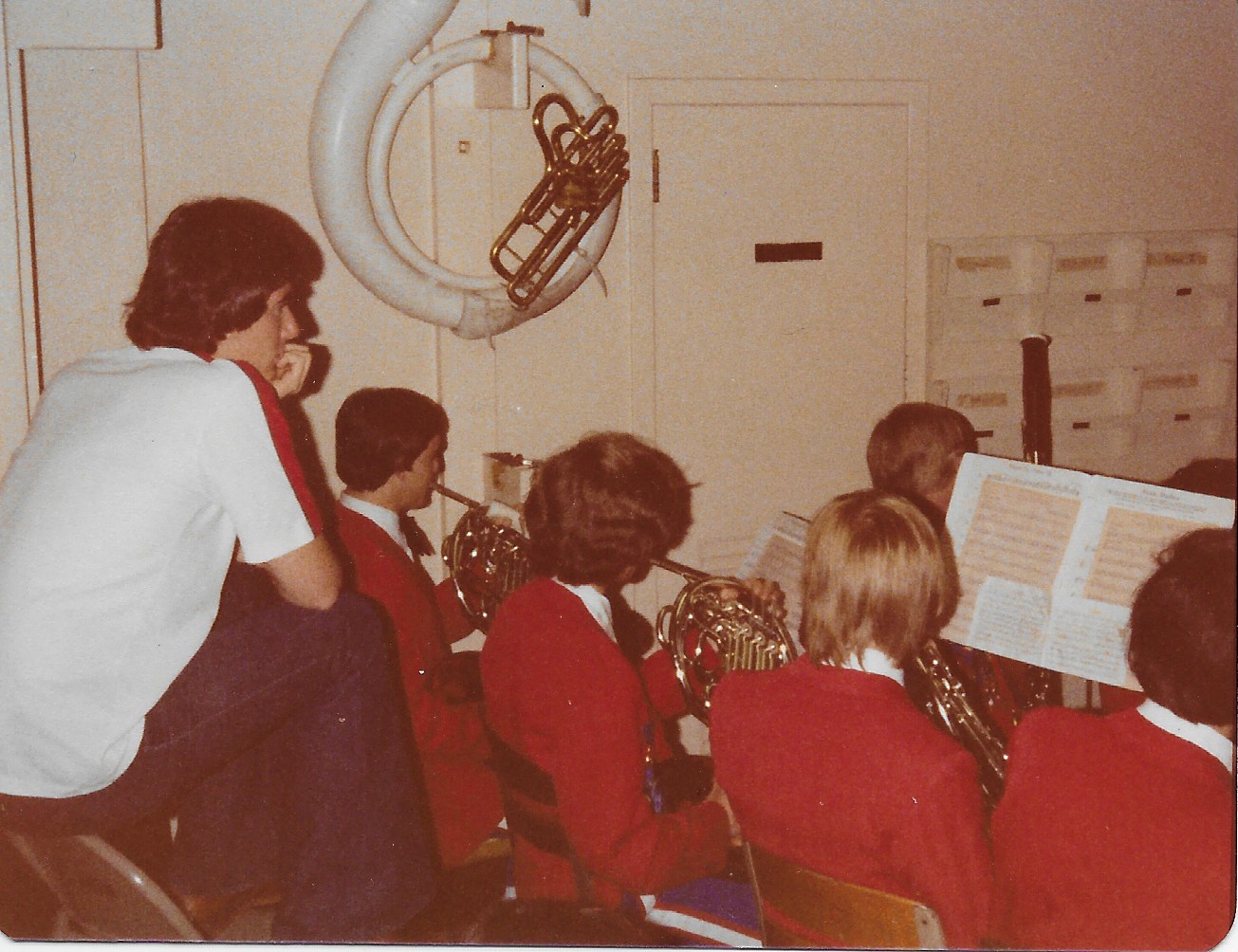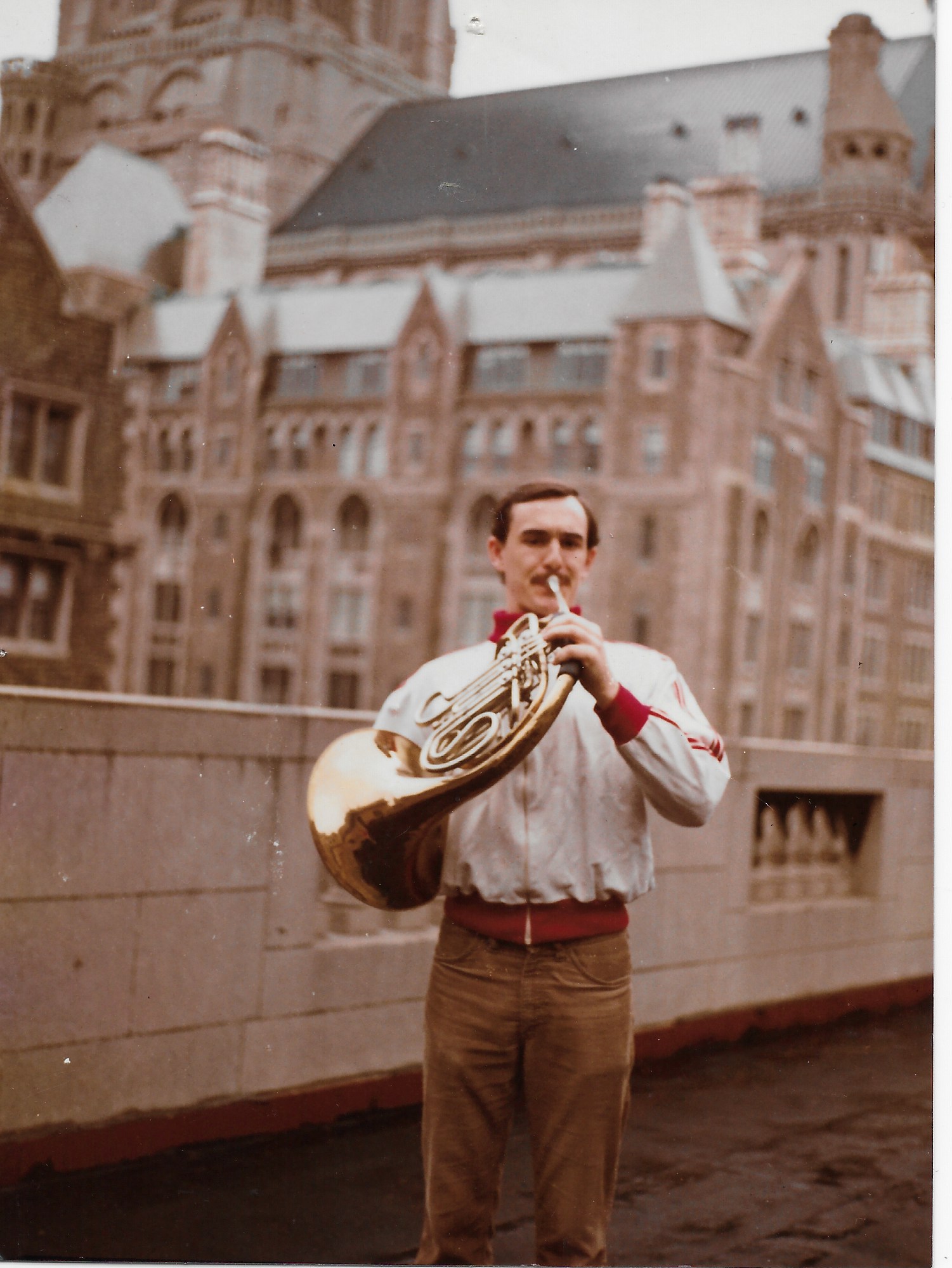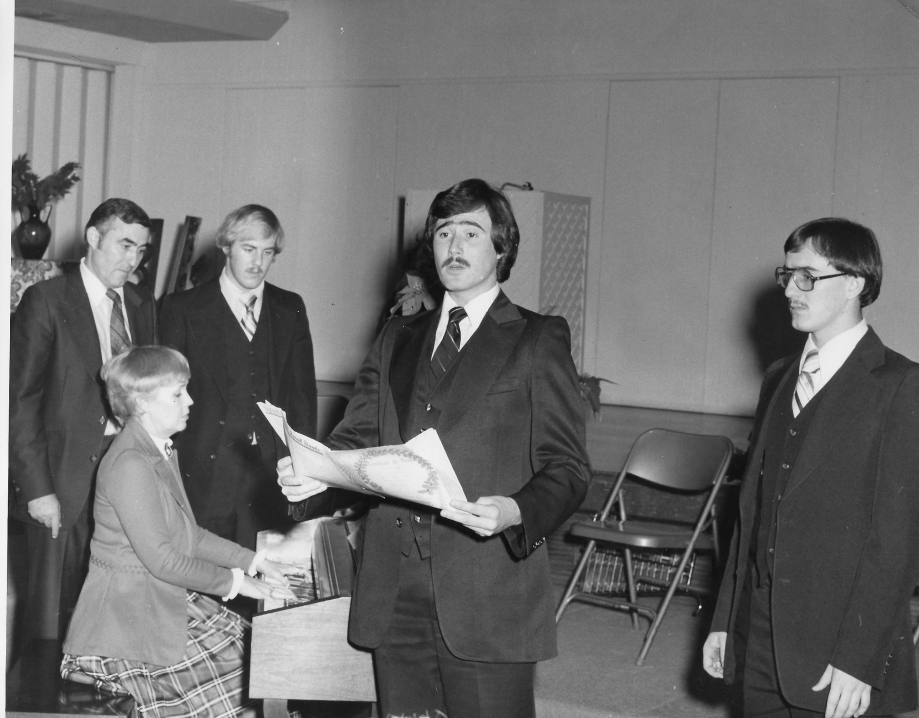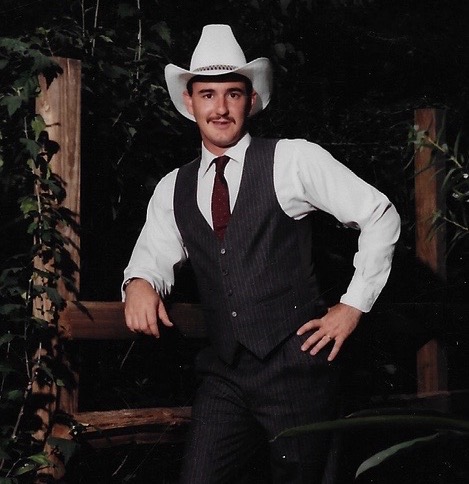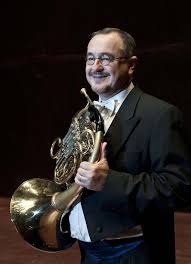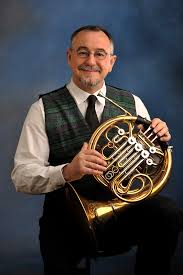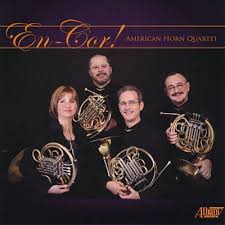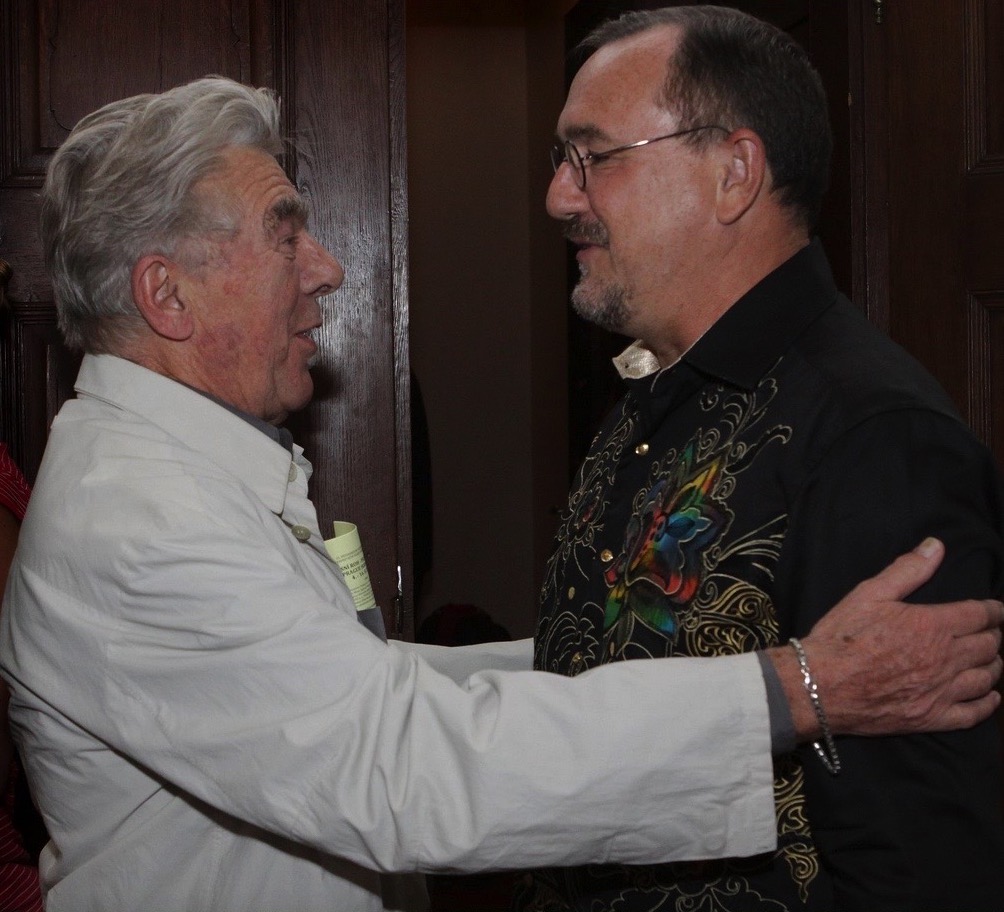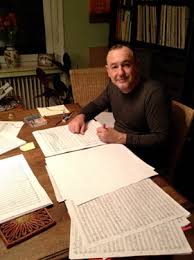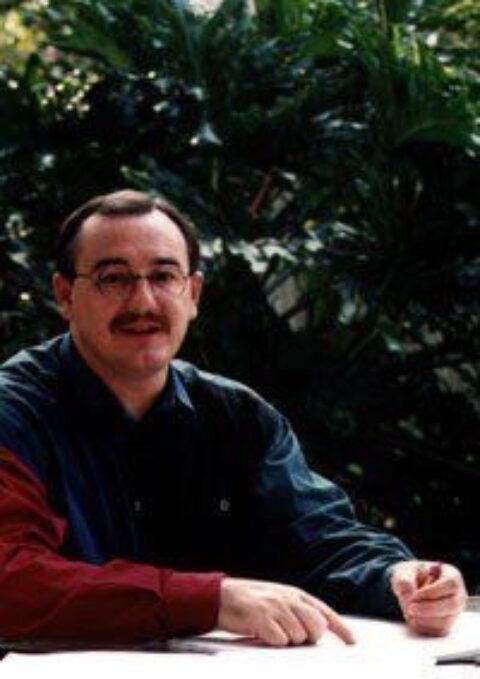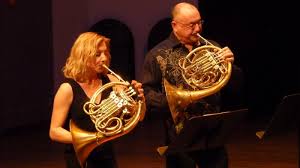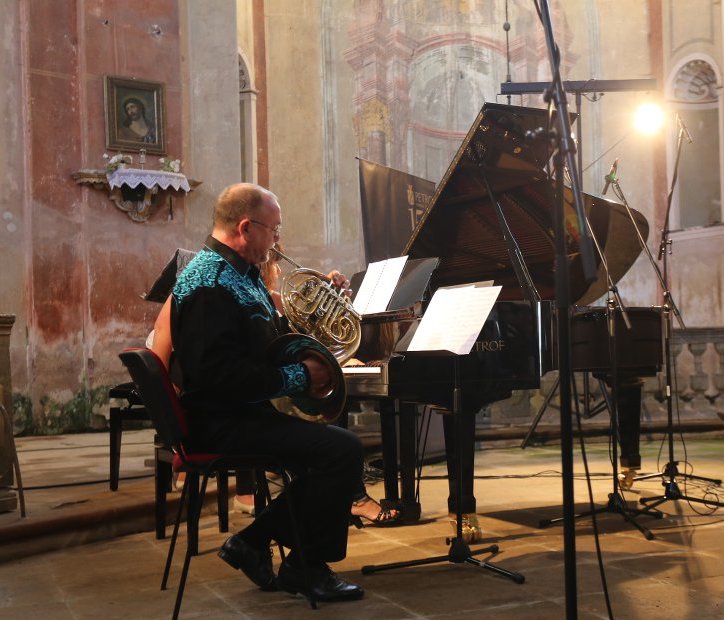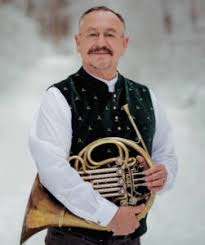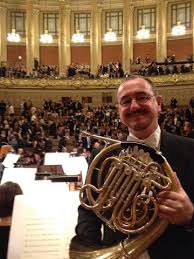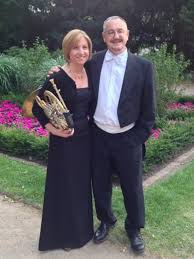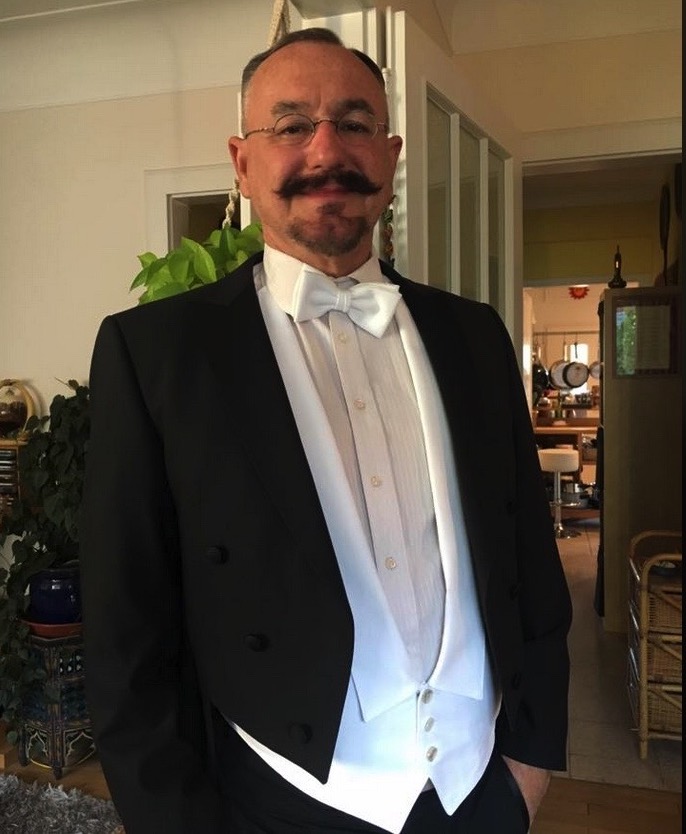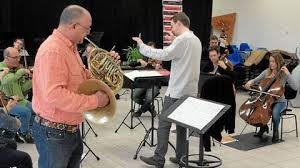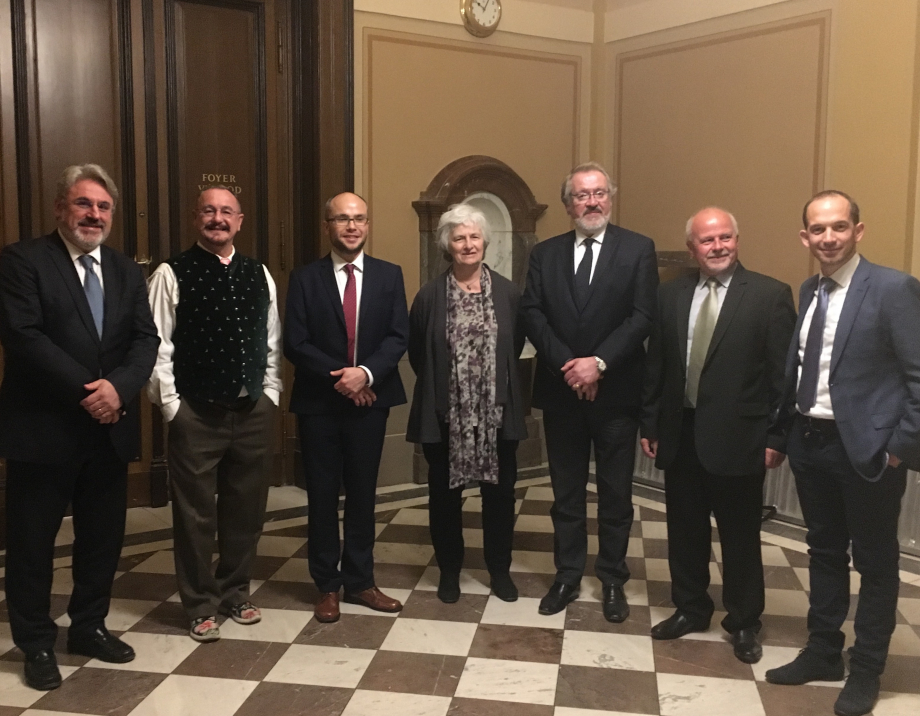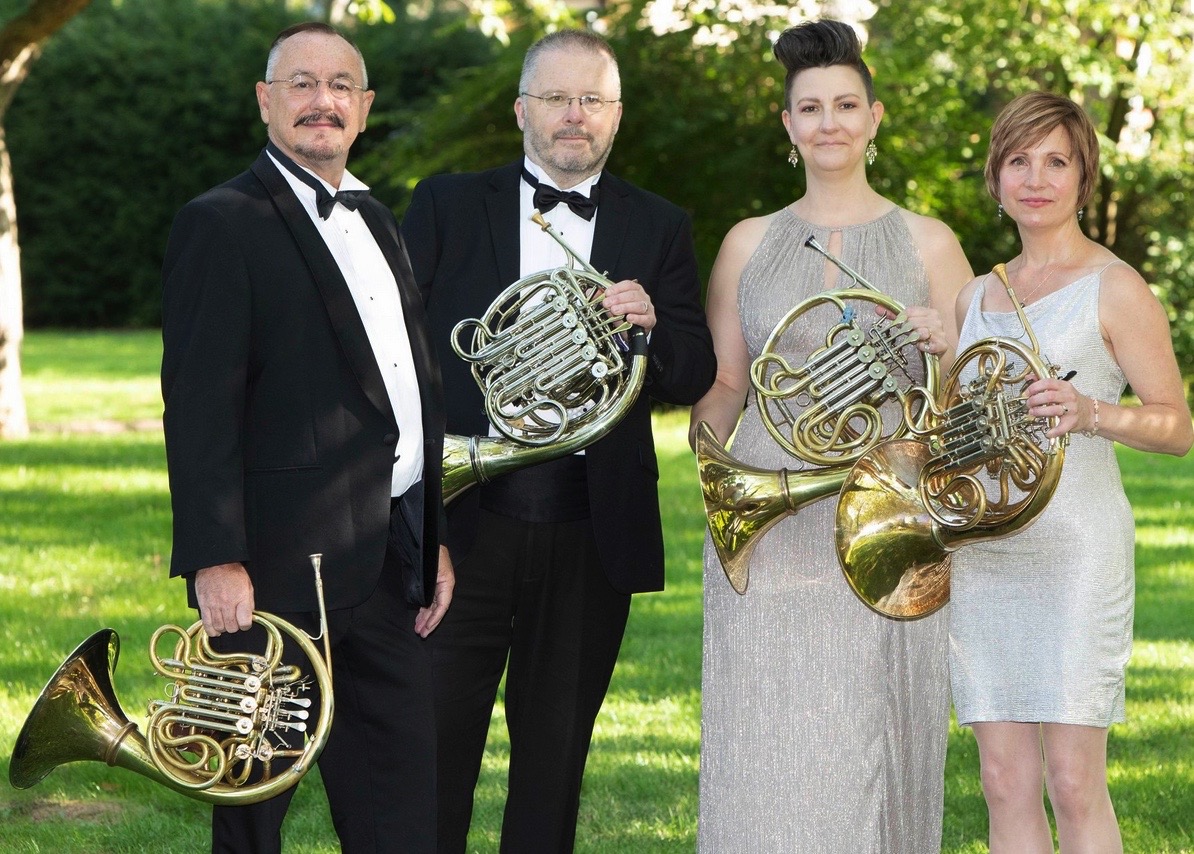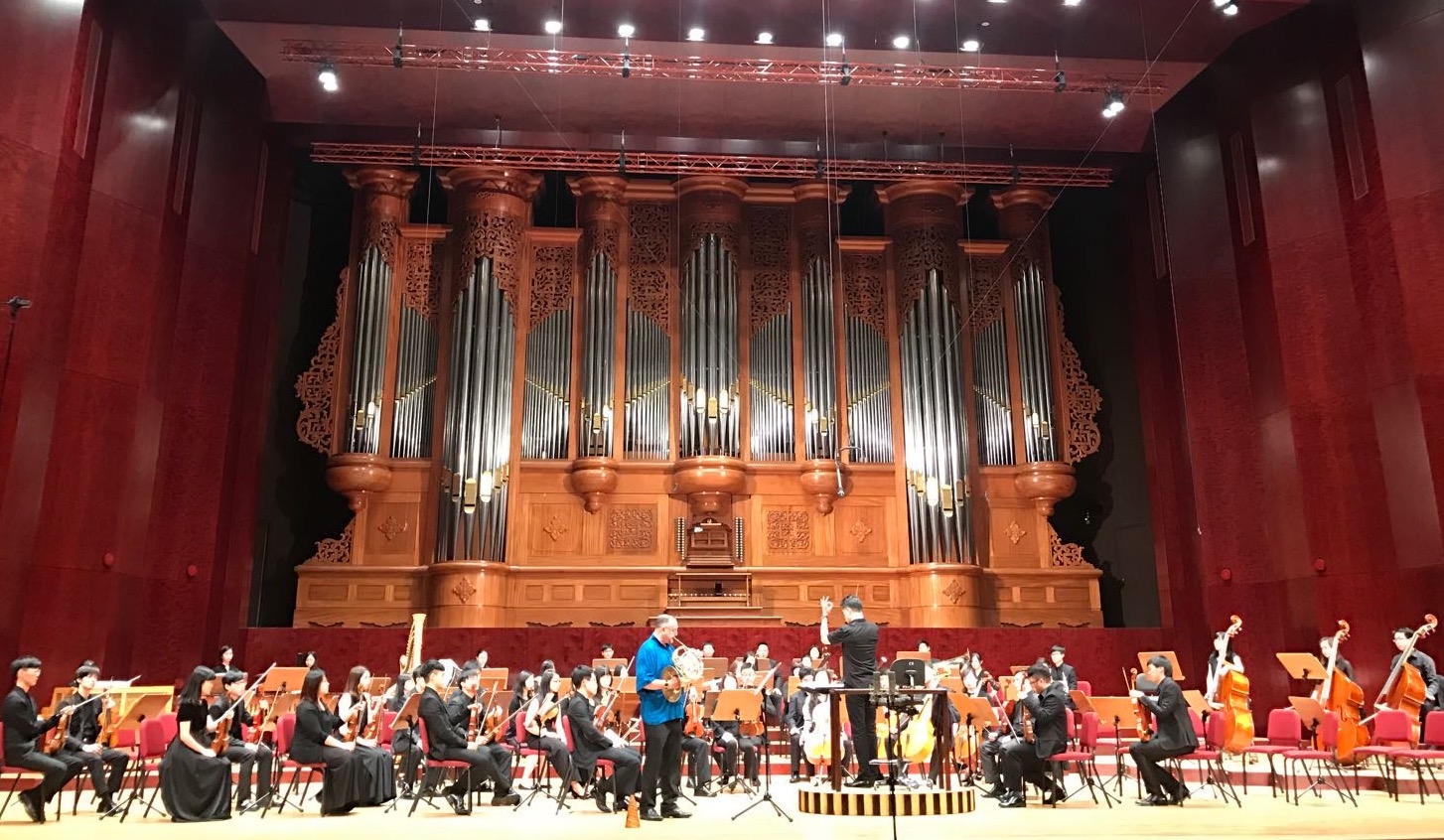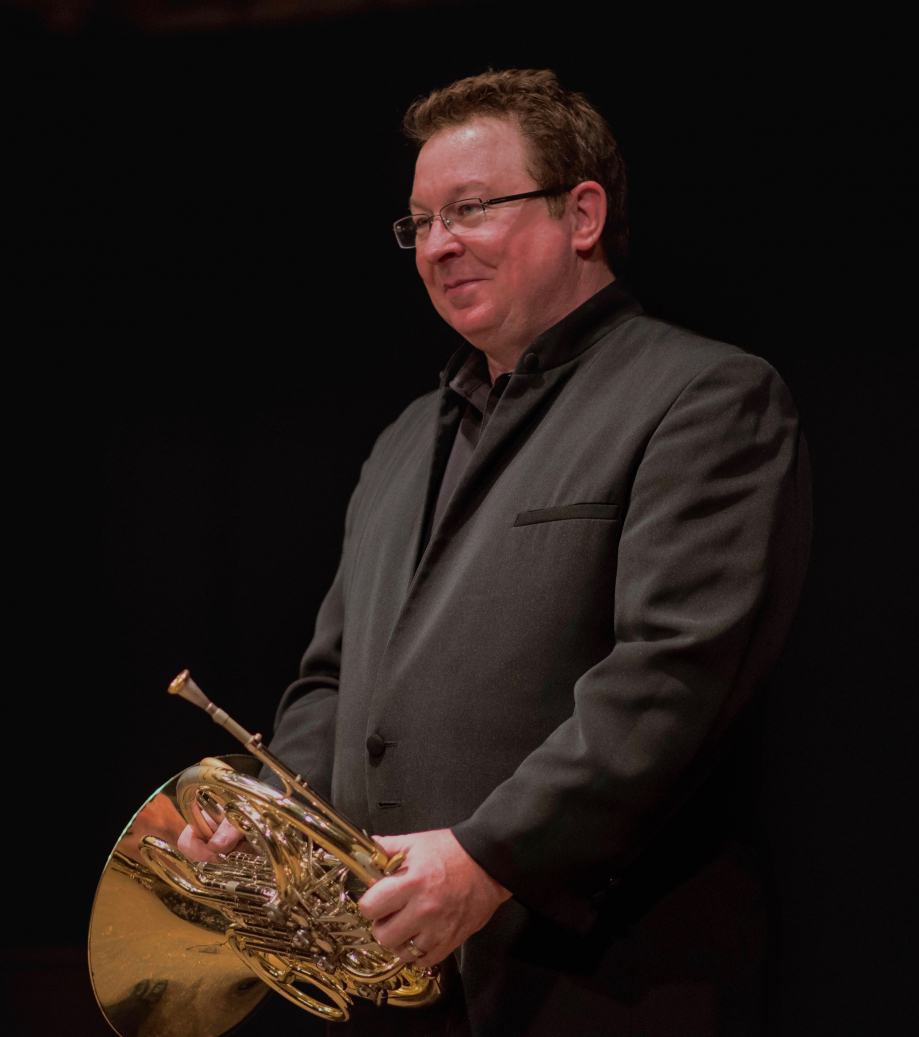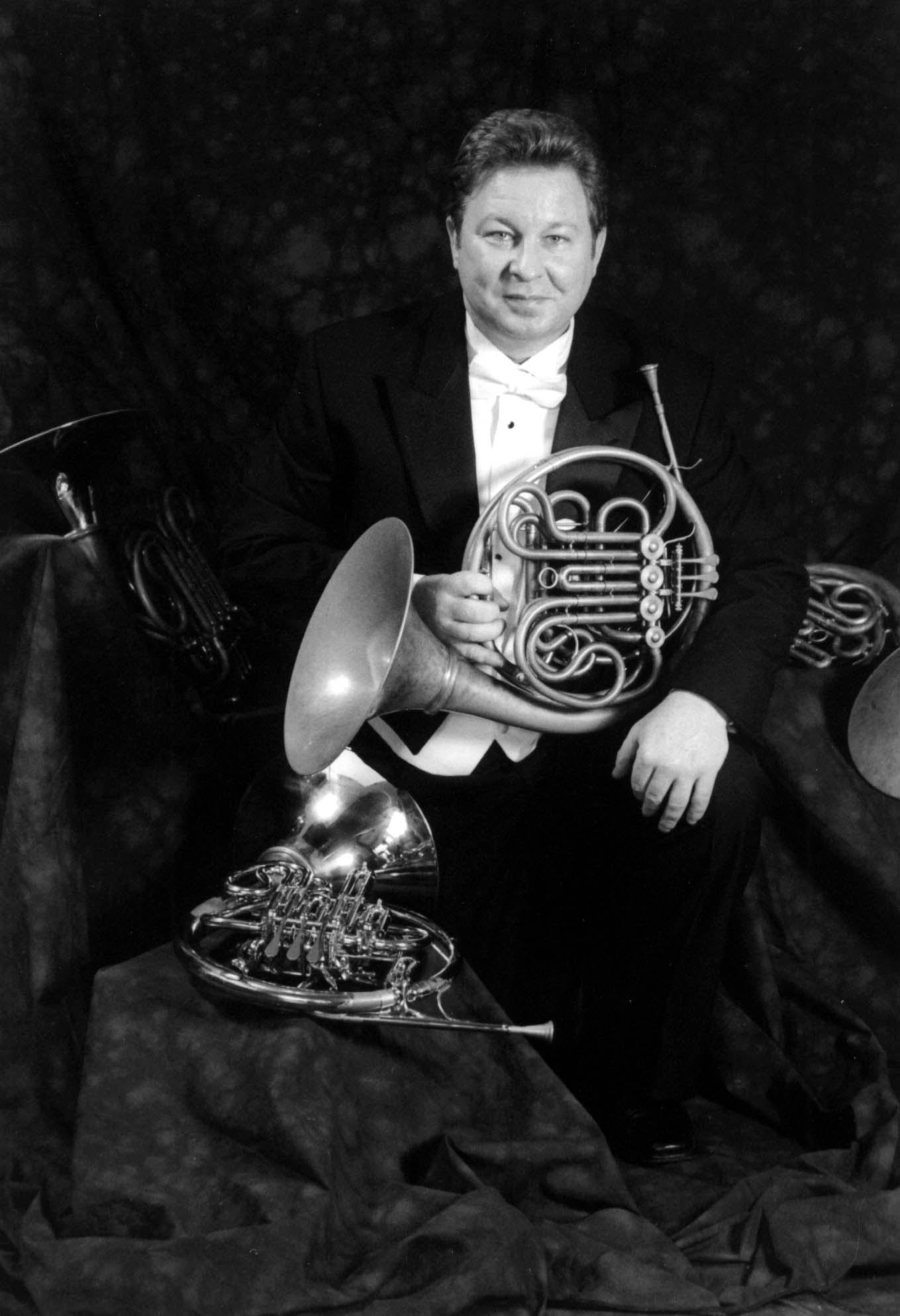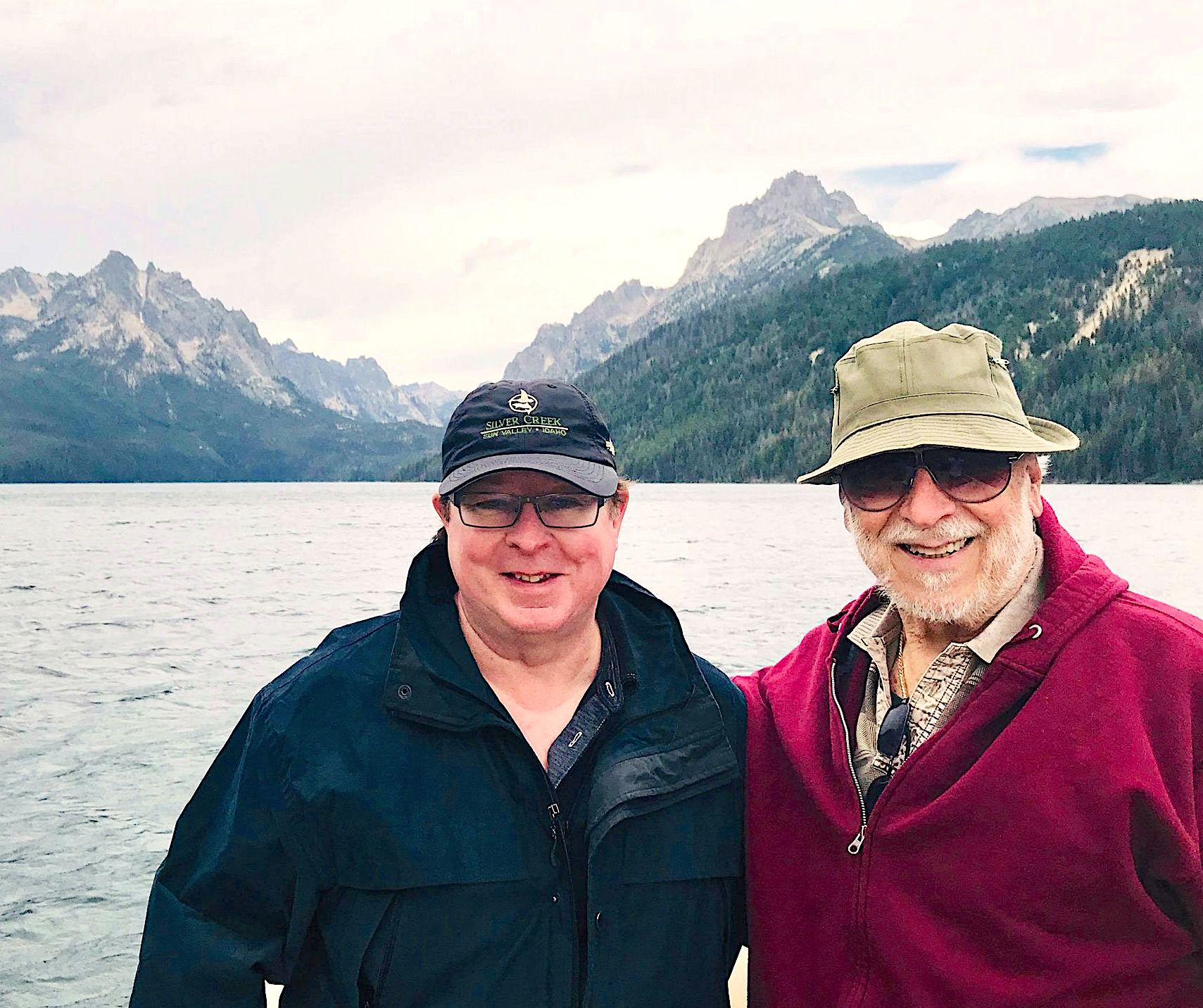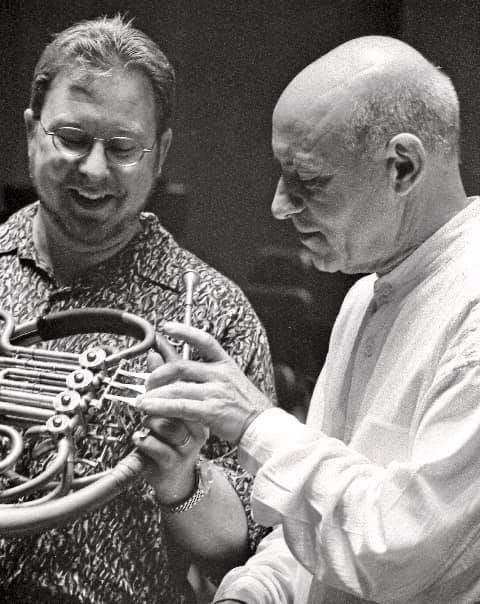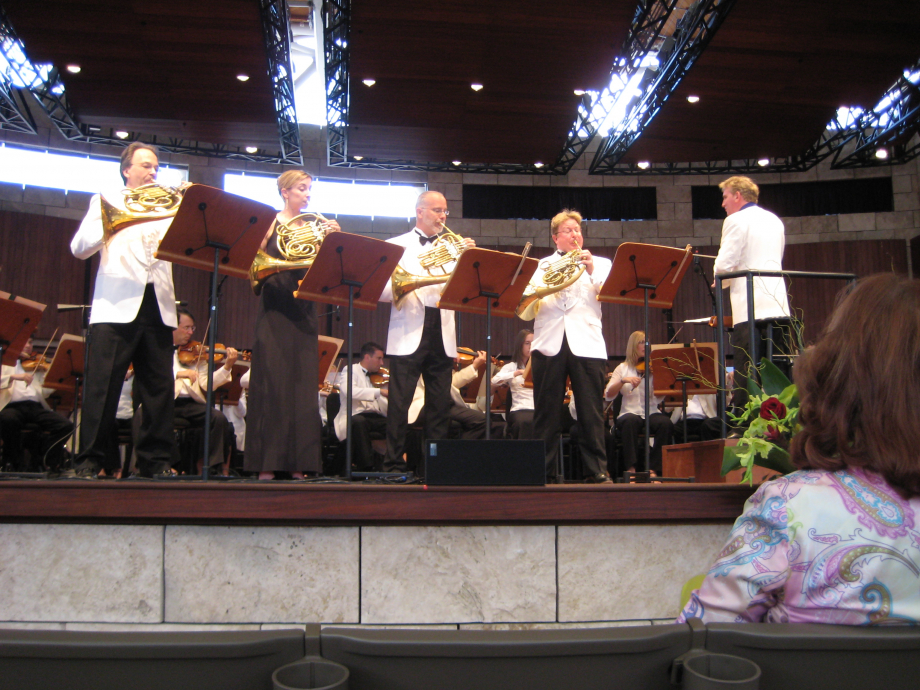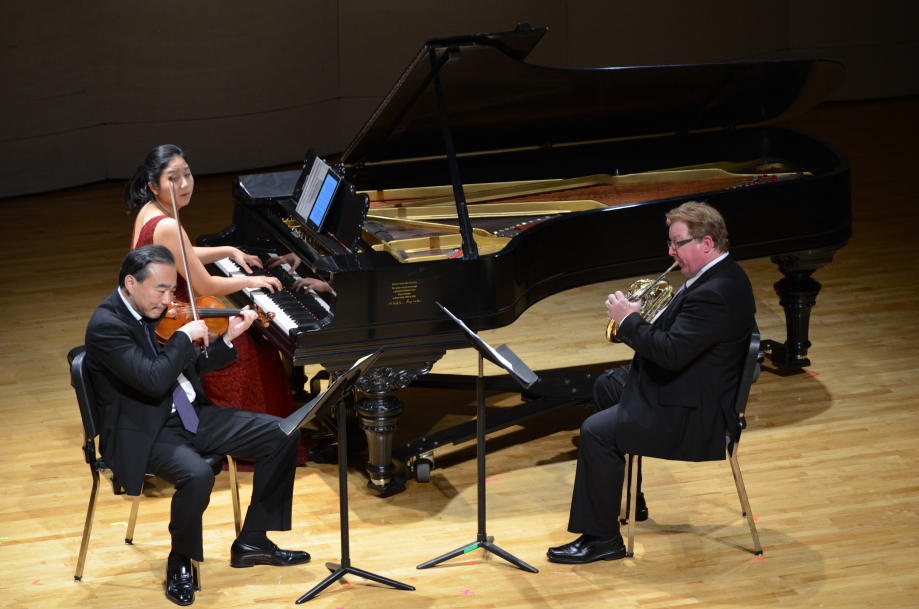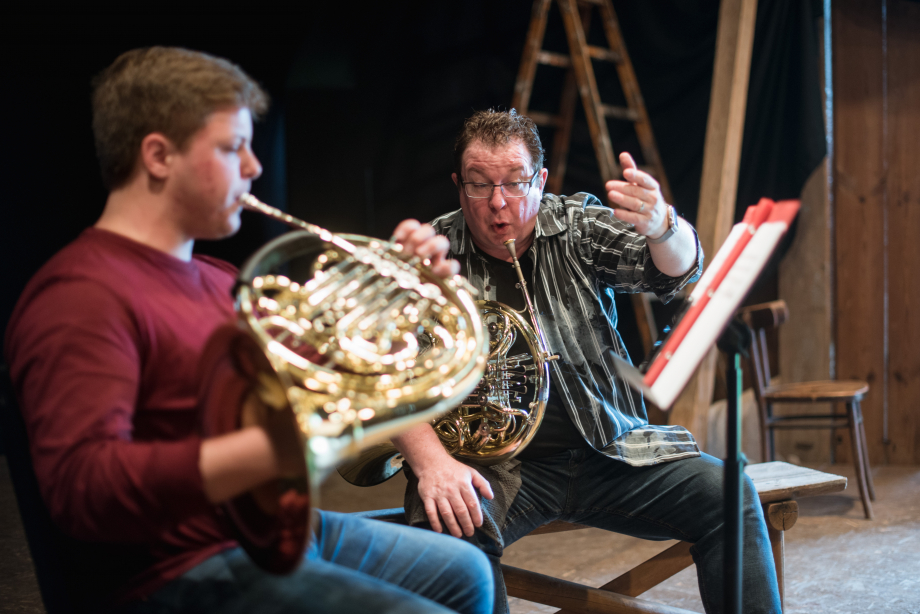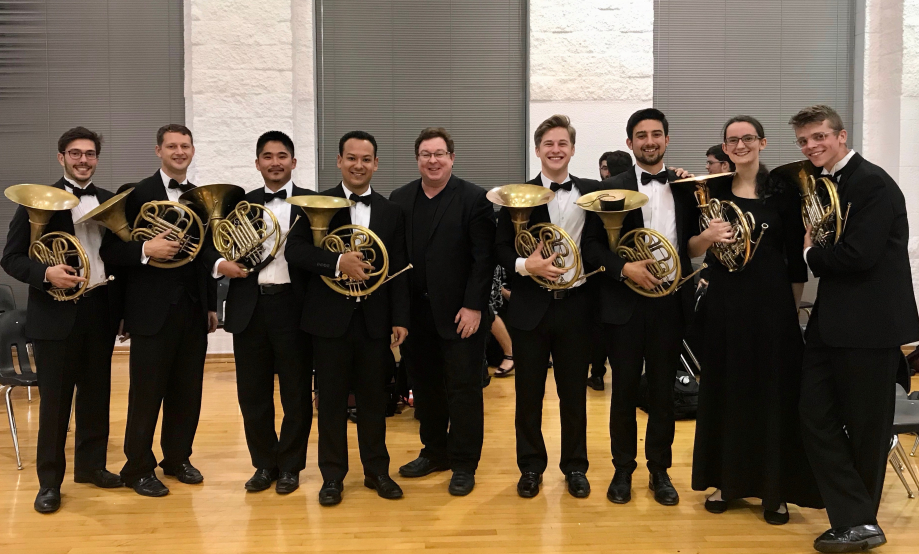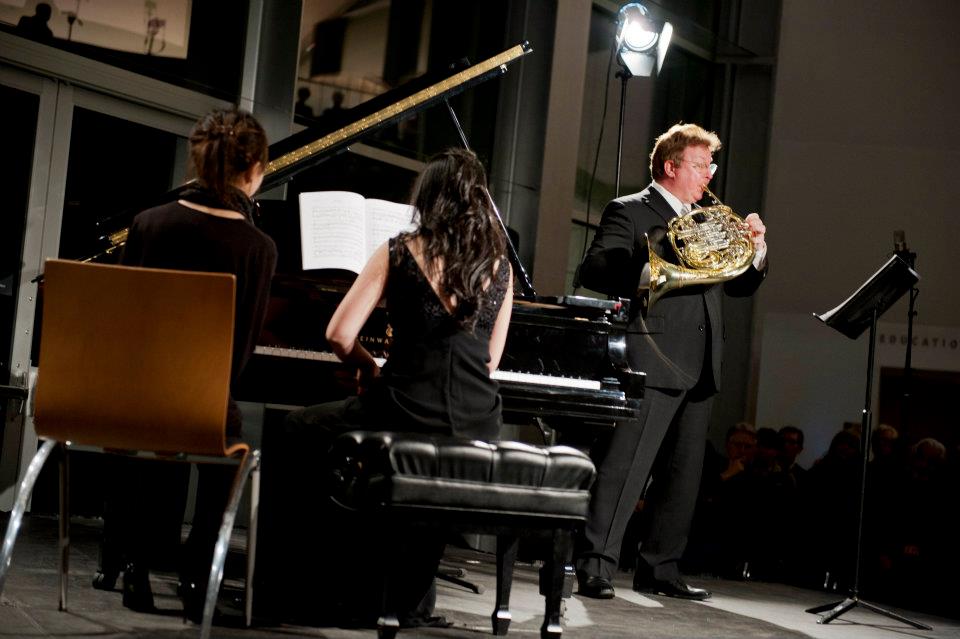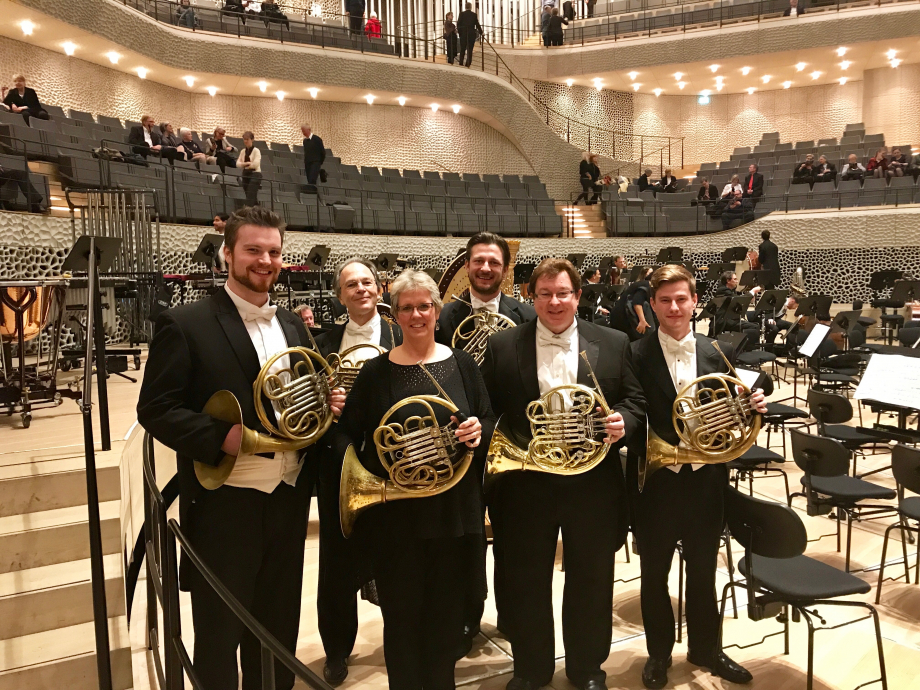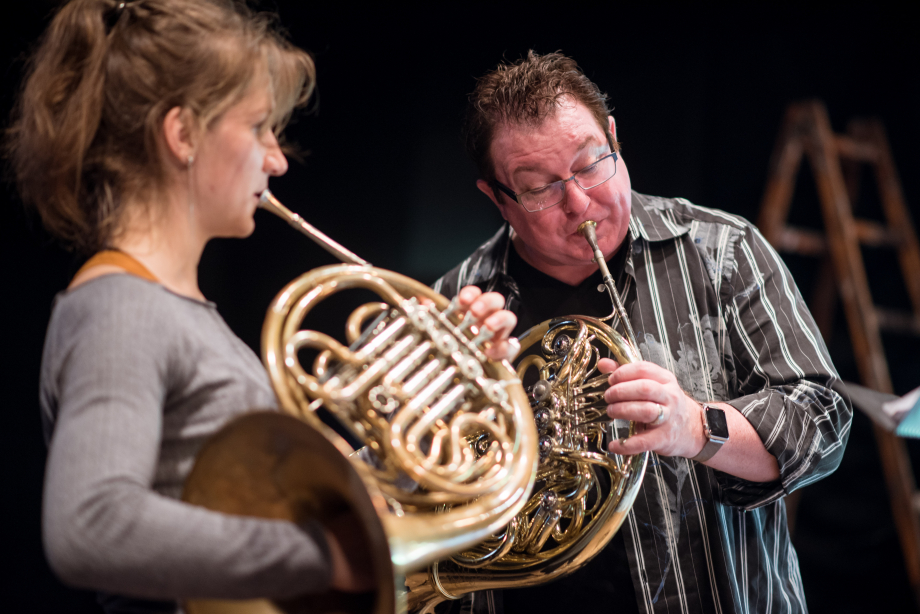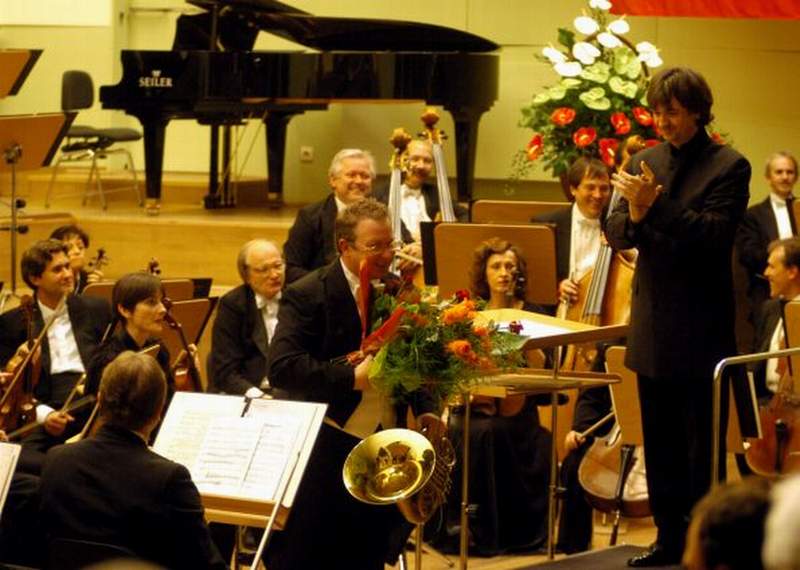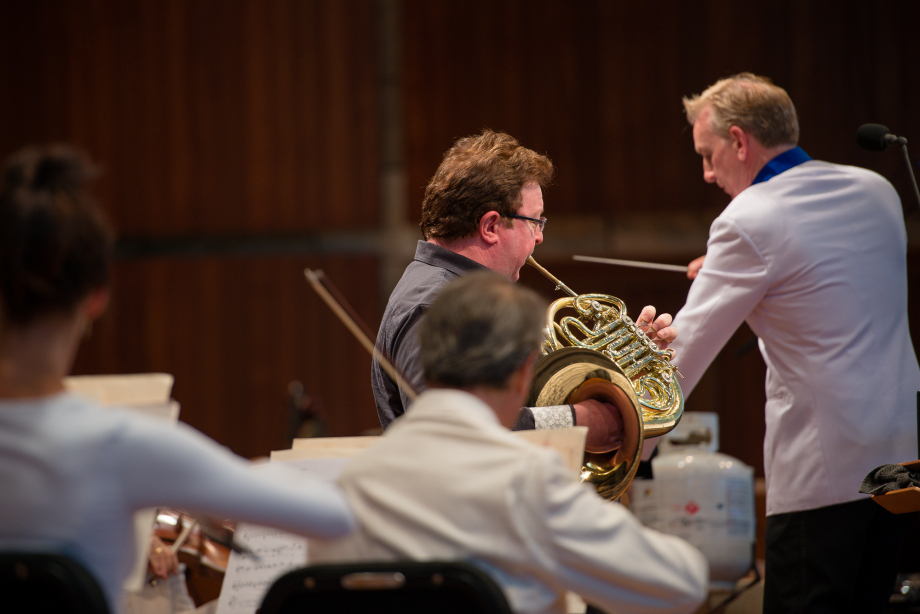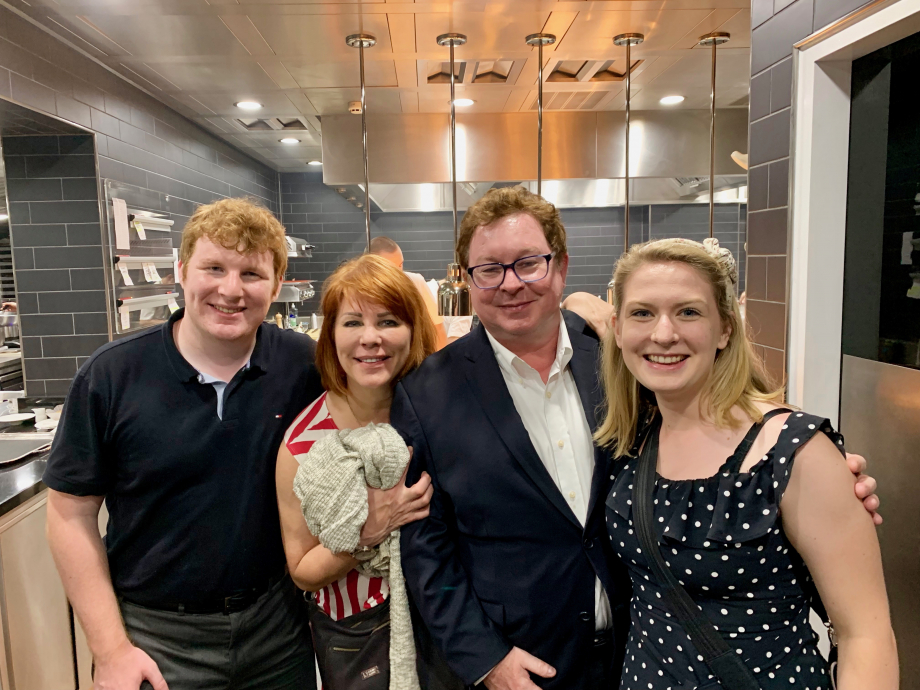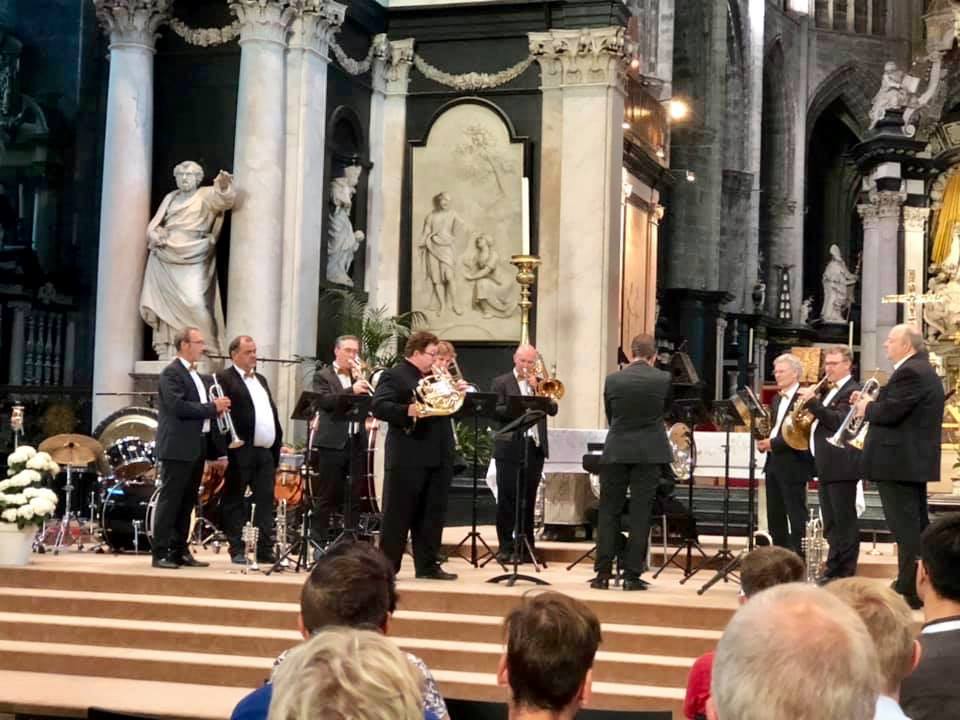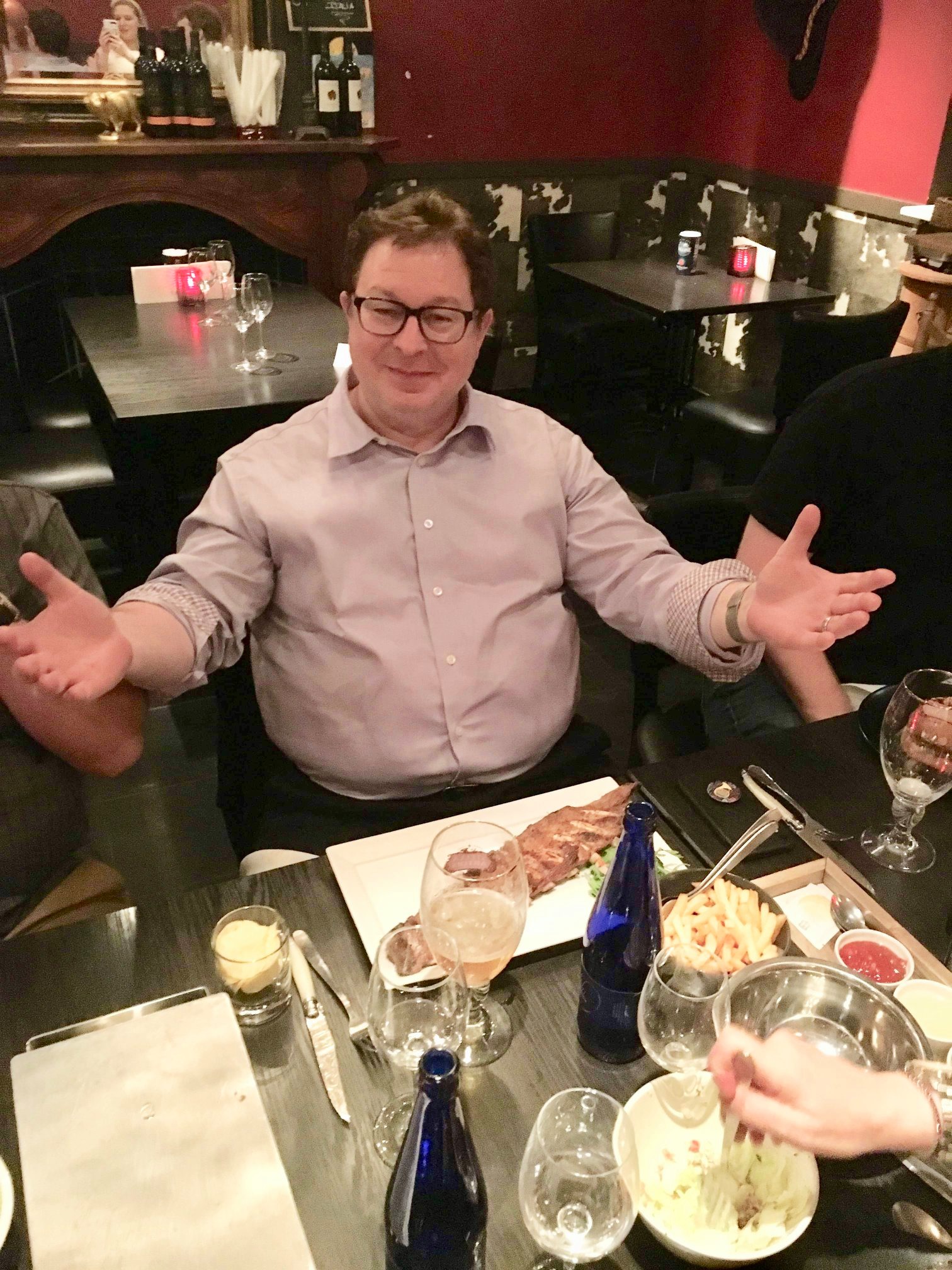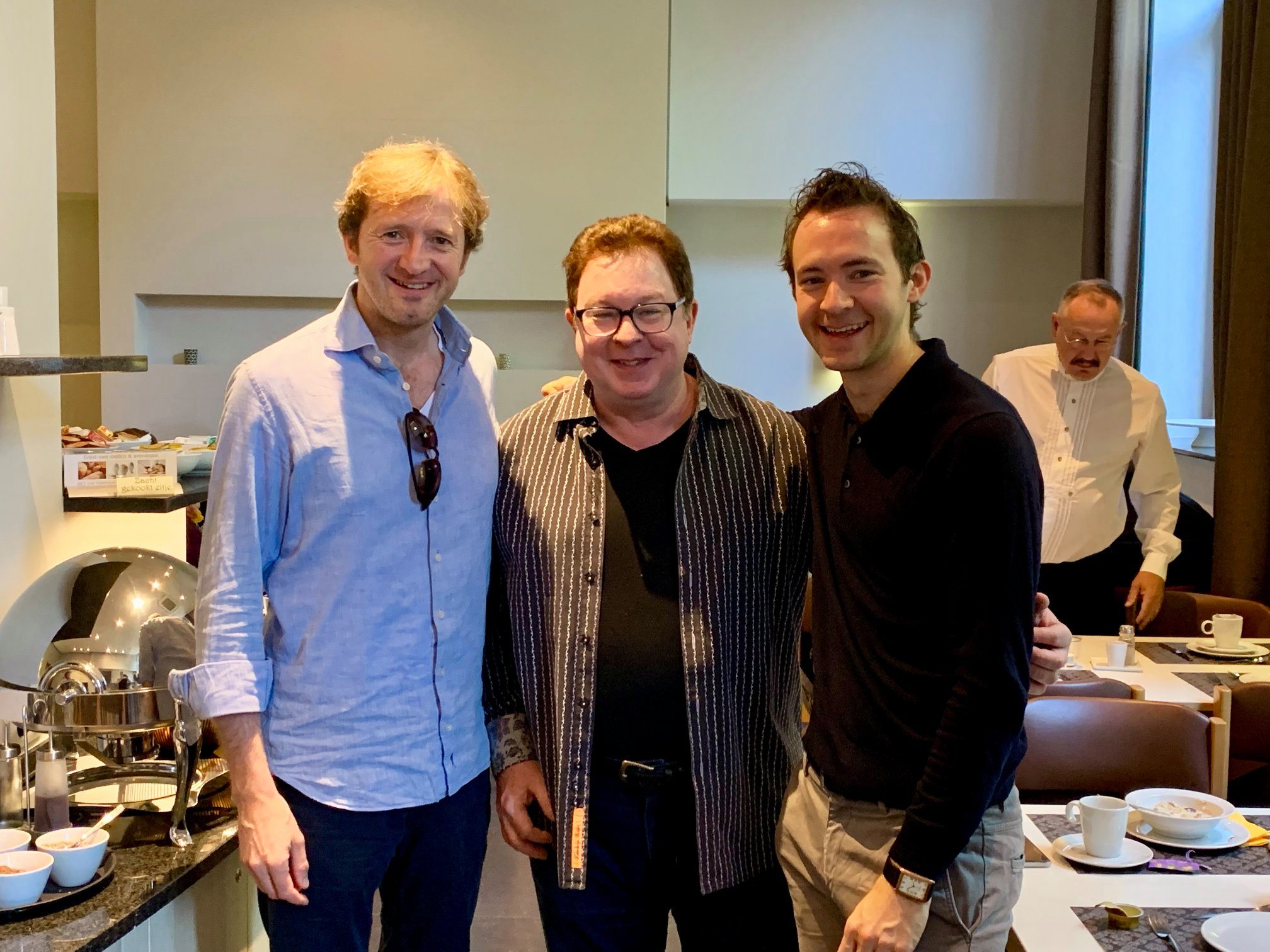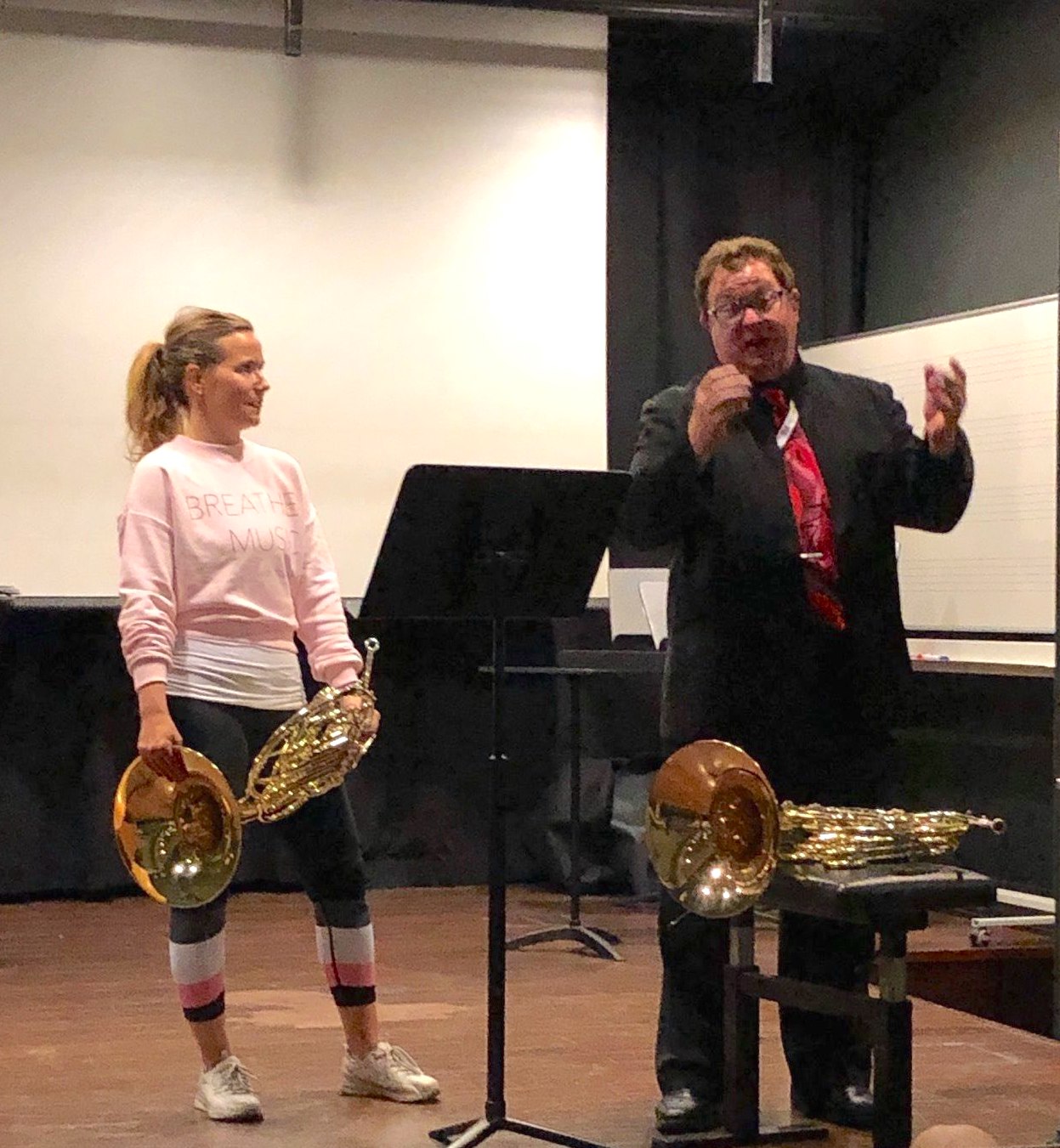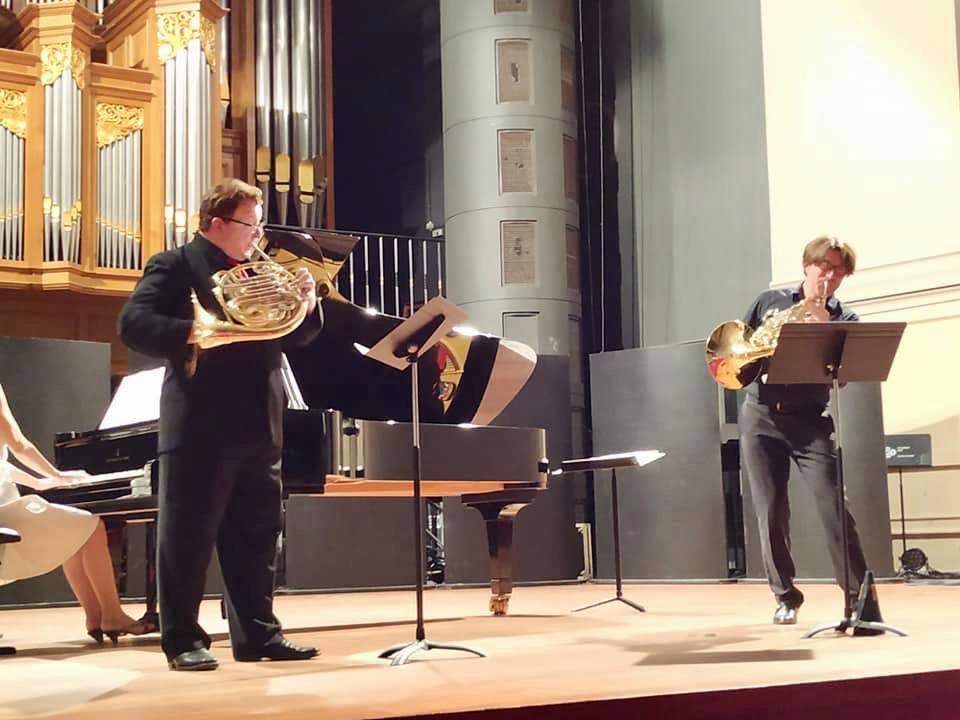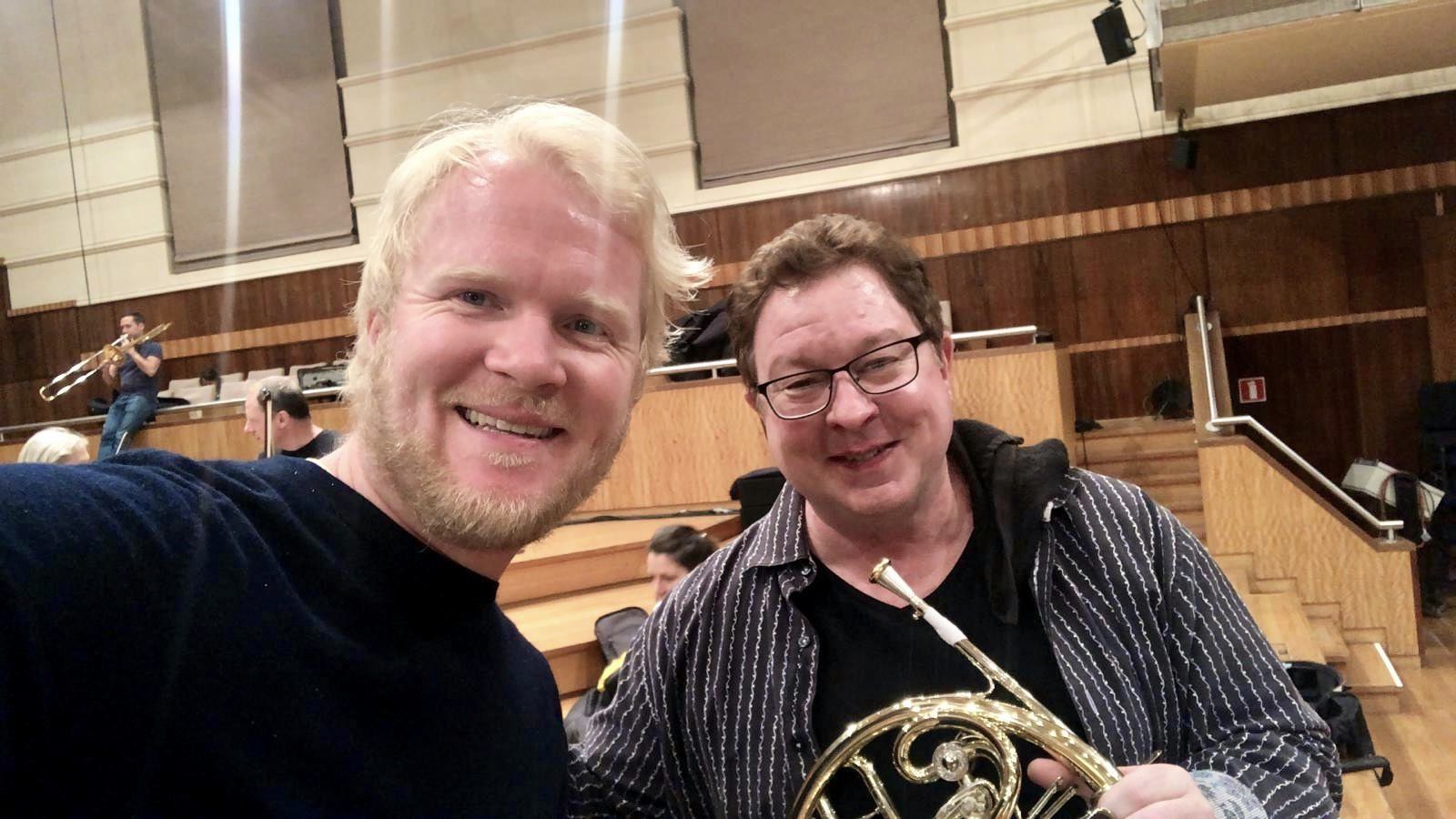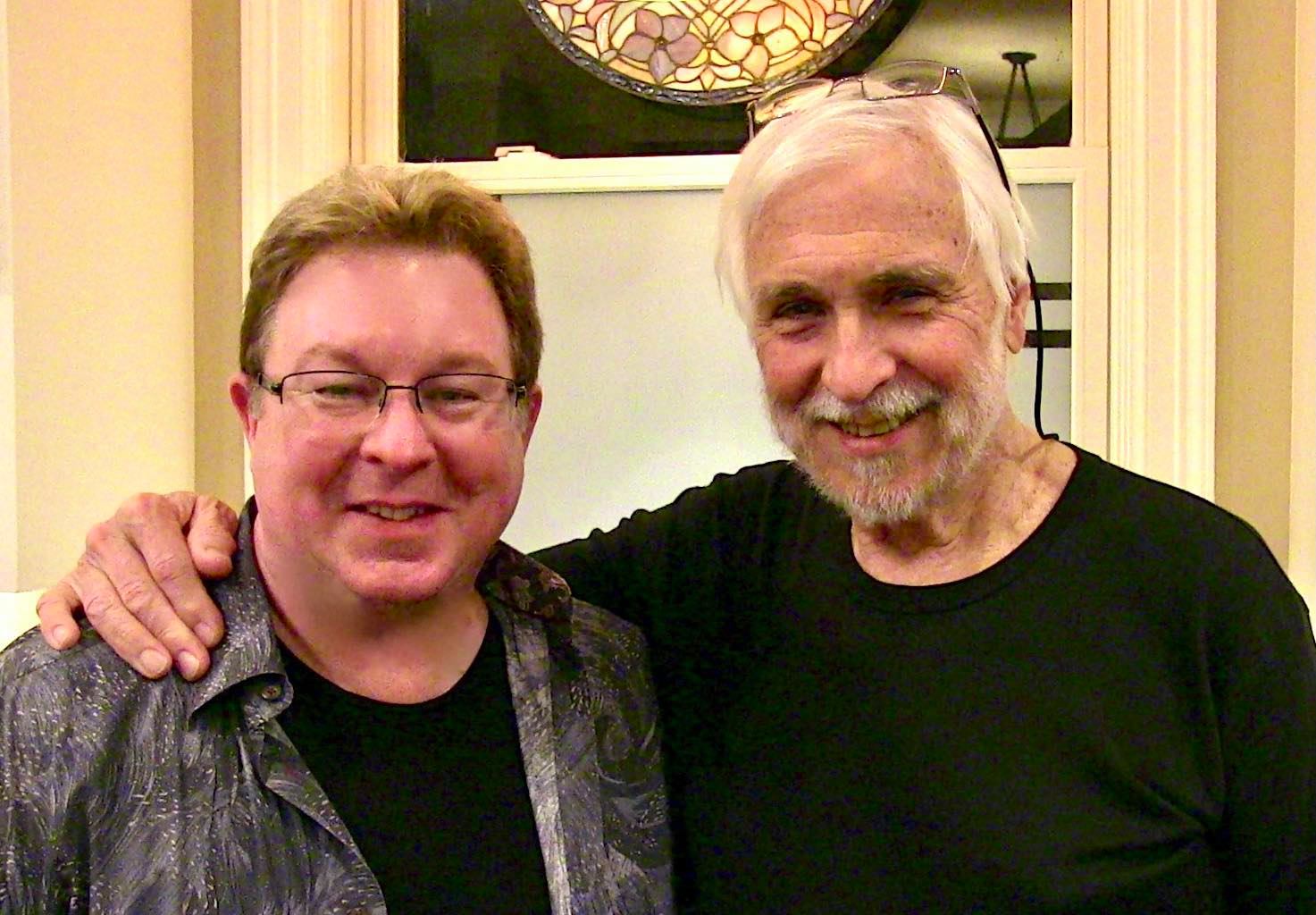HERMANN BAUMANN
HERMANN BAUMANN
IN ENGLISH, FRENCH AND PORTUGUESE SPEAKING
SEE DISCOGRAPHY BELOW
Maestro, you started the horn rather late, in what environment?
I come from Hamburg where I was born on August 1, in 1934. I grew up in the countryside, near the Elbe River, my two grandfathers were teachers, one taught me classical music. He played the organ for nearly 40 years and conducted choirs. And about my parents, my father was a doctor and my mother was a pianist. We loved to sing (still today!), my mother at the piano and around her we sang operas by Mozart and Lortzing. When I was 15, I started as a choir leader, and then when I was 16, I started my band as a drummer. When I was 17 I started playing the horn, nobody played it around me. I loved the sound so much that I put myself in the head to become a horn player. While student in Hamburg, I had my first engagement on the German TV. Live, I presented the horn and played Mozart "Komm lieber Mai, und mache die Baüme wieder grün" (Come dear Mai, and make the trees green again). During my studies I was solo horn of the chamber orchestra of Hamburg. We went by bus to Spain to make 20 concerts in 3 weeks. There was no water except from 20:00 till 22:00 hours. The wine cost was only 70 Pfennig per liter (almost nothing...) there was no shower... only wine!!
How from your studies at the Musikhochschule in Hamburg, did you become professional?
My teacher Fritz Huth from the Stadt Oper told me to try an orchestra audition at the age of 22 (after 5 years playing horn!) I went to Dortmund and I won the job.I wanted to know why I was taken, my future colleagues answered me: you are very young, well, let's see how long you stay in Dortmund... I stayed there 4 years, the morning rehearsal, the evening opera performance and the afternoon, personal practicing. I had only studied three semesters in Hamburg. I became solo horn in the middle of the 1956/57 season and the artistic director Rolf Agop quickly understood that I had to be engaged as soloist at least once. He put on R. Strauss’s 1st concerto. I played by heart as soloists do. I always played by heart, like my mother. After these 4 years, I went to the Stuttgart Radio and worked with wonderful conductors. The official music director was Hans Müller-Kray and as guest conductors came Karl Schuricht, Sergiu Celibidache, Karl Böhm, Benjamin Britten, Paul Hindemith, Helmut Rilling, Heinz Wallberg...
But did everything started after an International Competition?
In 1964 there was the ARD competition in Munich. I sent an application, my program was:
Beethoven Sonate
Mozart 3rd Cto
CM von Weber Concertino
R. Strauss 1st Cto
P. Hindemith Cto
Peter Racine Fricker Sonate
After 10 days of competition it was clear, I won the Munich ARD competition. Soprano Jessie Normann from the USA got a 2nd prize. The next contest she got first prize.
In an interview for the ARD, I said: I want to make the horn again a solo instrument.
Then I played on the TV Felix Mendelssohn’s Midsummer Night's Dream. My eldest son who was 7 years old and was still on the Föhr Island in the North Sea (where I intensively prepared the competition) was allowed to watch TV longer on the evening of the TV interview. His daddy was on TV! The next day he quickly went to see his friend whose father was a baker and said to him: my father is the best horn player in the world!! And his friend replied: my father is the best baker in Föhr!!
Deutsche Welle Köln did a show with me that was then broadcast all over the world. The start of a global career. Journalist’s quote: when German horn player Hermann Baumann played the first bars of WA Mozart’s Cto n.3 for Horn and Orchestra, the musical world made a sensational discovery. Baumann not only won the first prize of his discipline but was also the real winner of the competition, because apart from him, no one else could have won a first prize. Conductor Dean Dixon, who was at the head of the Bayerische Rundfunk Orchester tonight, was also surprised by such a high quality sound, virtuosity and expression. Like the public who did not think that a horn player would be able to make this instrument sound so flawlessly, or even make it sing.
When I started playing the horn at 17, I immediately did it in a solo way, I played a lot of Franz Schubert lieds with my mother on the piano. I immediately played as a singer and this is my particular technique (which comes from the center of the body), the diaphragm as the basis of my playing. A lied by F. Schubert that I remember: "Am Brunnen vor dem Tore, da steht ein Lindenbaum" (At the fountain in front of the door there is a lime tree). Quote from a Deutsche Welle journalist: Baumann came to Munich not only as a mature artist but also with a very clear concept, a great deal of confidence in him.
After the first prize I had many solicitations, concerts in Innsbrück, the NDR in Hamburg, my orchestra in Stuttgart, in Baden Baden Radio, in Basel, in Paris at Radio France, in Lisbon in Portugal...
In the impossibility of holding an orchestra position in view of your engagements as a concertist, you have therefore thought of teaching, is that right?
The Folkwang Musik Hochschule in Essen wanted me as a teacher. There was an engagement in Rome as a soloist but I couldn’t go because I had Mahler’s sixth with Claudio Abbado and I didn’t get the week off. Abbado asked me why I was not in Berlin. "No way, I just resigned from Stuttgart to teach in Essen!"
Little anecdote: came La Callas, she had to sing for 17 min. On stage finally when the time came, there was an incredible tension, we played the ouverture we played again an ouverture... when she arrived there were very strong applause although she had not yet sung a single sound...
I never forgot that!
I started teaching in 1967, for 12 years. One day, I received a call from the WDR asking me to replace for a season in Köln, as the solo horn Erich Penzel was on sick leave. So I played at the Cologne Radio and taught in Essen. In one of the next concerts of this orchestra, a solo horn player was necessary...
Letting the critics speak after the concert, the title was: Baumanns Wunderhorn. It certainly does not happen often that a solo horn player flies to glory and puts in the dark a conductor like Sir John Barbiroli, but this was the case in the 6th concert of the Köln Radio. In this program, Hermann Baumann played the solo part of Benjamin Britten’s Serenade and it was beautiful. You have to be careful with superlatives but here they are in the right place. Perfection and virtuosity put everything away from what we knew until now.
What amazed everyone in your career, is the number of your recordings!
Twice a year I flew to West Berlin for recordings for RIAS and SFB and then followed up with recordings to Bremen, Hannover for WDR and HR. Then the Saarländischer Rundfunk, Kaiserslautern, Bayerische Rundfunk. I played at the Concertgebouw in Amsterdam under the direction of Jaap Schröder, at the Chamber Orchestra of Karl Münchinger, in Vienna at the Consentus Musicus by Nicolaus Harnoncourt, followed by recordings.
Prior to your serious accident in 1993, did you experience periods of difficulty?
In Munich I was very well known but I had not yet played with Karl Richter. Maurice André, whom I had known for years, told Richter: you must hire Baumann from Stuttgart.
A tour in Italy and Switzerland in 1966 travelling by train was an experience for all of us. In Modena, we had a stage rehearsal before the concert and Richter says: the Aria of the Quoniam we have to play it complete tonight. I got up and played my part until the end and then I asked: do I have to change something?
Karl Richter laughed with the whole orchestra and the whole choir. And he said: that’s how I always imagined this air!
During this trip Karl Richter asked me: do you want to play with me at the Goldenersaal in Vienna?
... of course! (he wanted R. Strauss' 2nd Cto)
Wunderbar!
Karl Richter says: it will be with the Wiener Symphoniker in the cycle "the great symphonies".
It was a long winter, in early April, I went to the mountains to ski and sledge. We fell skiing, me and my daughter Johanna. She had nothing but I did. With pain we went to the nearest hospital. I broke a metacarpal bone in my hand, they had to cast. 18 days before the concert in Vienna! But I didn’t cancel. Alexander put a hook on the instrument so I could hold it better, lifting the weight thanks to a strap around my body. Day and night I was trying to free my fingers from plaster so that I could practice a little on my second R. Strauss Cto. I drove to Austria with my wife, still wearing a splint. We were in the Imperial Hotel, overlooking the Goldenersaal. Richter looked at me a little skeptical when he found out what had happened, the orchestra the same. The audience looked at me funny when coming on stage. This 2nd of Strauss being particularly difficult, at the end, the Viennese exalted with joy, delighted with such an interpretation in this mythical hall of Vienna.
Then the world opened up to me, my calendar was filling up more and more. My dear wife was not only a housewife with 4 children as often heard on TV, but was all day at the office and on the phone. Her Latin and German studies helped a little but then English and French took over.
The natural horn, concerning you is also a beautiful love story...
My students liked to meet to play together (orchestral excerpts) Bach, Beethoven, up to contemporary music. The music of the 18th and 19th centuries was played on natural horns. I started with playing it in 1967 and made available my own horns to my students. Subsequently the Musik Hochschule of Essen bought natural horns. The Folkwang Horn Ensemble did a lot of little concerts. The great mass of St Hubert made me particularly want to transcribe it. This piece is intended to be hunting and festive music. Movements offers caracters like festive, dignified, to cheerful, popular gathering… I did many concerts with this ensemble, the Mecca of the horn players. At the end of a concert with the great mass of St Hubert, 9 natural horns and 8 pistons horns shared the applause.
Every year I went to Vienna as a soloist, it lasted about twenty times. With Nicolaus Harnoncourt and the Consentus Musicus, we recorded the 4 concertos of WA Mozart, on the natural horn. In Oslo I was offered a Lure. In Copenhagen, Danish Queen Mutter Ingrid showed me a 300-year-old horns found in marshes. In 2005 in St Petersburg, I saw for the first time Russian horns of the 17th and 18th centuries. What is great is that you can only play one sound! Spontaneously I invited the Russian Horn Capella ensemble for concerts in Germany. In October 2006 I was the soloist and conductor and I also presented. In Italy, I often conducted and played the natural horn, for example in Florence, with a symphony by J. Haydn and then I played J.F. Handel, G.P. Telemann, J. Haydn or W.A. Mozart. We ended up with a beautiful symphony by W.A. Mozart.
After the horn concertos, the audience always wanted as encore my G. Rossini on natural horn and Mozart’s Horn signal on my Kelp.
I always enjoyed going to Milan with the Carme Ensemble, a superb little Chamber Orchestra. A tour took us to the south of France and then to Paris. After J. Haydn - W.A. Mozart, the highlight of the concert was the Trompe de France (French hunting trompes). From Paris we went straight to the USA. At Ann Arbour, there was the Gewandhaus Orchestra with Kurt Masur, Anne Sophie Mütter and me. Christoph von Dohnanyi brought me to Cleveland and then to Carnegie Hall in New York with the 3rd Cto by W.A. Mozart. This was my 33rd tour in the USA.
The expression "Go around the world" fits you perfectly!
They wanted to hear my Strauss 2nd everywhere: Warsaw, Krakow, Katovice, Oslo, Bergen, Trondheim, Helsinki, Tempere, Gothenburg, Stokkholm, Malmö, Reykjavik, Amsterdam, Rotterdam, The Hague, Belgrad, Paris, Strasbourg, Lyon...
In almost all these cities, I gave masterclasses.
My dear Concertino by C.M. von Weber was filmed at Herrenchiemsee Castle by German TV for a show. Then there was the Sunday concert (Wie schön ist doch Musik!) very popular show, I played the 1st Cto of R. Strauss. Then there was in Munich the 3rd and 4th Cto of W.A. Mozart for the TV, then in Vienna 2 shows "horn and piano".
The Württembergische Kammerorchester accompanied me on a tour in South Africa (Cape Town, Pretoria, Johannesburg, Durban). I found on the beach a Kelp (African Horn) on which I played for years (including Mozart’s Horn Signal)
Our next tour took us to the Soviet Union, Moscow, St Petersburg, Riga. Handel, Haydn, Mozart.
Almost without break, we went to the United States.
At the "Mostly Mozart" Festival, I played the 3rd and 4th Ctos and then with the Tokyo String Quartet, the Kv. 407 quintet.
The Wiener Symphoniker hired me with the 1st Cto of R. Strauss for the Festwochen im Mai, then at the Salzburger Festspiele, I was asked for 2 concertos, one before the break and one after!
Thea Dispeker took me to represent America and Canada.
I went every 3 years to Japan, in all it was 10 tours of 3 weeks. With the orchestra of the NHK of Tokyo, the Konzerstück of R. Schumann directed by Heinz Wallberg. The concerts in Sapporo, Osaka, Kyoto and Tokyo were always filmed by television. The next trip was to Israel; for the Jerusalem Orchestra, I was the hero of the evening. With the chamber orchestra we went to Haifa and Tel Aviv. Then a tour with the Sandor Vegh Camerata in Paris and throughout France.
The strings of the Wiener Philharmoniker and the London Mozart Players accompanied me on tours in Germany.
Then 13 concerts with Weber Concertino in 14 days with the Nordwestdeutsche Philharmonie Herford.
Then the 4th Cto of W.A. Mozart with the Munchener Philharmoniker in Zurich, Bale, Lucerne, Bern, Lausanne and Geneva. And again in New York where Thea Dispeker kissed my wife and me, so thrilled. Many concert organizers were impatient. Mostly Mozart again with the 4 concertos of W.A. Mozart.
Since 1964, I’ve played everything by heart, everything!
Then there were the encores: the last movement, the rondo, but this time on a horn without piston of Antoine Courtois 2 centuries old.
Then, from Rossini the great Fanfare in my own version for natural horn, including double and triple sounds.
Then my first of 3 trips to Australia. «Come blow your Horn, Hermann Baumann»
I was expected in Australia, me German, playing the horn like an Italian baritone. The press wrote: the ABC should try and catch this Horn blower again!
During the 2nd tour (Adelaide, Brisbane, Melbourne, Sydney, Hobart, and Perth) the organizers rented a Mississippi steamboat for my birthday party, with horn players coming with their family.
Everyone knows your recordings with Kurt Masur and Pinchas Zukerman, how did it happen?
In 1983, in Dubrovnik, Croatia, in the old town, I played with organ and who was in the audience? Maestro Kurt Masur with his son!
A few weeks later, I recorded in Leipzig R. Strauss and C.M. von Weber with the Gewandhausorchester.
A year later we did R. Glière, C. St Saëns, P. Dukas and E. Chabrier. When I returned to the USA with R. Glière in my luggage it became the new «tube» for big orchestra (with trombone, tuba and harp) 12 ctos of R. Glière on a trip. Sir Simon Rattle, already known on a concert in Copenhagen, toured with me in England with the 3rd Cto by W.A. Mozart and the 1st Cto by R. Strauss.
In New York with Pinchas Zukerman, I played the Brahms trio then with his St Paul Chamber Orchestra, I did a tour and the recording of Mozart’s 4 concertos for Philips. Then in London the recording with Academy St Martin in the Fields of J. Haydn’s and G.F. Telemann’s Ctos.
Your preferred partners?
Piano concerts are becoming more and more popular. Horn und Kavier
In America and Canada my pianist was Samuel Sanders who also played regularly with S. Rostropovich. In Europe it was Leonard Hokanson, Pi-Hsien Chen and Catherine Vickers.
Weird or incongruous things in your life?
A Masterclasse in Bern for horn players from all over the world was a fine example of what was expected of me: to make the horn shine as a soloist, to free it from a heaviness, and to give it the attractiveness of a solo instrument. In Bern and at the Gstaad-Saarnen of the Yehudi Menuhin Festival I played W.A. Mozart and Otmar Schoeck! In a discussion with J. Menuhin, he asked me if we could play the Brahms trio on the Alpine horn!
In Sydney I played on a Didgeridoo.
The Tubingen student orchestra and I received an invitation from Dresden in 1964. We went by bus to Dresden and we had a concert at the Dresdener Zwinger but there was no audience only those who followed us by chance...
We had our show on media silence. In the other part of the Zwinger we saw the light of the festivities of the 15 years of the DDR!
Please tell us the circumstances of your terrible accident.
In 1993, the evening of January 9th was typical of my life, I played R. Strauss' 2nd Cto with the Buffalo Philharmonic Orchestra. The concert was good I had good reviews. After the concert I was invited to dinner, then the next day I had to go back to Dusseldorf. In the night I had a stroke (apoplexy). I could no longer walk or talk. It is even difficult today. Only after years, I was able to play again; a long time during which I struggled. But there are people who believe in you. Thea Dispecker told me: You have to come back on stage. The first concerts were not so beautiful, but in progress. I thought of José Carreras with whom I had made a concert in Lucerne in 1990, and José overcame leukemia. It gave me strength.
Since then, I have given concerts in many countries: Switzerland, Turkey, Spain, Italy, Bulgaria, Israel, Japan, Korea, America, Brazil, Argentina, Alaska, Canada, Iceland, Russia, Serbia, Czech Republic, Croatia, Belgium, France, Portugal, Austria, Greece, China, Finland…
Maestro, do you have any closing remarks?
Here is a passage from my biography written by my wife Hella, who died 2 years after my accident: He plays the horn as expresses a great singer. It is not the technique alone that makes the art of Hermann Baumann, but its ability to assume different roles: the horn certainly has a wide variety of characters, colors and atmospheres. A brassy and decisive attack, a heroic pathos, the dramatic singing, the idyll of a lied, a melancholic past, the serious festive Sarrastro, but also the delectable irony of Till Eulenspiegel.
The New York Times once wrote: a horn player like him is born if you get lucky once a century.
JULY 2020
Maestro, vous avez commencé le cor plutôt tard, dans quel environnement?
Je viens de Hambourg où je suis né le 1er Août 1934. J'ai grandi à la campagne, proche du fleuve Elbe, mes 2 grands-pères étaient professeurs, l'un m'a enseigné la musique. Il a joué de l'orgue pendant près de 40 ans et a dirigé des choeurs. Quand à mes parents, mon père était médecin et ma mère pianiste. Nous aimions chanter (toujours aujourd'hui!), ma mère au piano et autour d'elle on chantait des opéras de Mozart et de Lortzing. À 15 ans j’ai débuté comme chef de choeur d’hommes, puis à 16 ans j’ai fondé mon groupe comme batteur. À 17 ans j’ai commencé le cor, personne n’en jouait autour de moi. J’ai tellement aimé le son que je me suis mis dans la tête de devenir corniste. Alors étudiant à Hambourg, j’ai eu mon 1er engagement à la tv allemande. En direct, j’ai présenté le cor et joué de Mozart "Komm lieber Mai, und mache die Baüme wieder grün" (Viens cher Mai, et refais verdir les arbres)
Pendant mes études j’ai été cor solo de l’orchestre de chambre de Hambourg. Nous sommes allés en bus en Espagne pour faire 20 concerts en 3 semaines. Il n’y avait pas d’eau sauf de 20 a 22 heures. Le vin ne coutait que 70 Pfennig par litre (3 fois rien...) il n’y avait pas de douche... seulement du vin!!!
Comment de vos études à la Musikhochschule de Hambourg, êtes-vous devenu professionnel?
Mon professeur Fritz Huth de la Stadt Oper m’a dit d’essayer un concours d’orchestre à l’âge de 22 ans (après 5 ans de cor!) je suis allé à Dortmund et ai gagné le concours. J'ai voulu savoir pourquoi on m’avait pris, mes futurs collègues m'ont répondu: tu es très jeune, on verra bien jusqu’à quand tu resteras à Dortmund... J'y suis resté 4 ans, le matin répétition, le soir représentation d'opéra et l’après-midi, travail personnel. J’avais seulement étudié 3 semestres à Hambourg.
Je suis devenu cor solo au milieu de la saison 1956/57 et le directeur artistique Rolf Agop a vite compris qu’il fallait m’engager en tant que soliste au moins une fois. Il a mis au programme le 1er de R. Strauss. J’ai joué par coeur comme le font les solistes. J’ai toujours tout joué par coeur, comme ma mère. Après ces 4 années, je suis allé à la Radio de Stuttgart et ai travaillé avec de merveilleux chefs. Le directeur musical attitré était Hans Müller-Kray et comme chefs invités venaient Karl Schuricht, Sergiu Celibidache, Karl Böhm, Benjamin Britten, Paul Hindemith, Helmut Rilling, Heinz Wallberg...
Mais tout a-t-il "décollé" suite au concours d'interprétation?
En 1964 il y avait le concours de l'ARD de Munich. J’ai envoyé une candidature, mon programme était:
Beethoven Sonate
Mozart 3ème Cto
CM von Weber Concertino
R. Strauss 1er Cto
P. Hindemith Cto
Peter Racine Fricker Sonate
Après 10 jours de compétition c’était clair, j’avais gagné le concours de Munich. La soprano Jessie Normann des USA a eu un 2eme prix. Le concours suivant elle a eu le 1er prix.
Dans une interview pour l'ARD, j’ai dit: je veux de nouveau rendre le cor un instrument soliste . Ensuite j’ai joué pour le public de la télévision le Nocturne du Songe d’une Nuit d'Été de Félix Mendelssohn. Mon fils ainé qui avait 7 ans et qui était encore sur l’ile Föhr en mer du nord, (où je me suis préparé de façon intensive au concours) a eu le droit de regarder la tv plus longtemps le soir de l’interview télévisée. Son papa était à la tv! Le jour d’après il est allé vite voir son copain dont le père était boulanger et lui dit: mon père est le meilleur corniste du monde!!! Et son copain répondit: mon père est le meilleur boulanger de Föhr!!!
La Deutsche Welle Köln a fait une émission avec moi qui a été retransmise ensuite dans le monde entier. Le début d’une carrière mondiale. Citation d'un journaliste: quand le corniste allemand Hermann Baumann a joué les 1ères mesures du Cto n.3 de WA Mozart pour Cor et orchestre, le monde musical a fait une découverte sensationnelle. Baumann n’a pas seulement bien mérité le 1er prix de sa discipline mais fut même le vrai vainqueur du concours, car à part lui, personne d'autre n’a pu avoir un premier prix. Le chef d’orchestre Dean Dixon qui était à la tête ce soir du Bayerische Rundfunk Orchester fut également surpris d'une telle qualité de son, virtuosité et expression. Comme le public qui ne pensait pas qu’un corniste serait capable de faire sonner de façon aussi impeccable cet instrument, voire de le faire chanter.
Quand j’ai commencé à jouer du cor à 17 ans, je l’ai tout de suite fait d’une façon soliste, j’ai joué beaucoup de lieds de Franz Schubert avec ma mère au piano. J’ai tout de suite joué comme un chanteur et c’est cela ma technique particulière (qui vient du centre du corps), le diaphragme comme base de mon jeu. Un lied de F. Schubert dont je me souviens: "Am Brunnen vor dem Tore, da steht ein Lindenbaum" (À la fontaine devant la porte il y a un tilleul). Citation d’un journaliste du Deutsche Welle: Baumann venait à Munich pas seulement comme artiste mature mais aussi avec un concept très clair, une grande portion de confiance en lui.
Apres le 1er prix j’ai eu bcp de solicitations, des concerts à Innsbrück, au N.D.R. de Hambourg, avec mon orchestre à Stuttgart, à la Radio de Baden Baden, Bâle, Paris à Radio France, à Lisbonne au Portugal...
Dans l'impossibilité de tenir un poste d'orchestre au vu de vos engagements comme concertiste, vous avez donc pensé à l'enseignement, c'est bien cela?
La Folkwang Musik Hochschule de Essen voulait m’avoir comme professeur. Il y avait un engagement à Rome en soliste mais je n’ai pas pu y aller car j’avais la sixième de Mahler avec Claudio Abbado et je n'ai pas eu le permis. Abbado m’a demandé pourquoi je n’étais pas à Berlin. Pas question, je viens de démissionner de Stuttgart pour enseigner à Essen!
Petite anecdote: chez nous venait La Callas, elle devait chanter pendant 17 min. Sur scène enfin le moment venu, il y avait une tension incroyable, on a joué l’ouverture on a rejoué une ouverture... quand elle est arrivée il y a eu des applaudissements très forts bien quelle n’avait pas encore chanté une note... j’ai jamais oublié cela!
J’ai commencé ainsi à enseigné en 1967, et ce pendant 12 ans. Un jour, j’ai reçu un appel du W.D.R. me demandant de remplacer pendant une saison à Köln, car le Cor solo Erich Penzel était en arrêt maladie. Du coup j’ai joué à la Radio de Cologne et enseigné à Essen. Dans un des prochains concerts de cet orchestre, il fallait un corniste soliste...
Laissant parler la critique après le concert, le titre fut: Baumanns Wunderhorn. Il arrive certainement pas souvent qu’un corniste soliste vole vers la gloire et met dans la pénombre un chef d’orchestre comme Sir John Barbiroli, mais c’était le cas dans le 6ème concert de la radio de Köln. Dans ce programme, Hermann Baumann jouait la partie soliste de la Sérénade de Benjamin Britten et c’était magnifique. Il faut faire attention avec les superlatifs mais ici, ils sont à la bonne place. La perfection et la virtuosité a mis tout à l’écart de ce que l’on connaissait jusqu’à maintenant.
Ce qui frappe notamment au regard de votre carrière, c'est le nombre d'enregistrements!
2 fois par an je volais à Berlin Ouest pour des enregistrements pour le RIAS et le SFB et ensuite ont suivi des enregistrements à Bremen, Hannover pour le WDR et le HR. Ensuite le Saarländischer Rundfunk, Kaiserslautern, Bayerische Rundfunk. J’ai joué au Concertgebouw d'Amsterdam sous la direction de Jaap Schröder, à l’Orchestre de Chambre de Karl Münchinger, à Vienne au Consentus Musicus de Nicolaus Harnoncourt, s'en sont suivis des enregistrements.
Avant votre grave accident de 1993, avez-vous connu des périodes de difficultés?
À Munich j’ai été très connu mais je n'avais pas encore joué avec Karl Richter. Maurice André, que je connaissais depuis des années a dit a Richter: il faut que tu engages Baumann de Stuttgart.
Une tournée Italie et Suisse en 1966 avec le train fut une expérience pour nous tous. A Modène, on a eu un raccord avant le concert et Richter dit: l’Aria du Quoniam on doit le jouer en entier ce soir. Je me suis levé et ai joué mon air jusqu’à la fin ensuite j’ai demandé: est-ce que je dois changer quelque chose?
Karl Richter a explosé de rire avec tout l’orchestre ainsi que tout le choeur. Karl Richter a dit: c’est comme cela que je me suis toujours imaginé cet air!
Pendant ce voyage Karl Richter m’a demandé: est-ce que vous voulez jouer avec moi au Goldenersaal de Vienne? ... bien sûr! (il voulait le 2ème Cto de R. Strauss)
Wunderbar!
Karl Richter dit: ce sera avec les Wiener Symphoniker dans le cycle "les grandes symphonies".
C’était un long hiver début avril, je suis allé à la montagne pour skier et faire de la luge. On est tombé en ski, moi et ma fille Johanna. Elle n’a rien eu mais moi si. Avec des douleurs on est allé à l'hôpital le plus proche. Je me suis cassé un os métacarpien de la main, ils ont dû plâtrer. 18 jours avant le concert à Vienne! Mais je n’ai pas annulé. Alexander m'a mis un crochet sur l’instrument pour que je puisse le tenir mieux, délestant le poids grâce à une sangle autour de mon corps. Jour et nuit j’essayais de libérer mes doigts du plâtre pour pouvoir travailler un peu mon second Cto de R. Strauss au niveau des doigtés. Je suis allé en voiture en Autriche avec ma femme, portant toujours une attelle. On était dans l’hôtel Impérial, avec vue sur le Goldenersaal. Richter me regarda un peu sceptique quand il a su ce qu’il s’était passé, l’orchestre pareil. Le public m’a regardé bizarrement à la vue de mon attirail.
Ce 2ème de Strauss étant particulièrement difficile, à la fin, les Viennois ont exalté de joie, ravis d’une telle interprétation dans le cette mythique salle de Vienne.
Puis le monde s’ouvrit à moi, mon agenda se remplissait de plus en plus. Ma chère femme n’était pas seulement femme d’intérieur avec 4 enfants comme souvent entendu à la télé, mais était toute la journée au bureau et au téléphone. Ses études de latin et allemand ont un peu aidé mais ensuite l’anglais et le français ont pris le dessus.
Le cor naturel, vous concernant c'est aussi une belle histoire d'amour...
Mes élèves se rencontraient pour jouer ensemble (traits d’orchestres) Bach Beethoven, jusqu’à la musique contemporaine. La musique des 18ème et 19ème siècles était jouée sur des cors naturels. J’ai commencé le jeu du cor simple en 1967 et mis à disposition mes propres cors à mes élèves. Par la suite la Musik Hochschule de Essen a acheté des cors naturels. Le Folkwang Horn Ensemble a fait beaucoup de petits concerts. La grande messe de St Hubert m’a donné particulièrement envie de la transcrire. Cette pièce a vocation d’être une musique de chasse et de fête. Les mouvements vont de festif, dignité, jusqu’à gaité, rassemblement populaire… J’ai fait de nombreux concerts avec cet ensemble, la Mecque des cornistes. À la fin d’un concert avec la grande messe de St Hubert, ce sont 9 cors naturels et 8 cors à pistons qui se sont partagés les applaudissements.
Chaque année j’allais a Vienne en soliste, cela a duré une vingtaine de fois. Avec Nicolaus Harnoncourt et le Consentus Musicus, nous avons enregistré les 4 concertos de WA Mozart, sur cor naturel. A Oslo on m’a offert un Lure. A Copenhagen, la reine Danoise Mutter Ingrid m’a montré des cors (cornes) vieux de 300 ans trouvés dans des marais. En 2005 à St Petersbourg, j’ai vu pour la première fois des cors russes des 17eme et 18eme siècles. Ce qui est génial c’est qu’on ne peut jouer qu’un seul son! Spontanément j’ai invité le Russian Horn Capella pour des concerts en Allemagne. En octobre 2006 j’étais le soliste et chef puis je présentais également. En Italie, j’ai souvent dirigé puis joué le cor naturel, par exemple à Florence, avec une symphonie de J. Haydn puis je jouais J.F. Haendel, G.P. Telemann, J. Haydn ou W.A. Mozart. On finissait avec une belle symphonie de W.A. Mozart.
Après les concertos pour cor, le public a toujours voulu comme bis mon G. Rossini sur cor naturel et le Horn signal de Mozart sur mon Kelp.
J’ai toujours aimé aller a Milan avec le Carme Ensemble, un superbe petit Orchestre de Chambre. Une tournée nous a mené dans le sud de la France puis à Paris. Apres nos J. Haydn - W.A. Mozart, le point fort du concert était la Trompe de France (les trompes de chasse françaises). De paris on a enchainé avec les USA. À Ann Arbour, il y avait l'Orchestre du Gewandhaus avec Kurt Masur, Anne Sophie Mütter et moi. Christoph von Dohnanyi m’a fait venir a Cleveland puis au Carnegie Hall de New-York avec le 3ème Cto de W.A. Mozart. Ce fut ma 33eme tournée aux USA.
L'expression "Faire le tour du monde" vous colle à merveille!
On a voulu entendre mon 2ème de R. Strauss partout: Varsovie, Cracovie, Katovice, Oslo, Bergen, Trondheim, Helsinki, Tempere, Göteborg, Stokkholm, Malmö, Reykjavik, Amsterdam, Rotterdam, La Haye, Belgrad, Paris, Strasbourg, Lyon...
Dans presque toutes ces villes, j’ai donné des masterclasses.
Mon cher Concertino de C.M. von Weber fut filmé au château Herrenchiemsee par la tv allemande pour une émission. Ensuite il y eu le concert du Dimanche (Wie schön ist doch Musik!) émission très populaire, j’y ai joué le 1er Cto de R. Strauss. Ensuite il y a eu a Munich les 3ème et 4ème Cto de W.A. Mozart pour la tv puis à Vienne 2 émissions "cor et piano".
Le Württembergische Kammerorchester m’a accompagné dans une tournée en Afrique du Sud (Le Cap, Pretoria, Johannesburg, Durban). J’y ai trouvé sur la plage un Kelp (Corne Africaine) sur laquelle j’ai joué pendant des années (notamment le Horn signal de Mozart)
Notre tournée suivante nous a emmené en Union Soviétique, Moscou, St Petersbourg, Riga. Haendel, Haydn, Mozart.
Quasiment sans pause, mous avons enchainé pour les Etats-Unis.
Au Festival "Mostly Mozart", j’ai joué les 3ème et 4ème Ctos puis avec le Quatuor à cordes de Tokyo, le quintette Kv. 407.
Les Wiener Symphoniker m’ont engagé avec le 1er Cto de R. Strauss pour les Festwochen im Mai, puis au Salzburger Festspiele, on m’a demandé 2 concertos, un avant la pause et l’autre après!
Thea Dispeker m’a pris en représentation pour l’Amérique et le Canada.
Je suis allé tous les 3 ans au Japon, en tout ce fut 10 tournées de 3 semaines. Avec l’orchestre de la NHK de Tokyo, le Konzerstück de R. Schumann dirigé par Heinz Wallberg. Les concerts à Sapporo, Osaka, Kyoto et Tokyo étaient toujours filmés par la télévision. Le voyage suivant allait en Israël; pour le Jerusalem Orchestra, j’ai été le héros de la soirée. Avec le chamber orchestra on est allé a Haifa et Tel Aviv.
Puis une tournée avec le Sandor Vegh Camerata à Paris et dans toute la France.
Les cordes du Wiener Philharmoniker et du London Mozart Players m’ont accompagné dans des tournées en Allemagne.
Puis 13 concerts avec le cto de Weber en 14 jours avec le Nordwestdeutsche Philharmonie Herford.
Ensuite le 4ème Cto de W.A. Mozart avec les Munchener Philharmoniker à Zurich, Bale, Lucerne, Bern, Lausanne et Genève. Et de nouveau a New York où Thea Dispeker nous a embrassé ma femme et moi, si ravie. Beaucoup d’organisateurs de concerts furent impatients. Mostly Mozart encore avec les 4 concertos de W.A. Mozart.
Depuis 1964, j’ai tout joué par coeur, tout!
Puis il y a eu des bis: le dernier mouvement, le rondo, mais cette fois-ci sur un cor sans piston d’Antoine Courtois vieux de 2 siècles.
Ensuite, de Rossini la grande fanfare dans ma propre version pour cor naturel, incluant des sons doubles et triples dans la cadence.
Ensuite mon premier de 3 voyages en Australie. « Come blow your Horn, Hermann Baumann »
J’étais attendu en Australie, moi l’allemand, jouant du cor comme un baryton italien. La presse a écrit: the ABC should try and catch this Horn blower again!
Pendant la 2ème tournée (Adélaïde, Brisbane, Melbourne, Sydney, Hobart, et Perth) les organisateurs ont loué un bateau a vapeur type Mississipi pour ma fête d’anniversaire, avec des cornistes venus en famille.
Tout le monde connaît vos enregistrements avec Kurt Masur et Pinchas Zukerman, comment c'est arrivé?
En 1983, à Dubrovnik en Croatie, dans la vieille ville, j’ai joué avec orgue et qui était dans le public? Le maestro Kurt Masur avec son fils!
Quelques semaines plus tard, j’enregistrais à Leipzig R. Strauss et C.M. von Weber avec le Gewandhausorchester.
Un an plus tard on a fait R. Glière, C. St Saëns, P. Dukas et E. Chabrier. Quand je suis retourné aux USA avec R. Glière dans mes bagages c’est devenu le nouveau « tube » pour grand orchestre (avec trombone, tuba et harpe) 12 ctos de R. Glière sur un voyage. Sir Simon Rattle déjà connu sur un concert à Copenhague, a fait avec moi une tournée en Angleterre avec le 3ème Cto de W.A. Mozart et le 1er Cto de R. Strauss.
À New-York avec Pinchas Zukerman, j’ai joué le trio de Brahms ensuite avec son St Paul Chamber Orchestra, j’ai fait une tournée et l’enregistrement des 4 concertos de Mozart pour Philips. Puis à Londres l'enregistrement avec Academy St Martin in the Fields des Ctos de J. Haydn et G.F. Telemann.
Vos partenaires privilégiés?
Les concerts avec piano deviennent de plus en plus populaires. Horn und Kavier
En Amérique et Canada mon pianiste était Samuel Sanders qui jouait aussi régulièrement avec M. Rostropovich. En Europe c’était Leonard Hokanson, Pi-Hsien Chen et Catherine Vickers.
Des choses bizarres ou incongrues dans votre vie?
Une Masterclasse à Bern pour des cornistes du monde entier était un bel exemple de ce qu’on attendait de moi: faire briller le cor en tant que soliste, le libérer d’une lourdeur, et lui donner l’attractivité d’un instrument soliste. À Bern et au Gstaad-Saarnen du Yehudi Menuhin Festival j’ai joué W.A. Mozart et Otmar Schoeck! Dans une discussion avec J. Menuhin, il m’a demandé si on pouvait jouer le trio de Brahms sur le cor des Alpes! À Sydney j’ai joué sur un Didgeridoo.
L’orchestre des étudiants de Tubingen et moi avons recu une invitation de Dresden en 1964. On est allé en bus a Dresde et nous avons eu un concert au Dresdener Zwinger mais il n’y avait pas de public seulement ceux qui nous ont suivi par hasard...
On a passé notre concert sous silence médiatiquement parlant. Dans l’autre partie du Zwinger nous avons vu la lumière des festivités des 15 années des DDR!
Racontez-nous s'il-vous plaît les circonstances de votre terrible accident.
En 1993, la soirée du 9 janvier était typique de ma vie, j’ai joué le 2ème Cto de R. Strauss avec le Buffalo Philharmonic Orchestra. Le concert était bien j’en ai eu de bonnes critiques. Après le concert j’étais invité a diner, puis le lendemain je devais retourner a Dusseldorf. Dans la nuit j’ai eu un accident vasculaire cérébral (apoplexie). Je ne pouvais plus marcher ou parler. C’est même difficile encore aujourd’hui. Seulement après des années, j’ai pu rejouer; une longue période pendant laquelle j’ai lutté. Mais il y a des gens qui croient en toi. Thea Dispecker m’a dit: Il faut que tu reviennes sur scène. Les premiers concerts n’étaient pas si beaux, mais en voie de progrès. J’ai pensé à José Carreras avec lequel j’avais fait un concert à Lucerne en 1990, et José a surmonté la leucémie. Cela m’a donné la force.
Depuis, j’ai redonné des concerts dans plein de pays: Suisse, Turquie, Espagne, Italie, Bulgarie, Israël, Japon, Corée, Amérique, Brésil, Argentine, Alaska, Canada, Islande, Russie, Serbie, République Tchèque, Croatie, Belgique, France, Portugal, Autriche, Grèce, Chine, Finlande…
Maestro, auriez-vous un mot pour conclure?
Voici un passage de ma biographie écrit par ma femme Hella, décédée 2 ans après mon accident: Il joue du cor comme s'exprime un grand chanteur. Ce n’est pas la technique seule qui fait l’art d'Hermann Baumann, mais sa capacité à endosser différents rôles: le cor a certainement une grande variété de caractères, couleurs et atmosphères. Une attaque cuivrée et décisive, un pathos héroïque, le chant dramatique, l’idylle d’un lied, un passé mélancolique, le sérieux festif de Sarrastro, mais aussi l’ironie délurée de Till Eulenspiegel.
Le New-York Times a un jour écrit: un corniste comme lui naît si on a la chance une fois par siècle.
JUILLET 2020
remerciements à P. Lagrange
Mestre, começou a tocar trompa bastante tarde, em que ambiente?
Sou de Hamburgo, onde nasci a 1 de agosto de 1934. Cresci no campo, perto do rio Elba, ambos os meus dois avôs eram professores, um ensinou-me música clássica. Tocou órgão durante quase 40 anos e dirigia coros. E sobre meus pais, o meu pai era médico e a minha mãe era pianista. Adorávamos cantar (ainda hoje adoro!), a minha mãe ficava ao piano e ao seu redor cantávamos óperas de Mozart e Lortzing. Quando eu tinha 15 anos, comecei como líder de coro e, aos 16, comecei numa banda como baterista. Quando tinha 17 anos, comecei a tocar trompa, ninguém ao meu redor tocava o instrumento. Amei tanto o som que coloquei na minha cabeça que me iria tornar trompista.
Enquanto estudante em Hamburgo, tive a minha primeira aparição na TV alemã. Ao vivo, apresentei a trompa e toquei Mozart "Komm lieber Mai, und mache die Baüme wieder grün" (Vem querido Maio, e torna as árvores verdes novamente). Durante os meus estudos, fui trompa solista da orquestra de câmara de Hamburgo.
Fomos de autocarro a Espanha para fazer 20 concertos em 3 semanas. Não havia água, exceto das 20:00 às 22:00 horas. O custo do vinho foi de apenas 70 Pfennig por litro (quase nada ...) não havia chuveiro ... apenas vinho !!
Com os seus estudos na Musikhochschule em Hamburgo tornar-se-ia profissional, como foi?
Meu professor Fritz Huth, da Stadt Oper, disse-me para fazer eu tentar uma audição orquestral, com 22 anos de idade (depois de 5 anos a tocar trompa!). Fui para Dortmund e ganhei o lugar. Eu queria saber porque fui escolhido, os meus futuros colegas responderam-me: você é muito jovem, bem, vamos ver quanto tempo vai ficar em Dortmund ... Eu fiquei lá 4 anos, ensaio matinal, récita de ópera à noite e de tarde estudo individual. Eu tinha somente estudado três semestres em Hamburgo. Tornei-me trompa solista a meio da temporada de 1956/57 e o diretor artístico Rolf Agop cedo entendeu que eu tinha que ser convidado para solista pelo menos uma vez. Ele colocou o 1º Concerto de R. Strauss. Toquei-o de memória como faz um solista. Eu sempre toquei de memória, como minha mãe. Após esses 4 anos, fui para a Rádio de Estugarda e trabalhei com maestros maravilhosos. O diretor musical oficial era Hans Müller-Kray e como maestros convidados tivemos Karl Schuricht, Sergiu Celibidache, Karl Böhm, Benjamin Britten, Paul Hindemith, Helmut Rilling, Heinz Wallberg ...
Mas tudo começou depois de um Concurso Internacional?
Em 1964, houve o Concurso ARD em Munique. Eu enviei uma inscrição, o meu programa era:
Sonata de Beethoven
3º Concerto de Mozart
Concertino de CM von Weber
1º Concerto de Richard Strauss
Concerto de P. Hindemith
Sonata de Peter Racine Fricker
Após 10 dias de concurso estava claro, venci o Concurso ARD de Munique. A soprano Jessie Normann, dos EUA, recebeu o 2º prémio. No concurso seguinte, ela conquistou o primeiro prémio.
Numa entrevista para a ARD, eu disse: Eu quero tornar a trompa novamente num instrumento solista.
Depois, toquei na TV ‘Sonho de Uma Noite de Verão’ de Felix Mendelssohn. O meu filho mais velho, que tinha 7 anos e ainda estava na ilha de Föhr, no Mar do Norte (onde eu preparei intensamente o concurso), foi autorizado a assistir televisão mais tempo na noite da entrevista na TV. O seu pai estava na TV! No dia seguinte, ele procurou ver o seu amigo, cujo pai era padeiro, e disse-lhe: o meu pai é o melhor trompista do mundo!! E seu amigo respondeu: o meu pai é o melhor padeiro de Föhr !!
A Deutsche Welle Köln fez um programa comigo que foi transmitido para todo o mundo. O início de uma carreira global. Citação do jornalista: quando o trompista alemão Hermann Baumann tocou os primeiros compassos do Concerto n.3 de WA Mozart para Trompa e Orquestra, o mundo musical fez uma descoberta sensacional. Baumann não só ganhou o primeiro prémio na sua disciplina, mas foi também o verdadeiro vencedor do concurso, porque para além dele, ninguém mais poderia ganhar o primeiro prémio. O maestro Dean Dixon, que estava à frente do Bayerische Rundfunk Orchester essa noite, também ficou surpreso com um som de tamanha qualidade, virtuosidade e expressividade. Tal como o público, que achava que um trompista não seria capaz de fazer este instrumento soar tão perfeito, ou até mesmo fazê-lo cantar.
Quando comecei a tocar trompa aos 17 anos, imediatamente o fiz de uma forma solista, toquei muitos Lieder de Franz Schubert com a minha mãe no piano. Eu de imediato toquei como um cantor e essa é a minha técnica particular (que vem de dentro do corpo), o diafragma como base da minha execução. Um Lied de F. Schubert que eu me recordo: "Am Brunnen vor dem Tore, da steht ein Lindenbaum" (Na fonte em frente à porta há uma tília). Citação de um jornalista da Deutsche Welle: Baumann veio a Munique não apenas como um artista maduro, mas também com um conceito muito claro, uma grande dose de confiança em si mesmo.
Após o primeiro prémio, recebi muitas solicitações, concertos em Innsbrück, na NDR em Hamburgo, na minha orquestra em Estugarda, na Rádio de Baden Baden, em Basileia, em Paris na Radio de França, em Lisboa em Portugal ...
Na impossibilidade de manter uma posição de orquestra devido aos seus compromissos como solista, pensou então em ensinar, certo?
A Folkwang Musik Hochschule, em Essen, queria-me como professor. Houve um convite de Roma para uma apresentação como solista, mas eu não pude ir porque tinha a 6ªde Mahler com Claudio Abbado e eu não consegui tirar a semana de folga. Abbado perguntou-me por que eu não estava em Berlim. "Não há jeito, acabei de me demitir de Estugarda para ensinar em Essen!"
Pequena anedota: veio Maria Callas, ela tinha que cantar durante 17 minutos. No palco, quando finalmente chegou o seu momento havia uma tensão incrível, tocamos uma abertura, tocamos novamente uma abertura ... quando ela entrou, houve aplausos muito fortes, embora ainda não tivesse cantado um único som ...
Eu nunca esqueci isso!
Comecei a ensinar em 1967, por 12 anos. Um dia, recebi uma chamada da WDR pedindo-me que assumisse por uma temporada em Colónia, pois o trompa solo Erich Penzel estava de licença médica. Então eu toquei na Rádio de Colónia e ensinei em Essen. Num dos seguintes concertos desta orquestra, era necessário um trompista como solista ...
Deixando os críticos falarem após o concerto, o título foi: Baumanns Wunderhorn. Certamente não acontece com frequência que um solista de trompa voe para a glória e coloque na sombra um maestro como Sir John Barbiroli, mas esse foi o caso no 6º concerto da Rádio de Colónia. Neste programa, Hermann Baumann tocou o papel solista de Serenata de Benjamin Britten e foi lindo. É necessário ter cuidado com os superlativos, mas aqui eles estão no lugar certo. Perfeição e virtuosismo afastam tudo do que sabíamos até agora.
O que surpreendeu a todos na sua carreira é o número das suas gravações!
Duas vezes por ano, eu voava para Berlim Ocidental para gravar para a RIAS e SFB e depois seguiram-se gravações em Bremen, Hannover para a WDR e HR. Depois a Saarländischer Rundfunk, Kaiserslautern, Bayerische Rundfunk. Toquei no Concertgebouw em Amsterdão, sob a direção de Jaap Schröder, na Orquestra de Câmara de Karl Münchinger, em Viena no Consentus Musicus de Nicolaus Harnoncourt, seguido de gravações.
Antes do seu grave acidente em 1993, passou por períodos de dificuldade?
Em Munique eu era muito conhecido, mas ainda não tinha tocado com Karl Richter. Maurice André, que eu conhecia há anos, disse a Richter: tem que contratar Baumann de Estugarda.
Uma digressão a Itália e Suíça em 1966 viajando de comboio, foi uma experiência para todos nós. Em Modena, tivemos um ensaio de colocação antes de um concerto e Richter diz: a Ária do Quoniam, temos que tocá-la completa hoje à noite. Levantei-me e toquei a minha parte até ao fim e depois perguntei: tenho que mudar alguma coisa?
Karl Richter riu juntamente com toda a orquestra e o coro. E ele disse: é assim que eu sempre imaginei esta ária!
Durante esta viagem, Karl Richter perguntou-me: Quer tocar comigo na Goldenersaal em Viena?
... claro! (ele queria o 2º Concerto de R. Strauss)
Wunderbar!! (Maravilhoso!!)
Karl Richter diz: Será com a Sinfónica de Viena no ciclo "as grandes sinfonias".
Foi um longo inverno, no início de abril, fui às montanhas esquiar e andar de trenó. Caímos do esqui, eu e a minha filha Johanna. Ela não teve nada, mas eu tive. Com dores fomos ao hospital mais próximo. Eu fraturei um osso metacarpo na minha mão, tiveram que engessar. 18 dias antes do concerto em Viena! Mas não cancelei. Na Alexander colocaram-me um gancho no instrumento para que eu pudesse segurá-lo melhor, levantando o peso graças a uma alça em volta do meu corpo. Dia e noite, eu tentava libertar os meus dedos do gesso para poder praticar um pouco do meu 2ºConcerto de R. Strauss. Eu conduzi até à Áustria com a minha esposa, ainda usando uma tala. Estávamos no Hotel Imperial, com vista para a Goldenersaal. Richter olhou para mim um pouco cético quando descobriu o que me tinha havia acontecido, a orquestra o mesmo. O público olhou-me de forma engraçada quando subi ao palco. Sendo este 2º de Strauss particularmente difícil, no final, os vienenses exaltaram com alegria, deliciados com tal interpretação neste sala mítica de Viena.
Então o mundo abriu-se para mim, a minha agenda estava a ficar preenchida cada vez mais. Minha querida esposa não era apenas uma dona de casa com quatro filhos, como se ouvia muito na TV, mas estava o dia inteiro no escritório e ao telefone. Os seus estudos de latim e alemão ajudaram um pouco, mas depois o inglês e o francês ganharam preponderância.
A trompa natural, no que lhe diz respeito, também é uma bela história de amor ...
Os meus alunos gostavam de se encontrar para tocarem juntos (trechos orquestrais) Bach, Beethoven, até à música contemporânea. A música dos séculos XVIII e XIX era tocada com trompas naturais. Comecei a tocar trompa natural em 1967 e disponibilizava os meus próprios instrumentos aos meus alunos. Posteriormente, a Musik Hochschule de Essen comprou trompas naturais. O Folkwang Horn Ensemble fazia muitos pequenos concertos. Particularmente a Grande Missa de St. Hubert fez-me querer transcrevê-la. Uma obra de música festiva e de caça. Os andamentos variam de festivos, a contemplativos, alegres e carácter mais popular ... Fiz muitos concertos com este ensemble, a Meca dos trompistas. No final de cada concerto com a Grande Missa de St Hubert, 9 trompas naturais e 8 trompas de cilindros compartilhavam os aplausos.
Todos os anos eu regressava a Viena como solista, foram cerca de 20 vezes. Com Nikolaus Harnoncourt e o Consentus Musicus Wien, gravamos os 4 concertos de W.A. Mozart, na trompa natural. Em Oslo, ofereceram-me um lur. Em Copenhague, a rainha dinamarquesa Ingrid mostrou-me trompas com 300 anos encontradas em pântanos. Em 2005, em São Petersburgo, vi pela primeira vez trompas russas dos séculos XVII e XVIII. O que é incrível é que apenas se pode tocar um som! Espontaneamente, convidei o ensemble Russian Horn Capella para realizar concertos na Alemanha. Em outubro de 2006 eu fui solista, maestro e também apresentador. Na Itália, dirigia com frequência e tocava a trompa natural, por exemplo em Florença, com uma sinfonia de J. Haydn e depois tocava G.F. Handel, G.P. Telemann, J. Haydn ou W. A. Mozart. Acabávamos com uma bela sinfonia de W.A. Mozart.
Após os concertos de trompa, o público queria sempre ouvir como encore o meu G. Rossini na trompa natural e a chamada de Mozart no Kelp.
Sempre gostei de ir a Milão com o Carme Ensemble, uma soberba pequena orquestra de câmara. Uma digressão levou-nos ao sul da França e depois a Paris. Depois de J. Haydn - W.A. Mozart, o destaque do concerto era a Trompe de France (trompa de caça francesa). De Paris fomos diretos aos EUA. Em Ann Arbor, estava a Orquestra Gewandhaus com Kurt Masur, Anne Sophie Mütter e eu. Christoph von Dohnanyi levou-me a Cleveland e depois ao Carnegie Hall em Nova York com o 3º Concerto de W.A. Mozart. Esta foi a minha 33ª digressão nos EUA.
A expressão "Dar a volta ao mundo" encaixa-lhe perfeitamente!
Queriam ouvir a minha interpretação do 2º de R.Strauss em todo o lado: Varsóvia, Cracóvia, Katovice, Oslo, Bergen, Trondheim, Helsínquia, Tempere, Gotemburgo, Estocolmo, Malmo, Reiquiavique, Amsterdão, Roterdão, Haia, Belgrado, Paris, Estrasburgo, Lyon ...
Em quase todas estas cidades, eu dei masterclasses.
O meu querido Concertino de C.M. von Weber foi filmado no castelo Herrenchiemsee pela TV alemã para um programa. Depois, houve o concerto de domingo (Wie schön ist doch Musik!), um programa muito popular, toquei o 1º Concerto de R. Strauss. Em Munique toquei 3º e o 4º Concerto de W.A. Mozart para a TV, e em programas da Vienna 2 "trompa e piano".
A Orquestra de Câmara Württembergische acompanhou-me numa digressão à África do Sul (Cidade do Cabo, Pretória, Joanesburgo, Durban). Encontrei na praia uma alga marinha (Kelp - trompa africana), a qual eu toquei durante vários anos (incluindo a chamada de Mozart).
A digressão seguinte levou-nos à União Soviética, Moscovo, São Petersburgo, Riga. Com Handel, Haydn e Mozart.
Quase sem interrupção, fomos para os Estados Unidos.
No Festival "Mostly Mozart", toquei o 3º e o 4º Concertos e depois com o Tokyo String Quartet, o Quinteto Kv. 407 .
A Sinfónica de Viena contratou-me com o 1º Concerto de R. Strauss para o Festwochen im Mai, depois no Salzburger Festspiele, pediram-me 2 concertos, um antes do intervalo e outro depois!
Thea Dispeker passou a representar-me nos Estados Unidos e Canadá.
Em cada 3 anos ia ao Japão, no total foram 10 digressões de 3 semanas. Com a orquestra do NHK de Tóquio, o Konzerstück de R. Schumann, dirigido por Heinz Wallberg. Os concertos em Sapporo, Osaka, Kyoto e Tóquio foram sempre filmados pela televisão. A próxima viagem foi a Israel; com a Orquestra de Jerusalém, eu fui o herói da noite. Com a orquestra de câmara, fomos a Haifa e Telavive. Depois, uma digressão com a Camerata Sándor Végh em Paris e por toda a França.
As cordas da Filarmónica de Viena e do London Mozart Players acompanharam-me em digressões pela Alemanha.
Depois, 13 apresentações do Concertino de Weber em 14 dias com a Nordwestdeutsche Philharmonie Herford.
Depois, o 4º Concerto de W.A. Mozart com a Filarmónica de Munique em Zurique, Basileia, Luzerna, Berna, Lausana e Genebra. E novamente em Nova Iorque, onde Thea Dispeker beijou-me a mim e à minha minha esposa de forma emocionada. Muitos produtores de concertos estavam impacientes. Pediam principalmente Mozart, de novo os 4 concertos de W.A. Mozart.
Desde 1964, tocava tudo de memória, tudo!
Havia também os encores: o último movimento, o rondo, mas desta vez numa trompa sem cilindros de Antoine Courtois, com dois séculos.
Depois, de Rossini, a Grande Fanfarra na minha própria versão para trompa natural, incluindo sons multifónicos.
De seguida a minha primeira de 3 viagens à Austrália. «Come blow your Horn, Hermann Baumann»
Na Austrália esperavam que eu, alemão, tocasse a trompa como um barítono italiano. A imprensa escreveu: a ABC deveria tentar agarrar este soprador de trompa novamente!
Durante a 2ª digressão (Adelaide, Brisbane, Melbourne, Sydney, Hobart e Perth), os organizadores alugaram um barco a vapor do Mississippi para a minha festa de aniversário, com outros trompistas que traziam as suas famílias.
Todo o mundo conhece as suas gravações com Kurt Masur e Pinchas Zukerman, como aconteceram?
Em 1983, em Dubrovnik, Croácia, na cidade velha, toquei com órgão e quem estava na plateia? Maestro Kurt Masur com o seu filho!
Algumas semanas depois, gravei em Leipzig R. Strauss e C.M. de Weber com a Gewandhausorchester.
Um ano depois, fizemos R. Glière, C. Saint-Saëns, P. Dukas e E. Chabrier. Depois quando regressei aos EUA com R. Glière na minha bagagem, tornou-se o novo "hit" para grandes orquestras (com trombone, tuba e harpa) 12 apresentações de R. Glière numa viagem. Sir Simon Rattle, já meu conhecido de um concerto em Copenhaga, fez uma digressão comigo na Inglaterra com o 3º Concerto de W.A. Mozart e o 1º Concerto de R. Strauss.
Em Nova York, com Pinchas Zukerman, toquei o trio Brahms e, em seguida, com a sua Orquestra de Câmara Saint Paul, fiz uma digressão e gravação dos 4 concertos de Mozart para a Philips. Depois, em Londres, a gravação com a Academia St Martin in the Fields dos concertos de J. Haydn e G.F. Telemann.
Os seus parceiros preferidos?
Os concertos com piano tornaram-se cada vez mais populares. Horn und Kavier
Na América e no Canadá o meu pianista era Samuel Sanders, que também tocava regularmente com S. Rostropovich. Na Europa, foram Leonard Hokanson, Pi-Hsien Chen e Catherine Vickers.
Situações estranhas ou incongruentes na sua vida?
Uma Masterclasse em Berna para trompistas de todo o mundo era um bom exemplo do que se esperava de mim: fazer a trompa brilhar como solista, libertá-la do peso e dar-lhe a atratividade de um instrumento solo. Em Berna e em Gstaad-Saarnen no Festival Yehudi Menuhin, toquei W.A. Mozart e Otmar Schoeck! Numa conversa com J. Menuhin, ele perguntou-me se poderíamos tocar o trio Brahms com trompa alpina!
Em Sydney, toquei com um Didgeridoo.
A orquestra estudantil de Tubingen e eu recebemos um convite de Dresden em 1964. Fomos de autocarro para Dresden e tivemos um concerto no Dresdener Zwinger, mas não havia audiência apenas aqueles que nos acompanharam por acaso ...
Nós tivemos o nosso espetáculo nos média em silêncio. Na outra parte do Zwinger, vimos as luzes das festividades dos 15 anos da RDA!
Por favor, conte-nos as circunstâncias do seu terrível acidente.
Em 1993, a noite de 9 de janeiro foi uma típica da minha vida, toquei o 2º Concerto de R. Strauss com a Orquestra Filarmónica de Buffalo. O concerto foi bom, tive boas críticas. Depois do concerto, fui convidado para jantar, e no dia seguinte tinha que voltar para Dusseldorf. Durante a noite, tive um enfarte (apoplexia). Fiquei sem conseguir andar ou falar. Ainda hoje é difícil. Somente depois de alguns anos, eu pude tocar novamente; muito tempo durante o qual lutei. Mas há pessoas que acreditam em nós. Thea Dispecker disse-me: Você tem que regressar ao palco. Os primeiros concertos não foram muito bonitos, mas estavam a melhorar. Pensei em José Carreras, com quem eu havia feito um concerto em Lucerna em 1990, José superou uma leucemia. Isso deu-me força.
Desde então, tenho feito concertos em vários países: Suíça, Turquia, Espanha, Itália, Bulgária, Israel, Japão, Coreia, América, Brasil, Argentina, Alasca, Canadá, Islândia, Rússia, Sérvia, República Checa, Croácia, Bélgica, França, Portugal, Áustria, Grécia, China, Finlândia…
Mestre, você tem algum comentário final?
Aqui está uma passagem da minha biografia escrita pela minha esposa Hella, que morreu 2 anos após o meu acidente: ele toca trompa como se expressa um grande cantor. Não é apenas a técnica que cria a arte de Hermann Baumann, mas sua capacidade de assumir papéis diferentes: a trompa certamente possui uma grande variedade de caracteres, cores e atmosferas. Um ataque metálico e decidido, um sentimento heroico, o canto dramático, o idílico de um lied, um passado melancólico, o Sarastro festivo e sério, mas também a deliciosa ironia de Till Eulenspiegel.
O New York Times uma vez escreveu: um trompista como ele nasce se tivermos sorte uma vez em cada século.
JULHO 2020
Tradução portuguesa J.Bernardo Silva
THANKS TO JUSTIN SHARP
Discography:
- Wolfgang Amadeus Mozart – Hornkonzerte Hornkonzert Es-dur KV 447 / Hornkonzert Es-dur KV 417 / Hornkonzert D-Dur KV 412/ Hornkonzert Es-Dur KV 495 St. Paul Chamber Orchestra – Pinchas Zuckerman
- Virtuose Hornkonzerte Reinhold Glière: Konzert B-Dur Camille Saint-Saens: Morceau de concert op. 94 Emmanuel Chabrier: Larghetto Paul Dukas: Villanelle für Horn und Orchester František Xaver Pokorný: Konzert D-Dur Gewandhausorchester Leipzig – Kurt Masur Academy of St.Martin in the Fields – Iona Brown
- Trio für Violine, Horn und Klavier / Passacaglia ungherese / Hungarian Rock / Continuum / Monument, Selbstportrait, Bewegung von György Ligeti mit Saschko Gawriloff – Violine / Eckart Besch – Klavier / Elisabeth Chojnacka – Cembalo / Bruno Canino und Antonio Ballista – Klavier
- Wolfgang Amadeus Mozart – Hornkonzerte Konzert Nr. 1 in D-Dur KV 388b (412/514), Konzert Nr. 2 in Es-Dur KV 417, Konzert Nr. 3 in Es-Dur KV 447, Konzert Nr. 4 in Es-Dur KV 495 Concentus Musicus Wien (auf Originalinstrumenten)- Nikolaus Harnoncourt
- Commercial LP Recordings – Schallplatten-Einspielungen:
- Abendlieder, Liebeslieder und Romanzen von Benediikt Randhartinger Schlummerlied mit Klesie Kelly, sopran; Ian Patridge, tenor; Hermann Baumann, horn; Werner Genuit, klavier 1977 EMI 1 C 065-10 731
- Bayern´s Schlösser und Residenzen * Oettingen-Wallerstein Konzerte Von Rosetti und Reicha, Kammermusik Von Nisle und Amon – Rosetti, Konzert F-dur für Horn und Orchester. Hermann Baumann, Concerto Amsterdam, Leitung Jaap Schröder, Johann Andreas Amon, Quartett F-dur für Horn, Violine, Viola, Violoncello. Hermann Baumann, horn; Jaap Schröder, Violin; Wiel Peter, viola; Anner Bylsma, violoncello 1973 BASF 29 21189-4
- Bayern’s Schlösser und Residenzen * Würzburg Kammermusik und Konzerte von Friedrich Witt, Joseph Fröhlich, Joseph Küffner, Friedrich Witt, Konzert F-dur für 2 Hörner und Orchecster. Hermann Baumann, Mahir Cakar, horn; Concerto Amsterdam, Leitung Jaap Schröder 1973 BASF 29 21194-0
- Bayern’s Schlösser und Residenzen * Thurn und Taxis Konzerte von Hoffmeister, Pokorny, Schacht, und Abel Franz, Xaver Pokorny, Concerto F-dur für 2 Hömer, Streichorchester und 2 Fötten. Hermann Baumann, Christoph Kohler, horn; Concerto Amsterdam, Leitung Jaap Schröder 1973 BASF 29 21191 -6
- Bayern’s Schlösser und Residenzen * Augsburg Konzerte von Leopold Mozart, Kammermusik Von Bühler und Graf – Leopold Mozart, Konzert Es-dur für 2 Hörner, Streicher und Basso continuo. Hermann Baumann, Mahir Cakar, horn. Sinfonia di Camera D-dur für Horn, Violine, 2 Violen und Basso continuo. / Hermann Baumann, horn; Jaap Schröder, violine. / Sinfonia da Caccia G-dur für 4 Hörner, Streicher, Pauken und Basso continua. Hermann Baumann, Christoph Kohler, Mahir Cakar, Jean-Pierre Lepetit, horn / Concerto Amsterdam, Leitung Jaap Schroder 1973 BASF 29 21195-9
- Bayern’s Schlösser und Residenzen * Augsburg – H. Backofen Konzert F-dur. Concerto Amsterdam; Leitung Jaap Schröder 1973 BASF 29 211 93-2
- Johannes Brahms Trio Es—Dur für Klavier, Violine, und Waldhorn, Op. 40 Malcom Frager, klavier; Stoika Milanova, violine; Hermann Baumann, horn 1971 MP8 168 007 1971 MP8 BASF 2521184 -3
- Beethoven – Rossini – Strauss — Czerny – Krufft / Works for Horn and Piano / Karl Czerny, Andante e Polacca; Beethoven, Sonata in F, Op. 17; Rossini, Prelude, Theme et Variations; Von Krufft, Sonata in E; R. Strauss, Andante Op. posth. Hermann Baumann, Leonhard Hokanson 1986 Philips 416 816-1
- Concertos: Abrechtsberger, Wagenseil, M. Haydn / M. Haydn, Adagio und Allegro molto für Horn, Altposaune und Orchester. Armin Rosin, posaune; Hermann Baumann, horn; Philharmonia Hungaria; Dirigent Yoav Talmi 1979 Telefunken 6.42419 AW
- Aerztliche Doppelbegabung Fa. Sandoz (Arznei-Fabrik) Alexander Borodin für Horn und Klavier: Nocturne, Masurka, Intermezzo, Reviere, Serenade. Hermann Baumann, horn; Eckhard Besch, klavier / Kleine Platte (17 cm) Contra Copyr TST78032
- Die schönsten Konzerte, W. A. Mozart / Konzert für Horn and Orchester Nr. 3 Es-dur KV 447. Mozarteum-Orchester Salzburg; Dirigent Leopold Hager 1979 Teldec Telefunken noblesse 6.48188 DM
- Franz Schubert und seine Freunde Consortium classicum Franz Schubert, Auf dem Strom, D. 943. Ian Partridge, tenor; Werner Genuit, klavier; Hermann Baumann, horn 1977 EMI Electrola GmbH I C 151-30 736/39 Q
- Friedrich Wilhelm Zachow, Zwei Kantaten Lobe den Herrn, meine Seele; Kantate für Soli, Chor, 2 Hörner und Orchester. Hermann Baumann, Willy Rütten, horn; Heinrich-Schütz-Chor Heilbronn; Südwestdeutsches Kammerorchester Pforzheim; Leitung Fritz Werner 1964 Erato * Christophorus CGLP 75834
- Georg Philipp Telemann Violinsuite F-dur. Hermann Baumann, Adriaan van Woudenberg, horn; Concerto Amsterdam; Gustav Leonhardt, cembalo; Dirigent Frans Brüggen 1967/68 Das alte Werk Telefunken royal sound SAWT 9541 -B
- Georg Philipp Telemann, Tafelmusik Teil III / Konzert Es-dur für 2 Hörner, Streicher und Basso continuo. Hermann Baumann, Adriaan van Woudenberg, horn; Concerto Amsterdam; Leitung Frans Brüggen 1965 Teldec Telefunken-Decca TK 11564/ 1-2
- Georg Philipp Telemann, Tafelmusik / Konzert Es-dur für 2 Hörner, Streicher und Basso continuo. Adriaan Van Woudenberg, Hermann Baumann, horn; Concerto Amsterdam; Leitung Frans Brüggen 1966 HOR ZU Teldec SHZT 526 Ste LP 071 297
- Händel Concerto grosso Nr. 29 F-dur für Horn und Orgel. Rosetti Hornkonzert d-moll; Haydn Hornkonzert Nr. 1 D- dur. Hermann Baumann, horn; Herbert Tachezi, orgel; Concerto Amsterdam; Konzertmeister Jaap Schröder Teldec 642 326 AH Aspekte, 1969/ 1975 MC 442 326
- Händel, Concerto grosso Nr. 29 F-dur, für Horn und Orgel. Telemann, Konzert für Horn und Orchester D-dur. Corelli, Sonate für Horn (Violine) und Basso continuo Nr. 5 g-moll Op. 5. / Förster, Konzert für Waldhorn umd Orchester Es-dur. Hermann Baumann, horn; Herbert Tachezi, orgel 1975 Teldec 641 932 AW, MC 441 932 CX
- G. F. Händel Juilius Caesar / Münchener Bachchor und -orchester; Leitung Karl Richter; Arie mit obl. Horn; Fischer Dieskau, Hermann Baumann 1970 DGG 2711 009
- Haydn, Hornkonzerte Nr. 1 und Nr. 2. / Danzi, Hornkonzert E-dur; Rosetti, Hornkonzerte d-moll, Es-dur; Mozart, Hornkonzert Es-dur KV 417. Concerto Amsterdam; Konzertmeister Jaap Schröder 1966/1969 Teldec 635 057 DC (2 LP)
- Hermann Baumann, Music for Horn by Leopold Mozart, Francesco Antonio Rosetti, Johann Andreas Amon Concerto Amsterdam; Jaap Schröder, conductor 1978 hnh records 4033, 1972/ 1973 Acanta Stereo 20 227 529
- Hermann Baumann, Mozart, Beethoven Mozart Quintett für Horn, Violine, 2 Violen und Violon-cello, Es-dur, KV 407. Beethoven Sonate für Klavier und Horn F-dur Op. 17. / Beethoven Quintett für Oboe, 3 Hörner in Es und Fagott Es-dur. Hermann Baumann, Adriaan van Woudenberg, Werner Meyenclorf, naturhorn; Mitglieder des Quartetto Esterhazy; Stanley Hoogland, hammerflügel, Ad Mater, oboe; Brian Pollard, fagott 1979 Telefunken SLA 6419
- Hermann Baumann – Händel Concerto grosso Nr. 29 F-dur. Antonio Rosetti Konzert d-moll für Horn und Orchester. / Joseph Haydn, Konzert Nr. I D-dur für Horn und Orchester Hob. VIId Nr. 3. / Hermann Baumann, horn; Herbert Tachezi, orgel; Concerto Amsterdam; Konzertmeister Jaap Schröder 1978 Teldec Telefunken-Decca 6.42326 AH
- Hornkonzerte Haydn, Mozart, Rosetti, Danzi: Haydn Konzert für Horn und Orchester Nr. 1 D—dur. / Danzi Konzert für Horn und Orchester E-dur. / Rosetti Konzert für Horn und Orchester d-moll. / Rosetti Konzert für Horn und Orchester Es-dur. / Haydn Konzert für Horn und Orchester Nr. 2 D-dur. / Mozart Konzert für Horn und Orchester Nr. 2 Es-dur, KV 417. - – Concerto Amsterdam; Konzertmeister Jaap Schröder 1969 Teldec TK 11 540/ 1-2 6.35057 DX
- Hornkonzerte Von Danzi, Rosetti & Haydn: Haydn Konzert Nr. 1 D-dur für Horn und Orchester. Danzi Konzert für Horn und Orchester E-dur. Rosetti Konzert d-moll für Horn und Orchester. Concerto Amsterdam; Konzertmeister Jaap Schröder 1969 Telefunken Royal Sound Stereo SAT 22 516 - 1969 Telefunken (Das alte Werk) Reference 6.41288 AQ
- Hornkonzerte der Romantik: Schumann Konzertstück F-dur Op. 86 für 4 Hörner und grosses Orchester. / Schoeck Konzert D-moll Op. 65 für Horn und Streichorchester. /Weber Konzert E-moll Op. 45 für Horn und Orchester. / Hermann Baumann mit Mahir Cakar, Werner Meyendorf, Johannes Ritzkowsky, und Jean-Pierre Lepetit; Wiener Symphoniker; Dirigent Dietfried Bernet 1969 MP5 168 015, 1970 BASF CRO 834 MPS 13005 St
- Horn und Orgel: Telemann-Corelli-Hände1-Förster / Hermann Baumann, Herbert Tachezi – 1975 Telefunken 6.41932 AW, 1984 Teldec 66.235474 1976 Telefunken SLA 1092
- Italienische Solokonzerte (um 1700 Musik und ihre Zeit) Torelli, Vivaldi, Locatelli: Vivaldi, Konzert für 2 Hörner, S trezcher und Continuo F-dur. Hermann Baumann, Adriaan Van Woudenberg, horn; Concerto Amsterdam; Konzertmeister Jaap Schröder 1966 Telefunken Royal Sound Stereo (Das alte Werk) SAWT 9499-A / 1966 Telefunken (Das alte Werk) Reference 6.41217 AQ
- Jahrhunderthalle Farbwerke Hoechst Ausgewählte Veranstaltungen: Tschaikowski, C. M. von Weber, Britten, W. A. Mozart, Hornkonzert Nr. 4 Es-dur KV 495 Romanze, Rondo. 1965
- Johann Sebastian Bach Brandenburgische Konzerte Nr. 2 F-dur BWV 1047. / Nr. 4 G—dur BWV 1049. / Nr. 1 F-dur B WV 1046 (`a 2 Corni di Caccia, 3 Hautbois, `e Bassono, Violino piccolo concertato, 2 Violini, una Viola & Violoncello, col Basso Continuo). / Nr. 3 G-dur BWV 1048. / Nr. 6 B-dur, BWV 1051. Nr. 5 D- dur BWV 1050. // Original instruments; Hermann Baumann, Marcus Schleich, corno (handhorn); Concentus Musicus Wien; Leitung Nikolaus Harnoncourt 1982 Teldec Telefunken – Decca 4. 35620-00-501 // 1982 Das Alte Werk, Teldec 6.35620 FID
- J. S. Bach 6 Bandenburgische Konzerte: Münchener Bachorchester; Leitung Karl Richter; Hermann Baumann, Werner Meyendorf, horn 1970 DGG 2708 013
- J. S. Bach Bandenburgische Konzerte 1, 3, 6 – - -DGG 198 487
- J. S. Bach Weihnachtsoratorium: Lübecker Knabenkantorei; Leitung Hans-Jürgen Willie; Elly Ameling, sopran; Helen Watts, alt; Peter Pears, tenor; Tom Krause, bass; Hermann Baumann, Willy Rütten, horn; Stuttgarter Kammerorchester; Dirigent Karl Münchinger 1968 Decca SET 346
- Johann Sebastian Bach Weihnachtsoratorium BWV 248 Teil IV / Regensburger Domspatzen, Collegium St. Ermmeram; Hermann Baumann, Ab Koster, corno (handhorn); Leitung Hanns-Martin Schneidt // 1979 Archiv Produktion 2723 057, 2710 024
- Johann Sebastian Bach, Der zufriedengestellte Äolus Nr. 1; 2; 11; 15. // Concentus Musicus Wien; Leitung Nikolaus Harnoncourt // 1983 Teldec 6.42915 AZ Das alte Werk
- Das Schaffen Johann Sebastian Bachs: „Wie schün leuchtet der Morgenstern“, BWV 1. // Dietrich Fischer-Dieskau, bariton; Edith Mathis, sopran; Ernst Haefliger, tenor; Hermann Baumann and Werner Meyendorf, horn; Münchener Bach-Chor; Münchener Bach-Orchester; Dirigent Karl Richter Achiv 198 465 (1968)
- Johann Sebastian Bach, Das Kantatenwerk Vol. 1: Kantate I, ”Wie schön leuchtet der Morgenstern” BWV 1 Nr. 1; 6. Concentus Musicus Wien, mit Originalinstrumenten; Gesamtleitung Nikolaus Harnoncourt 1971, Teldec Te1efunken—Decca SKW 1/ 1-2 BR 2
- Johann Sebastian Bach, Das Kantatenwerk: Kantate BWV 140 am 27. Sonntag nach Trinitatis ”Wachet auf, ruft uns die Stimme.” Der Süddeutsche Madrigalchor, Das Consortium musicum; Dirigent Wolfgang Gönnenwein ca. 1973 Electrola, EMI, SME 91 658
- Johann Sebastian Bach, Das Kantatenwerk Vol. 7: Kantate 24 ”Ein ungefärbt Gemüte” BWV 24 Nr. 3 Coro, Nr. 6 Choral. / Kantate 27 ”Wer weiss, wie nahe mir mein Ende” BWV 27 Nr.1 Coro, Nr. 6 Choral. // Concentus Musicus Wien mit Originalinstrumenten; Gesamtleitung Nikolaus Harnoncourt 1973 Teldec SKW7/ 1-2 BR 2
- Johann Sebastian Bach, Das Kantatenwerk ”Gott, der Herr ist Sonn’ und Schild” BWV 79. Der Süddeutsche Madrigalchor, Consortium musicum; Dirigent Wolfgang Gönnenwein 1967 Electrola EMI SME 91 657
- Johann Sebastian Bach, Kantaten: Sonntage nach Trinitatis vom 6. Sonntag bis zum 17. Sonntag nach Trinitatis ”Herr, gehe nicht ins Gericht” Kantate zum 9. Sonntag nach Trinitatis BWV 105, Nr. 5. Arie (Tenor) (Hermann Baumann) ”Was Gott tut, das ist wohlgetan” Kantate zum 15. Sonntag nach Trinitatis BWV 100, Nr. 1. Chor (Hermann Baumann, Christoph Brandt) ” Wer weiss, wie nahe mir mein Ende” Kantate zum 16. Sonntag nach Trinitatis BWV 27, Nr. 1. Chor (Hermann Baumann) Münchener Bach-Chor, Münchener Bach-Orchester; Dirigent Karl Richter Archiv Production 2564 172/3 1978 Polydor International GmbH
- Johann Sebastian Bach, Das Kantatenwerk (14, 16) Vol. 4: Kantate 14 ”Wär Gott nicht mit uns these Zeit,” BWV 14, N r. 1. Coro; N r. 2. Aria (Soprano); Nr. 5. Choral (Coro). Kantata 16 ”Hcrr Gott, dich loben wir” BWV 16, Nr. 1. Coro; Nr. 3. Aria (Basso) und Coro, Nr. 6. Choral (Coro). // Das verstarkte Leonhardt-Consort mit original- instrumenten; Corno da caccia, Hermann Baumann; Gesamtleitung Gustav Leonhardt 1972, 2/ 1975 Teldec Telefunken-Decca 6.35030-00-501 (SKW 4/ 1-2 BR 2)
- Johann Sebastian Bach, Das Kantatenwerk (52) Vol. 14 Kantate 52 ”Falsche Welt, dir trau´ ich nicht” BWV 52 Nr. 1. Sinfonia; Nr. 6. Choral. // Das Verstarkte Leonhardt-Consort mit originalinstrumenten; Hermann Baumann, Ab Koster, corno (handhorn); Gesamtleitung Gustav Leonhardt 1976 Teldec Telefunken-Decca 6.35304—00 501 (SKW 41 / 1-2 BR 2)
- Johann Sebastian Bach, Kantaten: ”Wer weiss, wie nahe mir mein Ende” BWV 27. ”O Jesu Christ, mein’s Lebens Licht” BWV 118 für Chor, Horn, Zink oder hohe Trompete, Posaune, Orgel. Concerto Amsterdam; Konzertmeister Jaap Schröder 1966/ 67 royal sound Stereo Teldec ”Telefunken-Decca” SAWT 9489-B
- Johann Sebastian Bach, Kantaten: ”Was soll ich aus dir machen, Ephraim” BWV 89 für Soli: Sopran, Alt, Bass; Chor; Oboe I / II; Horn; Violine I / II; Viola; Continuo. // Leitung Joachim Martini (Nr. 89); Monteverdi-Chor Hamburg; Leitung Jürgen Jürgens (N r. 90 u. 161); Con- certo Amsterdam, Konzertmeister Jaap Schröder 1965 royal sound Stereo SAWT 9540-B Das Alte Werk
- Johann Sebastian Bach, Les grandes Cantates de J. S. Bach Cantate BWV 79, ”G0tt, der Herr ist Sonn’ und Schild” pour la Fete de la Reformation, Nr. 1, 3, 6. // Chorale Heinrich Schütz de Heilbronn, Orchestre de Chambre de Pforzheim; Hermann Baumann, Willy Rütten, horn; Direction Fritz Werner 1966 Erato Artistique – Gravure universelle STU 70 222
- Johann Sebastian Bach, Les grandes Cantates de J. S. Bach: Cantate BWV 1 ”Wie schön leuchtet der Morgenstern” Nr. 1. Chorale Heinrich Schütz de Heilbronn, Orchestre de Chambre de Pforzheim; Hermann Baumann, Willy Rütten, horn; Direction, Fritz Werner 1966 Erato Stu 70 284 Artistique Gravure universelle
- Johann Sebastian Bach, Les grandes Cantates de J. S. Bach: Cantate BWV 118, ”O Jesu Christ, mein’s Lebens Licht” pour choeur, 3 hautbois, 2 cors, basson, orchestre a cordes et continuo. // Chorale Heinrich Schütz de Heilbronn, Orchestre de Chambre de Pforzheim; Hermann Baumann, Willy Rütten, horn; Direction Fritz Werner 1965 Gravure Universelle Erato STU 70 342
- Johann Sebastian Bach, Les grandes Cantates de J. S. Bach Cantate BWV 40, ”Dazu ist erschienen der Sohn Gottes” Nr. 1, 7. Chorale Heinrich Schütz de Heilbronn; Orchestre de Chambre de Pforzheim; Direction Fritz Werner 1964 Erato Stereo STE 50 223 Artistique
- Johann Sebastian Bach, Les grandes Cantates de J. S. Bach: Cantate BWV 118, ”O Jesu Christ, mein’s Lebens Licht” pour choeur, 3 hautbois, 2 cors, basson, orchestre a cordes et continuo. // Chorale Heinrich Schütz de Heilbronn, Orchestre de Chambre de Pforzheim; Hermann Baumann, Willy Rütten, horn; Direction Fritz Werner 1965 Gravure Universelle Erato STU 70 342
- Johann Sebastian Bach, Les grandes Cantates de J. S. Bach: Cantate BWV 40, ”Dazu ist erschienen der Sohn Gottes” Nr. 1, 7. // Chorale Heinrich Schütz de Heilbronn; Orchestre de Chambre de Pforzheim; Direction Fritz Werner 1964 Erato Stereo STE 50 223 Artistique
- Johann Sebastian Bach, Les grandes Cantates de J. S. Bach ”Also hat Gott die Welt geliebt” BWV 68 Nr. 1. // Chorale Heinrich Schütz de Heilbronn; Orchestre de Chambre de Pforzheim; Direction Fritz Werner 1963 Erato LDE 3281 STE 50181 Artistique
- End of what I have copied at this time….Day 1 of work
- Konzerte für 2 Horner, Hermann Baumann: Leopold Mozart, Konzert Es—dur für 2 Hörner, Streicher und Basso continuo. Hermann Baumann, Mahir Cakar, horn // Franz Xaver Pokorny Concerto F-dur für 2 Hörner, Streichorchester und 2 Flöten. Hermann Baumann, Christoph Kohler, horn // Friedrich Witt Konzert F-dur für 2 Hörner und Orchester. Hermann Baumann, Mahir Cakar, horn // Concerto Amsterdam; Conductor Jaap Schröder 1972/ 73 BASF Stereo 20 22433-3 1972 / 73 Fono team, Acanta DC 22 433, MC DF 22 433
- Leopold Mozart, Sinfonia di caccia G-dur für 4 Hörner, Streicher, Pauken und Basso continuo. // Rossler (Rosetti), Konzert F-dur für Horn und Orchester. // Leopold Mozart, Sinfonia di Camera für Horn, Violine, 2 Violen, und Basso continuo. // Amon, Quartett F-dur für Horn, Violine, Viola und Violoncello. Hermann Baumann, Mahir Cakar, Christoph Kohler, Jean-Pierre Lepetit; Concerto Amsterdam; Konzertmeister Jaap Schröder 1972/73 Fono Team, Acanta DC 22 752, MC DF 32 752
- Ludwig van Beethoven Kammermusik des jungen Beethoven auf Originalinstrumenten 1792-1800 // Sonate für Klavier und Horn, F-dur Op. 17 // Quintett für Oboe, 3 Hörner in Es und Fagott in Es-dur – Ad Mater, oboe; Brian Pollard, fagott; Hermann Baumann, Adriaan van Woudenberg, Werner Meyernclor, naturhorn; Stanley Hoogland, hammerflügel – 1977 Telefunken, Das alte Werk royal 50111161 Stereo SAWT 9547-A
- Luigi Boccherini: Cellokoncerte C-dur Nr.1 & 2. Anner Bylsma, Violoncello; Hermann Baumann, Adriaan van Woudenberg, Horn; Concerto Amsterdam, Konzertmeister; Jaap Schröder 1965 Telefunken, Das alte Werk, Reference 6.41197 AQ
- Mozart Die 4 Hornkonzerte. Mozarteum-Orchester Salzburg Dirigent Leopold Hager 1986 Teldec 642 360 AW, MC 442 360 CX (1978) Teldec aspekte 6.43320 AH
- Mozart Die 4 Hornkonzerte: Concentus Musicus Wien; Leitung Nikolaus Harnoncourt (Serie ”Das alte Werk”) 1973 Teldec 641 272 AW, MC 441 272 CX
- Mozart: Hornquintett KV 407 – Hermann Baumann, horn; Strauss—Quartett 1964 Telefunken Royal Sound Stereo SLT 43 090-B
- Mozart Hornquintett Es—dur, KV 407 Quartetto Esterhazy, original instruments 1977 Das Alte Werk, Telefunken 6.42173 AW
- Mozart, Haydn, Sinfonia Concertante Mozart Sinfonia Concertante in E flat Major, K. 297b Württembergisches Kammerorchester Heilbronn; Jörg Farber, conductor 1964 Vox Pl.14.180
- Mozart Symphonie concertante KV 297B in Es-dur für Flöte, Oboe, Horn, Fagott und Orchester. Academy of St. Martin-in-the-Fields; Conductor, Neville Marriner 1984 Philips 411 134-1
- Originalinstrumente: Horn. Werke Von J. S. Bach, Beethoven, Mozart // Mozart Hornkonzert Nr. 1 D-dur (Allegro). Concentus Musicus Wien; Conductor Nikolaus Harnoncourt // Mozart Quintett für Horn, Violine, 2 Violen und Violoncello Es-dur. // Mitglied er des Quartetto Esterházy und das verstarkte Leonhardt-Consort; Conductor, Gustav Leonhardt // J. S. Bach Kantate ”War Gott nicht mit uns these Zeit,” BWV 14. Aria (Soprano), “Unsre Stärke heisst zu schwach.” Das verstärkte Leonhardt-Consort mit originalinstrumenten; Conductor, Gustav Leonhardt // Kantate ”Ein ungefärbt Gemüte” BWV 24. Coro ”A11es nun, das ihr wo11et.” Wiener Sängerknaben, Leitung Hans Gillesberger; Concentus Musicus Wien; Leitung Nikolaus Harnoncourt _ 1973 (Serie ”Das Alte Werk”) Teldec 642 321 AP MC 442 321. CR (1969-1977)
- Saverio Mercadante (1795-1870) // Concerto in Re Minore per Corno e Orchestra da Camera. Hermann Baumann, corno; The Masterplayers; Direttore Richard Schumacher 1978 Italia Fonit Cetra Itl 700 29 Stereo HiFi
- Stamitz: Hornkonzert E-dur.: Johann Michael Haydn Concertino D-dur // Teyber Konzert Es-dur. Philharmonia Hungarica; Dirigent Yoav Talmi 1978 Teldec 642 418 AW, MC 442 418 CX
- The Virtuoso Horn 2: Haydn Horn concerto Nr. 1 in D Major. // Danzi Horn Concerto in E Major. // Rosetti Horn Concerto in D Minor. // Hermann Baumann, horn; Concerto Amsterdam; Conductor Jaap Schröder 1974 Telefunken SLT (T) 2357 SLC (T) 2356
- Virtuose Romantische Hornkonzerte. // Cherubini Sonate I F-dur für Horn and Streicher. // Cherubini Sonate II F-dur für Horn and Streicher. // Kalliwoda Introduction und Rondo für Horn und Orchester f-moll/F-dur. Reger Scherzino für Streichorchester mid Horn.
- Schumann Adagio und Allegro für Horn und Orchester As- dur. // Weismann Concertino für Horn und Begleitung von kleinem Orchester Es-dur, Op. 118. Münchner Philharmoniker; Dirigent Marinus Voorberg 1972 MP5 168 016
- Virtuoses Horn: Vivaldi Konzert für 2 Hörner F-dur. Mit Adriaan van Woudenberg // Rosetti Hornkonzert Es-dur. Concerto Amsterdam; Konzertmeister Jaap Schröder // Mozart Hornquintett KV 407. Mit dem Strauss-Quartett. 1964-1966 Teldec 641 158 AN, MC 441 158 CO
- Virtuoses Horn: Anton Rosetti Konzert für Horn und Orchester Es-dur. // Haydn Konzert für Horn und Streichorchester D-dur (Nr. 2). // Mozart Konzert für Horn und Orchester Nr. 2 Es-dur KV 417. Concerto Amsterdam; Konzertmeister Jaap Schröder 1967 Telefunken Royal Sound Stereo SLT 43 102-B 1974 Japan Nr. SLC (T) 2356
- Virtuose Hornkonzerte: Haydn Konzert für Horn und Orchester D-dur Nr. 2 Hob. VIId 4. // Mozart, Konzert für Horn und Orchester Es-dur Nr. 2 KV 417. // Danzi Konzert für Horn und Orchester E-dur. Concerto Amsterdam; Konzertmeister Jaap Schröder 1970 Aus dem fono-ring Programm SFGLP 78102
- Virtuose Kammermusik: G. P. Telemann Concerto a tre F-dur. // G. P. Telemann Concerto für Blockflöte, Horn, Cembalo und Violoncello. Joseph Haydn, Zwölf Nocturnos für 2 Flöten und 2 Hörner. // Gottfried Heinrich Stölzel, Sonata F-dur für Horn, Violine und Generalbass. // Joseph Haydn, Sonate Es-dur für Cembalo, 2 Hörner, Violine und Violoncello. – Das Stuttgarter Kammermusik-Ensemb1e Intercord Best.-Nr. 944-09 K (J 944) 1964 Intercord Klassische Diskothek Int 120. 868 Virtuose Kammermusik
- Vivaldi — Hände1- Mozart – Gluck: J. D. Heinichen Sonata ed Aria. // Elly Ameling, Hermann Baumann, horn; Gewandhausorchester Leipzig; Kurt Masur – Philips 412 233-1
- W. A. Mozart Sinfonia concertante Es-dur, KV 297b // Dieter Klöcker, Gernot Schmalfuss, Hermann Baumann, Karl Otto Hartmann; Mozarteum-Orchester Salzburg Leopold Hager 1977 Telefunken 6.42131 AW
- Commercial CD Recordings
- Mozart Horn Concerti St. Paul Chamber Orchestra; Conductor Pinchas Zukerman Philips Nr. 412-737-2 1984
- Mozart Sinfonia Concertante KV 29717 Nicolet, Holliger, Baumann, Thunemann; Academy St. Martin-in-the-Fields; Conductor Neville Marriner Philips Nr. 411-134-3 1983
- Mozart Wind Serenades KV 375 and 388: Holliger and Louise Pellerin; Brunner and Elmar Schmid; Thunemann and Matthew Wilkie; Hermann Baumann and Radovan Vlatkovic Philips Nr. 420-183-2 1986
- Leopold Mozart, Fasch, Mouret Concerti da caccia Baumann, Vlatkovic; Les Trompes de Chasse, France; Leader Pierre Dornez; Academy St. Martin-in-the-Fields; Conductor Iona Brown – Philips Nr. 416-815-2 1986
- C. M. Von Weber Concertina Richard Strauss Hornkonzerte 1 and 2 // Gewandhaus Orchester Leipzig; Conductor Kurt Masur Philips Nr. 412-237-2 P 1983
- Richard Strauss: An Alpine Symphony. // Horn Concerto Nr. 2. // Gewandhaus Orchester Leipzig; Conductor Kurt Masur Philips Nr. 454 524-2 P 1984, 1996
- G. P. Telemann Horn Concerti: Hermann Baumann, Timothy Brown, Nicholas Hill, horn; Academy St. Martin-in-the-Fields; Conductor Iona Brown Philips Nr. 412-226-2 1984
- Grande Mass de St. Hubert Folkwang Horn Ensemble, W. Klasener, organ; Hermann Baumann, conductor und solist Philips Nr. 426-301-2 1990
- Haydn, Pokorny: Haydn Concerti Nr. I and II. // Pokorny Double Concerto. // Hermann Baumann, Timothy Brown; Academy of St. Martin-in-the-Fields; Conductor Iona Brown Philips Nr. 422-346-2 P 1989
- Haydn Concerti I and II: Trumpet Concerto (Hardenberger); Cello Concerto in C (Schiff); Academy of St. Martin-in-the-Fields Philips Nr. 432-060-2; N r. 783639 P 1989
- Mozart & Beethoven Quintets for piano, oboe, clarinet, horn, bassoon Brendel, Holliger, Brunner, Baumann, Thunemann Philips Nr. 420-182-2 1986
- Gliére, Chabrier, Dukas, Saint-Saens: Gliére Horn Concerto. // Chabrier Larghetto. Dukas Villanelle. // Saint-Saens Konzertstück. – Hermann Baumann; Gewandhaus Orchester; Conductor Kurt Masur – Philips Nr. 416-380-2 1985
- Mozart, Beethoven, J. Haydn, M. Haydn, Reicha: Mozart Horn Quintett. // Haydn Divertimento. // Beethoven Sextett. // M. Haydn Romance. // Reicha Quintett. – Hermann Baumann; Gewandhaus Quartett Philips Nr. 426-440-2 1992
- J. S. Bach The Brandenburg Concertos: I Musici di Roma Philips Nr. 412-790-2 1984
- Mozart Sinfonia Concertante: Mozarteum Orchestra Salzburg; Conductor Leopold Hager – Teldec Nr. 6. 42. 13 1. AW 1977
- Mozart 4 Horn Concertos: Hermann Baumann, natural horn; Concentus Musicus Wien; Conductor Nikolaus Harnoncourt – Teldec Nrs. 8. 41272 XH and 242 575-2 and 0630-17429-2 Das Alte Werk and 2292-42757-2 Das Alte Werk
- Mozart 4 Horn Concertos M. Haydn Concerto D-major. Mozarteum Orchestra Salzburg; Conductor Leopold Hager Teldec Nr. 9031-73743-2 1977
- Horn Concertos: J. Haydn Nr. 1, D-dur // Danzi Konzert E-dur. // Rosetti Konzert d-moll. - Hermann Baumann, horn; Concerto Amsterdam; Conductor Jaap Schröder - Teldec N r. 8. 43629 P 1969 C 1987 (Das alte Werk reference)
- J. S. Bach Brandenburg Concerti 1, 2, 4: Original instruments; Hermann Baumann, horn; Concentus Musicus Wien; Conductor Nikolaus Harnoncourt – Teldec Nr. 9031-75858-2 P 1981 /1984 C 1992
- Mozart Bläserkonzerte: Hornkonzerte Nr. 1, 2, 3, 4. – Hermann Baumann, horn; Mozarteum Orchester Salzburg; Conductor Leopold Hager – Teldec N r. 9031-73743-2 P 1979
- L. Mozart, F. X. Pokorny, Fr. Witt, F. A. Rosetti: Double concertos combined with L. Mozart Sinfonia da caccia. Baumann, Chr. Kohler, Mahir Cakar, J. P. Lepetit; Concerto Amsterdam; Conductor Jaap Schröder – Acanta Nr. 43278 P 1988
- Live in Luzern Ein Weihnachtskonzert aus der Jesuitenkirche Jose Carreras; Hermann Baumann mit W. Kläsener, orgel; Sebastian Baumann, Trompete – Polyphon Nr. 51330 – 2 1990
- G. Ligeti Trio for Violin, Horn and Piano: S. Gawriloff, Baumann, E. Besch – Wergo Nr. Wer 60100-50
- Hans Georg Pflüger: ”Impeto” for horn and piano. (1986) World premiere, live; Baumann, L. Hokanson Concerto for horn and orchestra. (1983) World premiere, live; Stuttgarter Philharmoniker; Conductor Hans Zanotelli – Bayer Records Nr. BR 100 m 40 P 1989
- Hans Georg Pflüger: Konzert for horn and orchestra 1983; First world performance; Hermann Baumann, horn; Stuttgarter Philharmoniker; Conductor Hans Zanotelli Bayer Records Nr LC 8498; BR 100 024 ClD1988
- Virtuose Hornkonzerte: C. M. Von Weber Concertino E-moll. // R. Schumann, Konzertstück F-dur. // L. Cherubini, Sonate I Sonnte II F-dur. // J. Weissmann Concertina Op. 118 E5-dur. Solist Hermann Baumann; Wiener Symphoniker, Dirigent Dietfried Bernet; Münchner Philharmoniker, Dirigent Marius Voorberg – Karussell Klassik Gala Nr. DDD 429 299-2 1970, 1972
- Holiday For French Horn: Mendelssohn, Arr. Baumann // Saint-Saens, Arr. Baumann // Johann Strauss II // Marais Arr. Baumann // Rachmaninoff Arr. Baumann // Kreissler, Arr. Baumann // Scriabine // Folksong, Baumann // Mozart, Arr. Baumann // Borodin. Arr. Baumann // Rossini, Arr. Baumann – Hermann Baumann, horn; Reiko Honsho, piano; Made in Japan 1982 - Karussell Klassik Gala; King Record Co LTD 92521
- Hans Georg Pflüger Konzert für Horn znd Orchester (1983) Klangfiguren-Hom und Orgel (1975) Hermann Baumann, horn; Hans Georg Pflüger, orgel; BBC Philharmonic Orchestra; Conductor Sir Edward Downes; live 1992 TDK Teldec CD-W 12
- Mozart Bläserkonzerte: Hornkonzerte Nr. 1, 2, 3, 4. Hermann Baumann, horn; Mozarteum Orchester Salzburg; Conductor Leopold Hager TDK Teldec Nr. 9031-73743-2 P 1979
- Robert Schumann Concertpiece for 4 horns and Orchester – Hermann Baumann, Wilhelm Bruns, Herbert Grüneberg, Lukas Christinat; Südwestfunk Orchester; Conductor Hans Vonk – Arte Nova Nr. 74321 27803-2 P 1985 C 1995
- Bernhard Krol Como Concerto (study in jazz) Radio Symphonieorchester Stuttgart; Conductor Willy Mattes Audite Nr. 95. 439 1967
- Archival LP Recordings
- The 12th Annual International Horn Workshop June 15.02. 1980 Indiana University presents (Side four): 1. Karl Heinz Köper – Coup des cars for 12 horns. // Hermann Baumann, Alan Civil, Shirley Civil, Philip Farkas, Peter Gordon, William Lane, Francis Orval, Meir Rimon, Lowell Shaw, Paul Straka, Andre van Driessche, Froydis Ree Wekre, horns; Michael Hoeltzel, conductor 2. Joseph Rheinberger Sonata, Op. 178, Finale (con fuoco).- Hermann Baumann, horn; Nancy Johnston, piano 3. Alexander Borodin Serenade. – Hermann Baumann, horn; Nancy Johnston, piano 4. Gioachino Rossini Le Rendezvous de Chasse, arr. Baumann. Hermann Baumann, solo horn 1980 Audio Village
- Schweizerische Horntage 8. bis 11. Mai 1997 9. Mai, Samen // Chabrier, Glazunov, Mozart Nr. 3. Hermann Baumann, naturhorn; Anne de Dadelsen, klavier Magnon Nr. CD R 74 650 MB
- 10. Mai, Kirche Kerns J. L. Krebs, G. F. Händel, A. Körling, G. P. Telemann. – Hermann Baumann, Thomas Müller, horn; Cornelia Dillier, Orgel Magnon Nr. CD R 650 MB
- 70 Jahre Folkwang Hochschule Essen Johannes Brahms Trio für Horn, Violine und Klavier Op 40, 3. Satz, Adagio mesto. Dieter Daniel, violine; Hermann Baumann, horn; Catherine Vickers, klavier
GIOVANNI HOFFER
GIOVANNI HOFFER
ITALIANO
ENGLISH
FRANÇAIS
ITALIANO
Carissimo Giovanni, ti ho conosciuto all'inizio degli anni 2000 quando venivi presso la Sinfonica Toscanini di Lorin Maazel come terzo corno oppure come assistente primo, sempre con grande talento, ma non ricordo che già suonasse jazz, era così?
Proprio in quegli anni cominciava la mia avventura con il Jazz, ho sempre amato diversi generi musicali, rock, jazz, funky, etc e quando ne ho avuto la possibilità ho cominciato ad affrontarli seriamente, senza sapere se ci sarei riuscito vista anche la particolarità dello strumento. È stato un ottimo stimolo anche per tenermi in forma dovendo applicarmi tecnicamente su linguaggi nuovi e dovendo superare difficoltà tecniche inaspettate.
Avere un background come musicista classico è sempre un "più" quando ti lanci in una improvvisazione, invece che valore aggiunto artistico porti al Teatro comunale di Bologna facendo anche jazz?
Personalmente ho cominciato ad ascoltare la musica classica, magari mentre sono in orchestra, con un'attenzione differente, dal punto di vista armonico e strutturale del brano e questo è sicuramente d'aiuto nel lavoro d'equipe. Tra i colleghi trovo molti consensi e capita che qualcuno mi chieda come affrontare un solo magari del repertorio del 900.
In teatro sta anche nascendo un gruppo di ottoni e percussioni con l'obiettivo di affrontare un repertorio diverso, non classico, tra jazz pop e funky, abbiamo registrato qualche video durante il primo lockdown ed è stato molto interessante vedere come musicisti prettamente classici si potessero avvicinare con entusiasmo ad un linguaggio completamente nuovo che obbliga ad utilizzare parametri distanti da quella che è la prassi esecutiva accademica.
C'è un modo diverso di studiare lo strumento che sia per la disciplina classica che quella dedicata al jazz, oppure si tratta sempre di suonare il corno?
Il corno è sempre il corno,certo che gli aspetti su quali concentrarsi mentre si studia jazz sono differenti, non parlo solo dell'armonia e dell'improvvisazione ma in particolare dello studio della flessibilità, dell'articolazione e della resistenza.
Spesso in un concerto jazz mi capita di suonare anche due ore di fila in duo con il pianista, perchè i soli siano fluidi occorre avere una buona flessibilità anche alla fine del concerto e questo comporta un consapevole lavoro muscolare,oltre alla padronanza della struttura armonica che mi permetta di essere rilassato e di concentrarmi esclusivamente sul dialogo con gli altri musicisti. Improvvisare è a tutti gli effetti una composizione estemporanea e per poter lasciare fluire le idee musicali in libertà occorre avere il miglior feeling possibile con lo strumento, essere soddisfatti del suono e non essere preoccupati che un brano sia troppo veloce o un tema troppo pesante. Il mio studio ha sempre una buona parte di tecnica sui suoni armonici e sulla flessibilità, non molto distante da quando ho preparato i concorsi per orchestra.
Ho notato che usi a volte un corno triplo in orchestra, invece suoni sempre il jazz con un corno doppio. Non sarà solo per il peso minore, ci spieghi il motivo?
Il corno triplo che suono in orchestra (che tu conosci forse meglio di tutti) mi permette di raggiungere sonorità molto delicate e mi toglie molto stress in particolare nel registro acuto, dove suonando molta Opera, spesso l'obiettivo è "non disturbare".
Per il Jazz preferisco il corno doppio, lo trovo più immediato, più agile anche per la posizione della mano sinistra.
Tra di noi, diciamoci la verità: se il mondo jazz pagasse meglio, avresti la voglia di fare solo quello, oppure trovi nell'ambivalenza attuale un perfetto equilibrio?
Credo che l'orchestra alla lunga mi mancherebbe, il contatto con il suono totalmente acustico per esempio o la possibilità di vivere in prima persona la messa in scena di capolavori assoluti, di recente ho suonato "Tristan e Isolda" e l'ispirazione che ho trovato dall'utilizzo dell'armonia in Wagner e nella magia di alcuni accostamenti timbrici per me sono ancora linfa vitale e fonte di ispirazione, poi si vedrà!
La vita mi ha riservato molte sorprese e mi lascio sorprendere!
Ci sono tanti cornisti "classici" di grande talento che ci aiutano a sviluppare la nostra creatività. Nel corno-jazz, non ci sono tanti esempi da seguire, quindi come riesci a fare o creare quello non ancora avvenuto?
Dal mio punto di vista lo studio del jazz è una forma di meditazione, è un modo per scoprire se stessi. Quando mi sento "centrato" spesso scopro cose nuove ed allora me le appunto e cerco di approfondirle, rimanendovi attaccato. Bisogna dire che il linguaggio jazz è molto più trasversale, spesso l'ispirazione arriva da altri musicisti e non per forza cornisti.
C'è uno strumento maggiormente che spesso cerchi di imitare?
Più che imitare cerco di imparare ed assimilare delle idee, più che uno strumento cerco di imparare dai grandi musicisti, John Coltrane, Chet Baker, Miles Davis etc... etc... per citarne tre "a caso". Certo che aver ascoltato molto il trombonista Frank Rosolino mi ha aiutato in termini di linguaggio, e non solo.
Come essere umani abbiamo dei limiti, in un momento della vita, perdiamo sicuramente le nostre qualità. È lo stesso nel mondo del jazz oppure c'è lo spazio per chi impara ogni giorno nuovi modi per improvvisare? Penso particolarmente a Chet Baker e Miles Davis.
Di sicuro i musicisti jazz sono più longevi come artisti, spesso la perdita di freschezza tecnica viene supplita con la profondità e la bellezza delle frasi, io credo che il vero musicista jazz sia un eterno studente, sempre alla ricerca di qualcosa, e lo si percepisce dagli stessi musicisti e dai loro discorsi. È fisiologico che il corpo invecchia, ma la mente diventa molto più potente!
Da anni, apprezzo oltre te, Julius Watkins, Sharon Freeman, Tom Warner, Tom Bacon, David Amram, Claudio Pontiggia, Arkady Shilkloper, ma purtroppo la lista è così corta anche se ne dimentico qualcuno... Come spieghi che non ci siano più cornisti jazz in tutto il mondo?
Ci ho pensato molte volte, credo che il problema sia la pressione sonora del corno, sicuramente inferiore ad un Sax o una tromba. Il jazz alle origini era perlopiù acustico e se mettiamo un corno vicino ad una batteria ed un sax è difficile che possa esprimersi al meglio, con agilità e sfruttando l'intera gamma di colori. Questo ha fatto sì che non si creasse una tradizione ampia del corno jazz, inoltre è sicuramente più difficile articolare con chiarezza o raggiungere l'agilità di un sax per esempio. Per fortuna i tempi ora sono cambiati, la lista si sta allungando sempre più e si scoprono quotidianamente nuovi talenti, l'interesse intorno a questo "nuovo" mondo è sempre più ampio e io ne sono davvero felice ma, purtroppo, ha generato anche molti improvvisatori (nel senso che si improvvisano senza aver approfondito adeguatamente la materia), perdonami la nota amara e il gioco di parole ma, per me, il jazz è una cosa seria che richiede molto studio, molta sensibilità musicale e soprattutto umiltà.
Insegnare presto il jazz a cornisti giovani può essere utile, oppure meglio aspettare di aver una tecnica solida?
Il jazz è un modo di pensare, un approccio totalmente diverso alla musica, io mi diverto molto con i giovani e i giovanissimi,hanno la mente libera e quindi più ricettiva. Per quello che mi riguarda credo sarebbe utile se fosse materia obbligatoria per tutti gli strumenti, a partire da subito.
Il grande violinista jazz Didier Lockwood crea una scuola di musica dove si suona anche senza partitura, e si imparano ritmi africani. Pensi che ci sarebbero dei progressi da fare nel modo in cui normalmente la musica viene insegnata?
Assolutamente sì, spesso si perde di vista l'aspetto primordiale della musica, che prima è nata e solo in seguito è stata codificata in una scrittura, suonare ed imparare ad orecchio, ad istinto, è per me importantissimo e il rapporto con i ritmi tribali dovrebbe essere coltivato e stimolato, risolverebbe la maggior parte dei problemi di Interplay dei futuri musicisti professionisti. Non dimentichiamoci poi che il corno è uno strumento tribale, vorrebbe dire ritrovare anche le nostre origini.
Ci spieghi l’importanza degli incontri nel jazz tipo un artista ti fa suonare diversamente? Chi vorresti incontrare con cui non hai ancora suonato?
Il jazz è basato sul dialogo fra i musicisti, l'incontro è tutto,proprio come concetto filosofico, se poi hai la fortuna di incontrare un musicista illuminato, più o meno famoso,questo non ha molta importanza, non puoi far altro che apprendere e "sentire la sua energia", non ho un musicista in particolare che vorrei incontrare, sarebbero così tanti!
Spero però un giorno di incontrare chi mi possa portare ad un livello superiore, mi dia la capacità di comunicare al meglio ed essere sintetico, insomma di dire solo le cose interessanti e quindi suonare solo le note che cantano!
CODA: Ha senso democratizzare la pratica del corno sempre di più, tra professionisti ma anche amatori, o dovremo piuttosto concentrarci su qualche elemento eccezionale che ci farà sognare tutti?
La musica non sta passando un ottimo periodo, lo vediamo anche dagli atteggiamenti irresponsabili di alcuni governi nei confronti della cultura in generale. Credo che, se suonare uno strumento fosse una pratica diffusa, anche solo per personale divertimento, vivremmo in un mondo migliore, saremmo più apprezzati come professionisti e potremmo scoprire nuovi e giovani talenti che ci faranno sognare!
P.S.: volevo ringraziarti molto per questa intervista, in particolare per avermi dato la possibilità di parlare di ciò che amo e che credo possa essere di stimolo per tanti giovani cornisti, aiutandoli ad affrontare la professione con più competenze e preparazione.
Non tutti i professionisti accolgono ancora il corno jazz con entusiasmo o rispetto, solo i veri musicisti sensibili ed attenti, come tu sei,riescono a liberarsi dai preconcetti e ad apprezzare anche l'altra metà del cielo!
GIOVANNI HOFFER DICEMBRE 2020
----------
ENGLISH
Dearest Giovanni, I met you in the early 2000s when you joined us at the Sinfonica Toscanini Orchestra led by Lorin Maazel as third horn or as bumper, always with great talent, but I don’t think you were already playing jazz, was it so?
Just in those years began my adventure with Jazz, I always loved different musical genres, rock, jazz, funky, etc and when I had the chance I began to face them seriously, without knowing if I could see even the particularity of the instrument. It was an excellent stimulus also to keep in shape, having to apply myself technically in new languages and having to overcome unexpected technical difficulties too.
Having a background as a classical musician is always a "plus" when you throw yourself into an improvisation. What kind of artistic added value are you bringing to the Teatro comunale di Bologna as a jazz player?
Personally I started to listen to classical music in a different way, when I am in the orchestra, I have a different attention from the harmonic and structural point of view of the piece, and this is certainly helpful in our section. Among colleagues I find many consensus and it happens that someone asks me how to deal with a single maybe of the repertoire of the 900. In the theater is also being born a group of brass and percussion with the aim of dealing with a different repertoire, not classic, between jazz, pop and funky. We recorded some videos during the first lockdown and it was very interesting to see how classical musicians could approach with enthusiasm to a completely new language that forces to use parameters distant from what is the practice academic of an executive.
Is there a different way to study the instrument in both "classical" and "jazz" disciplines, or is it always about playing the horn?
The horn is always the horn, of course the aspects to focus on while studying jazz are different, I’m not just talking about harmony and improvisation but in particular the study of flexibility, articulation and stamina. Often in a jazz concert I happen to play even two hours in a row in duo with the pianist, because the solos are fluid you need to have a good flexibility at the end of the concert and this involves a conscious muscle work, in addition to the mastery of the harmonic structure that allows me to be relaxed and to focus exclusively on dialogue with other musicians.
Improvising is in effect an impromptu composition and in order to allow musical ideas to flow freely, the best possible feeling with the instrument is required, one should be satisfied with the sound and do not be worried that a song is too fast or a theme too heavy. My practicing always has a good part of harmonics and flexibility, not far from when I prepared the orchestra auditions.
I noticed that you sometimes use a triple horn in the orchestra, but you always play jazz with a double horn. This is certainly not just for the minor weight, can you explain it?
The triple I am playing in orchestra (that you know perhaps best of all) allows me to reach very delicate notes and takes away a lot of stress especially in the high register, where playing a lot of Operas, often the goal is to "not disturb".
For the Jazz I prefer the double horn, I find it more immediate, more agile also for the position of the left hand.
Between us, tell me the truth: if the jazz world could be paid better, would you want to do just that, or do you find in the current ambivalence a perfect balance?
I think I would miss the orchestra in the long term, the contact with the totally acoustic sound for example or the possibility of experiencing firsthand the staging of absolute masterpieces, I recently played "Tristan" and the inspiration I found from the use of harmony in Wagner and in the magic of some tonal combinations for me are still lifeblood and source of inspiration.
Then you will see!
Life has given me many surprises and I let myself be surprised!
There are many top "classic" horn players that help us to develop our creativity. In the horn-jazz world, there aren’t many examples to follow, so how do you create something that hasn’t happened yet?
From my point of view the study of jazz is a form of meditation, it is a way to discover yourself. When I feel "centered" I often discover new things and then I note them and try to deepen them, remaining attached. It must be said that the jazz language is much more transversal, often the inspiration comes from other musicians and not necessarily framers.
Is there an instrument that you often try to imitate?
More than imitating I try to learn and assimilate ideas, more than an instrument I try to learn from the great musicians, John Coltrane, Chet Baker, Miles Davis etc... etc... to name three "at random". Of course listening to trombonist Frank Rosolino helped me in terms of language, and not only that.
As human beings we have limits, at a time in life, we surely lose qualities. Is it the same in the world of jazz or is there room for those who learn new ways to improvise every day? I am thinking particularly of Chet Baker and Miles Davis.
For sure jazz musicians are more long-lived as artists, often the loss of technical freshness is compensated with the depth and beauty of the phrases, I believe that the true jazz musician is an eternal student, always looking for something, and it is perceived by the musicians themselves and their speeches. It’s physiological that the body ages, but the mind becomes much more powerful!
For years, I have appreciated besides you, Julius Watkins, Sharon Freeman, Tom Warner, Tom Bacon, David Amram, Claudio Pontiggia, Arkady Shilkloper, but unfortunately the list is so short, even if maybe I forget some others... How do you explain that there are no more jazz framers in the world?
I’ve thought about it many times, I think the problem is the sound pressure of the horn, definitely lower than a sax or a trumpet. Jazz at the beginning was mostly acoustic and if we put a horn next to a drum and a sax it is difficult to express it at its best, with agility and taking advantage of the whole range of colors. This did not create a broad jazz horn tradition, and it is certainly more difficult to articulate clearly or achieve the agility of a sax for example.
Luckily times have now changed, the list is getting longer and more and new talents are discovered every day, the interest around this "new" world is always wider and I’m really happy but unfortunately, has also generated many improvisers (in the sense that they improvise without having studied the subject properly), forgive me the bitter note and the pun but. For me jazz is a serious thing that requires a lot of study, a lot of musical sensitivity and above all humility.
Can teaching jazz to young hornists be useful, or better to wait for a solid technique?
Jazz is a way of thinking, a totally different approach to music, I have a lot of fun with young people and young people have a free mind and therefore can be more receptive. As far as I am concerned, I think it would be useful if it were a compulsory subject for all instruments, starting immediately.
The great jazz violinist Didier Lockwood creates a school of music where you can play without score, and learn African rhythms. Do you think there would be progress to be made in the way music is normally taught?
Absolutely yes, often you lose sight of the primordial aspect of music, which was first born and only later was encoded in a writing, play and learn by ear, by instinct, is very important to me and the relationship with tribal rhythms should be cultivated and stimulated, would solve most of the problems of Interplay of future professional musicians. Let’s not forget that the horn is a tribal instrument, it would mean rediscovering our origins.
Explain the importance of meetings in jazz like an artist makes you play differently ? Who would you like to meet that you haven’t played with yet ?
Jazz is based on the dialogue between the musicians, the meeting is everything, just as a philosophical concept, if you are lucky enough to meet an enlightened musician, more or less famous, this is not very important, you can only learn and "feel his energy", I don’t have a musician in particular that I would like to meet, they would be so many!
But one day I hope to meet someone who can take me to a higher level, gives me the ability to communicate at best and be synthetic, in short, to say only the interesting things and then play only the notes that sing!
CODA: does it make sense to democratize the practice of the horn more and more, between professionals but also amateurs, or should we rather focus on some exceptional element that will make us all dream?
Music is not going through a very good period, we also see it from the irresponsible attitudes of some governments towards culture in general. I think that if playing an instrument was a common practice, even for personal fun, we would live in a better world, we would be more appreciated as professionals and we could discover new and young talents that will make us dream!
Postscript: I wanted to thank you very much Hervé for this interview, in particular for giving me the opportunity to talk about what I love and that I think can be a stimulus for many young framers, helping them to face the profession with more skills and preparation. Not all professionals still welcome the jazz horn with enthusiasm or respect, only the real sensitive and attentive musicians, as you are, manage to free themselves from preconceptions and also appreciate the other half of the sky!
GIOVANNI HOFFER DECEMBER 2020
----------
FRANÇAIS
Mon cher Giovanni, je t'ai connu au début des années 2000 quand tu venais à la Symphonica Toscanini de Lorin Maazel comme troisième cor ou comme assistant premier, toujours avec beaucoup de talent, mais je ne me souviens que tu jouais déjà du jazz, qu'en était-il?
Au cours de ces années a commencé mon aventure avec le Jazz, j’ai toujours aimé les différents genres musicaux comme le rock, le jazz, le funk, etc. Ce fut aussi un excellent stimulant pour me maintenir en forme, devant m’appliquer techniquement sur de nouveaux langages et devant surmonter des difficultés techniques inattendues.
Avoir bagage en tant que musicien classique est toujours un "plus" quand tu te lance dans une improvisation, mais quelle valeur ajoutée (artistique) offres-tu au Théâtre Municipal de Bologne comme jazzman?
J’ai personnellement commencé à écouter la musique classique quand je suis à l'orchestre avec une attention différente. Du point de vue harmonique et structurel du morceau, cela est certainement utile dans le travail de pupitre. Parmi les collègues je trouve beaucoup de consensus et il arrive que quelqu’un me demande comment aborder un solo du répertoire du début du XXème siècle. Dans le théâtre est en train de naître un groupe de cuivres et percussions dans le but d’aborder un répertoire différent, non classique, entre jazz pop et funk, nous avons enregistré quelques vidéos pendant le premier lockdown et il était très intéressant de voir comment des musiciens purement classiques pouvaient s’affranchir avec enthousiasme d’un langage complètement nouveau, qui oblige à utiliser des paramètres éloignés de ce qu’est la pratique exécutif académique.
Y a-t-il une autre façon d’étudier l’instrument, que ce soit pour la discipline classique ou pour le jazz, ou est-ce qu’il s’agit toujours de jouer du cor?
Je ne parle pas seulement de l’harmonie et de l’improvisation, mais en particulier de l’étude de la flexibilité, de l’articulation et de la résistance. Souvent, dans un concert de jazz, il m’arrive de jouer deux heures de suite en duo avec le pianiste, la maîtrise de la structure harmonique me permet d’être détendu et de me concentrer exclusivement sur le dialogue avec les autres musiciens. Improviser est en effet une composition neuve par excellence et pour pouvoir laisser venir les idées musicales librement, il faut avoir le meilleur feeling possible avec l’instrument, être satisfait du son et ne pas s’inquiéter qu’un titre soit trop rapide ou un thème trop difficile. Mon travail a toujours une bonne partie de technique sur les harmoniques et la flexibilité, pas très loin de ce que je faisais pour les concours d'orchestre.
J’ai remarqué que tu utilises parfois un triple cor à l’orchestre, mais que tu joues toujours le jazz avec un cor double. Ce n’est pas juste pour le poids, dis-nous en plus?
Le cor triple que je joue en orchestre (que tu connais peut-être mieux que quiconque!) me permet de réussir des notes très délicates et m’enlève beaucoup de stress en particulier dans le registre aigu, où, jouant beaucoup d’opéras, souvent l’objectif est "ne pas déranger".
Pour le Jazz je préfère le cor double, je le trouve plus immédiat, plus agile par exemple pour la position de la main gauche.
Entre nous, dis-moi la vérité : si le monde du jazz payait davantage, aurais-tu envie de ne faire que cela, ou trouves-tu dans l’ambivalence actuelle un équilibre parfait ?
Je crois que l’orchestre à la longue me manquerait, le contact avec le son complètement acoustique par exemple, ou la possibilité de vivre personnellement la mise en scène de chefs-d’œuvre absolus. Récemment j’ai joué "Tristan et Isolde" et l’inspiration que j’ai trouvé de l’utilisation de l’harmonie dans Wagner, la magie de certaines combinaisons de timbres furent une grande source d’inspiration
Mais disons que nous verrons!
La vie m’a réservé beaucoup de surprises et je me laisse surprendre!
Il y a beaucoup d'interprètes "classiques" célèbres qui nous aident à développer notre créativité. Dans le cor "jazz", il n’y a pas beaucoup d’exemples à suivre, alors comment fais-tu pour imaginer ou créer ce qui n’est jamais arrivé?
De mon point de vue, l’étude du jazz est une forme de méditation, c’est une façon de se découvrir soi-même. Quand je me sens "centré", je découvre souvent de nouvelles choses, puis je les note et j’essaie de les approfondir, en restant attaché à elles. Il faut dire que le langage jazz est beaucoup plus transversal, souvent l’inspiration vient d’autres musiciens et pas nécessairement des cornistes.
Y a-t-il un instrument que tu essaies d’imiter de façon récurrente?
Plus que d’imiter, j’essaie d'assimiler des idées. Plus qu’un instrument j’essaie d’apprendre des grands musiciens, John Coltrane, Chet Baker, Miles Davis etc... pour n’en citer que trois "au hasard".
Certain que avoir beaucoup écouté le tromboniste Frank Rosolino m’a aidé en termes de langage, et pas seulement.
En tant qu’être humain, nous avons des limites, à un moment de notre vie, nous perdons certainement de nos qualités. Est-ce la même chose dans le monde du jazz ou y a-t-il de la place pour ceux qui apprennent chaque jour de nouvelles façons d’improviser? Je pense particulièrement à Chet Baker et Miles Davis.
Je crois que le vrai musicien de jazz est un étudiant éternel, toujours à la recherche de quelque chose, et on le perçoit par les musiciens eux-mêmes et par leurs discours. Il est physiologique que le corps vieillit, mais l’esprit devient beaucoup plus puissant!
Depuis des années, j’apprécie en dehors de toi aussi Julius Watkins, Sharon Freeman, Tom Warner, Tom Bacon, David Amram, Claudio Pontiggia, Arkady Shilkloper, mais malheureusement la liste est si courte, peut-être que j'en oublie... Comment expliques-tu qu’il n’y ait pas beaucoup plus de cornistes de jazz dans le monde?
J’y ai pensé si souvent, je crois que le problème est la puissance sonore du cor, certainement inférieure à un sax ou une trompette. Le jazz à ses origines, était surtout acoustique et si nous mettons un cor près d’une batterie et d’un saxophone, il est difficile qu’il puisse s’exprimer au mieux, avec agilité et en exploitant toute sa gamme de couleurs. Cela n'a pas créé une grande tradition du cor au "jazz", et il est certainement plus difficile d’articuler clairement ou d’atteindre l’agilité d’un saxophone par exemple. Heureusement, les temps ont maintenant changé, la liste s’allonge de plus en plus et de nouveaux talents sont découverts sans arrêt, l’intérêt autour de ce "nouveau" monde est de plus en plus grand et j’en suis très heureux, mais malheureusement cela a également généré de nombreux "improvisateurs" (dans le sens qu'on improvise sans avoir suffisamment approfondi la matière), pardonne-moi cette amertume et le jeu de mots, mais, pour moi le jazz est une chose sérieuse qui demande beaucoup d’étude, beaucoup de sensibilité musicale et surtout de l’humilité.
Enseigner le jazz à de jeunes étudiants peut être utile, ou mieux vaut attendre qu'ils aient une technique solide?
Le jazz est une façon de penser, une approche totalement différente de la musique, je m’amuse beaucoup avec les jeunes et les très jeunes, ils ont l’esprit libre et donc sont plus réceptifs. En ce qui me concerne, je crois qu’il serait utile qu’il s’agisse d’une matière obligatoire pour tous les instruments, dès maintenant.
Le grand violoniste de jazz Didier Lockwood a créé une école de musique où l’on joue même sans partition, et l'on apprend des rythmes africains. Penses-tu qu’il y aurait des progrès à faire dans la façon dont la musique est normalement enseignée?
Absolument, oui. On perd souvent de vue l’aspect primordial de la musique, qui est née et qui n’a été codifiée dans une écriture qu'ensuite. Jouer et apprendre à l’oreille, à l’instinct est très important pour moi et le rapport avec les rythmes tribaux devrait être cultivé et stimulé, il pourrait résoudre la plupart des problèmes d’Interplay des futurs musiciens professionnels. N’oublions pas non plus que le cor est un instrument tribal, c’est-à-dire qu'il nous faut retrouver nos origines.
Explique-nous l’importance des rencontres dans le jazz, comment un artiste te fait jouer différemment, par interaction. Quel artiste voudrais-tu rencontrer avec lequel tu n’as pas encore joué?
Le jazz est basé sur le dialogue entre les musiciens, la rencontre fait tout, juste comme concept philosophique, si alors tu as la chance de rencontrer un musicien inspirant, plus ou moins célèbre, cela n’a pas beaucoup d’importance, on ne peut qu'apprendre et sentir son énergie.
Il n'y a pas de musicien "en particulier" que je voudrais rencontrer, ils sont si nombreux!
Mais j’espère un jour rencontrer ceux qui peuvent me porter à un niveau supérieur, me donner la capacité de communiquer au mieux et d'être synthétique, bref de dire seulement les choses intéressantes et donc ne jouer que les notes qu’ils chantent!
CODA: faut-il démocratiser la pratique du cor de plus en plus, entre professionnels et amateurs, ou devrions-nous plutôt nous concentrer sur quelques éléments exceptionnels qui nous feront tous rêver?
La musique ne passe pas une belle période, nous le voyons notamment dans les attitudes irresponsables de certains gouvernements à l’égard de la culture en général. Je crois que si jouer d’un instrument était une pratique courante (même pour le plaisir personnel), nous pourrions vivre dans un monde meilleur, et nous serions plus appréciés comme professionnels, nous pourrions découvrir de nouveaux et jeunes talents qui nous feraient rêver!
P.S.: Je voulais te remercier beaucoup pour cette interview Hervé, en particulier pour m’avoir donné l’occasion de parler de ce que j’aime et qui, je pense, peut être un stimulant pour beaucoup de jeunes cornistes, en les aidant à affronter la profession avec plus de compétence et de préparation.
Tous les professionnels n’accueillent pas encore le cor au jazz avec enthousiasme ou respect, seuls les vrais musiciens sensibles et attentifs, comme toi, réussissent à se libérer des préjugés et à apprécier l’autre moitié du ciel !
GIOVANNI HOFFER DÉCEMBRE 2020
Photos credits: Silvia Perucchetti/Federica Fumagalli/Vic JG/Marco di Lieto
ENGELBERT SCHMID
ENGELBERT SCHMID
1.ENGLISH
2.FRANÇAIS
3.DEUTSCH
From where do you think your manual skill is coming? What are your roots?
I was born as the third son of a poor farmer's family. A farm too small to live from and too big to die of hunger. My father was a 100% war invalid, i. e. we 3 sons had no excuse that something would be too heavy or too difficult for us. Together with our mother we had to do all the farm work as little children already. f. i. I had to take over the daily work in the horse stall, - we had 2 horses instead of a tractor - at the age of 4 years, - feeding, cleaning the skin of the horses, taking away the horse manure a. s. o.
The winter we mainly spent in our workshop, repairing what necessary (f. i. wheels for the wagons) and making whatever necessary for the farm, like ladders, doors, hand tools… It was a happy childhood, the whole family had one goal: to survive! There was no money to buy toys, we made them ourselves by our own hands. A very healthy situation! We 3 boys got the feeling that we can do just everything. When my older brothers were 13. and 14., they were strong enough that I was not so necessary any more on the farm, and luckily I could go to a gymnasium (high school), as the first child in the history of the village. My father could not pay the DM 150,- per month for the boarding school, so he got an agreement to pay half, DM 75,- for the first six months. We’ll see how the first semi-annual report will be! We have one free place! I had terrible homesickness, because I was used to my warm family, but I knew what would happen: either I would get the best report or I would have to stay in the village again. I was the best in class and got the free place up to the age of 16. So my education costed 6 times DM 75,- to my parents. From 16. on, I lived from playing the horn.
The little Boy in the center is Engelbert Schmid at the age of 5 years.
Looking at your career, your path is impressive. As horn player, you had a prestigious music life with important positions like in Berlin and Munich. Considering the talent and luck required to make that happening, what particularly rather pushed you so early to develop your own horn?
Crafting something with my own hands, painting and Physics/Maths were my favourite subjects. I think I should tell the story of how I came to the horn: I remember that I sang a lot before elementary school. The female teacher of the first 4 years of elementary school was very severe to the boys, hitting practically every day one of us (luckily not me, because I had good marks), so boys all hated her. This jumped over to singing. We did not want to sing with her, she told the class, that anyway only girls are able to sing well, with the result that we went on strike with singing. If one of us sang, he was hit by the others after school. So I unlearned and did not want to sing anymore. At the end this was my good luck, because in high school the good singers had to join the boy’s choir and to learn either violin or piano, because the music teachers themselves played these 2 instruments.
So I was lucky to be able to choose my instrument myself. Every fourth Saturday/Sunday we were allowed to go home to the parents. After such a weekend in my second year in high school one of my classmates told me: I was on a hunt. They played Waldhörner, it sounded so nice! Probably the "Waldhörner" were hunting horns. I had no idea what it was. We had no radio at home and in that time after the war also no village brass band. But I was sure that Waldhorn had to sound fantastic and went to the conductor of the brass band of the boarding school: I want to learn Waldhorn! He looked not excited at all, objected that he would not need a horn player, but a Tenorhorn player. Tenorhorn anyway is much nicer! He was right, that in a brass band it’s much nicer to play the Tenorhorn. I also had no idea what a Tenorhorn was. But I liked the word Waldhorn itself much better, and there was that story circling in my head, that Waldhorn would sound so fantastic. So I insisted on Waldhorn and got an Eb alto horn, in that time exclusively used for rhythmic afterbeat. 3 weeks later I came home again and proudly showed my first notes to my mother and my 2 elder brothers (my father had died during my first summer vacations).
Gu - gae - ga - ge - gi
My mother tried to look excited, but the face expressions of my brother got worse and worse, until one commented: "this sounds like a cow!" He was honest and right of course. Those Eb alto horns in brass bands don't deserve the name horn. But I stayed with this instrument, soon could get out a better sound and began to play folk songs for hours every day. We had to sit at the home desk 4 ½ hours per day in the afternoon doing our homework. After at least 2 hours I was finished. Those with good marks and playing an instrument could just go out of the study room and practise. After only 9 months the brass band director told me: Boy, you have to go to another teacher, I cannot teach you anything more! I came to another teacher, who also after 9 months told me: Boy, you have to go to a professional horn player! Then I got a real horn and attracted attention. With 14. I saw my first opera in Augsburg, "Freischütz" by Carl Maria von Weber. I got goosebumps when hearing the horns and decided to learn this instrument perfectly. But back to the development of how I got the idea to improve horns: already in high school time at the age of 16., I discovered that behind the horn measure there must be mathematics and physics. I mirrored a hyperbola and saw that it looks like a horn bell. I wrote to all well known horn makers of that time asking whether they would use mathematics for their horns. They all replied honestly that not, except Richard Merewether mentioning that they were using elements of a parabola for their leadpipe.
I won all the German youth competitions, was solo horn in the German Youth Orchestra and founding member and solo horn in the German Student Orchestra (Young German Philharmonic).
With 19. I got Solo horn with Munich Symphonics, with 21. only 3rd/1st horn with the Radio Symphony Orchestra Berlin, after 6 months there Solo horn in the same orchestra, with 22. 2nd horn with Berlin Philharmonics, with 23. solo horn with Munich Radio Orchestra, - the 4th time in row the youngest orchestra member when entering.
Engelbert at the age of 22. young, ambitious, self confident.
I first met you at the Detmold's International Symposium (IHS18) in September 1986, and I remember well your first steps as a maker, welcoming passionate horn players, showing your brand new instruments, and somehow initiating something completely new for a hornist. How was your mind and your mood at that time?
My first exhibition of my horns was that one in Trossingen in 1980, the 1st European Horn Symposium, organized by Michael Höltzel. My next exhibition was in 1983 at the IHS Vienna. So the Symposium in Detmold 1986 was just my 3rd show of my brand. In those years I was crazily full of energy: having a young family with 2 daughters already, playing Solo horn in the Munich Radio Orchestra, building up my horn brand, building the prototypes with my own hands at a company in Geretsried, restoring an old farm house in Tiefenried where later we began our own horn production, performing as a chamber musician and as a soloist. It was around the year 1986 when I did most of my solo and chamber music recordings in Bavarian Radio, around the age of 32. But of course I felt that it could not go on this way, doing constantly more and more. Michael Höltzel looked for the most photogene horn in his class and selected an early model of my double horns. They retouched the engravement in order not to annoy the other horn makers. One of the posters was signed by all artists, and of course I myself signed it where the engravement was located. The exhibition in Detmold was so successful that there I finally got the idea to eventually change my life, to give horn making the first place in my professional activities. And indeed one year later I decided to cancel my position as Solo horn with the Munich Radio Orchestra. Some of my orchestra colleagues were declaring me mad to do this step, to quit such a dream job and to jump into that risky step, to invest first in a workshop, machines, tools, completing the master’s examination, finding and teaching workers in order to live from horn making.
This unique poster is in possession of ES.
During my studies because of playing a very used horn, I was constantly hoping that makers could accomplish huge progress one day with the valves system (in my craziest dreams, up to electromagnet solution moved by small battery!) However I never turned to a maker myself!
In building something concrete, is there an immediate pleasure difficult to find after a day of music making, where you keep only memories?
To mention your ideas that f. i. valves could be improved by electromagnetic solutions, I believe that the musician needs the direct physical contact to the instrument by touching it with the skin and lips. This is going through all instruments, from the violin to the double bass, from the flute to the bass tuba. The possible improvements are in the sensitivity of the instrument, that it speaks easily and sensitively to what the musician is doing.
Also I do think that the musicians are lucky that often there is something remaining from their music, by creating happiness to the audience which the listeners will go on feeling, in recordings which you can hear again and again, in seeing the progress of the students which you have taught. So in general I consider the profession "musician" as a satisfying one. But making horns which will survive myself is a very special feeling. When working at the desk, I feel like on vacation - it’s such a pleasure, see my video Handwerkskunst on Youtube. https://youtu.be/DWD-8L3iPbw
Never I can get tired of making the most difficult steps of the production by my own hands. Yes, it is the certainty of having created something helpful for the world, something positive, something surviving myself by far, to be able to contribute something increasing life quality.
Engelbert Schmid at the workbench, still doing the most difficult steps in person, like engraving and bending the three dimensional parts, here bending the connecting tube between valve No. 1 and No. 6.
Engelbert Schmid’s final company building in his home town of Mindelzell, with affiliated amphitheatre.
You have made solo and orchestral recordings, mostly from your Munich Radio time, I clearly see that the love story with your former job didn't end badly or accompanied by regrets ... Recently you have been practicing again for playing concerts abroad and record Schumann's Adagio & Allegro and Brahms' horn trio. How was it like to set foot in your old tracks?
Indeed my happy time as Solo horn with the Munich Radio Orchestra did not end in any negative way, better said, I was on top of my horn playing career and more than acknowledged in the orchestra. I just had to realise that one man cannot do everything. After those happy 10 years of 1978 to 1988, for a further 5 years I continued to appear worldwide as a soloist, but in 1993 began my farewell to horn playing by performing Weber’s Concertino in a recital shared with Peter Damm at the 25th International Horn Symposium in Tallahassee (USA).
During my 10 years as principal horn of the Munich Radio Orchestra (1978 to 1988), I recorded over 30 works as a soloist and chamber musician for Bavarian Radio, including Carl Maria von Weber’s Concertino and Richard Strauss’ 2nd horn Concerto. A selection of these recordings appears under the title "Engelbert Schmid 32", so-called because I recorded most of the pieces at about the age of 32.
However, I always wanted to record Johannes Brahms’ horn trio and Robert Schumann’s Adagio & Allegro; the Brahms because it was the piece I enjoyed playing most in chamber music concerts, and the Schumann because it always causes horn players problems when performed live. There are so few rests in the solo part that the first duty of the horn player is to find the stamina necessary to get through it and frequently this compromises their ability to explore the subtleties of the score. When cellists perform it, such problems melt away, and I have always been inspired by the considerable musical freedom they take. I did not wish to copy them, but my interpretation deviates from normal performance practice as I see more rubati implicit in the score than horn players usually allow themselves.
My dream fell by the wayside, but in 2019, after 25 years without practicing horn, a surprising opportunity came up which allowed me to make it a reality. An invitation to teach at the International Brass Week in Sao Paulo in 2019 and to perform Franz Strauss' Concerto with the Sao Paulo Orchestra (OSUSP) gave me a jolt. "It’s now or never", I thought, and after four months, during which I worked extremely hard, training myself to play the horn again, I gave several live performances. It was also the perfect opportunity to record the missing "dream pieces" in my Mindelsaal, a hall acoustically perfect for classical music. As I was now twice as old as I was when I recorded Engelbert Schmid 32, the title Engelbert Schmid 64 seemed perfect. And what a dream! My daughter Heidi Schmid plays the violin at the highest level - and her partner Joseph Maurice Weder is a great pianist in my eyes! The recording days were pure harmony and inspiration!
After this dreamy experience I stopped practising again. Having a second live with my 24 years younger wife Karina (an Armenian, who studied in Russia and was viola player for 13 years in the Mariinsky Theatre of Saint Petersburg), with our son Engelbert Junior, now 4. and our little girl Anastasia, now 2 years old, it made no sense to go on practising horn every night from 10PM to 1:00AM, when the kids are sleeping.
Engelbert Schmid at the age of 32.
This CD will come out before Christmas 2020.
In a regular career as player or teacher, there is no need to invest or plan anything for the coming generations. On the contrary, I guess that having created from zero a valuable brand is pushing you to care millions of things for the continuity, sustainability, perpetuation of the E. Schmid horns...
I don’t exactly know from where I have that very strong desire to create something especially good, positive, useful and sustainable. The way of producing our horns cannot be compared with normal horn making. Every part, every detail is specially designed and produced in our company, we have no suppliers like bell maker or machine maker. We produce this all here in Mindelzell (Bavaria), because I could not find this quality. The durability is practically unlimited, the valves will survive the rest of the instrument, and will always be repairable.
So the moderate surcharge compared to others is more than justified. We don’t buy any parts from third countries, we pay the high labour costs in Germany and the high taxes here, - because only this way, I can realise this quality. Me having this permanently working and creative brain, I feel a kind of vocation to realise my dreams and to take care that my horns will survive also after my time - in first respect with horn making.
**********
Besides the horn development I should mention my digital horn mouthpiece series, with digitally perfect curves in the shape of the cup and rim. In my observation they are simply more efficient than handmade mouthpieces or digital copies of hand made samples. I always compare this with drawing a circle. By hand you may correct it thousands of times, it never will be a perfect circle.
I’m permanently teaching my excellent crew of workers and am developing tools to make the production step by step independent from my person. Usually this goes hand in hand with a decline in quality. But that’s exactly what must and will not happen with my horn brand. The more mechanical production will rather result in an eventually even better quality than the current manual production. We are in the middle of this process already and I guarantee that nobody will notice any decline in quality. I’m developing partially totally new production methods where it’s almost impossible to get a mistaken result. Every part of the horns is step by step stored digitally, and all horn models designed and stored by CAD programs. One who is combining the knowledge of an engineer and of a master craftsman, for all times will be able to make the E. Schmid horns again.
My goal is that the Engelbert Schmid horns will live forever in full HD version. With my 66 years now I’m still in best health and energy. But I know very well that my life time clock is ticking too, I’ll reduce my working hours, but I’m confident that there are enough years left over for me to pave the way and to realise my goals. Of course after my time there should and has to be again a professional horn player on top of the company.
Here is a sample of digital storage, without measurements.
I’ll invest all my skill that my son Engelbert Junior will follow my footsteps, - the father leading him, building him up,
not pushing and forcing him.
I switched to the E. Schmid horns more than 20 years ago! But I am in touch with you only for a couple of years. You explained recently that while ending your studies you started doing auditions. Having experienced disappointment, you decided to prepare the excerpts in a drastic way, could you tell us more?
It's true that at the age of 18. my teacher in high school overrated my ripeness and sent me to an audition for Solo horn in Tonhalle Zurich. It went well, but for a good reason they did not offer me the position, since I was simply too young and did not have sufficient experience for the job. They were right to give it to Jakob Hefti. But they remembered me and occasionally years later again and again, I substituted the horn group there, without any interest anymore in living in Zurich, since I was already at my final position in Munich. The audition in Zurich was such a disappointment to me that I told my teacher in Munich Jack Meredith, to whom I went additionally for lessons and whom I regard as my main teacher out of seven: I never want to lose an audition anymore, what can I do?
He got totally silent for a while, saw my firm will, and gave me the recipe: we are going to study the solo concerts so well, that you will ALWAYS pass to the 2nd round. He copied all important orchestral excerpts, made a small booklet of them, saying: practise them EVERY DAY, not just playing through, but every time with concentration! You must be sure, that NOBODY else can be as secure as you to play them practically perfectly!
The method was totally clear to me, I had all the "craftsmanship" to be able to play more than loud enough, more than soft enough, technically without weaknesses, with a good sound, and practised these excerpts so well, that I simply felt secure. I also was rather experienced at playing “primera vista”, so was not afraid of surprises.
And indeed I never lost an audition anymore!
My main teacher Jack Meredith, a native American, Solo horn Bavarian Radio Symphony Orchestra.
Everyone would see the advantages to be a horn player while making horns! Is this quality just one between many others...like?
The difference in quality is not just because I am also a horn player. The speciality of my horns is the combination of:
-mathematics
-professional horn player
-master craftsman
-businessman
-tool maker
-engineer
It would be stupid to boost something here what then proves not to be true: my development is partially in front of the time. Step by step others are copying details, but to understand and to be able to copy all the quality is something very complex. So I’m very calm and sure about the golden future of the Engelbert Schmid horns.
Difficult question coming! Away from music, you also have many passions like painting, wine making... and drinking, planning by drawing, planting trees, designing architect plans for building, enjoying the countryside... How would you be honoured to be remembered the most?
Not difficult, just complex to reply! So I try to be quick and first to give you an overlook, before I reply to the question:
Painting: in Gymnasium (high school) my most favourite subject was arts/painting. I dreamed about, after the Abitur (school) to have some years to study in the Academy of Arts in Munich, and to have time for a real student life, which I missed in my life. I was thrown into professional life. There is a small collection of my art works. Maybe one day they will be published. I’m happy that my passion for the horn and the reality of life led me another way. From home there was no money to help me, so I had to earn my living myself. I lived from horn playing from 16. already, and successfully, so I automatically slipped into the horn playing career. To live as an artist means to paint what somebody spending money wants to buy. I would not be able to paint that modern style which is required. We musicians are happy that we can perform music from all epochs.
See here my recent painting which leads into another passion of mine, wine making: this is a big wall painting in my wine garden aside from our amphitheatre, showing a fantasy composition about how it looks like in Ribera del Duero in the North Spanish high plain, where the grapes for my DON ÁNGEL Wines are growing. At the side you can see a photo showing me with my friend Phil Myers. With her father in the back my daughter Susanne, now 35, who studied Oenology in France is establishing a winery in Ribera del Duero that will enhance the current production. A project, possibly for many generations, that fortunately I can initiate. Each of my top and high class red wines Angelayo and Tintórico is awarded at least with International Silver, mostly with Gold, and in 2016 I won the Trophy for the World Best Tempranillo against 550 competitors.
Designing houses, gardens: another passion of mine. I have the desire to live in an especially beautiful atmosphere, where a family can feel really at home, maybe coming from my childhood, which despite the hard work was very happy in that little farm. I just finished my 9th construction. Back in my native town of Mindelzell finally I could realise the dream to form a landscape, starting from a flat meadow, constructing the company building, realising Germany's only Amphitheatre in ancient Greek style, forming a park and our little castle where we are living now. It’s a healthy environment and I try to find enough time to move myself outside in the open air.
The amphitheatre, where a summer concert series is held every year.
On the countryside and with own organization of the construction such a home can cost just the price of a big flat in an expensive city.
At all these 9 constructions I needed an architect mainly for drawing the plan according to the regulations of the administrations. My hand drawn plans look practically the same, and for practical constructing I needed the architect rarely or not at all. Most of the buildings are sold meanwhile. Making horns is my passion and gives me the monthly income for living, but the real estates paid off much better. Also I invested in gold mines in 1999, when all the banks worldwide sold their gold and it was on a historically low level.
So how would I wish to be remembered one day? My ego does not need to be and stay famous, I just want to experience a happy family, want that my life is positive for the world, that I can make life easier for the horn players, that I leave behind me some "places" where the next generations will feel at home, I want to prepare my children for a happy and successful life, and one day I’ll pass away totally happy if my children are saying: Papa, you did it right in your life!
In your workshop are passing horn players from around the world since 1985. How do you see the general level evolution through the years when listening to them?
Today we are having a big amount of well trained horn players, maybe not big personalities anymore. This seems to me a phenomenon which goes through the entire society in all professions. I don’t see soloists anymore with quite the charisma and stage presence of Hermann Baumann, Dennis Brain, Barry Tuckwell and Peter Damm. Probably one of the reasons is that concert agents don’t want to build up a horn soloist, because horn does not attract so many listeners as a piano or violin soloist. I also see less idealism with concert agents than in former times.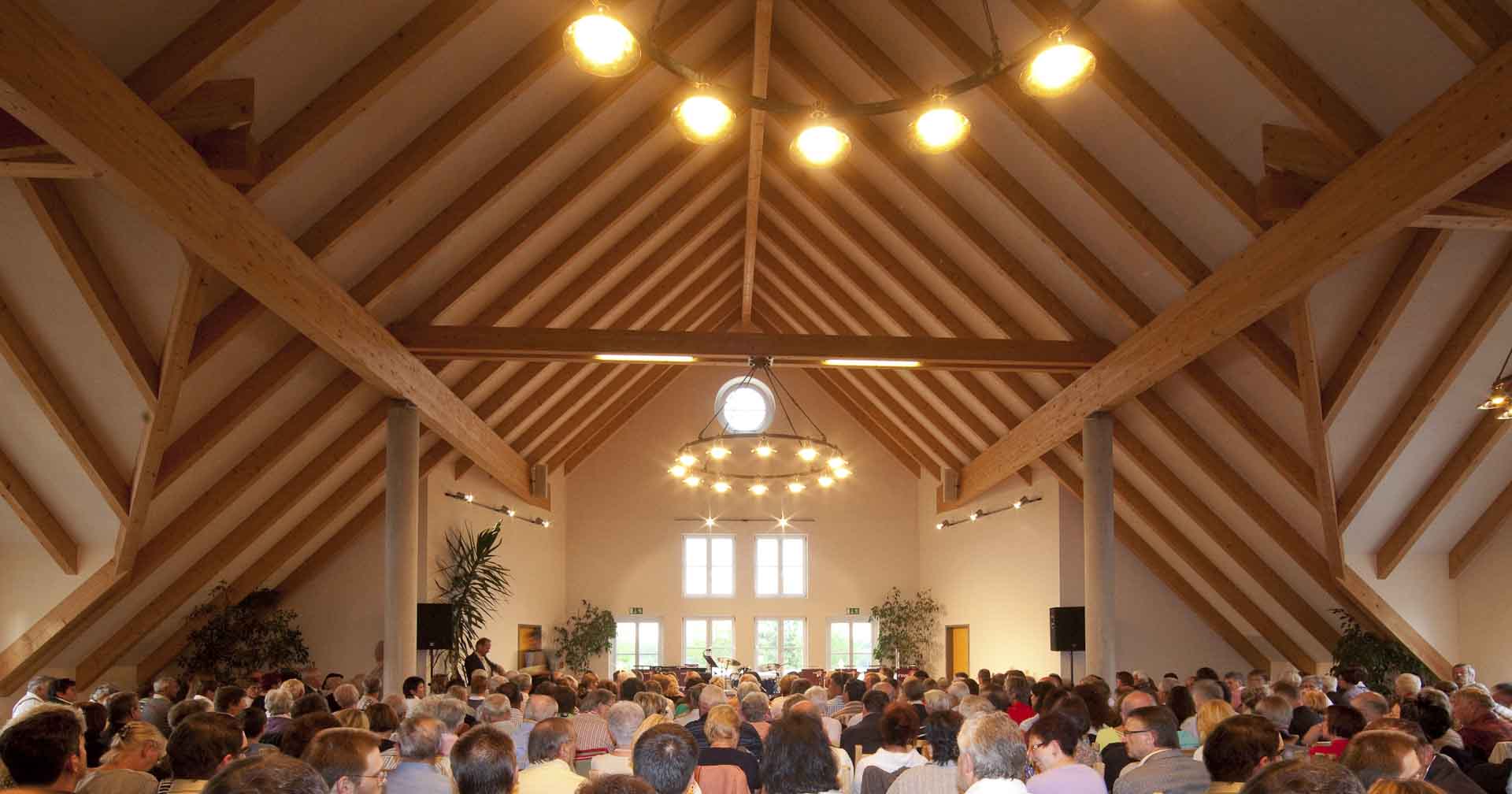
The Mindelsaal above the workshop.
I remember in the past when horn players were convinced that a detachable bell wasn't sounding as well as a fix one. But today, the request is mainly detachable bell horns, sometimes choosing even different flares!
Same for lacquering, how many hornists were sure that a horn would sound definitely better without? Unlacquering a horn wasn't rare. What do you think about these trends?
Detachable is very practical for storing and transporting the horn in the case and for being able to use different flares for achieving different sound colours. And the bell ring at a horn is sitting at the perfect place, where anyway the right hand is touching the bell, - so there is not so much vibration in this area. I have to say that there is a difference in sound between detachable and fixed bell, towards small advantages for fixed. But the difference is so small, that in the practical life it really makes sense to have the bell detachable, for the mentioned reasons above. Hand Hammered in my eyes is more important than having a fixed bell, because the energy is coming from the bell tail, and outside at the curled rim less energy is arriving, - and only if the flare gets thinner towards the curled rim, the vibration of the flare gets more equal. This equal vibration produces a very nice, rich and juicy timbre in the sound, - especially if you play louder. If you are sure (what you shouldn’t) to always use only 1 bell flare, then a fixed and HH bell would be best for the sound.
Take care that the horn maker is selling you really HH! Some are pounding a little on the bell tail, leave the flare spun and sell this as HH. This has nothing to do with the historical way of hand hammering, which means to stretch the flare outside and so making it thinner.
Only for around 20% of the players a garland at the bell rim may be of individual advantage. I personally don't like the additional weight of the garland, and so have developed a garland with only 1/3 of the usual weight for less hindering the vibrations.
Lacquering or not? In my observation and long experience, I see that most players sound better on a lacquered valve horn. The lacquer reduces some of the high overtones and so also some of the natural noises coming from the lips. The sound is a little purer. Of course with a natural horn I would not recommend lacquer. For me this would be a style break.
As a summary: whether detachable or fixed, whether lacquered or not, this does not decide about a beautiful sound. Detachable and lacquered sounds well too and is very practical. HH is preferable. You just have to take care not to bend the bell rim which needs to be thin.
Once visiting my teacher A. Cazalet at the conservatory, he immediately offered me to try his brand new horn. In order to not disturb the class, I went to the corridor, and played for half an hour every kind of concerto and orchestral excerpt, and realized that I didn't miss one note, keeping always a warm and tuned sound! Right after saying him goodbye, I phoned Paris' shop l'Olifant, ordering a triple Eb alto E. Schmid!!!
I am now starting my 17th season on that horn, whereas formerly I was changing every 4 years! I don't see any sign of being used, maybe not a good point for you as a seller, haha!!!
Could you tell us more about this concept so frequently heard that the horn would lose its sound after a while?
If the horn loses sound after years it’s ALWAYS because of mistreated valves. Unfortunately some repairmen are more like "destroy men". In order to save time when cleaning, they put the rotors and the instrument into liquids which take away material or at least all the oxidation, which also is material. The brass material does not get tired, but the sound loses energy by leaking valves. Knowing that this stupidity of the repairmen (who never have fought for every single hundred of a millimeter at making the valve) never will die out I developed a valve system where mistreated valves are always repairable. See what I’m writing in my website:
http://engelbert-schmid-horns.com/index.php/en/repair-guidance/hornist-repair-guide
In this respect I can be regarded as a bad seller. As a good seller I maybe should be glad to replace the destroyed horn by a new one. But I feel sorry for the horn player, who is losing his beloved horn and has to invest money again without being guilty. Until now I don’t know even one case when the responsible repairman had to replace the damage he had caused.
CODA To your eyes, is it the case to democratize more and more the horn playing worldwide even throughout amateurs or rather focus on forming some new "Hermann Baumann" who would let all us dream?
As mentioned above I personally regret very much that there is no horn soloist anymore travelling over the world like Hermann Baumann did. He had an incredible stage presence, - like every tiny movement well studied.
Engelbert Schmid with Hermann Baumann in Valencia at the IHS Symposium 2004.
I’m lucky to enjoy and maintain a friendly relationship with so many top soloists and orchestral players of today. Several of them would have the technical and musical abilities to travel frequently as an International Soloist similar to Hermann Baumann, but there must coincidence a few more factors: an influential concert agent building up the final stage presence and self confidence by special training, and the firm will of the soloist to want this life, often away from the family. But honestly, I’m not sure whether I should wish this life to my friends!
I would like to send a final message to all readers: despite or perhaps because of the many opportunities these days to disperse, every child should learn a musical instrument. It trains sensitivity, concentration and the brain in general. The horn is certainly one of the most interesting instruments because of its varied expressive possibilities. In any case, I fell for the horn after visiting Weber's "Freischütz" opera.
ENGELBERT SCHMID NOVEMBER 2020
Engelbert Schmid's young family in April 2020.
FRANÇAIS:
D’où pensez-vous que vient votre habileté manuelle? Quelles sont vos racines?
Je suis le troisième fils d’une famille pauvre d’agriculteurs. Une ferme trop petite pour vivre mais assez grande pour ne pas mourir de faim. Mon père était invalide de guerre à 100 %, nous les trois fils n’avions aucune excuse que quelque chose soit trop lourd ou trop difficile à faire. Avec notre mère, nous devions faire tout le travail agricole comme enfants. Par exemple, je devais participer au travail quotidien dans l’écurie (nous avions 2 chevaux au lieu d’un tracteur) dès l’âge de 4 ans, - l’alimentation, le nettoyage de la poil des chevaux, l’enlèvement du fumier de cheval, etc...
Nous passions principalement l'hiver dans l'atelier à réparer ce qui était nécessaire (par exemple les roues des charrettes) et faire tout ce qui était nécessaire pour la ferme, comme des échelles, des portes, des outils à main… C’était malgré tout une enfance heureuse mais toute la famille n'avait qu'un but: survivre!
Il n’y avait pas d’argent pour acheter des jouets, nous les faisions nous-mêmes, de nos propres mains, une situation très saine finalement! Moi et mes 2 frères avions le sentiment que nous pouvions tout faire. Quand mes frères aînés eurent 13 et 14 ans, ils furent assez forts pour que je ne sois plus nécessaire à la ferme, et heureusement j'ai eu l'occasion d'aller au lycée, comme le 1er enfant dans l’histoire du village. Mon père ne pouvait pas payer les 150 Deutsche Mark par mois du pensionnat, donc il a obtenu un accord pour payer la moitié pour les six premiers mois. "Nous verrons comment sera le premier rapport semestriel!" Mais en attendant nous avons une place pour lui... J’ai eu un terrible mal du pays, parce que j’étais habitué à ma chaleureuse famille, mais je savais que soit j’obtenais de bonnes notes, soit je restais au village à jamais. Je fus le meilleur de la classe et obtint la scolarité gratuite jusqu’à mes 16 ans. Donc, mon éducation aura coûté 6 fois 75 Marks à mes parents. À partir de 16 ans, j’ai gagné ma vie grâce au cor.
Le petit enfant au centre est Engelbert Schmid à l'âge de 5 ans.
Regardant rétrospectivement votre carrière, votre parcours est impressionnant. En tant que corniste, vous avez eu une vie musicale de prestige avec des postes importants, notamment à Berlin et Munich. Compte tenu du talent et de la chance nécessaires pour arriver à cela, qu’est-ce qui vous a poussé si tôt à développer votre propre cor?
Faire quelque chose de mes propres mains, peindre, et la physique + les mathématiques étaient mes matières préférées. Je pense que je dois raconter la façon dont je suis venu au cor: je me souviens que je chantais beaucoup avant l’école primaire. La professeure des 4 premières années de l’école primaire était très sévère envers les garçons, frappant pratiquement chaque jour l’un d’entre nous (heureusement pas trop moi, parce que j'étais plutôt bon élève), donc les garçons la détestaient tous. Cela s'est répercuté sur le chant. Nous n'aimions pas chanter avec elle, aussi elle a dit à la classe, que de toute façon, seules les filles en étaient capables, ce qui a déclenché une grève du chant! Dès lors, si l’un de nous chantait, il était frappé par les autres après l’école. Donc j'ai désappris et ne voulais plus chanter. En fin de compte ce fut une chance parce qu’au lycée, les bons chanteurs devaient rejoindre la chorale des garçon et apprendre soit le violon, soit le piano, car les professeurs de musique jouaient ces 2 instruments.
Cette situation m'a donné l'opportunité de pouvoir choisir moi-même mon instrument. Tous les quatrièmes W.E., nous étions autorisés à rentrer dans nos familles. Lors d'un de ces week-end, en deuxième année au lycée, un de mes camarades de classe m’a dit : Je suis allé à une chasse à courre. Ils ont joué du Waldhörn, cela sonnait si bien! Les "Waldhörner" étaient probablement des cors de chasse. Je n’avais aucune idée de ce que c’était. Nous n’avions pas de radio à la maison et en ce temps d'après guerre, pas non plus de fanfare du village. Mais j’étais sûr que le Waldhorn devait avoir un son fantastique et je suis allé voir le chef d’orchestre de la fanfare du pensionnat, lui disant: je veux apprendre le Waldhorn! Il ne semblait pas excité du tout, objectant qu’il n’aurait pas besoin d’un corniste, mais éventuellement d'un Tuben. Le Tuben est de toute façon beaucoup plus agréable! Il avait raison, dans une fanfare, c’est beaucoup plus agréable de jouer du Tuben. Je n’avais pas non plus la moindre idée de ce qu’était un Tuben. Mais j’aimais beaucoup mieux le mot Waldhorn, et il y avait cette histoire dans ma tête, que Waldhorn sonnerait si bien. J’ai donc insisté pour le Waldhorn et j’ai obtenu un cor alto Eb, à cette époque exclusivement utilisé pour les contretemps. 3 semaines plus tard, je suis revenu à la maison et j’ai fièrement montré mes premières notes à ma mère et à mes 2 frères aînés (mon père était mort pendant mes premières vacances d’été).
"Gu - gae - ga - ge - gi"
Ma mère a essayé d’avoir l’air intéressée, l’expression du visage de mon frère était pire, jusqu’à ce qu’il dise: ça sonne comme une vache! Il était honnête et avait raison. Ces cors alto Eb dans les fanfares ne méritent pas le nom de cor... Mais je suis resté avec cet instrument, j’ai pu bientôt avoir un meilleur son et j’ai commencé à jouer des chansons folkloriques pendant des heures chaque jour. À l'école, nous devions rester assis quatre heures et demie chaque après-midi pour faire nos devoirs. Après environ deux heures, j’avais terminé. Ceux qui avaient de bonnes notes et qui pratiquaient d’un instrument pouvaient sortir de la salle d’étude pour jouer. Après seulement 9 mois, le directeur de la fanfare m’a dit: bon sang, tu dois aller voir un autre professeur, je ne peux rien t’apprendre de plus! Je suis allé voir un autre professeur, qui après 9 mois m’a dit aussi: garçon, vous devez aller auprès d'un corniste professionnel! Puis j’ai obtenu un vrai cor et attiré l’attention. À 14 ans, j’ai vu mon premier opéra à Augsbourg, le "Freischütz" de Carl Maria von Weber. J’ai eu la chair de poule en entendant les cors et ai décidé d’apprendre cet instrument à la perfection.
Mais revenons au récit de la façon dont j’ai eu l’idée d’améliorer les cors: déjà au lycée à l’âge de 16 ans j’ai découvert que derrière les mesures de nos instruments, il devait y avoir des mathématiques et de la physique. J’ai reflété une parabole et j’ai vu qu’elle ressemblait à un pavillon de cor (la cloche). J’ai écrit à tous les fabricants de cors connus de l'époque, en leur demandant s’ils utilisaient les mathématiques pour leurs cors. Ils ont tous répondu honnêtement que non, sauf Richard Merewether mentionnant qu’il utilisait des éléments d’une parabole pour leur branche d'embouchure.
J’ai gagné tous les concours juvénils allemands, étant soliste de l’Orchestre des Jeunes allemand et membre fondateur de l’Orchestre des Étudiants Allemands comme soliste.
À 19 ans je suis devenu Cor solo du Munich Symphonics, et à 21 ans, 3ème/1er cor du Radio Symphony Orchestra de Berlin (et après 6 mois Cor solo). À 22 ans, 2ème cor du Berlin Philharmonics, et à 23 ans, Cor solo du Munich Radio Orchestra (4 fois de suite le plus jeune membre de l’orchestre lors de l’entrée).
Engelbert à 22 ans, jeune, ambitieux et sûr de lui.
Je vous ai croisé pour la première fois au Symposium International Allemand de Detmold (IHS18) en septembre 1986, et je me souviens bien de vos premiers pas en tant qu'artisan, accueillant des cornistes passionnés, montrant vos instruments rutilants et initiant quelque chose de complètement inédit pour un instrumentiste. Comment était votre état d'esprit et ressenti à cette époque?
Ma première exposition de cors fut celle de Trossingen en 1980, pour le 1er congrès "européen", (organisé par Michael Höltzel). Ma suivante a eu lieu en 1983 à l’IHS de Vienne. Ainsi, le Symposium de Detmold en 1986 n’était que la 3ème exposition de ma marque. Dans ces années, j’étais débordant d’énergie: ayant une jeune famille avec 2 filles déjà, jouant le cor Solo dans l’orchestre de la radio de Munich, construisant ma marque de cor, réalisant mes prototypes de mes mains dans une entreprise de Geretsried (Bavière), restaurant une ancienne ferme à Tiefenried où plus tard nous avons commencé notre propre production de cors, me produisant comme chambriste et comme soliste. C’est vers 1986 que j’ai fait la plupart de mes enregistrements en solo et comme chambriste à la radio bavaroise, vers l’âge de 32 ans. Mais bien sûr, je sentais qu’il ne pourrait pas durer comme cela, en faisant constamment de plus en plus de toutes parts. Michael Höltzel a cherché le cor le plus photogénique de sa classe et a sélectionné un cor double de mes débuts. Il a éliminé numériquement la gravure pour ne pas fâcher les autres fabricants. Une des affiches a été signée par tous les artistes, et bien sûr, je l’ai moi-même signée là où se trouvait ma gravure. L’exposition de Detmold a été un si grand succès que j’ai eu l’idée de changer ma vie, pour donner à la fabrication une place prépondérante dans mes activités professionnelles. Et en effet, un an plus tard, j’ai décidé de quitter mon poste de cor Solo de la radio de Munich. Certains de mes collègues d’orchestre m'ont pris pour un fou, de quitter un emploi de rêve pour aller dans une voie risquée, d’investir dans un atelier, dans des machines et des outils, de passer l’examen de maîtrise, de trouver et d’enseigner à des employés afin de pouvoir vivre de la fabrication de cors.
Ce poster unique appartient à E.S.
Durant mes études, sans doute à cause d'un cor très usagé, j’ai de façon récurrente nourrit l'espoir que les fabricants puissent un jour accomplir d’énormes progrès au niveau des valves (dans mon rêve le plus fou, jusqu’à un système électromagnétique mu par une petite batterie!) Néanmoins, je ne suis jamais devenu artisan! En construisant quelque chose de concret, y a-t-il un plaisir immédiat difficile à trouver après une journée type de musicien, où l’on ne garde que des souvenirs?
À propos de votre idée que les valves pourraient être améliorées par des solutions électromagnétiques, je crois que le musicien a besoin du contact physique direct à l’instrument en le touchant avec la peau et les lèvres. Et cela vaut pour tant d'instruments, du violon à la contrebasse, de la flûte au tuba. Les améliorations possibles sont dans la sensibilité de l’instrument, afin qu'il réponde le plus "humainement possible" à ce que l'artiste fait.
Je pense à propos que les musiciens sont chanceux que bien souvent il y ait quelque chose qui reste de leur art. En créant le bonheur dans le public, les auditeurs gardant des souvenirs, bien sûr de par les enregistrements que l'on peut entendre et réentendre, ou encore dans l'accomplissement des progrès des élèves que vous formez. Donc, je considère la profession de musicien comme "satisfaisante". Mais faire des cors qui me survivront est un sentiment très spécial. Lorsque je travaille à mon atelier, je me sens en vacances - c’est un tel plaisir.
(voir ma vidéo Handwerkskunst sur Youtube. https://youtu.be/DWD-8L3iPbw)
Je ne pourrai jamais me lasser de faire les étapes les plus difficiles de la production de mes propres mains. Oui, c’est le bonheur de créer quelque chose d’utile et positif qui me survivra de loin, de pouvoir contribuer à quelque chose qui améliore la qualité de vie.
À son établi, faisant toujours les étapes les plus difficiles personnellement, comme le cintrage 3D et la gravure du logo.
Le dernier bâtiment de la chaîne de production et l'amphithéâtre, à Mindelzell, village natale de E.S.
Vous avez fait des enregistrements solo et d'orchestre, particulièrement durant votre période à la radio de Munich. Je vois clairement que l’histoire d’amour avec votre précédente activité ne s’est pas mal terminée ou accompagnée par des regrets... Récemment, vous avez de nouveau assidûment pratiqué le cor pour jouer à l’étranger et enregistrer Adagio & Allegro de Schumann ainsi que le Trio de Brahms. Comment étais-ce de revêtir à nouveau l'habit de "musicien"?
En effet les belles années en tant que cor Solo de la Radio de Munich ne se sont pas terminées de manière négative, bien au contraire car j’étais au sommet de ma carrière et plus que reconnu dans l’orchestre. Je devais juste réaliser qu’un être humain ne peut pas toujours tout faire. Après ces 10 années heureuses de 1978 à 1988, j’ai continué pendant 5 ans à apparaître un peu partout comme soliste. Mais en 1993 j'ai fait mes adieux de corniste en interprétant le Concertino de Weber dans un Concert partagé avec Peter Damm, au 25ème Symposium International de Tallahassee (États-Unis).
Au cours de mes 10 années à l’Orchestre de la Radio de Munich, j’ai enregistré plus de 30 œuvres en tant que soliste et chambriste pour la radio bavaroise, dont le Concertino de Carl Maria von Weber et le 2ème concerto de Richard Strauss. Une sélection de ces enregistrements apparaît sous le titre "Engelbert Schmid 32", car j’ai enregistré la plupart des pièces vers l’âge de 32 ans.
Cependant, j’ai toujours voulu enregistrer le Trio de Johannes Brahms et l’Adagio & Allegro de Robert Schumann; le Brahms parce que c’était ma pièce préférée comme chambriste, et le Schumann parce qu’il cause toujours des problèmes aux cornistes en concert. Il y a si peu de repos dans la partie solo qu'il faut en premier lieu trouver l’endurance nécessaire pour aller au bout, et fréquemment, cela compromet l'exploration des subtilités de la partition. Quand les violoncellistes l’interprètent, ces problèmes disparaissent, et j’ai toujours été inspiré par la liberté musicale considérable qu’ils prennent. Je ne voulais pas les copier, mais mon interprétation s’écarte des versions habituelles car je vois plus de rubati implicites dans la partition.
Mon rêve s'était évanoui, mais en 2019, après 25 ans sans pratique assidue, une occasion se présentant m’a permis à nouveau de le réaliser. M'arrive une invitation à enseigner à la Semaine Internationale des Cuivres de Sao Paulo et à interpréter le Concerto de Franz Strauss avec l’Orchestre de Sao Paulo (OSUSP). "C’était là ou jamais", ai-je pensé, et après quatre mois, pendant lesquels j’ai travaillé extrêmement dur, en renouant à jouer du cor, j’ai donné plusieurs concerts. C’était ainsi l’occasion parfaite d’enregistrer mes "pièces adorées" dans ma Mindelsaal à l'acoustique parfaite pour la musique classique. Comme j’avais maintenant deux fois l’âge de l'époque où j’ai enregistré Engelbert Schmid 32, le titre Engelbert Schmid 64 me semblait parfait. Et quel rêve! Ma fille Heidi Schmid joue du violon au plus haut niveau - et son partenaire Joseph Maurice Weder est un grand pianiste à mes yeux! Les jours d’enregistrement étaient pure harmonie et inspiration!
Après cette merveilleuse expérience, j’ai arrêté de travailler le cor. J'ai une seconde vie avec ma femme Karina (une Arménienne de 24 ans ma cadette, qui a étudié en Russie et qui a été altiste pendant 13 ans au Théâtre Mariinsky de Saint-Pétersbourg), avec notre fils Engelbert Junior, âgé de 4 ans. et notre petite fille Anastasia, âgée de 2 ans. Cela n’a pour moi plus de sens de travailler mon cor de 22H à 1H du matin quand les enfants dorment!
Engelbert Schmid à l'âge de 32 ans.
Ce Cd sera disponible avant Noël 2020.
Dans une carrière régulière d'instrumentiste ou d’enseignant, il n’est pas nécessaire d’investir ou de planifier quoi que ce soit pour les générations à venir. Au contraire, je suppose qu’avoir créé à partir de zéro une telle marque vous pousse à prendre soin d'un million de choses pour la continuité et la perpétuation des cors E. Schmid...
Je ne sais pas exactement d’où vient ce désir très fort de créer quelque chose de bon, positif, utile et durable. La façon de produire nos cors ne peut être comparée à une fabrication normale. Chaque pièce, chaque détail est spécialement conçu et produit dans notre société, nous n’avons pas de fournisseurs comme un fabricant de cloches de pavillon ou un fabricant de valves. Nous produisons tout à Mindelzell (Bavière), car je ne pourrais trouver cette qualité. La durabilité est pratiquement illimitée, les vannes survivront au reste de l’instrument et seront toujours réparables. Par conséquent, la modeste majoration de prix par rapport à d'autres marques est plus que justifiée. Nous n’achetons pas de pièces à des pays tiers, nous payons le coût élevé de la main-d’œuvre en Allemagne et des taxes conséquentes. Seulement de cette façon, je peux réaliser cette qualité. Avec mon cerveau constamment créatif, je ressens une sorte de vocation à réaliser mes rêves et à veiller à ce que mes cors existent encore après moi, ne serait-ce que par respect pour cet artisanat.
Outre le développement de mes cors, j'aimerai mentionner ma série d’embouchures numériques, avec des courbes numériquement parfaites dans la forme de la cuvette et des bords. À mon avis, elles sont réellement plus efficaces que les embouchures faites à la main ou les copies numériques de maquettes faites à la main. Je compare toujours cela avec le dessin manuel d’un cercle. Vous aurez beau le corriger des milliers de fois, il ne deviendra jamais parfait.
Je forme en permanence mon excellente équipe d'une vingtaine d'ouvriers et je développe des outils pour rendre la production étape par étape indépendante de ma personne. Souvent le vieillissement va de pair avec une baisse de la qualité. Mais c’est exactement ce qui doit et ne se produira pas avec ma marque. La production plus mécanique se traduira plutôt par une qualité grandissante que ma production manuelle actuelle. Nous sommes au milieu de ce processus et je vous garantis que personne ne remarquera de baisse de qualitative. Je développe des méthodes de production ciblées totalement nouvelles où il est presque impossible de faire des erreurs. Chaque composante des cors est mémorisée étape par étape numériquement, et tous les modèles conçus et stockés par des programmes CAD. Celui qui combine les connaissances d’un ingénieur et d’un maître artisan, sera capable pour toujours de faire les cors E. Schmid.
Mon objectif est que mes instruments E. Schmid perdurent en version full HD. Avec mes 66 ans maintenant, je suis toujours en bonne santé et plein d'énergie. Mais je sais très bien que mon horloge vitale tourne, aussi je réduirai mes heures de travail, mais suis confiant qu’il me reste assez temps pour m’ouvrir la voie à réaliser mes objectifs. Bien sûr, après moi, il devra y avoir à nouveau un corniste professionnel à la tête de la société.
Exemple d'archivage numérique, sans les côtes.
E.S. veut mettre toute son énergie pour que son fils suive ses traces, en lui montrant la direction, le formant, mais sans jamais le pousser ou le forcer.
Je suis passé aux cors Schmid il y a plus de 20 ans! Mais je ne suis en contact avec vous que depuis peu. Vous m'avez dit récemment avoir commencé à faire des auditions dès la fin de vos études. Après une désillusion, vous avez décidé de préparer désormais les traits d'orchestre de façon drastique, pourriez-vous nous en dire plus?
Certainement qu’à l’âge de 18 ans, mon professeur a surestimé ma maturité et m’a envoyé à une audition de cor solo à la Tonhalle de Zurich. Ça s’est bien passé, mais pour des bonnes raisons ils ne m’ont pas offert le poste, car j’étais tout simplement trop jeune et que je n’avais pas suffisamment d’expérience. Ils ont eu raison de le donner à Jakob Hefti. Mais ils se sont souvenus de moi et des années plus tard, j'y suis allé remplacer des membres du pupitre de temps en temps, sans alors plus aucun intérêt à vivre à Zurich puisque j’occupais déjà ma dernière place à Munich. L’audition à Zurich a été une telle déception pour moi que j’ai dit à mon professeur à Munich Jack Meredith (que je voyais encore pour des cours particuliers, le considérant comme mon principal professeur sur sept que j'ai pu avoir): Je ne veux plus perdre une audition, que puis-je faire?
Après être resté silencieux pour un moment, au vu de ma volonté, il m’a donné la recette suivante: nous allons étudier les concertos et les traits aussi bien que tu passeras TOUJOURS au 2ème tour. Il a copié tous les extraits importants du répertoire, en a fait un petit livret, en disant: pratique-les TOUS LES JOURS, non seulement en enchaînant, mais à chaque fois avec concentration! Tu dois t'assurer que personne d’autre ne peut les jouer aussi parfaitement à chaque fois. La méthode était tout à fait claire pour moi, j’avais le "savoir-faire" pour pouvoir développer mon jeu plus fort, plus piano, sans faiblesses techniques avec un joli son, et j’ai tellement bien travaillé ces extraits, que je me suis simplement senti en sécurité. J’avais aussi une certaine expérience de la lecture à vue, alors je n’avais pas peur des surprises et je n’ai plus jamais perdu une audition!
L'américain Jack Meredith, le principal professeur d'Engelbert Schmid, Cor solo de l'Orchestre Symphonique de la Radio Bavaroise.
Tout le monde voit l'avantage d’être corniste en tant que fabricant de cors! Est-ce juste une qualité parmi beaucoup d’autres... comme?
La différence dans la qualité n’est pas seulement dû au fait d'être corniste. La spécialité de mes instruments est la combinaison de:
-mathématiques
-corniste professionnel
-maître artisan
-homme d’affaire
-développeur d'outils
-ingénieur
Il serait stupide d'aller dans une direction qui s’avère plus tard ne pas être juste: mon développement est en partie inovateur. Étape par étape, d’autres copient des détails, mais comprendre et être en mesure de copier toutes les étapes qui mènent à une certaine qualité est quelque chose de très complexe. Je suis serein et pas inquiet de l’avenir des cors Schmid.
Question difficile à venir! Loin de la musique, vous avez aussi de nombreuses passions comme la peinture, la vinification, le dessin de plans, la conception de parcs paysagers, la conception architecturale d'avant construction, vivre à la campagne...
Comment seriez-vous honoré d’être remémoré?
Pas de soucis, c'est juste complexe! J’essaie donc d’être diligent et donner d'abord un cadre général, avant de répondre à la question:
Peinture: au Lycée, ma matière préférée était les arts/peinture. J’ai rêvé après l'école secondaire, d’avoir quelques années pour étudier à l’Académie des Arts de Munich, et d’avoir du temps pour une vraie vie d'étudiant, et cela m'a manqué dans la vie. J’ai été poussé dans la vie professionnelle. Il y a une petite collection de mes œuvres, peut-être un jour publiées. Je suis heureux que ma passion pour le cor et la réalité de la vie m’aient conduit différemment. À la maison, il n’y avait pas d’argent pour me soutenir, alors j’ai dû gagner ma vie moi-même. J'ai vécu du cor à partir de 16 ans déjà, et avec réussite, donc j’ai automatiquement glissé dans la carrière de corniste. Vivre comme un artiste signifie peindre ce que quelqu’un voudra bien dépenser pour l'acheter. Je n'aurais pas été en mesure de peindre le style moderne qui est plus recherché. Nous musiciens sommes chanceux de pouvoir jouer de la musique de toutes les époques!
Voici ci-dessus une peinture récente qui mène à une autre passion pour moi, l'élaboration du vin: c’est une grande peinture murale dans mon jardin, à côté de notre amphithéâtre, montrant un paysage qui ressemble à Ribera del Duero dans la haute plaine du nord de l’Espagne, où le raisin de mes vins DON ÁNGEL pousse. À côté, vous pouvez voir une photo de moi avec mon ami Phil Myers. Aux côtés de son père, ma fille Susanne, aujourd’hui âgée de 35 ans, qui étudie l’œnologie en France, est en train d’établir un domaine à Ribera del Duero qui intensifiera la production actuelle. Un projet, peut-être pour de nombreuses générations, que je peux lancer avec grand bonheur. Chacuns de mes vins rouges haut de gamme Angelayo et Tintórico ont été récompensés au moins par des médailles d’argent internationales, plus souvent avec l’or, et en 2016, j’ai remporté le trophée du meilleur cépage "tempranillo" du monde contre 550 concurrents.
Concevoir des maisons, des jardins: une autre de mes passions. J’ai le désir de vivre dans une atmosphère particulièrement agréable, où une famille peut se sentir vraiment à la maison, peut-être cela vient-il de mon enfance, qui malgré le travail acharné était très heureuse dans notre petite ferme. Je viens de finir ma 9ème construction. De retour dans ma ville natale de Mindelzell, j’ai enfin pu réaliser le rêve de former un paysage à partir d’un pré plat, de construire le bâtiment de l’entreprise, de réaliser le seul amphithéâtre de style Grec d'Allemagne, d'avoir un parc et notre petit château où nous vivons maintenant. C’est un environnement sain et j’essaie de trouver le temps de sortir à l’extérieur en plein air.
L'Amphithéâtre, proposant une série de concerts tous les étés. 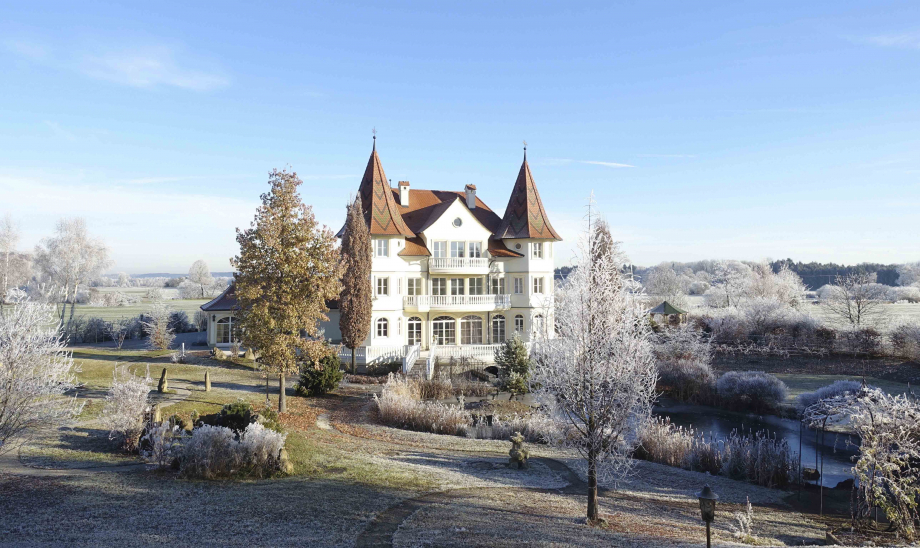
À la campagne et avec une construction raisonnée, une telle demeure ne coûte pas davantage
qu'un bel appartement dans une grande ville.
Pour ces 9 constructions, j’avais besoin d’un architecte principalement pour dessiner le plan selon les règlements et normes administratives. Mes plans dessinés à la main étaient très similaires, et pour la construction concrète, j’ai eu besoin de l’architecte rarement ou pas du tout. La plupart des bâtiments ont été cédés entre-temps. Faire des cors est ma passion et m'offre de quoi vivre, mais l'immobilier m'a rapporté bien davantage. J’ai aussi investi dans des mines d’or en 1999, lorsque toutes les banques du monde vendaient... à un niveau historiquement bas.
Comment voudrais-je qu’on se souvienne de moi un jour ? Mon ego n’a pas besoin d’être et de rester célèbre, j'aspire juste faire l’expérience d’une famille heureuse, que ma vie soit positive pour tous, que je puisse rendre la vie des cornistes plus facile, que je laisse derrière moi quelques "endroits" où les prochaines générations se sentiront à la maison. Je veux préparer mes enfants à une belle vie, et un jour je mourrai totalement heureux si mes enfants disent: Papa, c'est bien ce que tu as fait!
Dans votre atelier, vous croisez des cornistes du monde entier depuis 1985. Les écoutant, comment voyez-vous l’évolution générale du niveau au fil des ans?
Aujourd’hui, nous avons une grande quantité d'instrumentistes bien formés, peut-être pas de grandes personnalités. Cela me semble un phénomène qui traverse toute la société dans toutes les professions. Je ne vois plus de solistes avec tout le charisme et la présence scénique d’Hermann Baumann, Dennis Brain, Barry Tuckwell et Peter Damm. Probablement une des raisons est que les agents de concert ne veulent pas construire un soliste au cor, parce qu'il n’attire pas autant d’auditeurs que le piano ou le violon. Je vois aussi moins d’idéalisme avec les agents de concert que dans les temps passés.
La Mindelsaal au dessus des ateliers de fabrication.
Je me souviens du temps où les cornistes étaient convaincus qu’un pavillon détachable ne sonnait pas aussi bien qu’un fixe. Aujourd’hui, la demande est principalement axée sur des cors aux pavillons démontables, avec parfois plusieurs cloches pour un instrument! De même pour le vernis, combien d'entre nous étaient certains qu’un cor sonnait nettement mieux sans? Le dévernissage d’un cor n’était pas rare. Que pensez-vous de ces tendances?
Le pavillon dévissable est très pratique pour stocker et transporter le cor dans une boîte plate et pour pouvoir utiliser des cloches différentes afin d'obtenir des couleurs sonores variées. Et le pas de vis du cor sied à l'endroit parfait, où de toute façon la main droite touche la cloche et en atténue les vibrations. Je dois dire qu’il y a une différence dans le son entre la cloche amovible et fixe, envers de petits avantages pour l'option "fixe". Mais la différence est si minime, que dans la vie pratique, il est vraiment logique de choisir un pavillon dévissable, pour les raisons déjà mentionnées. En revanche, martelé à la main à mes yeux est plus important, parce que l’énergie vient de la grande suite, et à l’extrémité du pavillon moins d’énergie arrive de part la bague, - et seulement si la cloche devient plus mince vers le pourtour, la vibration restera plus égale. Cette vibration homogène produit un timbre très agréable, un riche et intense son, - surtout dans le forté. Si vous êtes sûr (ce dont vous ne devriez jamais) de toujours utiliser seulement 1 cloche, alors une cloche fixe et H.H. serait l'idéal pour le son. (H.H.=Hand Hammered)
Assurez-vous que le fabricant vous vende vraiment un pavillon "H.H."! Certains tapent un peu sur la grande suite, laissent la cloche brute et la vendent comme HH. Cela n’a rien à voir avec la façon historique de marteler à la main, ce qui signifie étirer le métal vers l’extérieur et ainsi le rendre de plus en plus mince. Seulement pour environ 20% des cornistes, une bague au bord de la cloche peut être un avantage. Personnellement, je n’aime pas le poids supplémentaire engendré, donc j'en ai développé une pesant seulement 1/3 du poids habituel, pour moins entraver les vibrations.
Vernis ou pas? Dans mon observation et ma longue expérience, je vois que la plupart des joueurs sonnent mieux sur des cors vernis. La laque réduit certaines mauvaises vibrations et aussi certains bruits naturels provenant des lèvres. Le son est un peu plus pur. Bien sûr, avec un cor naturel, je ne recommanderais pas l'opération de vernissage, qui serait une rupture de style.
En résumé: qu’il soit amovible ou fixe, laqué ou non, cela ne "décide" pas d’un beau son. Démontables et laqués sonnent bien aussi et sont très pratiques. H.H. est préférable. Vous avez juste à prendre soin de ne pas plier le bord de la cloche qui de fait, doit être mince.
Une fois, rendant visite à mon professeur A. Cazalet au conservatoire, il me propose immédiatement d’essayer son cor flambant neuf. Afin de ne pas déranger la classe, je vais dans le couloir, et joue pendant une demi-heure tous les concertos et traits d'orchestre possible. Je réalise alors que je n’avais pas raté une note, tout en gardant un son rond et une bonne intonation! Juste après lui avoir dit au revoir, je téléphone à l’Olifant Paris, commandant un triple alto Eb E. Schmid! Je commence aujourd'hui ma 17ème saison sur ce cor, alors qu’autrefois je changeais tous les 4 ans! Je ne vois aucun signe d’usure, peut-être pas une bonne nouvelle pour vous en tant que fabricant, haha! Pourriez-vous nous parler du concept si fréquemment entendu pour lequel le cor se "vide" après un certain temps?
Si le cor perd du son après des années, c’est TOUJOURS à cause de valves abimées par les entretiens. Malheureusement, certains réparateurs sont des "destructeurs". Afin de gagner du temps lors du nettoyage, ils mettent les rotors et l’instrument dans des liquides qui enlèvent la matière ou au moins l’oxydation, qui est également de la matière. Le laiton n'en sort pas détruit, mais le son perd de l’énergie par des fuites engendrées. Sachant trop que des réparateurs qui n’ont jamais travaillé au centième de millimètre lors de l'installation des valves seront toujours de ce monde, j’ai développé un système où les valves maltraitées seront toujours réparables. Voyez ce que j’écris sur mon site :
http://engelbert-schmid-horns.com/index.php/en/repair-guidance/hornist-repair-guide
À cet égard, je peux être considéré comme un mauvais vendeur.
Comme bon vendeur je devrais peut-être être heureux de remplacer des cors détruits par de nouveaux. Mais je suis désolé pour le corniste qui perd son cor fétiche et qui doit investir de l’argent à nouveau sans être coupable. Jusqu’à présent, je ne connais pas un seul cas où le réparateur responsable a assumé les dommages qu’il avait causés.
CODA À vos yeux, faut-il démocratiser toujours plus le cor dans le monde entier, même au travers des amateurs ou plutôt se concentrer sur la formation d'autres "Hermann Baumann" qui nous feront tous rêver ?
Comme mentionné ci-dessus, je regrette personnellement beaucoup qu’il n’y ait plus de solistes cornistes voyageant à travers le monde comme Hermann Baumann l’a fait. Il avait une présence incroyable sur scène, - comme tous ses petits mouvements bien étudiés.
Engelbert Schmid et Hermann Baumann à Valencia (Espagne) au congrès IHS de 2004.
J’ai la chance d’entretenir une relation amicale avec de très nombreux solistes et musiciens d’orchestre. Plusieurs d’entre eux auraient les capacités techniques et musicales pour tourner fréquemment en tant que soliste international comme Hermann Baumann, mais il y a la coïncidence d'autres facteurs. Un agent de concert influant construisant la présence sur scène et la confiance par une formation spéciale, la volonté ferme du soliste de vouloir cette vie souvent loin de la famille. Mais honnêtement, je ne sais pas si je désire souhaiter cette vie à mes amis!
Je voudrais adresser un dernier message à tous les lecteurs: à cause des nombreuses occasions de se disperser ces temps-ci, chaque enfant devrait apprendre un instrument de musique. Il développe la sensibilité, la concentration et le cerveau en général. Le cor est certainement l’un des instruments les plus intéressants en raison de ses possibilités expressives variées. En tout cas, j'en suis tombé amoureux après avoir assisté à une représentation de l’opéra "Der Freischütz" de Weber.
ENGELBERT SCHMID NOVEMBRE 2020
La jeune famille d'Engelbert Schmid en Avril 2020.
DEUTSCH:
Woher kommt deiner Meinung nach deine manuelle Fähigkeit? Was sind deine Wurzeln?
Ich wurde als dritter Sohn einer armen Bauernfamilie geboren. Ein Bauernhof, zu klein, um davon zu leben, und zu groß, um an Hunger zu sterben. Mein Vater war zu 100% Kriegsinvalide, d. h. es gab für uns drei Söhne keine Entschuldigung, dass etwas zu schwer oder zu schwierig für uns sein würde. Zusammen mit unserer Mutter mussten wir schon als kleine Kinder die ganze Arbeit auf dem Bauernhof erledigen. Ich musste z. B. im Alter von 4 Jahren die tägliche Arbeit im Pferdestall übernehmen - wir hatten 2 Pferde anstelle eines Traktors -, füttern, das Fell striegeln, misten und so weiter.
Den Winter verbrachten wir hauptsächlich in unserer Werkstatt, um alles zu reparieren was kaputt oder alt war (z. B. Räder für die Leiterwagen) und alles Notwendige für den Hof herzustellen, wie Leitern, Türen, Handwerkzeuge ... Es war eine glückliche Kindheit, - die ganze Familie hatte ein gemeinsames Ziel: Zu überleben! Es gab kein Geld, um Spielzeug zu kaufen, wir haben es selbst gemacht. Eine sehr gesunde Situation! Wir 3 Jungs hatten das Gefühl, dass wir einfach alles machen können. Als meine älteren Brüder 13 und 14 Jahre alt waren, waren sie stark genug, dass ich auf dem Bauernhof nicht mehr so notwendig war. Der Dorfschullehrer erkannte meine Begabung und setzte sich durch, dass ich aufs Gymnasium mit Internat geschickt wurde, ein Experiment damals im Dorf. Mein Vater konnte die 150 DM - pro Monat für das Klosterinternat nicht bezahlen, also einigte man sich auf die Hälfte, 75 DM, für die ersten 6 Monate bis zum 1. Zwischenzeugnis. „Wir haben einen Freiplatz! Schauen wir mal, wie sein erstes Zeugnis ausfällt!“ Ich hatte schreckliches Heimweh, weil ich an mein warmherziges Zuhause gewöhnt war und die Patres kaltherzig und streng waren, aber ich wusste, was passieren würde: Entweder würde ich das beste Zwischenzeugnis bekommen oder ich müsste wieder zurück ins Dorf. Das wäre für mich eine Schande gewesen, und ich spürte mit meinen 10 Jahren schon, dass ich durch den neuen Lebensweg andere Horizonte erreichen könnte. Ich war tatsächlich der Klassenbeste und bekam den Freiplatz bis zum Alter von 16 Jahren. Meine Ausbildung kostete meinen Eltern also 6 Mal DM 75, -.
Ab 16 lebte ich vom Hornblasen, neben dem weiteren Besuch des Gymnasiums.
Der kleine Bub in der Mitte ist Engelbert im Alter von 5 Jahren.
Deine Karriere ist beeindruckend. Als Hornist hattest Du ein prestigeträchtiges Musikleben mit wichtigen Positionen wie in Berlin und München. Was hat Dich angesichts des Talents und des Glücks, das erforderlich ist, um dies zu erreichen, besonders früh dazu gebracht, Dein eigenes
Horn zu entwickeln?
Etwas mit meinen eigenen Händen zu schaffen, Malen und Physik/Mathematik waren meine Lieblingsfächer. Ich denke, ich sollte die Geschichte erzählen, wie ich zum Horn kam: Ich erinnere mich, dass ich vor der Grundschule viel gesungen habe. Die Lehrerin der ersten 4 Jahre der Grundschule war zu den Buben sehr streng. Es gab schon des Öfteren körperliche Züchtigung (zum Glück nicht für mich, weil ich gute Noten hatte), also hassten wir Buben sie, was sich auch auf das Singen auswirkte. Die Lehrerin sang selber sehr gut, hatte aber kein Geschick - vor allem bei uns Buben, Freude am Singen zu vermitteln. Wir Buben wollten einfach nicht mit ihr singen und haben das Singen weitgehend boykottiert. Es war auch ihre Meinung, dass sowieso nur Mädchen gut singen könnten. Beim Vorsingen zur Notenvergabe standen alle Buben stumm da, - „Setzen 4!“ Wenn einer von uns vorsang, konnte es schon passieren, dass er nach der Schule von den anderen verhauen wurde. Also habe ich das Singen verlernt. Im Endeffekt war das mein Lebensglück, denn im Gymnasium mussten die guten Sänger erstens in den Knabenchor und zweitens entweder Geige oder Klavier lernen, weil die Musiklehrer selbst diese beiden Instrumente spielten. Aus mir wäre nie ein Geiger oder Pianist geworden, schon wegen der Unmenge an Übungsstunden nicht, die man aufwenden muss, um bei diesen Instrumenten erfolgreich zu werden.
Ich hatte also das Glück, mein Instrument selbst auswählen zu können. Jeden vierten Samstag/Sonntag durften wir zu den Eltern nach Hause fahren. Nach einem solchen Heimfahrtwochenende in meinem zweiten Jahr im Gymnasium erzählte mir einer meiner Klassenkameraden: „Ich war auf einer Jagd. Da haben Waldhörner gespielt, es hat so schön geklungen!“ Wahrscheinlich waren das Parforcehörner. Ich hatte keine Ahnung, was ein Waldhorn war. Wir hatten zu Hause kein Radio und damals in der Nachkriegszeit auch keine Dorfkapelle. Aber ich war mir sicher, dass Waldhorn fantastisch klingen musste und ging zum Dirigenten der Blaskapelle des Internats: „Ich möchte Waldhorn lernen!“ Er schaute überhaupt nicht erfreut drein und wandte ein, dass er keinen Waldhornisten, sondern einen Tenorhornisten bräuchte. „Tenorhorn ist sowieso viel schöner!“ Er hatte Recht, dass es in einer Blaskapelle viel schöner ist, Tenorhorn zu spielen. Ich hatte auch keine Ahnung, was ein Tenorhorn ist. Aber mir gefiel das Wort Waldhorn viel besser, und da kreiste doch noch die Geschichte in meinem Kopf herum, dass Waldhorn so fantastisch klingen würde. Also bestand ich auf Waldhorn und bekam ein Es-Althorn in die Hand gedrückt, das damals ausschließlich für den Nachschlag verwendet wurde. 3 Wochen später kam ich wieder nach Hause und spielte meiner Mutter und meinen 2 älteren Brüdern (mein Vater war während meiner ersten Sommerferien gestorben) stolz meine ersten Noten vor.
Gu – go - ga - ge - gi
Meine Mutter versuchte begeistert zu schauen, aber die Gesichter meiner Brüder wurden immer länger, bis einer sagte: "Das tut wie eine Kuh!" Er war ehrlich und hatte natürlich recht. Diese Es-Althörner in Blaskapellen verdienen den Namen Horn nicht. Aber ich blieb bei diesem Instrument, konnte bald einen besseren Klang herausholen und spielte jeden Tag stundenlang. Wir mussten täglich 4 ½ Stunden nachmittags am Schreibtisch sitzen und unsere Hausaufgaben machen. Nach spätestens 2 Stunden war ich aber doch fertig. Wer gute Noten hatte und ein Instrument spielte, konnte einfach aus dem Studiersaal gehen und üben. Nach nur 9 Monaten sagte mir der Dirigent der Blaskapelle: „Bub, du musst zu einem anderen Lehrer gehen, ich kann dir nichts mehr beibringen!“ Ich kam zu einem anderen Lehrer, der mir auch nach 9 Monaten sagte: „Bub, du musst zu einem professionellen Hornisten gehen!“ Ich rechne es diesen beiden Lehrern hoch an, dass sie sich nicht an ihren besten Schüler klammerten! Dann bekam ich ein richtiges Horn und man wurde auf mich aufmerksam. Mit 14 sah ich meine erste Oper in Augsburg, den "Freischütz" von Carl Maria von Weber. Als ich die Hörner hörte, lief es mir kalt über den Rücken und beschloss, dieses Instrument perfekt zu lernen.
Aber zurück zur Frage, wie ich auf die Idee kam, Hörner zu verbessern: Bereits in der Gymnasialzeit im Alter von 16 Jahren entdeckte ich, dass hinter der Hornmensur Mathematik und Physik stehen müssen. Ich spiegelte eine Hyperbel und sah, dass sie wie ein Hornbecher aussieht. Da schrieb ich alle bekannten Hornbauer der damaligen Zeit an und fragte, ob sie Mathematik für ihre Hörner verwenden würden. Sie alle antworteten ehrlich, dass dies nicht der Fall war, außer Richard Merewether, der erwähnte, dass sie Elemente einer Parabel für ihre Mundrohre verwenden würden.
Ich habe alle deutschen Jugendwettbewerbe gewonnen, war Solohornist im Bundesjugendorchester sowie Gründungsmitglied und Solohornist im Bundesstudentenorchester (heute Junge Deutsche Philharmonie).
Mit 19 Jahren, 10 Tage nach dem Abitur, wurde ich Solohornist im Symphonieorchester Graunke München (heute Münchner Symphoniker), mit 21 Jahren zunächst 3./1. Hornist beim Radiosinfonieorchester (RSO) Berlin, nach 6 Monaten dort Solohornist in demselben Orchester, mit 22 wurde ich dann 2. Hornist bei den Berliner Philharmonikern, mit 23 Solohornist im Münchner Rundfunkorchester, - zum 4. Mal in Folge das jüngste Orchestermitglied bei Eintritt.
Engelbert im Alter von 22 Jahren, jung, ehrgeizig, selbstbewusst.
Ich habe dich zum ersten Mal beim Internationalen Horn Symposium (IHS18) in Detmold im September 1986 getroffen, und ich erinnere mich noch gut an deine ersten Schritte als Hersteller, bei denen du leidenschaftliche Hornisten willkommen geheißen hast, deine brandneuen Instrumente gezeigt und irgendwie etwa für Hornisten völlig Neues vorgestellt hast. Wie war dein Herz und dein Geist zu dieser Zeit?
Meine erste Ausstellung meiner Hörner war 1980 in Trossingen, das 1. Europäische Hornsymposium, organisiert von Michael Höltzel. Meine nächste Ausstellung war 1983 beim IHS Symposium in Wien. Das Symposium in Detmold 1986 war also die dritte Vorstellung meiner Marke. In jenen Jahren strotzte ich vor Energie: Ich hatte bereits eine junge Familie mit zwei Töchtern, spielte Solo-Horn im Münchner Rundfunkorchester, baute meine Hornmarke auf, wobei ich die Prototypen mit meinen eigenen Händen in einer Firma in Geretsried baute, restaurierte ein altes Bauernhaus in Tiefenried, wo wir später unsere eigene Hornproduktion begannen, und trat häufig als Kammermusiker und als Solist auf. Es war damals um das Jahr 1986 herum, als ich die meisten meiner Solo- und Kammermusikaufnahmen im Bayerischen Rundfunk einspielte, ungefähr im Alter von 32 Jahren. Aber natürlich hatte ich das Gefühl, dass es nicht so weitergehen konnte, mir immer mehr und mehr aufzuhalsen.
Für das Poster des Symposiums suchte Michael Höltzel nach dem fotogensten Horn in seiner Klasse und wählte ein frühes Modell meiner Doppelhörner aus. Sie retuschierten die Gravur, um die anderen Hornbauer nicht zu verärgern. Eines der Poster wurde von allen Künstlern signiert, und natürlich habe ich selbst es genau dort signiert, wo sich die wegretuschierte Gravur befand. Ich ließ es mir nicht nehmen, dieses Poster zu erwerben. Die Ausstellung in Detmold war so erfolgreich, dass ich dort auf die Idee kam, eventuell mein Leben zu ändern und dem Hornbau den ersten Platz in meiner beruflichen Tätigkeit einzuräumen. Und tatsächlich beschloss ich ein Jahr später, meine Position als Solohornist beim Münchner Rundfunkorchester zu kündigen. Einige meiner Orchesterkollegen erklärten mich für verrückt, diesen Schritt zu machen, einen solchen Traumjob aufzugeben und in das riskante Wasser zu springen, für mehrere Jahre kein Einkommen zu haben, zuerst eine Werkstatt zu bauen, in Maschinen und Werkzeuge zu investieren, mich Meisterprüfung zu unterziehen, Arbeiter zu finden und anzulernen, um dann vielleicht vom Hornbau leben zu können.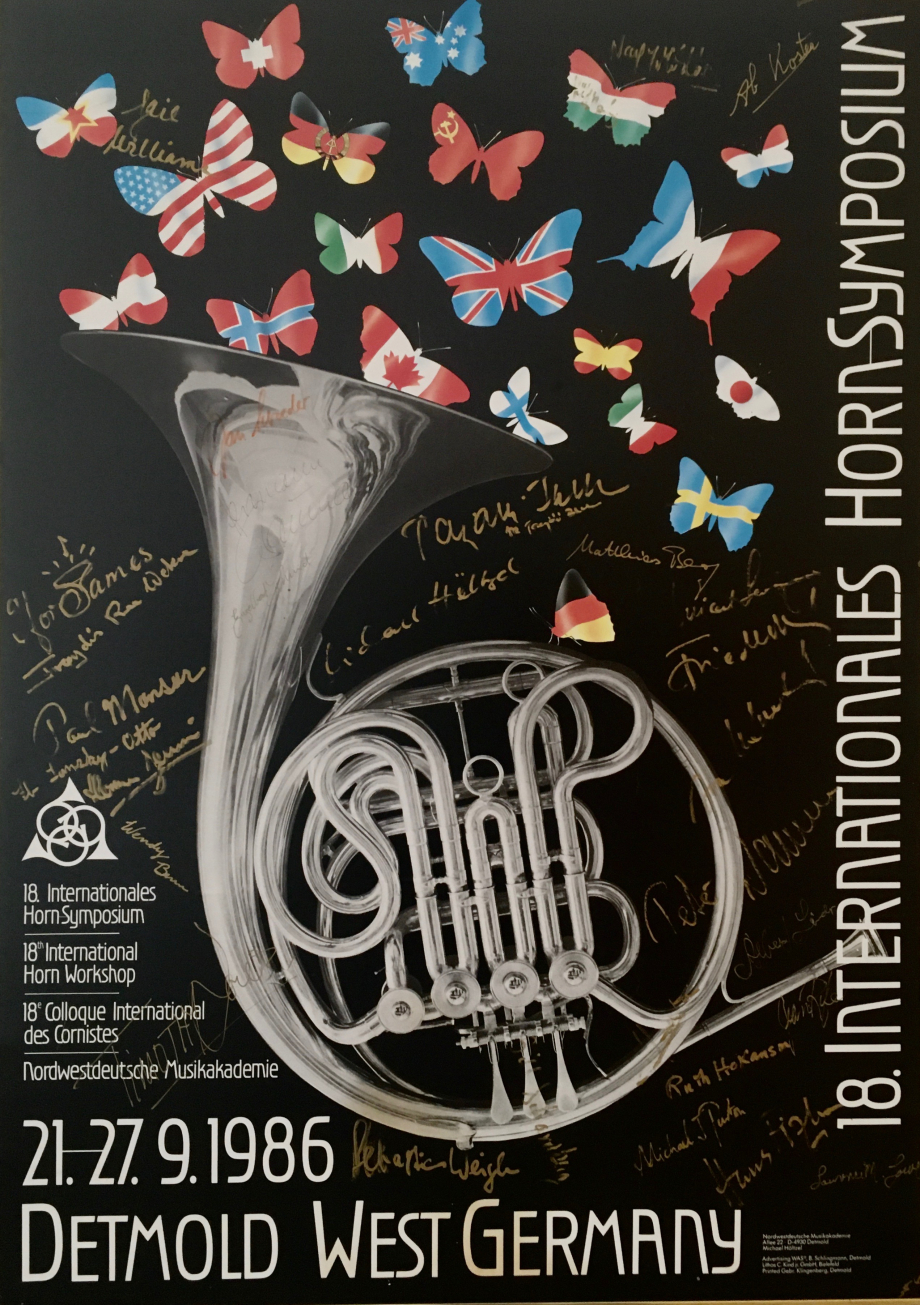
Dieses einmalige Poster ist im Besitz von Engelbert Schmid.
Während meines Studiums, weil ich ein sehr gebrauchtes Horn spielte, hoffte ich ständig, dass die Hersteller eines Tages große Fortschritte mit dem Ventilsystem erzielen könnten (in meinen verrücktesten Träumen bis hin zu elektromagnetischen Lösungen, von einer kleinen Batterie bewegt!). Ich wurde jedoch nie selbst ein Hersteller! Gibt es beim Bauen von etwas Konkretem ein unmittelbares Vergnügen, das am Ende eines Tages des Musizierens nur schwer zu finden ist, weil man nur Erinnerungen behält?
Um Deine Idee zu erwähnen, dass beispielsweise Ventile durch elektromagnetische Lösungen verbessert werden könnten, glaube ich, dass der Musiker den direkten physischen Kontakt zum Instrument braucht, indem er es mit der Haut und den Lippen berührt. Dies geht durch alle Instrumente, von der Geige bis zum Kontrabass, von der Flöte bis zur Bass-Tuba. Die möglichen Verbesserungen liegen in der Empfindlichkeit des Instruments, dass es leicht und einfühlsam auf das reagiert, was der Musiker tut.
Auch denke ich, dass die Musiker das Glück haben, dass oft etwas von ihrer Musik haften bleibt, indem sie den Zuhörern Glücksgefühle bescheren, die sie beim Hören von Aufnahmen immer wieder fühlen können, oder wenn Musiker den Fortschritt ihrer Schüler sehen. Im Allgemeinen betrachte ich den Beruf "Musiker" als einen befriedigenden. Aber Hörner zu machen, die mich überleben, ist ein ganz besonderes Gefühl. Wenn ich an der Werkbank arbeite, fühle ich mich wie im Urlaub - es ist mir so ein Vergnügen, siehe mein Video über Handwerkskunst auf Youtube:
https://youtu.be/DWD-8L3iPbw
Niemals kann ich müde werden, die schwierigsten Schritte unserer Produktion selbst zu machen. Ja, es ist die Gewissheit, etwas Hilfreiches für die Welt geschaffen zu haben, etwas Positives, etwas, das mich bei weitem überlebt, und etwas zur Steigerung der Lebensqualität beitragen zu können.
Engelbert Schmid an der Werkbank. Er führt immer noch die schwierigsten Schritte persönlich aus, wie das Gravieren und Biegen der dreidimensionalen Teile, hier das Verbindungsrohr zwischen Ventil Nr. 1 und Nr. 6.
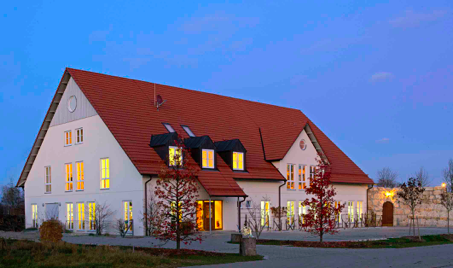
Engelbert Schmid‘s endgültiges Betriebsgebäude in seinem Heimatdorf Mindelzell, mit Amphitheater daneben, im Keller die Weinkellerei.
Du hast Solo- und Orchesteraufnahmen gemacht, hauptsächlich aus deiner Zeit im Münchner Rundfunk Orchester. Ich sehe klar und deutlich, dass die Liebesgeschichte mit deinem früheren Job nicht schlecht endete oder von Bedauern begleitet wurde ... Vor kurzem hast du wieder geübt, um Konzerte im Ausland zu geben und um Schumann Adagio & Allegro und Brahms Horn-Trio aufzunehmen. Wie war es, wieder auf deinen alten Spuren zu wandeln?
In der Tat endete meine glückliche Zeit als Solohornist im Münchner Rundfunkorchester nicht negativ, vielmehr war ich auf dem Höhepunkt meiner Karriere als Hornist, und im Orchester mehr als anerkannt. Ich musste nur einsehen, dass einer nicht alles machen kann. Nach diesen glücklichen 10 Jahren von 1978 bis 1988 trat ich weitere 5 Jahre weltweit als Solist auf, verabschiedete mich jedoch 1993 vom aktiven Hornblasen, indem ich beim 25. Internationalen Hornsymposium in Tallahassee (USA) als Schlussstück das Weber Concertino aufführte, in einem mit Peter Damm geteilten Konzert.
Während meiner 10-jährigen Tätigkeit als Solohornist des Münchner Rundfunkorchesters (1978 bis 1988) habe ich über 30 Werke als Solist und Kammermusiker für den Bayerischen Rundfunk aufgenommen, darunter das Concertino von Carl Maria von Weber und das 2. Hornkonzert von Richard Strauss. Eine Auswahl dieser Aufnahmen erscheint unter dem Titel "Engelbert Schmid 32", so genannt, weil ich die meisten Stücke etwa im Alter von 32 Jahren aufgenommen habe.
Ich wollte jedoch immer auch das Brahms Horn-Trio und Robert Schumanns Adagio & Allegro aufnehmen, das Brahmstrio deshalb, weil es das Stück war, das ich bei Kammermusikkonzerten am liebsten gespielt habe, und die Schumann, weil es den Hornisten bei Live-Auftritten immer Probleme bereitet. Es gibt so wenige Pausen im Solopart, dass die erste Aufgabe des Hornisten darin besteht, sich die Kräfte so einzuteilen, dass man durchkommt, was in der Regel die Fähigkeit beeinträchtigt, die Feinheiten der Musik umzusetzen. Wenn Cellisten es spielen, verschwinden solche Probleme, und ich war immer von der beträchtlichen musikalischen Freiheit inspiriert, die sie sich nehmen. Ich wollte sie nicht kopieren, aber meine Interpretation weicht von der normalen Aufführungspraxis ab, da ich mehr Rubati in der Partitur sehe, als sich Hornisten normalerweise erlauben.
Mein Traum blieb damals auf der Strecke, aber 2019, nach 25 Jahren ohne Üben auf dem Horn, ergab sich eine überraschende Gelegenheit, meinen Traum zu verwirklichen. Die Einladung, 2019 bei der International Brass Week in Sao Paulo zu unterrichten und das Konzert von Franz Strauss mit dem Sao Paulo Orchester (OSUSP) aufzuführen, gab mir einen Ruck. "Jetzt oder nie mehr!" dachte ich, und nach vier Monaten extrem harten Trainings auf dem Horn gab ich mehrere Live-Auftritte. Es war auch die perfekte Gelegenheit, die fehlenden "Traumstücke" in meinem Mindelsaal aufzunehmen, einem Saal, der akustisch perfekt für klassische Musik ist. Da ich jetzt doppelt so alt war wie bei der Aufnahme von „Engelbert Schmid 32“, schien der Titel „Engelbert Schmid 64“ perfekt zu sein. Und was für ein Traum! Meine Tochter Heidi Schmid spielt ihre Geige auf höchstem Niveau - und ihr Partner Joseph Maurice Weder ist in meinen Augen ein großartiger Pianist! Die Aufnahmetage waren pure Harmonie und Inspiration!
Nach dieser traumhaften Erfahrung hörte ich wieder auf zu üben. Bei einem zweiten Leben mit meiner 24 Jahre jüngeren Frau Karina (eine Armenierin, die in Russland studierte und 13 Jahre lang Bratschistin am Mariinsky-Theater in Sankt Petersburg war), mit unserem Sohn Engelbert Junior, jetzt 4 ½ Jahre, und unserem kleinen Mädchen Anastasia, jetzt 2 Jahre, machte es keinen Sinn, jeden Abend von 22:00 bis 01:00 Uhr Horn zu üben, wenn die Kinder schlafen.
Engelbert Schmid im Alter von 32 Jahren.
Diese CD ist jetzt kurz vor Weihnachten 2020 erschienen.
In einer üblichen Karriere als Spieler oder Lehrer besteht keine Notwendigkeit, etwas für die kommenden Generationen zu investieren oder zu planen. Im Gegensatz dazu, denke ich, - wenn du aus dem Nichts eine wertvolle Marke geschaffen hast, muss es dich angespornt haben, für unzählige von Maßnahmen und Vorkehrungen zu sorgen, um den Fortbestand, die Nachhaltigkeit und die Qualitätssicherung der Engelbert Schmid Hörner zu gewährleisten...
Ich weiß nicht genau, woher ich diesen starken Wunsch habe, etwas besonders Gutes, Positives, Nützliches und Nachhaltiges zu schaffen. Die Art und Weise, wie unsere Hörner hergestellt werden, kann nicht mit der normalen Herstellung von Hörnern verglichen werden. Jedes Teil, jedes Detail wird speziell in unserer Firma entworfen und hergestellt. Wir haben keine Lieferanten wie Schallstückmacher oder Maschinenbauer. Wir produzieren das alles hier in Mindelzell (Bayern), weil ich diese Qualität woanders nicht finden kann. Die Haltbarkeit ist praktisch unbegrenzt, die Ventile überstehen den Rest des Instruments und sind immer reparabel.
Der im Vergleich zu anderen Marken moderate Zuschlag ist also mehr als gerechtfertigt. Wir kaufen keine Teile aus Drittländern, wir zahlen die hohen Arbeitskosten in Deutschland und die hohen Steuern hier - denn nur so kann ich diese Qualität realisieren. Da ich dieses permanent arbeitende und kreative Gehirn habe, fühle ich eine Art Berufung in mir, meine Träume zu verwirklichen und dafür zu sorgen, dass meine Hörner zum Wohle der Hornisten auch nach meiner Zeit überleben.
**********
Neben der Hornentwicklung sollte ich meine digitale Hornmundstückserie mit digital perfekten Kurven bei der Form von Kessel und Rand erwähnen. Nach meiner Beobachtung sind sie einfach effizienter als handgefertigte Mundstücke oder digitale Kopien handgefertigter Muster. Ich vergleiche das immer mit dem Zeichnen eines Kreises. Von Hand können einer ihn tausende Male korrigieren, es
wird nie ein perfekter Kreis sein.
Ich unterrichte ständig meine exzellente Belegschaft und entwickle Werkzeuge, um die Produktion Schritt für Schritt unabhängig von meiner Person zu machen. In der Regel geht dies mit einem Qualitätsverlust einher. Aber genau das muss und wird bei meiner Hornmarke nicht passieren. Die maschinellere Produktion führt eher zu einer letztendlich noch besseren Qualität als die derzeitige manuelle Produktion. Wir sind bereits mitten in diesem Prozess und ich garantiere, dass niemand einen Qualitätseinbruch bemerken wird. Ich entwickle teilweise völlig neue Produktionsmethoden, bei denen es fast unmöglich ist, ein falsches Ergebnis zu erzielen. Jeder Teil der Hörner wird Schritt für Schritt digital erfasst, und alle Hornmodelle werden von CAD-Programmen nachentworfen und gespeichert. Wer das Wissen eines Ingenieurs und eines Handwerksmeisters kombiniert, kann die Engelbert Schmid Hörner für alle Zeiten weiterhin herstellen.
Mein Ziel ist es, dass die Engelbert Schmid Hörner in der Full HD Version für immer überleben. Mit meinen 66 Jahren bin ich immer noch bei bester Gesundheit und Energie. Aber ich weiß sehr gut, dass auch meine Lebensuhr tickt. Ich werde meine Arbeitszeit verkürzen, aber ich bin zuversichtlich, dass mir noch genügend Jahre bleiben, um den Weg zu ebnen und meine Ziele zu erreichen. Natürlich sollte und muss es nach meiner Zeit wieder einen professionellen Hornisten an der Spitze der Firma geben.
Hier ist ein Beispiel einer digitalen Erfassung, natürlich für die Öffentlichkeit ohne Maßangaben.
Ich werde all mein Können einsetzen, dass mein Sohn Engelbert Junior in meine Fußstapfen tritt – wobei der Vater ihn führt und aufbaut, nicht schiebt und zwingt.
Ich habe vor mehr als 20 Jahren auf die Engelbert Schmid Hörnern gewechselt! Aber ich bin nur seit ein paar Jahre mit dir in Kontakt. Du hast mir kürzlich erzählt, dass du am Ende deines Studiums mit Probespielen begonnen hast. Nach einer Enttäuschung, hast de beschlossen, die
Orchesterstellen drastisch vorzubereiten. Kannst du uns mehr darüber erzählen?
Es ist wahr, dass mein Lehrer meiner Gymnasialzeit meine Reife im Alter von 18 Jahren überschätzte und mich zu einem Probespiel für Solo Horn in der Tonhalle Zürich schickte, also noch bevor ich offiziell Horn studierte. Ich glaube ich spielte ganz passabel, aber aus gutem Grund haben sie mir die Stelle nicht gegeben, da ich einfach zu jung war und nicht genügend Erfahrung für diese Position hatte. Mit Recht haben sie die Stelle Jakob Hefti gegeben. Aber sie erinnerten sich Jahre später an mich und gelegentlich habe ich dort immer wieder die ausgeholfen, allerdings ohne Interesse meinerseits, eventuell in Zürich zu leben, da ich bereits meine finale Position in München innehatte. Das Probespiel in Zürich seinerzeit war für mich eine solche Enttäuschung, dass ich meinem Lehrer in München, Jack Meredith (der mich nicht zu jenem Probespiel geschickt hatte und den ich als meinen Hauptlehrer von sieben betrachte), sagte: Ich möchte nie mehr ein Probespiel verlieren! Was kann Ich machen?
Er verstummte eine Weile, sah meinen festen Willen, grübelte eine ganze Weile und gab mir dann das Rezept: „Wir werden die Solokonzerte so gut studieren, dass du IMMER in die 2. Runde kommen wirst!“ Er kopierte alle wichtigen Orchesterstellen, machte ein kleines Heft daraus und sagte: „Übe sie JEDEN TAG, nicht nur durchspielen, sondern jedes Mal mit Konzentration! Du musst sicher sein, dass KEIN ANDERER so sicher sein kann wie du, sie praktisch perfekt zu spielen!“
Die Methode war mir sofort klar, und ich hatte sozusagen das Handwerk drauf, konnte mehr als laut genug, mehr als leise genug spielen, technisch ohne Schwächen, mit einem guten Klang, und übte diese Orchesterstellen so gut, dass ich mich einfach sicher fühlte. Weil ich auch schon jahrelang überall herum spielte, um vom Hornblasen leben zu können, war ich auch ziemlich routiniert im "Primera Vista" Spiel, hatte also keine Angst vor Überraschungen.
Und tatsächlich habe ich nie mehr ein Vorsprechen verloren, außer eines, als ich wirklich krank war, und eines, als wir zu zweit übrig waren. Das Orchester wollte uns beide und konnte sich nach vier Runden immer noch nicht entscheiden, - also sagte ich ihnen: „Nächste Woche spiele ich in München vor. Wenn sie mich nehmen, komme ich sowieso nicht! " Wenn ich dieses Probespiel, das erste Probespiel in Zürich, sowie das, als ich krank war, nicht mitzähle, ist meine Erfolgsquote 4 Probespiele - 4 Stellen.

Mein Hauptlehrer Jack Meredith, ein gebürtiger Amerikaner, Solohornist im Symphonieorchester des Bayerischen Rundfunks.
Jeder würde es als Vorteile ansehen, Hornist zu sein, wenn er Hörner baut! Ist dieser Vorteil der einzige Qualitätsunterschied, - oder einer unter vielen anderen? Wie verhält sich das?
Der Qualitätsunterschied liegt nicht nur darin, dass ich auch Hornist bin. Die Spezialität meiner Hörner ist die Kombination von:
- Mathematik
- professioneller Hornist
- Handwerkermeister
- Geschäftsmann
- Werkzeugmacher
- Ingenieur
Es wäre dumm, hier mit etwas zu prahlen, was sich dann als unwahr herausstellt: Meine Entwicklung ist teilweise der Zeit voraus. Schritt für Schritt kopieren andere Hersteller einige Details, aber die gesamte Qualität zu verstehen und kopieren zu können, ist etwas sehr Komplexes.
Ich bin also sehr ruhig und sicher über die goldene Zukunft der Engelbert Schmid Hörner.
Jetzt eine schwierige Frage! Neben der Musik hast du noch viele Leidenschaften wie Malen, Wein machen (und Trinken), Werkzeug- und Maschinenpläne zeichnen, Pflanzen von Bäumen, Entwerfen von Bauplänen, Genießen der Landschaft und und und. Wie wäre es dir am liebsten, eines Tages in die Geschichte einzugehen?
Keine schwierige Frage, nur komplex zu beantworten! Deshalb versuche ich schnell zu sein und zuerst einen Überblick zu geben, bevor ich auf die Frage eingehe:
Malen: Im Gymnasium war Kunsterziehung mein Lieblingsfach. Ich träumte davon, nach dem Abitur einige Jahre an der Akademie der Künste in München zu studieren und Zeit für ein echtes Studentenleben zu haben, das mir in meinem Leben nicht vergönnt war. Ich wurde ins Berufsleben geworfen. Es gibt eine kleine Sammlung meiner Kunstwerke. Vielleicht werden sie eines Tages veröffentlicht.
Ich bin froh, dass meine Leidenschaft für das Horn und die Realität des Lebens mich in eine andere Richtung geführt hat. Von zu Hause aus gab es kein Geld, um mir zu helfen, also musste ich meinen Lebensunterhalt selbst verdienen. Ich habe bereits ab 16 Jahren vom Hornspiel gelebt und war erfolgreich, also bin ich automatisch in die Hornisten-Karriere gerutscht. Als Künstler zu leben bedeutet zu malen, was jemand, der Geld ausgibt, kaufen möchte. Es wäre mir unmöglich, diesen modernen Stil zu malen, der dafür erforderlich ist. Wir Musiker können uns glücklich schätzen, dass wir Musik aus allen Epochen spielen können.
Hier ist mein jüngstes Werk, das zu einer weiteren Leidenschaft von mir überleitet, der Weinherstellung: Dieses große Wandgemälde in meinem Weingarten neben unserem Amphitheater, eine Fantasy-Komposition, zeigt, wie ungefähr es in Ribera del Duero auf der nordspanischen Hochebene aussieht, wo die Trauben für meine DON ÁNGEL Weine wachsen. Rechts sieht man ein Foto, das mich mit meinem Freund Phil Myers zeigt. Meine Tochter Susanne, jetzt 35, die in Frankreich Önologie studiert hat, gründet gerade mit ihrem Vater im Rücken ein Weingut in Ribera del Duero, das die aktuelle Produktion steigern wird. Ein Projekt, möglicherweise für viele Generationen, welches ich zum Glück initiieren kann. Jeder meiner erstklassigen und hochwertigen Rotweine Angelayo und Tintórico wird ausgezeichnet, hauptsächlich mit internationalem Gold, mindestens mit Silber. 2016 gewann ich die Trophy für den weltbesten Tempranillo gegen 550 Teilnehmer.
Häuser, Gärten entwerfen: Eine weitere Leidenschaft von mir. Ich habe den starken Drang, in einer besonders schönen Atmosphäre zu leben, in der sich eine Familie wirklich zu Hause fühlen kann. Vielleicht kommt das von meiner Kindheit, die trotz der harten Arbeit auf jenem kleinen Bauernhof sehr glücklich war. Gerade habe ich meinen 9. Bau beendet. Zurück in meinem Heimatdorf Mindelzell konnte ich schließlich meinen Traum verwirklichen, ausgehend von einer flachen Wiese eine Landschaft zu formen, das Betriebsgebäude zu errichten, Deutschlands einziges Amphitheater im altgriechischen Stil zu realisieren, einen Park zu gestalten und unser kleines Schloss zu bauen, in dem wir jetzt leben. Es ist eine gesunde Umgebung und ich versuche genug Zeit zu finden, um mich draußen an der frischen Luft zu bewegen.
Das Amphitheater, wo wir jedes Jahr eine Konzertreihe veranstalten.
Auf dem Land und mit Eigenregie beim Bau konnte Engelbert Schmid ein solches Schlösschen zum Preis einer großen Wohnung in einer teuren Stadt realisieren.
Bei all meinen 9 Bauwerken brauchte ich einen Architekten hauptsächlich dafür, dass er den Plan nach den Vorschriften der Landratsämter zeichnete. Meine handgezeichneten Pläne sehen praktisch gleich aus, und für die praktische Bauleitung brauchte ich den Architekten selten oder gar nicht. Die meisten dieser Gebäude sind mittlerweile verkauft. Hörner machen ist meine Leidenschaft und gibt mir das monatliche Einkommen zum Leben, aber die Immobilien haben sich viel besser ausgezahlt. Außerdem habe ich 1999 in Goldminen investiert, als alle Banken weltweit ihr Gold verkauften und der Goldpreis auf einem historisch niedrigen Niveau lag.
Nun zur eigentlichen Frage: Wie möchte ich eines Tages in Erinnerung bleiben? Mein Ego braucht es nicht, berühmt zu sein und zu bleiben, ich möchte nur eine glückliche Familie erleben, möchte, dass mein Leben positiv für die Welt ist, dass ich den Hornisten das Leben leichter machen kann, dass ich einige Plätze hinterlasse, wo sich die nächsten Generationen zu Hause fühlen können, möchte meine Kinder auf ein glückliches und erfolgreiches Leben vorbereiten, - und eines Tages werde ich total glücklich sterben, wenn meine Kinder sagen: “Papa, du hast es richtig gemacht in deinem Leben!“
Seit 1985 reisen Hornisten aus der ganzen Welt zu deiner Werkstatt. Wie siehst du die Entwicklung des allgemeinen Niveaus im Laufe der Jahre, wenn du den Hornisten zuhörst?
Heute haben wir eine große Anzahl gut ausgebildeter Hornisten, aber vielleicht keine großen Persönlichkeiten mehr. Dies scheint mir ein Phänomen zu sein, das die gesamte Gesellschaft in allen Berufen durchzieht. Ich sehe keine Solisten mehr mit dem Charisma und der Bühnenpräsenz von Hermann Baumann, Dennis Brain, Barry Tuckwell und Peter Damm. Wahrscheinlich liegt einer der Gründe dafür darin, dass Konzertagenten keinen Hornsolisten aufbauen wollen, weil Horn nicht so viele Zuhörer anzieht wie ein Klavier- oder Geigen-Solist. Ich sehe also weniger Idealismus bei Konzertagenten als früher.
Der Mindelsaal über der Werkstatt.
Ich erinnere mich an die Vergangenheit, als Hornisten davon überzeugt waren, dass eine abschraubbares Schallstück nicht so gut klingen würde wie ein festes. Heute aber gibt es hauptsächlich Nachfrage für Hörner mit abschraubbarem Becher, manchmal sogar für verschiedene Schallbecher! Dasselbe bei der Lackierung, wie viele Hornisten waren sich sicher, dass ein Horn ohne Lackierung definitiv besser klingen würde? Nicht selten wurden lackierte Hörner entlackt. Was denkst du über diese Trends?
Abschraubbbar ist sehr praktisch, um das Horn im bequemeren Koffer aufzubewahren und zu transportieren, und um verschiedene Becher zu verwenden, um unterschiedliche Klangfarben zu erzielen. Und der Schraubring beim Schallstück eines Horns liegt an der perfekten Stelle, wo sowieso die rechte Hand das Schallstück berührt – und es also in diesem Bereich sowieso nicht so viel Vibration gibt. Ich muss sagen, dass es einen Klangunterschied zwischen abnehmbarem und festem Schallstück gibt, zugunsten von kleinen Vorteilen für das feste Schallstück. Der Unterschied ist jedoch so gering, dass es im praktischen Leben aus den oben genannten Gründen wirklich sinnvoll ist, das Schallstück abschraubbar zu haben. In meine Augen ist handgehämmert (HH) wichtiger als ein festes Schallstück, da die Energie vom Schallstückstengel herkommt und außen am Bördelrand weniger Energie ankommt - und nur, wenn der Becher zum Bördelrand hin dünner wird, ergibt sich ein gelichmäßigeres Mitschwingen des Metalls. Diese gleichmäßige Vibration erzeugt eine sehr schöne, reiche und saftigee Klangfarbe - besonders wenn man lauter spielt. Wenn der Hornist sicher ist (was er nicht sein sollte), immer nur 1 Becher zu verwenden, ist ein festes und HH Schallstück für den Klang am besten.
Pass auf, dass der Hornhersteller dir wirklich HH verkauft! Einige hämmern ein wenig auf dem Schallstückstengel herum, lassen den Becher gedreht und verkaufen so ein Schallstück als HH. Dies hat nichts mit der historischen Art des Handhämmerns zu tun, die den Becher nach außen zu dehnt und so dünner macht.
Nur für rund 20% der Spieler kann ein Kranz am Becherrand von individuellem Vorteil sein. Ich persönlich mag das zusätzliche Gewicht des Kranzes nicht und habe deshalb einen Kranz mit nur 1/3 des üblichen Gewichts entwickelt, um das Mitschwingen weniger zu behindern.
Lackieren oder nicht? In meiner Beobachtung und meiner langjährigen Erfahrung sehe ich, dass die meisten Spieler auf einem lackierten Ventilhorn besser klingen. Der Lack reduziert einige der hohen Obertöne und damit auch etwas die natürlichen Nebengeräusche, die von den Lippen kommen. Der Ton ist etwas reiner. Natürlich würde ich bei einem Naturhorn keinen Lack empfehlen. Für mich wäre das ein Stilbruch.
Zusammenfassend: Ob abschraubbar oder fest, ob lackiert oder nicht, dies entscheidet nicht über einen schönen Klang. Abnehmbar und lackiert klingt auch gut und ist sehr praktisch. HH ist vorzuziehen. Der Hornist muss nur darauf achten, den Becherrand, der dünn sein muss, nicht zu verbiegen.
Als ich meinen Lehrer A. Cazalet im Konservatorium besuchte, bot er mir sofort an, sein brandneues Engelbert Schmid Horn zu probieren. Um die Klasse nicht zu stören, ging ich zum Korridor und spielte eine halbe Stunde lang jede Art von Konzert- und Orchesterstellen und war überrascht, dass ich keine einzige Note verkickste und immer einen warmen und wohl intonierten Klang behielt! Gleich nachdem ich mich von ihm verabschiedet hatte, rief ich in Paris im Laden von l'Olifant an und bestellte ein Schmid Tripelhorn mit Hoch Es!!!
Ich beginne jetzt meine 17. Saison mit diesem Horn, während ich früher alle 4 Jahre gewechselt hatte! Ich sehe keineerlei Anzeichen für Abnutzung, vielleicht kein so guter Gesichtspunkt für dich als Verkäufer, haha!!! Kannst du uns mehr über die häufige Meinung erzählen, dass ein Horn nach einiger Zeit seinen Klang verlieren würde?
Wenn ein Horn nach Jahren an Ton verliert, liegt das nicht an Materialermüdung, sondern IMMER an misshandelten Ventilen. Leider sind einige Reparateure eher "Kaputteure". Um beim Reinigen Zeit zu sparen, legen sie die Ventilwechsel und das Instrument in Bäder, die Material oder zumindest die gesamte Oxidation, die ebenfalls Material ist, wegnehmen. Das Messingmaterial ermüdet nicht, sondern der Klang verliert Energie durch undichte Ventile. Da mir klar war, dass diese Dummheit der Reparatuere (die nie um jedes Hundertel Millimeter bei der Herstellung des Ventils gekämpft haben) niemals aussterben wird, entwickelte ich ein Ventilsystem, bei dem misshandelte Ventile immer reparabel sind. Schaut, was ich auf meiner Website schreibe: http://engelbert-schmid-horns.com/index.php/reparatur-anleitung/anleitung-hornist
In dieser Hinsicht kann ich als schlechter Verkäufer angesehen werden. Als guter Verkäufer sollte ich vielleicht froh sein, das zerstörte Horn durch ein neues zu ersetzen. Aber der Hornist tut mir leid, der sein geliebtes Horn verliert und wieder Geld investieren muss, ohne schuldig zu sein. Bis jetzt kenne ich keinen einzigen Fall, wo der dafür verantwortliche Reparatuer den von ihm verursachten Schaden ersetzen musste.
CODA Ist es für dich so, dass sich das Hornblasen weltweit auch bei Amateuren immer mehr einebnet, oder sollte man sich eher darauf zu konzentrieren, einen neuen "Hermann Baumann" herauszubringen, der uns alle träumen lässt?
Wie oben schon erwähnt, bedauere ich es persönlich sehr, dass es keinen Hornsolisten mehr gibt, der um die Welt reist wie damals Hermann Baumann. Er hatte eine unglaubliche Bühnenpräsenz - wie jede winzige Bewegung einstudiert.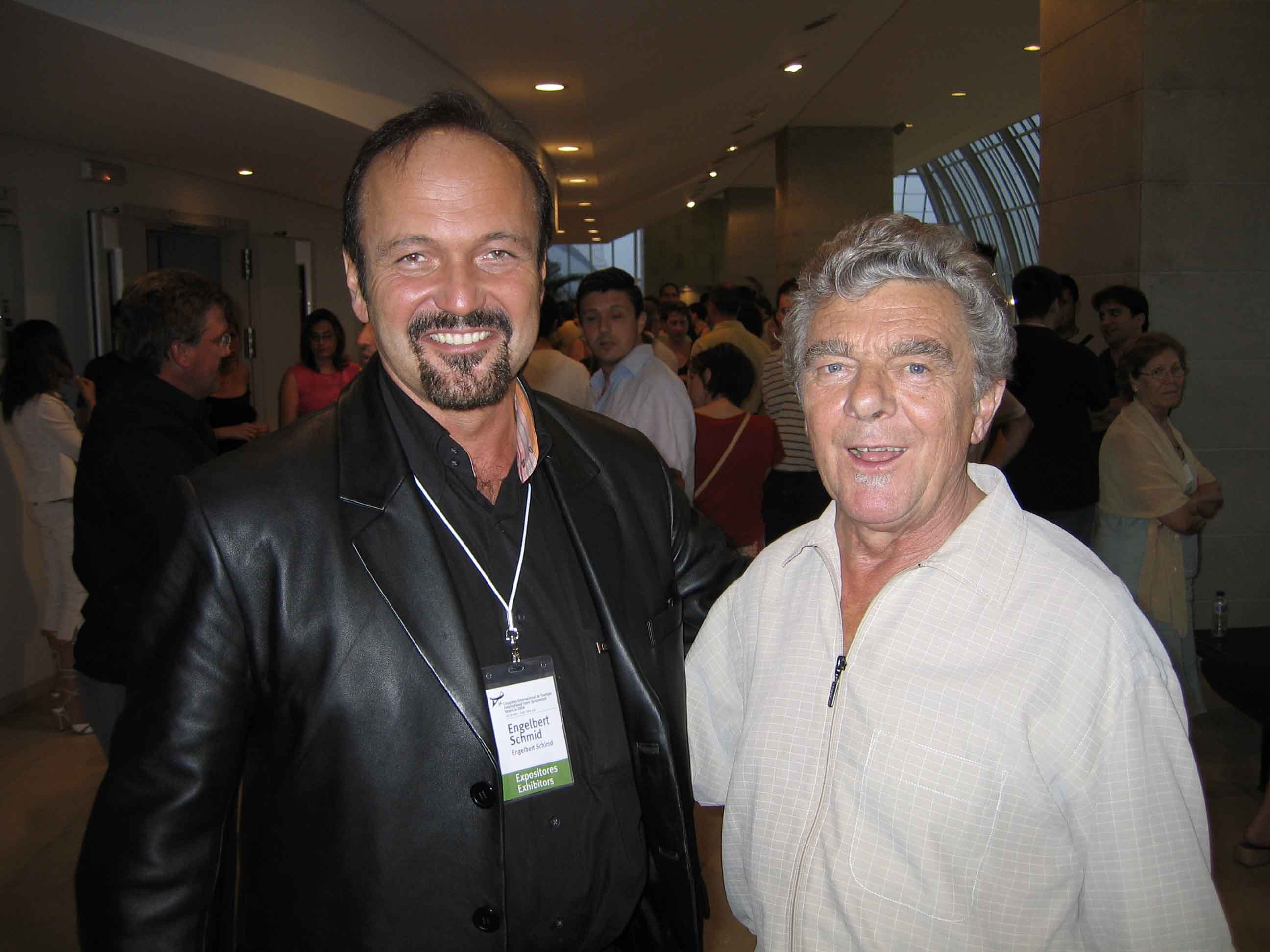
Engelbert Schmid mit Hermann Baumann in Valencia beim IHS Symposium 2004.
Ich habe das Glück, eine freundschaftliche Beziehung zu so vielen Top-Solisten und Orchesterhornisten von heute zu genießen und zu pflegen. Einige von ihnen hätten die technischen und musikalischen Fähigkeiten, regelmäßig als internationaler Solist zu reisen, ähnlich wie Hermann Baumann, aber es müssten noch ein paar weitere Faktoren zusammenkommen: Ein einflussreicher Konzertagent, der die Bühnenpräsenz und das Selbstbewusstsein durch spezielle Ausbildung aufbaut, und der feste Wille des Solisten, dieses Leben zu wollen, nämlich oft weg von der Familie. Ehrlich gesagt bin ich mir nicht sicher, ob ich meinen Freunden dieses Leben wünschen soll!
Ich möchte allen Lesern eine letzte Botschaft mitgeben: Trotz oder vielleicht wegen der vielen Möglichkeiten, sich heutzutage zu zerstreuen, sollte jedes Kind ein Musikinstrument lernen. Es trainiert die Sensitivität, das Konzentrationsvermögen und das Gehirn im Allgemeinen. Das Horn ist aufgrund seiner vielfältigen Ausdrucksmöglichkeiten sicherlich eines der interessantesten Instrumente. Auf jeden Fall habe ICH mich nach dem Besuch von Webers Oper "Der Freischütz" ins Horn verliebt.
ENGELBERT SCHMID NOVEMBER 2020
Engelbert Schmids junge Familie im April 2020.
KERRY TURNER
KERRY TURNER
photo by Steve Estwood
WILLIAM VERMEULEN
WILLIAM VERMEULEN
You are teaching in Rice University Shepherd School of Music (Houston Texas) and your class is considered internationally as the most efficient to win an orchestral position. My question is simple, how did you arrive to this status ? (might be that easy question means difficult answer !)
First of all, thank you for asking me to contribute to your wonderful series of questions to influential members of our horn community. I have been privileged to teach at Rice University for over 30 years now. From the very beginning, I had the opinion that simply getting a degree in music would not be enough as no orchestra hires you based on a diploma. There had to be a requirement of the students to achieve a level that would make them employable in an increasingly competitive job market. Although I had not taught at a university prior to my appointment in Houston, I had been the horn instructor at the Interlochen Arts Camp in Michigan and many fine players had studied with me there i.e.: (Lars Stransky, VPO, David Griffin, Chicago Symphony) I had also performed as featured artist at a number of International Horn Society symposia so my playing reputation was well established. Luckily, from very early at Rice I attracted excellent students and success for them came. Our early students won positions in prestigious orchestras, such as Cleveland, Los Angeles, New York Philharmonic, Israel Philharmonic, San Francisco, to name just a few. Word of our success spread quickly. Since then, over 400 employment offers have come to Rice hornists in most of the major and regional North American orchestras and even a few overseas. The formula was quite simple. Establish an incredibly high standard for the students to try and reach. Provide them a strong foundation of efficient production so that the technical aspects of the horn are not an issue. Always focus on sound and music, being mindful of serving the composer’s intent rather than blindly adhering to one particular color, sound or style. I train them to be consistent and smart in the audition process. We see auditions as a sales opportunity. My job is to have a good idea of what the orchestras are hiring and then we tailor the preparation so that the student can consistently demonstrate the requirements in the most convincing way, always sounding good. We finely tune each student’s audition preparation to take their best excerpts and make them exceptional while taking those that are a problem and making then into something that will at least keep them in consideration. We try to establish the parameters of the student’s ability and make sure they are well prepared to always demonstrate what they are good at. Generally, it is the player that sounds the best and makes it sound the easiest who wins, so we construct our audition package based on that. Always sound good, make it sound easy and always serve the music.
Following your intense career on social networks, I noticed that you also like cooking and eating well, and you are enjoying being surrounded by gorgeous nature or locations, even while working. Are these 2 delights inspiring your art or more relaxing you ?
Great question, Hervé! As an artist, every aspect of life can be reflected in our performance and cooking is yet another performance. In fact, it is easy to judge cooking by how the food tastes. I enjoy cooking and it has become a hobby away from the horn. I like to learn new techniques and remain open to new tastes. The same is true for music and the horn world. I’d like to think that I am as open now to learning and experiencing life as ever. This is one of the reasons I enjoy the horn symposia and do so much listening to recordings, old and new. Trying recipes, old and recipes new. Trying to put it all together and continue to advance, learn, create and grow. So, to answer your question, although I do enjoy the process of cooking as a relaxing activity away from music, I must admit it really more inspiring. No different than when I do my daily practice on the horn and still get inspired by the miraculous sound of the horn even through daily drills of scales and arpeggios. If I can do this in a beautiful environment so much the better. One of the great benefits of my solo and chamber music career has been traveling to perform and teach in many beautiful locations in the world and I do find this relaxing and inspiring. The scenic beauty is another positive experience to add to my art. I also think my early career playing Solo Horn in Honolulu spoiled me to want to be in gorgeous natural settings.
I listen frequently that teaching and growing students should be done without expecting to be paid back. If the student's path is successful, it would be just normal, but in case of failure the teacher would be always responsible. How then are you having pleasure to give them so much ?
Teaching for me is a sacred trust. I expect nothing back from my students other than their willingness to allow me to help guide them closer to their dreams and aspirations while they are under my tutelage. Although over 90 percent of my students have achieved success in professional music, I am equally proud of those who found their passions elsewhere. I truly am equally happy whenever a student does something that makes them feel like they are contributing to our world from the biggest orchestras to the smallest. We, as teachers are hopefully giving these talented young people tools they can use in whatever endeavor they pursue. You mention failure in your question. This is not a concept to which I adhere. I believe we are on this planet to learn, grow and evolve. ‘Failure’ is the ultimate opportunity to do just that. I take my own playing to the point of ‘failure’ every day. We will never know what our limitations are unless we try to go beyond them. It has also been extremely rewarding to have so many of my former students transition into colleagues and friends. We are a happy club of horn players, known as “The Rice Horn Crew”, learning and supporting each other as we continue to grow as artists and people. It is truly a pleasure.
I see that you are playing today a Horn made in Europe, which is not that frequent for an artist living and working mostly in America. Could you explain the circumstances of this important decision you have made at some point?
I perform on an Engelbert Schmid F-Bb-High F Triple known as “The Weapon 3.0”. This was not always the case though. I used to play a double horn and also use a Bb-High F descant for specialized repertoire. For the first twenty years of my career I would always travel with the two horns as my solo repertoire included standard concerti and then usually a transcribed virtuoso encore piece that used the descant horn. After September 11, 2001 the airlines changed the rules and made it much more difficult to bring two horns on the plane. If much of my solo reputation was based on being able to perform those unusually virtuosic encores, I needed to find a way to have the advantages of both of my horns available, thus playing on the triple. The Schmid is the best fit for me. Light, agile, responsive, smooth and a lovely sound. I was never an "old-school American" style player. I played on a Lewis for many of my early professional years. I studied in Chicago with Dale Clevenger. His sound branched away of some of the more traditional ‘American’ concepts and offered more European influences. My main influences during my formative years were Clevenger, Baumann, Orval, Damm, Berger, Civil and quite a few more players. This amalgam of sounds and styles led me to want equipment that allowed for many colors in my playing and interpretations. Now there are many wonderful horn makers and the types of colors are not limited to a specific horn style for America. I would say that the majority of horn makers in America are offering many more European style horns than in the past. I try to teach the concept of always serving the music and as such I prefer a sound that is based more in the middle of the color palette with the ability of changing the sound to best serve what I feel is the best color for the composer’s intent.
What kind of relation are you keeping with some of your most successful ex-students ?
The many students I have taught for now almost 40 years are family to me. They are known as the "Rice Horn Crew". I feel as invested in most of them now as I did when they were in my studio. Many of them have become my closest friends. I am proud of each of their successes and feel they honor me by carrying on the concepts and standards that I have tried to give them. I also feel this for my own mentor, Dale Clevenger. By doing my best to fulfill my own potential, serve the music and pass it to other players and generations I honor Dale and what he passed to me. I even keep a picture of him in my studio as a reminder to myself and all who enter that we must not forget our lineage and the responsibility we have to pass it along. I try to stay in touch with my students and am always happy to hear from them. We even perform together at summer music festivals. Since I host two large student parties a year, it is not unusual for former students to travel back to Houston to attend a "Crew Party".
Between your orchestral job and your teaching activity, is there one in your inner mind who is more important in your life ?
When I was young and early in my career my focus was largely on my orchestral career. As I become more known as a soloist and chamber musician, I would say solo playing balanced with the orchestra and teaching was a ‘side’ job. In the past 17 years, even though I still play with the Houston Symphony, do chamber music and solos, my teaching has exponentially outpaced the other aspects of my professional life. It is by far the most satisfying thing I do. Perhaps getting older and experiencing the satisfaction of being in service to another person has matured me. I remember having lunch with Phillip Farkas many years ago. He said that his performances were but a distant memory for those still alive to remember. His recordings were now in the discount bin of a record store and the only real legacy he felt he had was through his students. I feel I understand what he meant. I am 100% invested in my students. By helping them become successful and achieve their dreams they, in a sense, are keeping me alive.
For sure you are constantly listening to music, concerts and probably Horn players! Are your "models" changing time to time, or are the same Heroes of your studies still inspiring you ?
I remain open and eager to hear anything and everything that will help me continue to grow as an artist and person. Although I still have the "Heroes" of my youth I am impressed with the number of fine horn players we see emerging. During this time of COVID so many players have contributed online, and I am impressed with the content. I still study the old sounds, largely because horn sound has become more homogenized over the past 50 years. The old sounds were interesting because of the variety of colors possible so I still keep these sounds in my ear and memory. I like remembering Barboteu’s sound, Peter Damm, Orval, and dozens more. We have so many possibilities. Even Baumann in the late 60’s is quite different than Baumann from the 80’s. All interesting. All colors to add to our ever expanding palette. When I was young, I could tell you which orchestra was playing by the horn sound, style and types of articulations. Now, with digital recordings the differences in geographic playing are not as dramatic and for this reason, I like hearing many of the old recordings. It keeps more colors and possibilities in my ear. I want to have the sound of Orval or Damm in my head when I play Ravel Pavane, Or, Bloom for Brahms, or Clevenger and Berger for Mahler. Listening is very important. The technical prowess of many of today’s players is exceptional. Going to the horn symposiums is a great way to get exposed to a variety of international players. I so enjoyed being featured with you, Hervé as well Johannes Hinterholzer, Jean-Pierre Dassonville and many others during the IHS Ghent symposium *. There are also some fabulous jazz players now performing on horn. All in all, I think this is a fabulous time to be a horn player as long as we are not too arrogant to learn from our forbearers. In addition, I am also influenced by musicians of all types. Any player that does something that I am impressed with causes me to try to figure out what they are doing and incorporate it into my own artistry. I am constantly assimilating what I hear, from all sources, old and new.
Let's speak about technique. We are maybe not thinking the same way, I have heard that you are not convinced on studying on the F side. Please tell us more about this topic.
I started on a single F horn when I was 10 and played exclusively F horn for two and a half years. In America, we were taught a fingering system that used F horn from G in the staff down and B flat horn from G# up. When I worked with Clevenger, he insisted I become equally proficient in both sides of the horn. I still use F horn, but judiciously. I have worked very hard over the years to equalize my B horn to sound as warm and beautiful as the F side. I choose my fingerings largely on smoothness between the notes and pitch idiosyncrasy. I still practice both sides, even just days ago, playing Kopprasch etudes entirely on the F side. I play many flexibility studies and arpeggios on the F side. I play Rochut trombone etudes to work my F side. My default sound concept is largely based on the F horn and the inclusion of more complex harmonics within the sound. If you have heard that I don’t play much on the F side, it is perhaps because many American players still ascribe to the old traditions of range specific B horn use and I probably use fingerings more similar to many of my European colleagues.
Going back to your 40 years career, could you tell us where you have been appointed before Houston, like orchestras and universities. I am not sure all Europeans know about that, and it is certainly motivating the new generations.
As of this writing I begin my 42nd year as a professional horn player. Even though I always had big dreams I never imagined what a wonderful life this could bring. I began in November of 1979 at the age of 18 as an extra horn with the Chicago Symphony Orchestra. During my first year of university I played for the Civic Orchestra of Chicago and then took my first audition, for 2nd horn the in the Kansas City Philharmonic and won. I left school after my first year. Before I started in Kansas City, I was guest Solo Horn in the Saint Paul Chamber Orchestra. I also played private auditions for Claudio Abbado and Aldo Ceccato, both of whom wanted me to play for them in Milan and Hamburg respectively. I did not follow this path and auditioned for Solo Horn in Honolulu which was an excellent place to learn the repertoire, (and body surf). In the summers I performed at the Colorado Music Festival and began my teaching career at the Interlochen Arts Camp in Michigan. After eight years in Honolulu, I auditioned for Solo Horn in Columbus, Ohio and won that position. I was only in Ohio one year before winning the Solo Horn spot in Houston. The resulting solo and chamber music career was largely a result of moving my way up the orchestral ranks and having the time to travel and perform. I am now in my 31st season as Solo Horn of the Houston Symphony and Professor at Rice University. I count my blessings every day for all of the music I have been fortunate enough to play and the amazing colleagues who have contributed to my path.
You premiered many pieces for Horn, what has enriched you in close contact with composers ?
I grew up completely fascinated by America, the American dream, and the so many talented musicians you have in the USA (pro and amateurs). At that time, I was also convinced that our schools were hugely different, you focused more on the technique. We had the opportunity to share the stage twice, almost three times, and I remember how easy it was to play with you, technically and stylistically speaking. How do you explain it ? Is the so-called good taste culture so important in the classical world, then able to pass over everything ? (music as universal language)
The horn world was so divided when I was young. In America, it was brass horns versus silver horns. Then, in Europe, it also existed with makers. People would judge you based on the color of your horn, or type of horn. Paxman versus Alexander and list goes on…. That is not even mentioning Vienna. It really is another form of discrimination. I remember hearing the stereotype that American players are all about technique and aren’t very musical and that European players are very musical but miss more notes and play out of tune and rhythm. This again, is a form of discrimination. For me, in my training I was taught, “The Art Form Must and Shall Precede and Dictate the Craft”. Telling our musical story and doing it in a convincing way with a captivating color of sound and true intent of message is and should always be our top priority. This should not be at the sacrifice of playing in tune or rhythm or being solid enough to play the correct notes. I think the time for all this judgement should be gone. I feel so fortunate that most of my early musical training was NOT as a horn player. I started piano at 5 years old and played quite well. By the time I started horn at 10 I was already playing Beethoven piano sonatas so my thoughts on technique were based on that. The horn seemed so much easier with only one line and mostly slow notes. I was also singing a lot and was in choirs and a solo boy soprano when I was young so my thoughts on phrasing and music was entirely based on how I would sing it. To answer your question, the good taste culture’ should live well with the solid practical skill culture. There are fine musicians in America and solid horn players in Europe. The time has come to live together with respect and openness as one community of fine artists, who just happen to play the horn.
Vous enseignez auprès de la "Rice University Shepherd School of Music" (Houston, Texas) et votre classe est considérée internationalement comme des plus efficaces pour gagner un poste d’orchestre. Ma question est simple : comment en êtes-vous arrivé à ce statut ?
Tout d’abord, je te remercie de m’avoir demandé de contribuer à ta merveilleuse série de questions à d'éminents membres de la communauté cornistique. J’ai le privilège d’enseigner à l’Université Rice depuis plus de 30 ans. Dès le début, j’ai eu l’idée que le simple fait d’obtenir un diplôme de musique ne suffirait pas, car aucun orchestre n'embauche sur la base d’un diplôme. Les étudiants devaient être tenus d’atteindre un niveau qui les rendrait aptes à l’emploi dans un marché du travail de plus en plus concurrentiel. Bien que je n’ai pas enseigné dans une université avant mon arrivée à Houston, j’avais été professeur de cor au Interlochen Arts Camp dans le Michigan et beaucoup de bons musiciens y avaient étudié avec moi: (Lars Stransky, VPO, David Griffin, Chicago Symphony). Heureusement à Rice University, j’ai attiré d’excellents étudiants et leur succès est arrivé très vite. Nos premiers élèves ont obtenu des postes dans des orchestres prestigieux, tels que Cleveland, Los Angeles, New York Philharmonic, Israel Philharmonic, San Francisco, pour n’en nommer que quelques-uns. La rumeur de notre succès s’est répandue rapidement. Depuis, plus de 400 postes ont été remportés par les cornistes de Rice dans la plupart des orchestres majeurs et régionaux d’Amérique du Nord et même dans quelques orchestres étrangers. La formule était assez simple. Établir un "standard" incroyablement élevé et essayer de l'atteindre avec chaque étudiant. Fournir une base solide et une efficacité notoire afin que les aspects techniques du cor ne soient plus un problème. Se concentrer toujours sur le son et la musique, dans la conscience de servir l’intention du compositeur plutôt que d’adhérer aveuglément à une couleur, un son ou un style particulier. Je les forme pour qu’ils soient cohérents et intelligents dans le déroulement des auditions. Nous considérons les auditions comme une opportunité de "se vendre". Mon travail est d’avoir une bonne idée de ce que les orchestres attendent, et ensuite de personnaliser la préparation afin que l’étudiant puisse constamment démontrer toute exigence de la manière la plus convaincante, en jouant toujours bien. Nous détaillons finement la préparation de chaque élève à l’audition pour prendre les meilleurs traits d'orchestre et les rendre exceptionnels tout en prenant ceux qui posent problème pour en faire tout de même quelque chose qui "tiendra la route". Nous essayons de cerner la somme des qualités de l’étudiant et nous assurons qu’il est préparé à toujours montrer ce qu’il a de meilleur. Généralement, c’est celui qui joue le mieux et qui fait paraître de la facilité qui gagne, donc nous construisons notre préparation à l'audition en fonction de cela. Jouer toujours bien, faire montre d'une aisance, et toujours servir la musique.
En suivant votre intense carrière sur les réseaux sociaux, j’ai remarqué que vous aimiez cuisiner et bien manger, que vous aimiez également vous trouver dans la nature ou des lieux magnifiques, même en travaillant. Ces deux plaisirs inspirent-ils votre art ou vous détendent-ils ?
Bonne question, Hervé! En tant qu’artiste, chaque aspect de la vie peut se refléter dans nos performances, la cuisine étant une autre performance. En fait, il est facile de juger la cuisine en fonction des saveurs à l'arrivée. J’aime cuisiner et c’est devenu un passe-temps hors du cor. J’aime apprendre de nouvelles techniques et je reste ouvert à de nouveaux goûts. Il en va de même pour la musique et le monde du cor. J’aimerais penser que je suis plus ouvert que jamais à l’apprentissage et à l’expérience de la vie. C’est l’une des raisons pour lesquelles j’aime aussi les symposiums et j'écoute beaucoup d’enregistrements, anciens et nouveaux. Essayer de vieilles recettes et de nouvelles. Essayer de rassembler tout cela et continuer à progresser, apprendre, créer et croître.
Donc, pour répondre à ta question, alors que je vois le processus de cuisiner comme une activité relaxante loin de la musique, je dois admettre que c’est surtout vraiment plutôt "inspirant". Comme quand je fais ma pratique quotidienne, toujours charmé par le merveilleux son du cor même à travers des exercices, séries d'intervalles et d’arpèges. Si je peux faire ça dans un bel environnement, c'est tant mieux. Un des grands avantages de ma carrière en solo et en musique de chambre a été de voyager pour jouer (et enseigner) dans de nombreux endroits magnifiques dans le monde, et je trouve cela relaxant et inspirant. La beauté scénique est une autre expérience positive à ajouter à mon art. Je pense aussi que mon début de carrière comme cor solo à Honolulu m’a gâté et donné envie d'être dans des paysages naturels remarquables.
J’entends souvent que l’enseignement ou la formation des étudiants doivent être opérés sans rien attendre en retour. Si le parcours de l’élève est couronné de succès, ce sera normal, mais si il se solde par un échec, alors l’enseignant sera toujours responsable. Comment prenez-vous donc du plaisir à leur donner autant ?
Enseigner pour moi est une sacrée relation de confiance. Je n’attends rien d'autre de mes élèves que leur désir de me permettre de les aider à se rapprocher de leurs rêves et de leurs aspirations pendant qu’ils sont sous ma tutelle. Bien que plus de 90% de mes élèves aient réussi dans la musique professionnelle, je suis tout aussi fier de ceux qui ont trouvé leurs passions ailleurs. Je suis vraiment tout aussi heureux quand un étudiant fait quelque chose qui lui donne l’impression qu’il contribue au monde, des plus grands orchestres aux plus petits. En tant qu’enseignants, nous espérons donner à ces jeunes talentueux des outils qu’ils pourront utiliser dans toutes les entreprises qu’ils poursuivent. Tu mentionnes l’échec dans ta question. Ce n'est pas un concept auquel j'adhère. Je crois que nous sommes sur cette planète pour apprendre, grandir et évoluer". L'échec est l'occasion ultime de le faire. Chaque jour, j'emmène mon propre jeu jusqu'au point de l'échec. Nous ne saurons jamais quelles sont nos limites si nous n'essayons pas de les dépasser. Il m'a également été extrêmement gratifiant de voir un si grand nombre de mes anciens élèves se transformer en collègues et amis. Nous sommes un heureux club de cornistes, connu sous le nom de The Rice Horn Crew, qui apprend et se soutient mutuellement tout en continuant à évoluer en tant qu'artiste et personne. C'est vraiment un plaisir.
Je vois que vous jouez aujourd’hui un cor fabriqué en Europe, ce qui n’est pas si fréquent pour un artiste vivant et travaillant principalement en Amérique. Pourriez-vous nous expliquer les circonstances de cette décision?
Je joue sur un cor Engelbert Schmid triple Fa-Bb-Fa aigu connu sous le nom de "l'Arme 3.0". Mais cela n'a pas toujours été le cas. J'avais l'habitude de jouer un cor double Fa-Sib et d'utiliser également un Sib-Fa aigu (descant) pour le répertoire spécifique. Pendant les vingt premières années de ma carrière, j'ai toujours voyagé avec les deux cors, car mon répertoire solo comprenait des concertos traditionnels, mais aussi un bis virtuose qui nécessitait ce cor aigu. Après le 11 septembre 2001, les compagnies aériennes ont modifié les règles et rendu beaucoup plus difficile l'embarquement de deux instruments sur un avion. Comme une grande partie de ma réputation de concertiste était basée sur ma capacité à exécuter ces bis spectaculaires, je devais trouver un moyen de combiner les avantages de mes deux cors, ce fut donc l'adoption d'un triple. Le Schmid est le mieux adapté pour moi. Léger, agile, réactif, doux avec un son agréable. Je n'ai jamais été un instrumentiste de la "vieille école Américaine". J'ai joué sur un Lewis pendant une grande partie de mes premières années professionnelles.
Quel genre de relation entretenez-vous avec certains de vos plus talentueux anciens élèves ?
Les nombreux étudiants à qui j'ai enseigné pendant près de 40 ans forment pour moi comme une famille. Ils sont connus sous le nom de "The Rice Horn Crew". Je me sens toujours investi pour la plupart d'entre eux comme lorsqu'ils étaient dans ma classe. Beaucoup d'entre eux sont devenus de proches amis. Je suis fier de leurs succès et j'ai le sentiment qu'ils m'honorent en poursuivant les concepts et règles de vie que j'ai essayé de leur transmettre. Je ressens également cela pour mon propre mentor, Dale Clevenger. En faisant de mon mieux pour réaliser ma propre voie, servir la musique et la transmettre à d'autres musiciens et générations, j'honore Dale et ce qu'il m'a transmis. Je garde même une photo de lui dans mon studio pour me rappeler, ainsi qu'à tous ceux qui entrent, que nous ne devons pas oublier notre lignée et la responsabilité que nous avons à la perpétuer. J'essaie de rester en contact avec mes étudiants et je suis toujours heureux d'avoir de leurs nouvelles. Nous nous produisons même ensemble lors de festivals d'étés. Comme j'organise deux grandes fêtes étudiantes par an, il n'est pas rare que d'anciens élèves retournent à Houston pour assister à une Crew Party.
Entre votre activité de musicien d’orchestre et celle d’enseignant, laquelle est rigoureusement primordiale dans votre vie ?
Quand j’étais jeune et au début de ma carrière, je me concentrais surtout sur le métier d’orchestre. À mesure que je devins plus connu comme soliste et chambriste, je dirais que jouer en solo et dans l’orchestre s'équilibraient, alors qu'enseigner était un travail secondaire. Au cours des 17 dernières années, même si je joue toujours avec le Houston Symphony, ainsi que de la musique de chambre et en soliste, l'enseignement a dépassé de façon exponentielle les autres activités de ma vie professionnelle. C’est de loin la chose la plus satisfaisante que je fasse. Peut-être que vieillir et éprouver la satisfaction d’être au service d’une autre personne me mûrit. Je me souviens avoir déjeuné avec Phillip Farkas il y a de nombreuses années. Il m'a dit que ses performances n’étaient qu’un lointain souvenir pour ceux qui étaient toujours là. Ses enregistrements se trouvaient maintenant au rayon "soldes" des disquaires et le seul véritable héritage qu’il croyait avoir était celui de ses étudiants. Je sens que je comprends ce qu’il voulait dire. Je suis investi à 100% aux côtés de mes étudiants. En les aidant à réussir et à réaliser leurs rêves, ils me gardent en vie.
Vous écoutez certainement régulièrement de la musique, des concerts et probablement des cornistes! Vos "modèles" changent-ils dans le temps, ou les "héros" de vos études vous inspirent-ils toujours pareillement ?
Je reste ouvert et désireux d'entendre tout ce qui m'aidera à continuer à progresser en tant qu'artiste et personne. Bien que j'aime toujours les "héros" de ma jeunesse, je suis impressionné par le nombre de cornistes que nous voyons émerger. Pendant cette période de Covid19, de nombreux acteurs ont apporté une contribution en ligne, et je suis impressionné par le contenu. J'étudie toujours les sonorités du passé, en grande partie parce que le son du cor s'est homogénéisé au fil ces 50 dernières années. Ces vieux sons étaient intéressants en raison de la variété des couleurs donc je garde toujours ces sons dans l'oreille et dans la mémoire. J’aime me souvenir du son de G. Barboteu, de P. Damm, de F. Orval et de dizaines d’autres. Nous avons tant de possibilités. Même Baumann à la fin des années 60 est assez différent du Baumann des années 80. C’est intéressant. Toutes ces couleurs à ajouter à notre palette évolutive. Quand j'étais jeune, je pouvais dire quel orchestre jouait au son de ses cors, du style et des articulations. Aujourd'hui, avec les enregistrements numériques, les différences de jeu géographiquement parlant ne sont pas aussi claires, c'est pourquoi j'aime beaucoup écouter d'anciens enregistrements. Cela offre plus de couleurs et de possibilités dans l'oreille. Je veux avoir le son d'Orval ou de Damm dans ma tête quand je joue la Pavane de Ravel, ou Bloom pour Brahms, ou Clevenger et Berger pour Mahler. L'écoute est très importante. La prouesse technique de nombreux instrumentistes d’aujourd’hui est exceptionnelle. Aller aux symposiums de cor est une excellente façon de se familiariser avec une variété d’acteurs internationaux. J’ai beaucoup apprécié être présent avec toi Hervé, ainsi que Johannes Hinterholzer, Jean-Pierre Dassonville et beaucoup d’autres lors du symposium IHS de Gand *. Il y a aussi de fabuleux cornistes de jazz. Dans l’ensemble, je pense que c’est un grand moment pour jouer du cor tant que nous ne sommes pas trop arrogants pour apprendre de nos ancêtres. De plus, je suis aussi influencé par des musiciens de tous genres. Tout joueur qui fait quelque chose qui m’impressionne me fait essayer de comprendre ce qu’il fait et de l’intégrer dans mon propre art. J’assimile constamment ce que j’entends, de toutes les sources, passées et nouvelles.
Parlons de la technique. À ce sujet, on ne voit peut-être pas les choses de la même façon, j’ai entendu dire que vous ne seriez pas convaincu d’étudier sur le cor en Fa (pourtant si Américain). Si cela est juste (ou pas !) pouvez-vous nous en dire davantage ?
J’ai commencé sur un cor simple en Fa à l'âge de 10 ans et j’ai joué exclusivement en Fa pendant deux ans et demi. En Amérique, on nous a enseigné un système de doigtés en Fa du Sol de la portée vers le bas et le cor en Sib du Sol# vers l'aigu. Quand je travaillais avec Clevenger, il a insisté pour que je sois aussi à l'aise sur les 2 tons. J’utilise toujours le cor en Fa, judicieusement. J’ai travaillé très dur au fil des ans mon jeu en Sib, pour qu’il sonne aussi chaleureusement et joliment que mon Fa. Je choisis mes doigtés principalement sur l'homogénéité entre les notes et l’intonation idéale. J'étudie encore sur les 2 tonalités, même il y a quelques jours, en jouant entièrement en Fa les études de Kopprasch. Je joue beaucoup d’études de flexibilité et d’arpèges en Fa. Je joue les études de trombone de Rochut pour travailler le Fa. Mon concept de son par défaut est largement basé sur le cor en Fa et sa richesse d’harmoniques. Si tu as entendu dire que je ne privilégie pas le cor en Fa, c’est peut-être parce que de nombreux instrumentistes américains associent encore à l'ancienne tradition l'utilisation du cor en Sib prépondérant, mais j'utilise probablement des doigtés plus semblables à ceux de beaucoup de mes collègues européens.
Pour revenir à vos 40 ans de carrière, pourriez-vous nous dire où vous avez été nommé avant Houston ? (orchestres et universités). Je ne suis pas sûr que tous les Européens soient au courant de cela, et cela motivera certainement les nouvelles générations.
Au moment où j'écris ces lignes, j'entame ma 42ème année en tant que corniste professionnel. Même si j'ai toujours eu de grands rêves, je n'ai jamais imaginé la vie merveilleuse que cela pourrait m'apporter. J'ai commencé en novembre 1979, à l'âge de 18 ans, comme cor supplémentaire à l'Orchestre Symphonique de Chicago. Pendant ma première année d'université, j'ai joué pour le Civic Orchestra of Chicago, puis j'ai passé ma première audition, pour le poste de 2ème cor du Philharmonique de Kansas City et j'ai gagné. J'ai quitté l'école après ma première année. Avant de commencer à Kansas City, j'étais cor solo invité dans l'orchestre de chambre de Saint Paul. J'ai également passé des auditions privées pour Claudio Abbado et Aldo Ceccato, qui m'ont invités à les rejoindre respectivement à Milan et à Hambourg. Je n'ai pas suivi cette voie et j'ai auditionné comme cor solo à Honolulu qui était un excellent endroit pour apprendre le répertoire, (et le bodysurf). L'été, je me produisais au Colorado Music Festival et j'ai commencé ma carrière d'enseignant au Interlochen Arts Camp dans le Michigan. Après huit ans à Honolulu, j’ai auditionné pour le poste de cor solo à Columbus, Ohio et j’ai remporté ce concours. Je suis resté dans l'Ohio qu’un an avant de gagner le job de cor solo à Houston. La carrière de soliste et de musique de chambre qui en a découlé est largement le résultat de mon avancement dans les orchestres, plus mon temps libre pour voyager et jouer. Je suis maintenant dans ma 31ème saison en tant que cor solo du Symphonique de Houston et professeur à l’université de Rice. Je compte ma chance chaque jour pour toute la musique que j’ai eu la chance de jouer et pour les collègues incroyables qui ont contribué à mon cheminement.
Vous avez créé de nombreuses pièces pour cor, qu’est-ce qui vous a enrichi lors des séances de travail avec les compositeurs ?
J’ai toujours défendu les nouveaux compositeurs et la musique par des dizaines de nouvelles pièces écrites au cours de ma carrière. Parfois, j’ai eu des contacts avec eux, et ils me connaissaient personnellement. Parfois, je connaissais leur travail et donc assez confiant qu’ils puissent composer une grande nouvelle pièce pour moi. Presque toujours, j’ai eu des aides pour honorer les frais des commandes et je remercie l’International Horn Society, le Houston Symphony et l’Université Rice d’avoir largement financé mon désir de garder la musique vivante. Je suis fier et heureux de chaque nouvelle pièce que nous avons ajouté au répertoire du cor. Je dirais que cela a parfois été un défi parce que si un compositeur découvre des possibilités ou des techniques inhabituelles, il a souvent envie de les placer dans la pièce. Rétrospectivement, cependant, cela m’a obligé à développer mes capacités et à améliorer mon jeu dans l’ensemble.
J’ai grandi complètement fasciné par l’Amérique, le rêve américain, et ses nombreux musiciens talentueux (pro et amateurs). À cette époque, j’étais aussi convaincu que nos écoles étaient extrêmement différentes, que vous vous concentriez davantage sur la technique. Nous avons eu l’occasion de jouer ensemble deux fois, presque trois... et je me souviens à quel point c'était facile, techniquement et stylistiquement parlant. Comment expliquez-vous cela? Est-ce que la culture dite du "bon goût" si prégnante dans le monde classique, permet de tout surmonter? (musique comme langage universel)
Le monde du cor était si divisé quand j’étais jeune. En Amérique, c’était les cors en cuivre contre les cors argentés. Ensuite, en Europe, cette rivalité a existé entre les facteurs. Les gens vous jugeaient en fonction du type d'alliage de votre cor, ou votre type de cor. Paxman contre Alexander et puis aussi les autres. . . Et je ne parle même pas de Vienne. C’est vraiment une certaine forme de discrimination. Je me souviens avoir entendu le stéréotype selon lequel les joueurs américains sont tous techniques mais ne sont pas très "musiciens" et que les joueurs européens, bien que "musiciens" ratent davantage, jouent faux et pas en rythme. Là encore, il s’agit d’une forme de discrimination. Dans ma formation, on m’a enseigné: l’art doit précéder et dicter l’artisanat. Raconter notre histoire musicale et le faire d’une manière convaincante avec une couleur de son captivante et une véritable intention dans le message devrait toujours être notre priorité absolue. Cela ne devrait pas se faire au détriment de l'intonation, du rythme ou de la propreté. Cela ne doit pas se faire au détriment de la justesse ou du rythme, ni au détriment de la solidité des notes. Je pense que le temps de ces jugements devrait être révolu. Je me sens si chanceux que la plupart de mes premières expériences musicales n'aient pas été faites en tant que corniste. J'ai commencé le piano à 5 ans et je jouais assez bien. Lorsque j'ai commencé le cor à 10 ans, je jouais déjà des sonates pour piano de Beethoven, donc mes réflexions sur la technique étaient basées sur cela. Le cor semblait tellement plus facile avec une seule ligne et bien souvent des notes lentes. Je chantais aussi beaucoup, j'étais dans des chorales comme "soprano boy", donc mes pensées sur le phrasé et la musique étaient entièrement basées sur la façon dont je chantais. Pour répondre à ta question, la culture du "bon goût" devrait composer avec une solide culture de compétence pratique. Il y a de bons musiciens en Amérique et de solides cornistes en Europe. Le temps est venu de vivre ensemble dans le respect et l'ouverture, comme une communauté de musiciens raffinés, qui se trouvent à jouer du cor.
Avez-vous eu parfois une période difficile (même de courte durée), que vous avez appris au cours des années à surmonter? Cela pourrait aider beaucoup d’entre nous, en particulier les jeunes...
Une longue carrière de musicien ressemble beaucoup au cheminement de la bourse. Au fil du temps, elle devrait continuer à progresser et à se développer, mais ne clôt jamais au même endroit deux jours de suite. Bien sûr, il y a des temps morts, mais si vous faites attention à la façon dont vous développez votre jeu, en vous référant même à quelqu'un pour vous améliorer, votre jeu sur le cor peut se développer comme la bourse! Pour moi, la plupart des problèmes ont été liés au stress incessant qui accompagne une vie tutoyant la performance. Il s'agit d'une recherche qui dure toute une carrière, en essayant toujours de trouver un confort et un équilibre. Oui, il y a eu des moments dans ma carrière où j'ai ressenti des baisses de régime dans mon jeu. Cela m'a motivé à développer certaines de mes méthodes d'enseignement les plus efficaces. Les effets normaux du vieillissement m'ont permis de créer une approche plus efficace qui m'a aidé, ainsi que nombreux de mes étudiants. J'ai appris que les moments difficiles sont la meilleure occasion pour apprendre et grandir. L'attitude est essentielle. Gardez une attitude saine et votre désir et votre persévérance créeront un parcours de découverte.

